- Skip to right header navigation
- Skip to main content
- Skip to primary sidebar
MY WANDERLUSTY LIFE
#TimeBudgetTravel
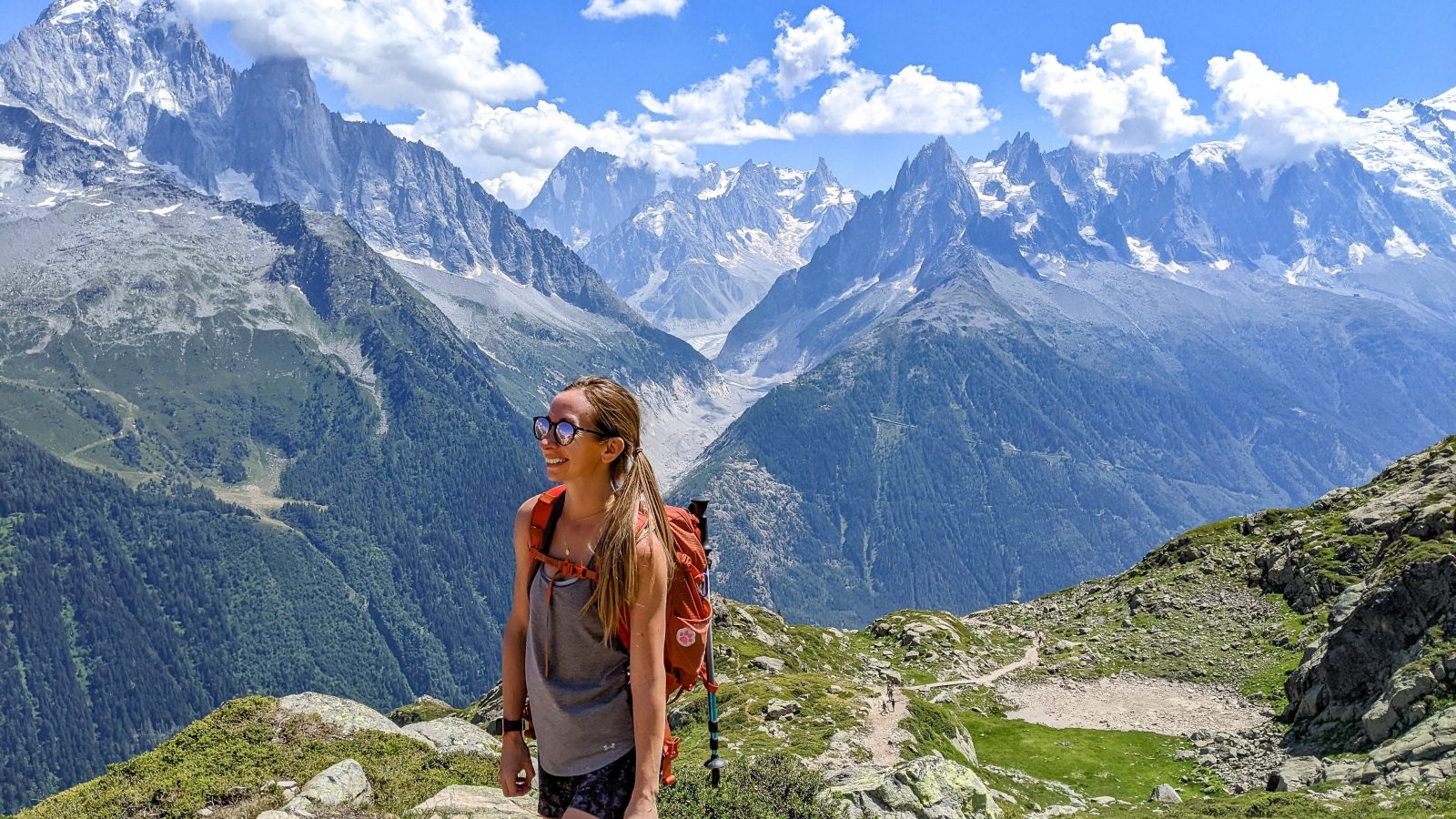

Tour du Mont Blanc Packing List: What to Pack for the TMB (+ What to Ditch!)
Last Updated: June 25, 2023 // by Ashley Smith 8 Comments
I’ve curated a Tour du Mont Blanc packing list for myself three times for three different styles of adventure. I’ve packed for hiking the TMB solo, hiking with a friend, and most recently as a solo member of a guided hiking group . Let’s just say… I know a thing or two because I’ve packed a thing or two.
In this post you’ll find my complete recommended Tour du Mont Blanc packing list along with important tips, the must-haves, and all the things you really don’t need at all. If you’d like a printable, check-off-able version, you can get it for free below. Happy packing!
TMB Packing List 2024
Table of Contents
Tour du Mont Blanc packing list: What to keep in mind
This Tour du Mont Blanc packing list contains all the things I recommend after having packed for the TMB three times now. However, the list will vary for you depending on what kind of hike you’ll be taking.
Your hiking style
For instance, I utilized luggage transfer on my latest TMB hike because I like to hike smarter, not harder. If you will be carrying all your stuff with you the entire time, you’ll need some slight variations (which I’ll point out.) If you’ll be camping, you’ll need a lot of variations which I cannot help you with at this needing-a-proper-shower point in my life.
Your hiking timeline
This list is, however, good for any number of days on the trail. Whether you’ll be taking 12 days to hike the Tour du Mont Blanc or 6, this list will cover you.
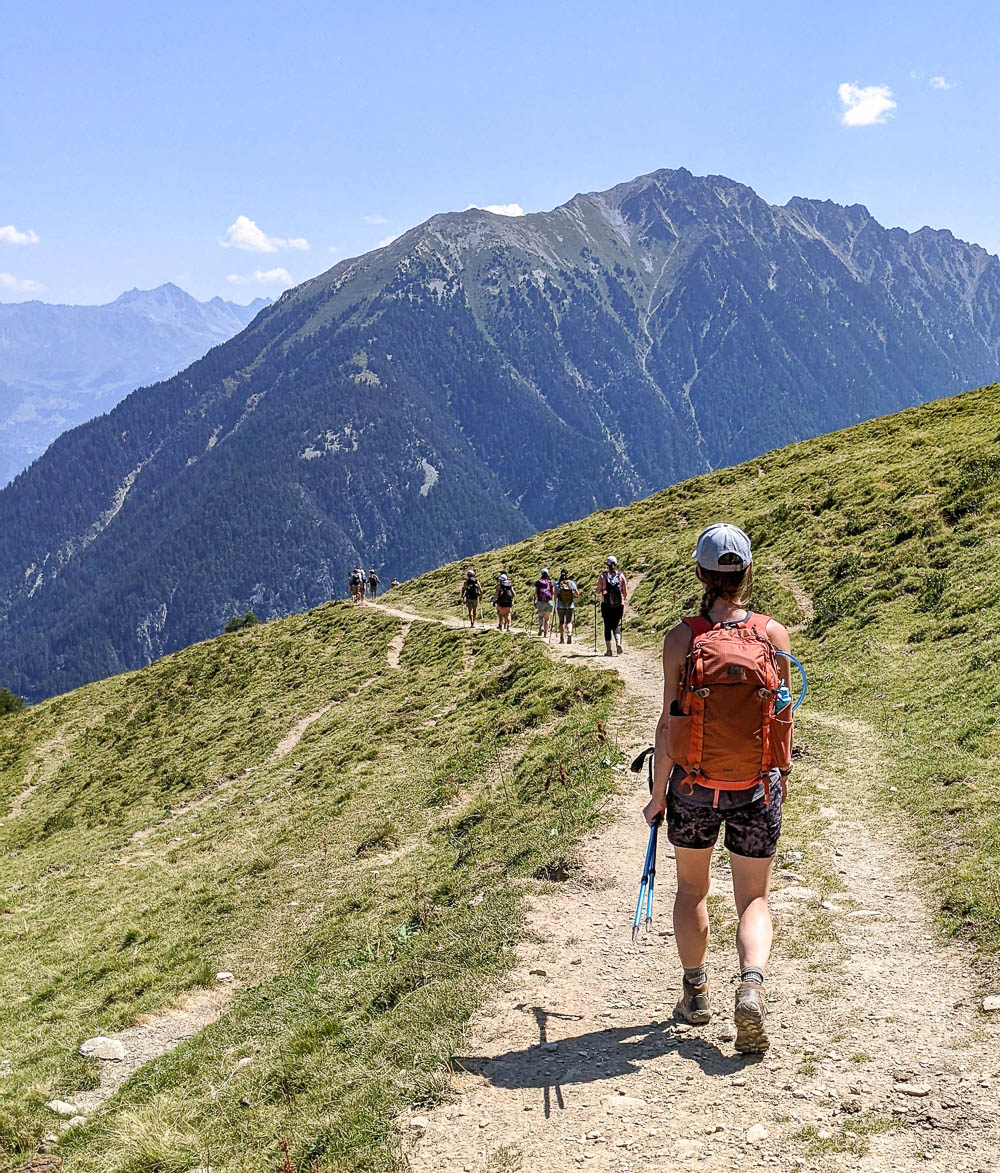
Your personal preference
Keep in mind that personal preference and need greatly factors into what will ultimately be on your Tour du Mont Blanc packing list. For instance, I’m a dainty little female so if you’re a male hiker your list might be quite different.
Your hygiene needs may differ from mine as may your comfort levels, abilities, and other requirements. That’s perfectly okay! Use this Tour du Mont Blanc packing list as a baseline guide and amend it to your specific needs.
Read also: 10 Myths About Hiking the Tour du Mont Blanc You Need to Forget Right Now!
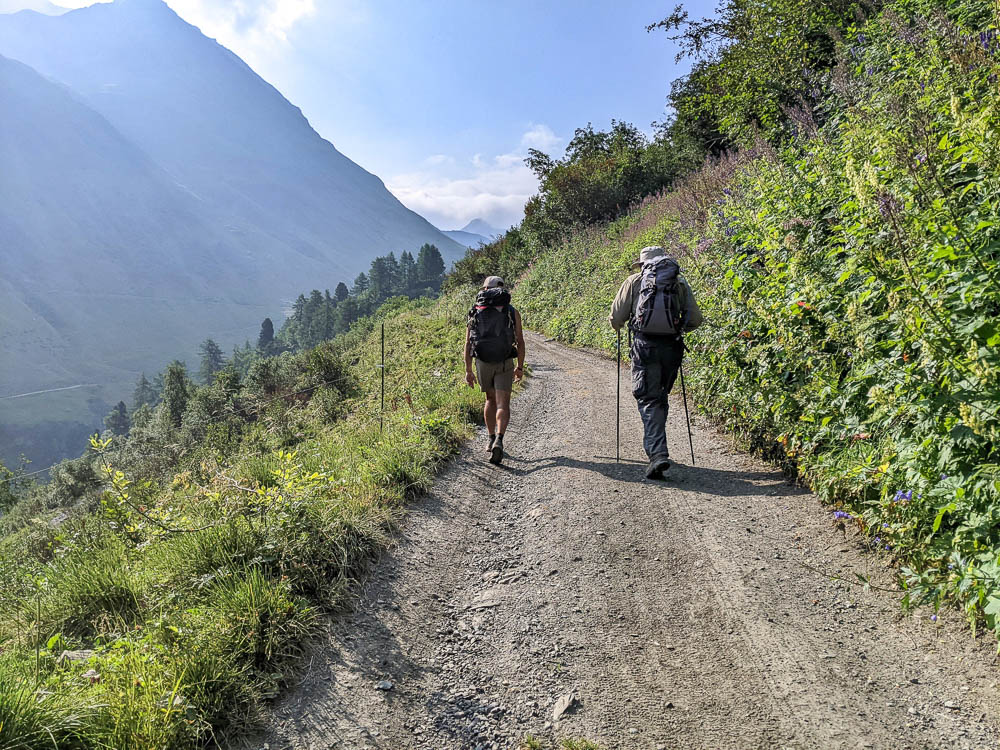
Tour du Mont Blanc packing list: Important tips
Regardless of your hiking or packing style, there are most definitely a handful of important tips that you should remember when formulating your Tour du Mont Blanc packing list.
As light a pack as possible
For starters, the #1 goal is to keep your pack as light as possible. Whatever you decide to bring on your hike, always remember this. Even going to extremes if necessary.
The lighter your pack, the more you’ll enjoy hiking the Tour du Mont Blanc. I cannot stress this enough as a too-heavy pack is what ultimately led me to quit the TMB in 2019 after one day.
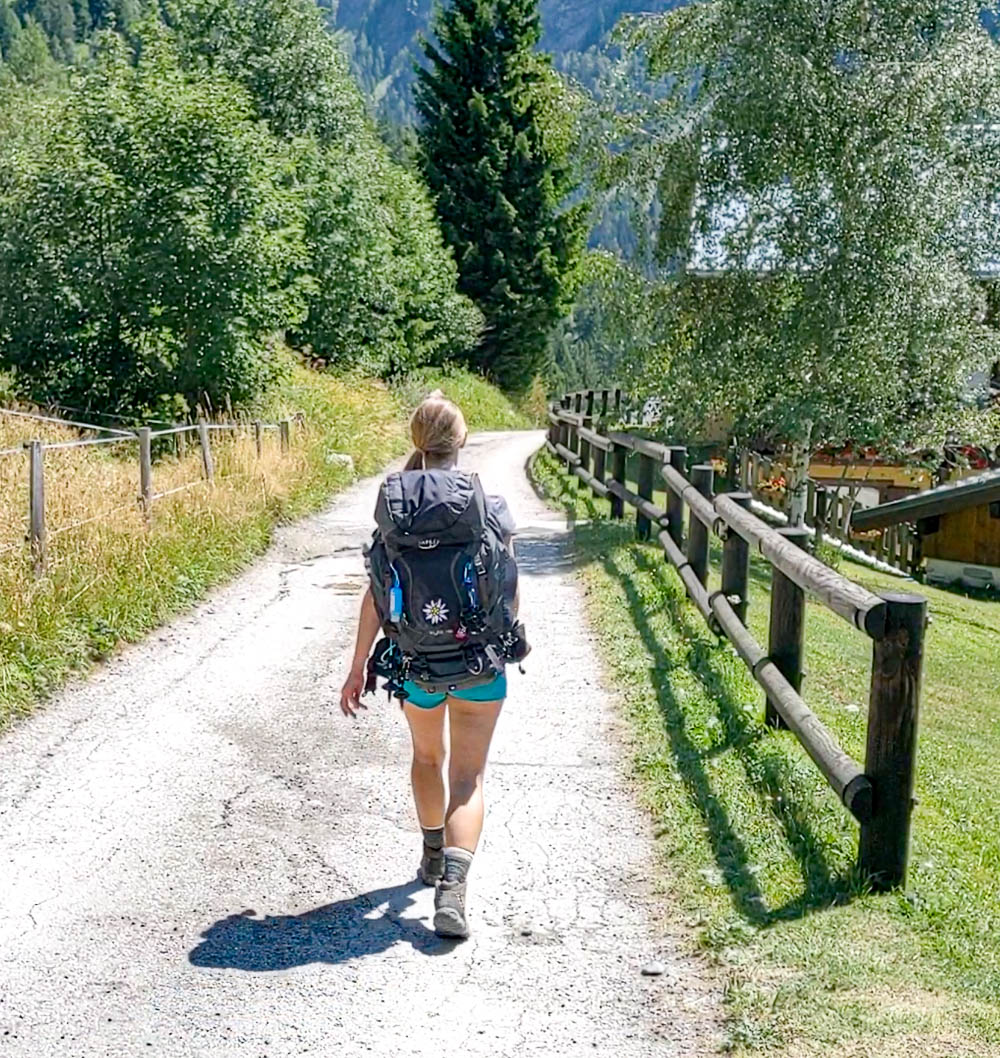
I mean it when I say weigh. every. item. Every single ounce counts when it’s all combined and you’re carrying it on your back. What may feel alright when you pick it up and put it on will feel like carrying a Mack truck after just 30 minutes of turtle-ing it uphill.
Personally, I used a kitchen scale and weighed every single thing I wanted to pack for my TMB hike. Then I got rid of every single thing that wasn’t absolutely necessary.
Then, to prep for my hike, I filled my bag with that much weight and wore my backpack around the house for WEEKS. Literally, to the bathroom, while I made lunch, up and down the stairs, to the mailbox, everywhere. Only then will you be able to appreciate the need to scrape every possible ounce.
Even if you’re planning to utilize luggage transfer for your hike, still keep it to a minimum. These companies still impose bag and weight restrictions and you really won’t want to bother with a bunch of unnecessary crap in the refuges anyway.
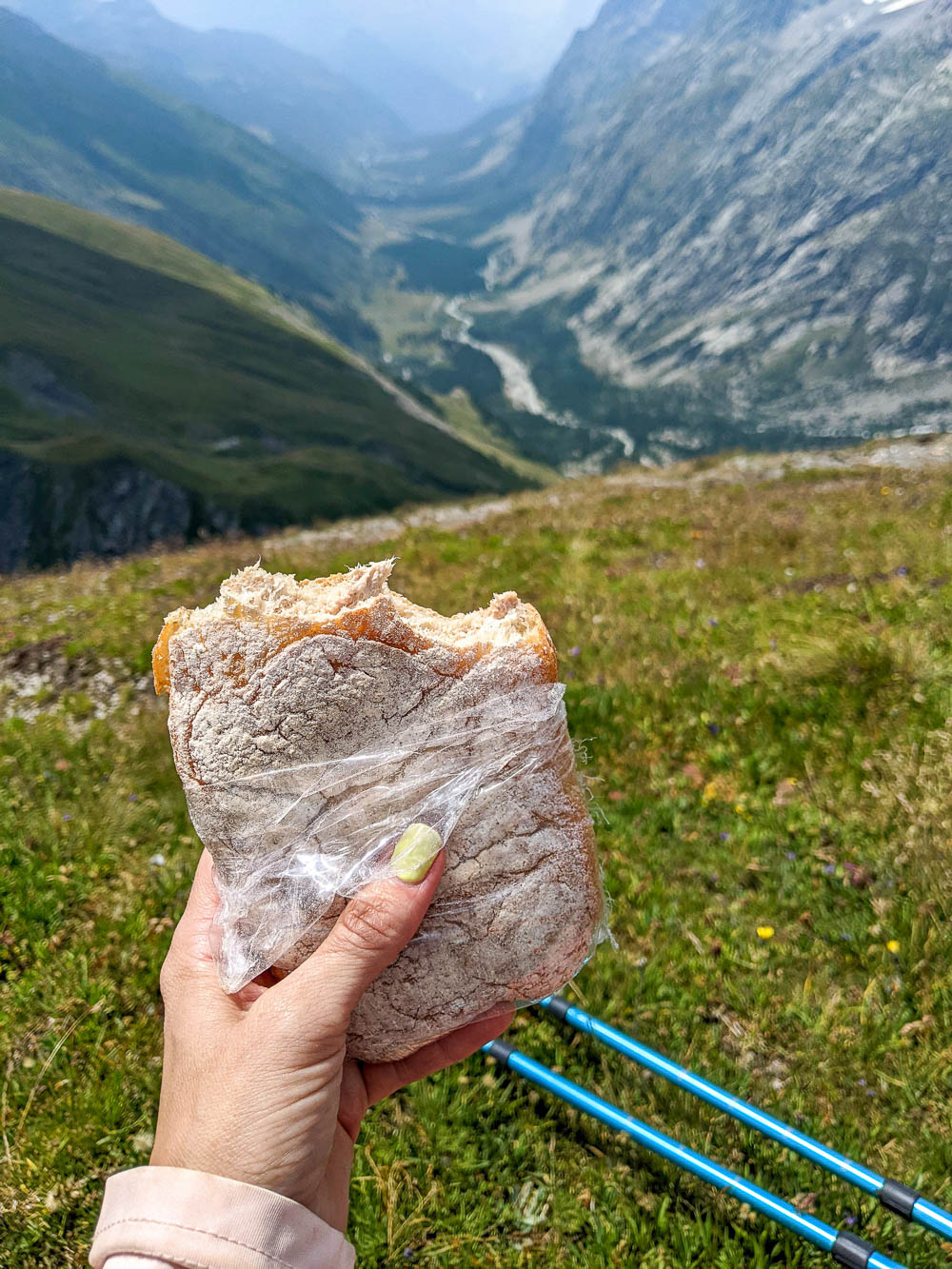
Prioritize things with multiple uses
Concentrate on packing only things that can double as other things. And don’t bring anything you’re only going to use once.
For example, instead of packing a headband, a bandana, ear muffs, and a scarf, pack a single neck buff instead. This one virtually weightless item can be used as all of those things (and more). I use this fun mountain-themed buff from the outdoor adventure experts at Baïst .
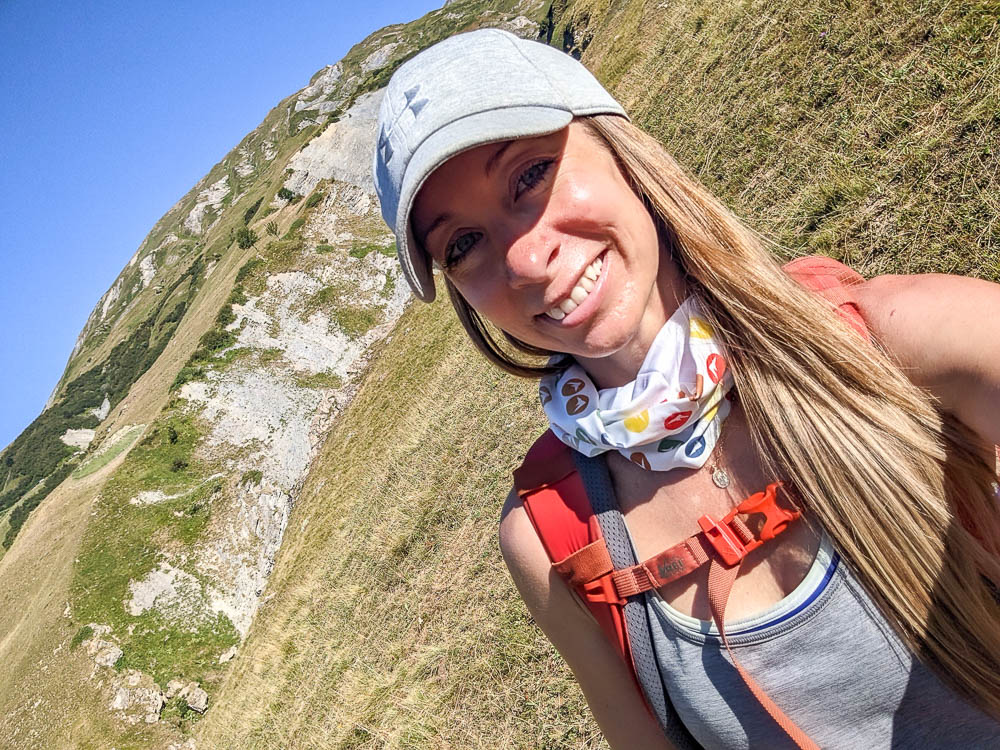
Instead of bringing a travel cutlery set (I have this one ), bring an all-in-one utensil (that’s also lightweight plastic instead of metal). You can find these on the register counter at the Intersport in Chamonix center.
Instead of bringing shampoo, conditioner, laundry detergent, soap, and toothpaste, you can simply bring one bottle of Dr. Bronner’s . It literally boasts itself as an “18-in-1” product. Now look, this solution is not for me personally, but I do know other TMB hikers who swear by this.
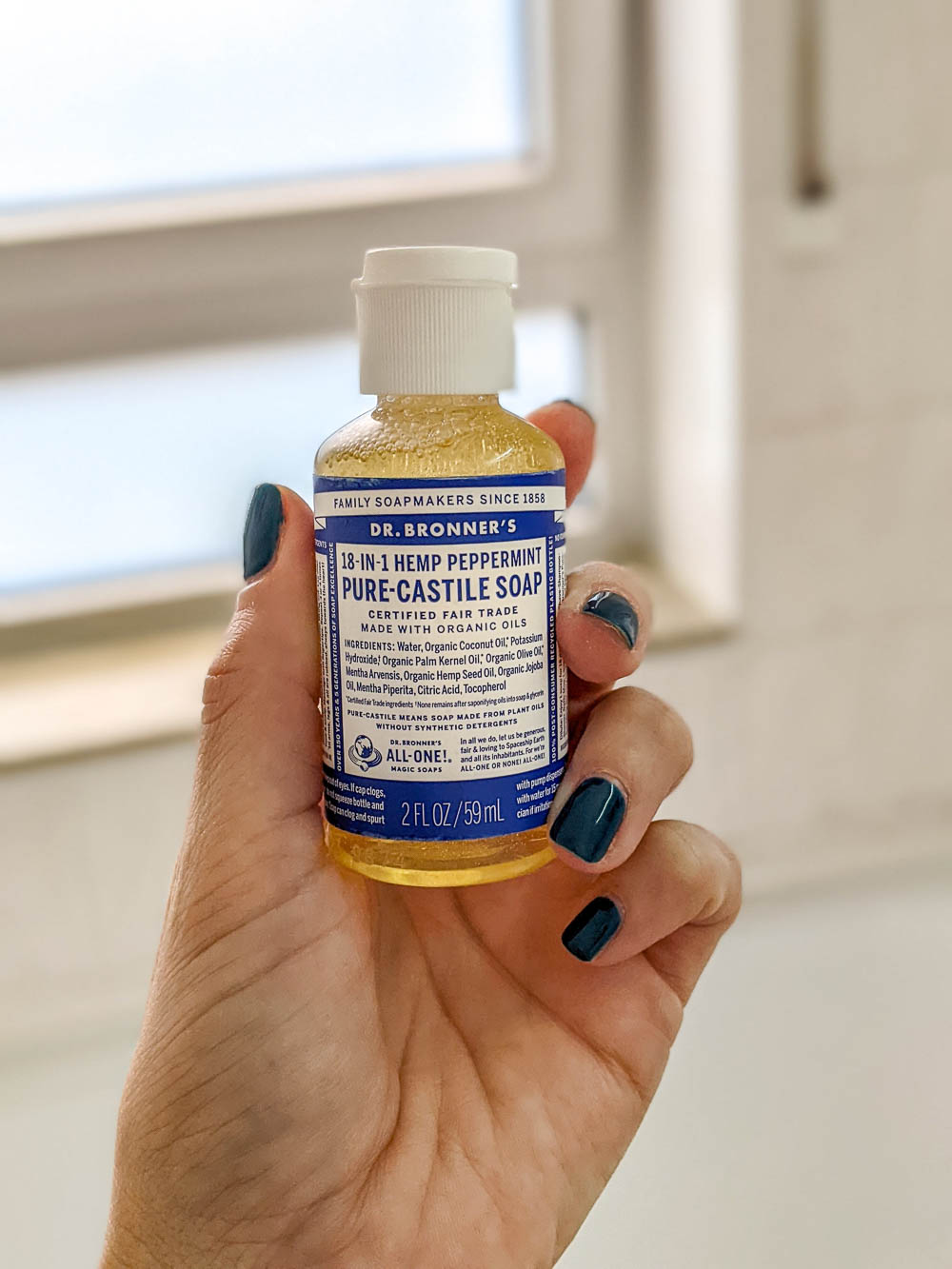
I personally use Dr. Bronner’s for laundry soap while traveling and also swear by it, but I still want to use separate products for toothpaste and hair conditioner. However, if you’re open to it, know that this is a highly recommended weight-saving solution! (I have the big bottle at home and refill the travel size before all my trips. Get both here .)
Basically, take a look at everything you want to bring, then think about which of those uses can be fulfilled by others. Time to get packing savvy!
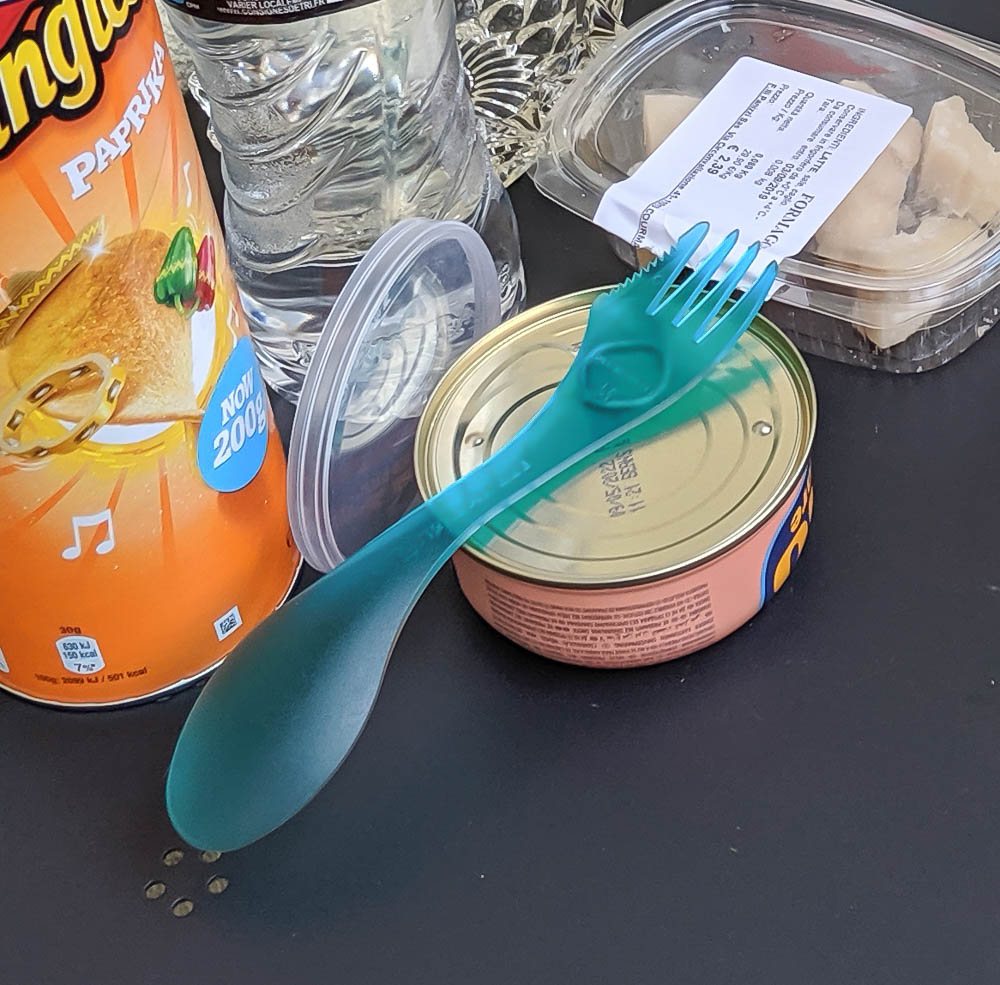
For my non-packing TMB tips, check out this post on the best Tour du Mont Blanc tips you’ve never heard.
But still be prepared
Unfortunately, you will still have to bring stuff you might not use at all. However, if it means they can potentially keep you alive, they’re worth bringing!
Examples would be: certain pieces of winter gear, first aid kit, emergency supplies, etc. These are things you might not / probably won’t / hopefully will not need but that you should most definitely still add to your Tour du Mont Blanc packing list. It sucks, yes, but it would suck even more to need these things and not have them.
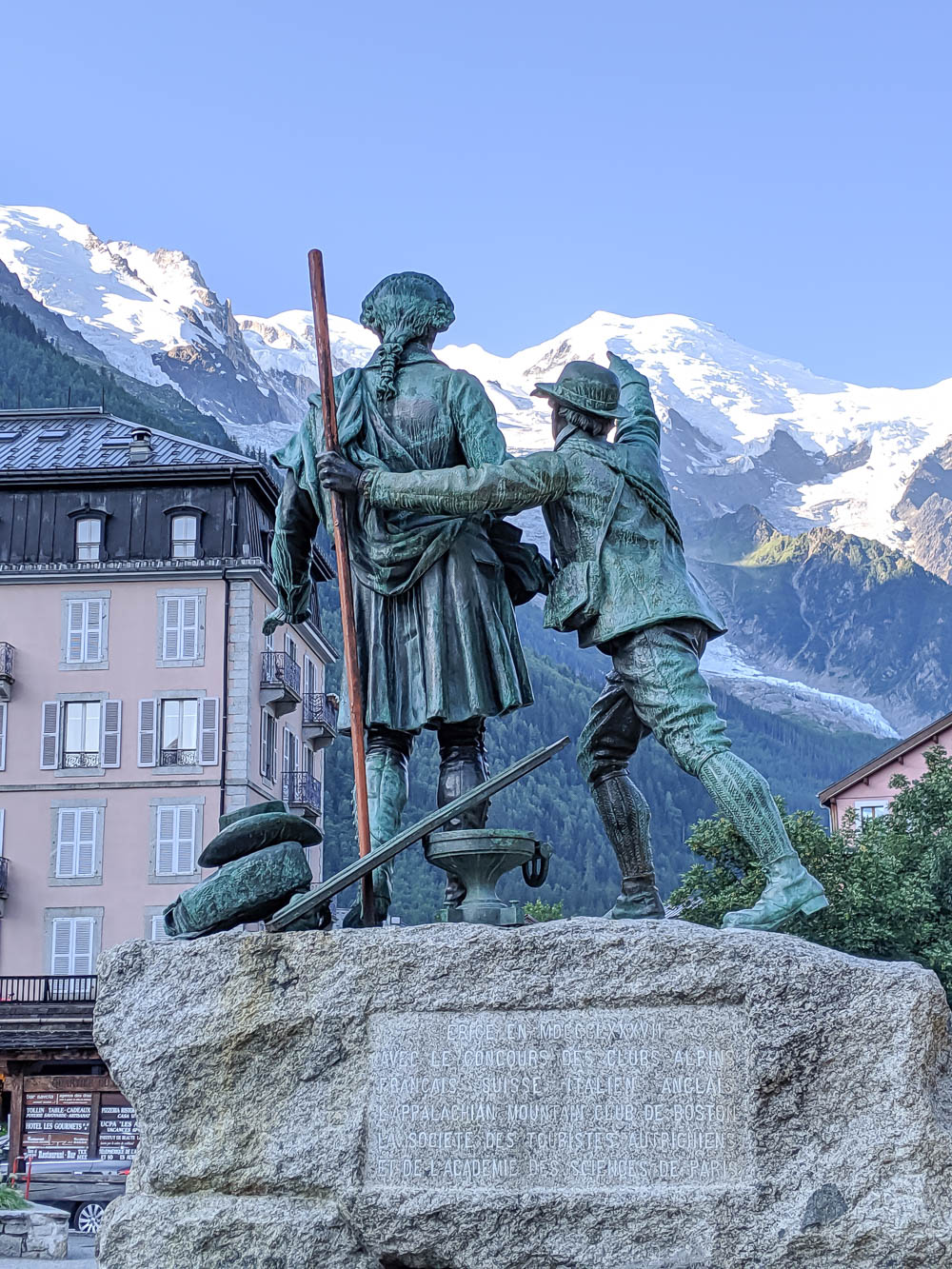
During my latest TMB hike, it ended up being a record-setting European heat wave so I did not (even remotely) need the fleece jacket, the gloves, the beanie, or the hiking tights I brought. BUT, it’s important to remember that weather in the high mountains is dangerously unpredictable (even in the summer) so always take that into consideration.
I also never used my first aid kit (bless!) or my safety whistle or any of the medications I brought, but I definitely hiked easier knowing I had them. Never head out on a hike without these things! They’re the kinds of things you always need to bring but hope to never use.
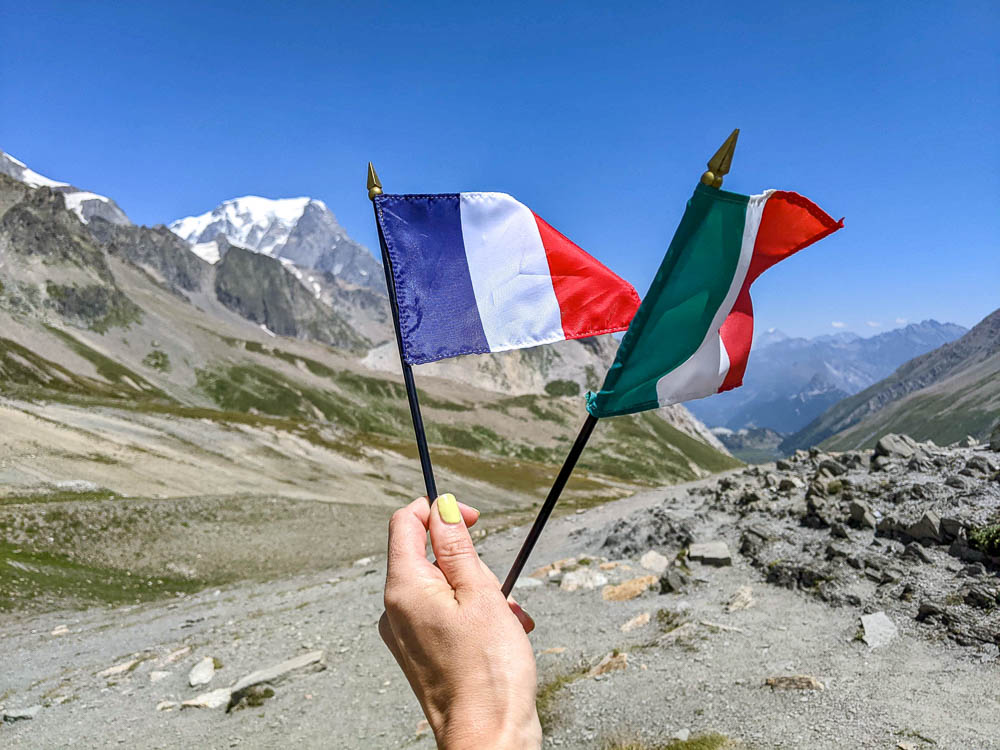
Allow yourself a luxury
Even though the overall goal is to pack as light as possible, please feel free to allow yourself a luxury or two. Hiking the Tour du Mont Blanc shouldn’t be a miserable experience.
If there’s something totally irrational that you still want to bring for whatever reason, do it. Understand that it means adding weight to your pack, but still bring it if you want; judgment be damned. (I brought mascara of all things and I have zero regrets.)
Also read: 21 Awesome Things to Do in Chamonix in the Summer for Your Alpine Bucket List
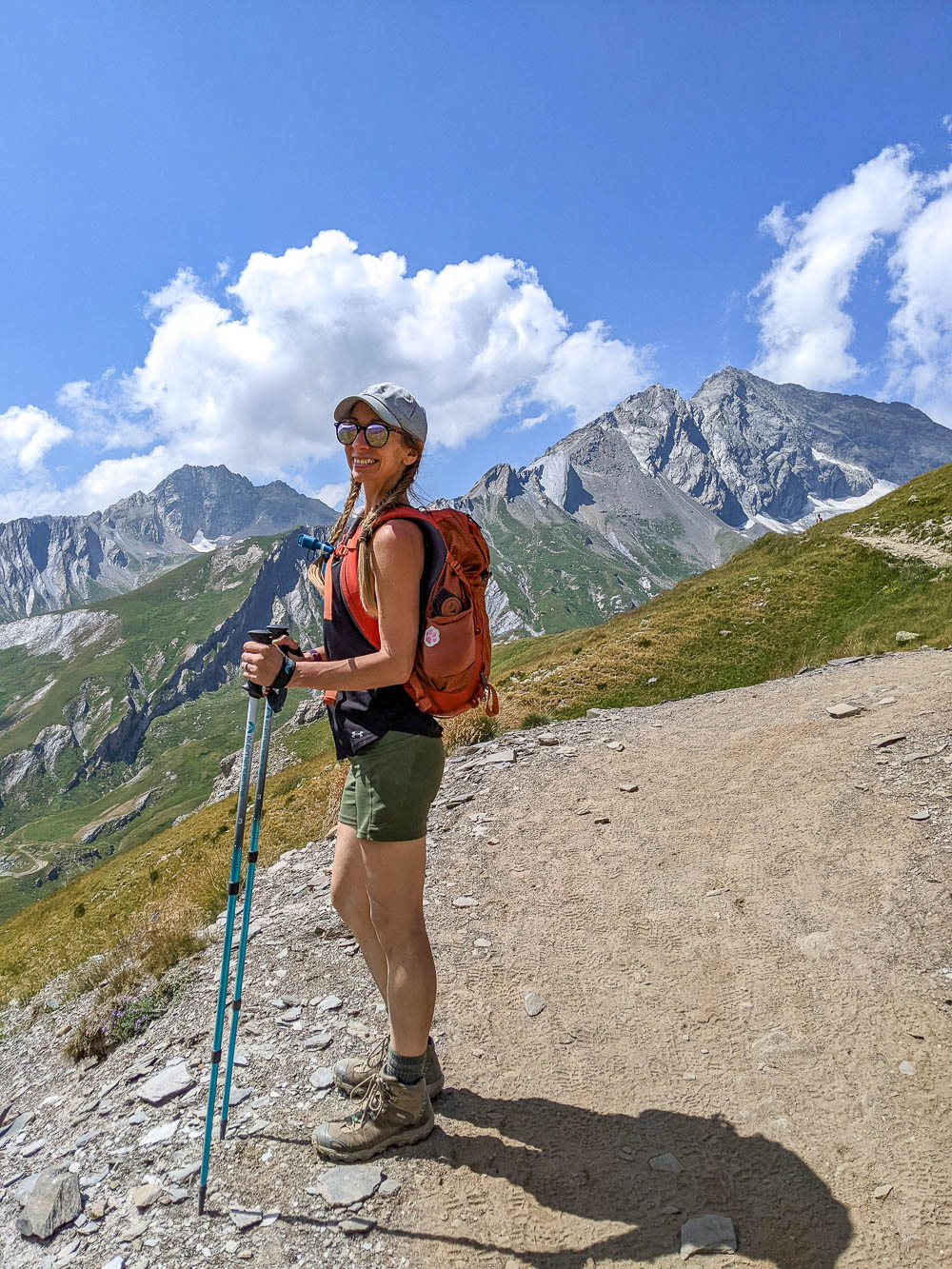
TMB packing list: The essentials
While everything in this Tour du Mont Blanc packing list is essential (because we’re only packing the essentials, remember?), there are indeed three most crucial items.
Choosing a hiking backpack for the Tour du Mont Blanc is a highly individual decision. It has to be comfortable and carry everything you need. It has to fit your body, your hiking style, and your budget. Figure all of this out, then go shopping.
When I was packing for my first and second Tour du Mont Blanc hike where I would be carrying everything for the entire hike, I used the Osprey Kyte 46 Women’s Backpacking Backpack . I love this bag. It fits my body perfectly and is extremely comfortable. It has pockets in all the right places, offers lots of accessibility, and is easy to use. Highly recommend.
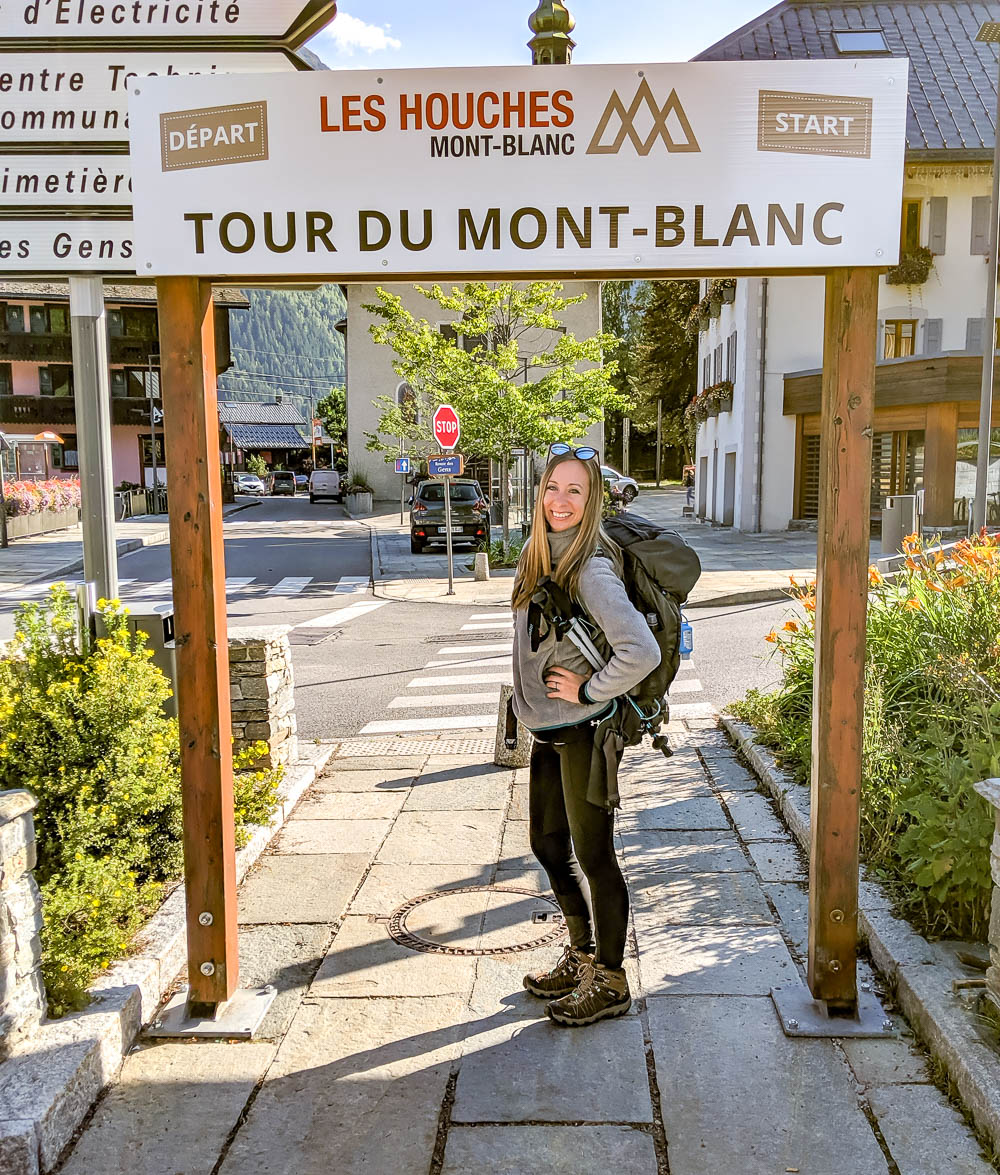
For my latest TMB hike where I utilized luggage transfer, I needed only an adequate day pack-sized bag for the actual hike and a duffel for the other stuff. For my day pack I use this 25-liter backpack from REI (which comes in both women’s and men’s styles so pay attention).
I admit it’s a tad bigger than I what I needed/wanted, but it worked just fine. I also didn’t have that much to carry since it was so hot and I didn’t need the winter gear I had anticipated needing to carry each day. (The problem with a bigger bag is that it encourages you to pack/carry more.)
When I hike the TMB again, I will probably get something like this 16L daypack from Columbia or this 13L Osprey daypack instead.
For all the other stuff, I used a standard duffel bag like this one or this one . (The TMB luggage transfer companies ask that you use only soft duffel-style bags for easier transport.)
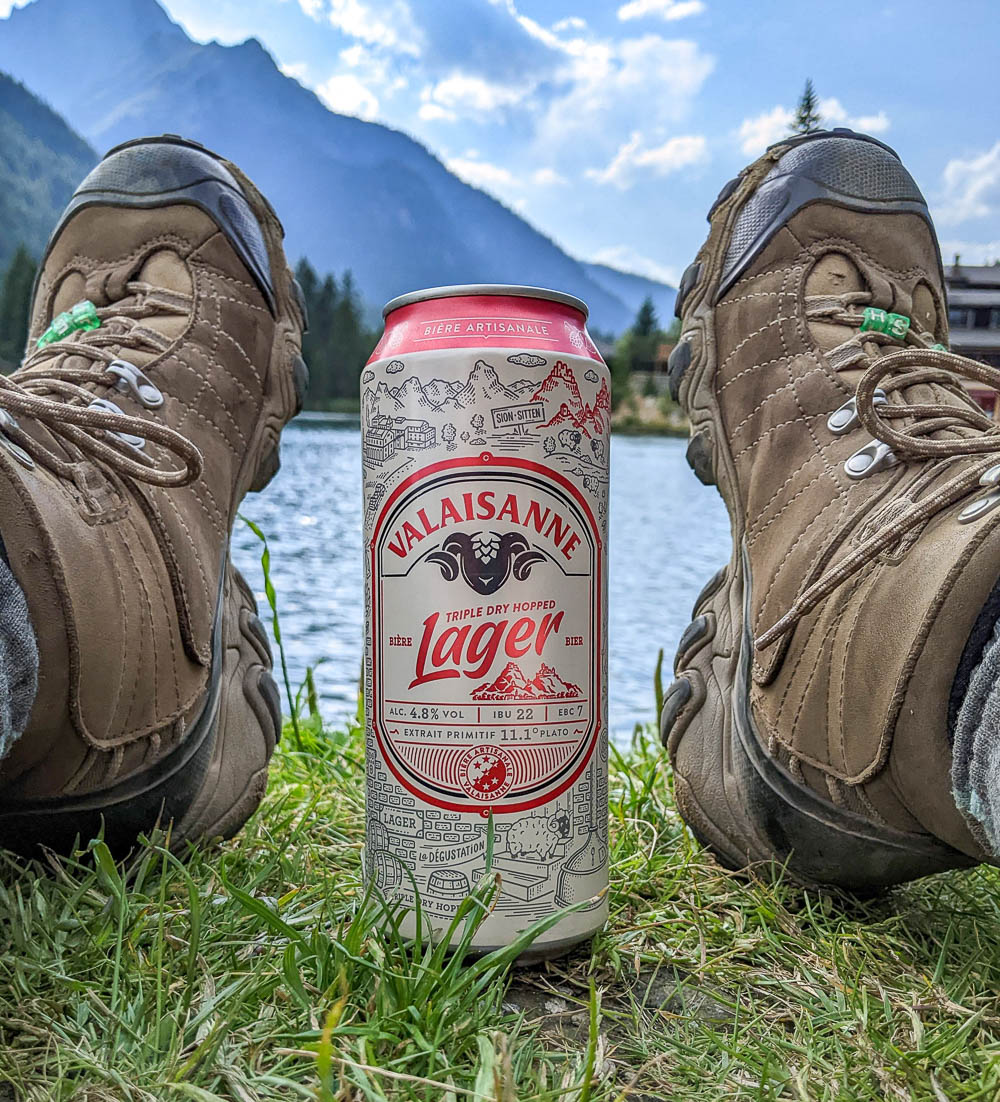
Hiking boots
Arguably the most important item on the Tour du Mont Blanc packing list is a great pair of hiking boots. To each his own but I highly recommend some solid hiking boots with ankle support because the trails here are anything but easy going.
Some people prefer to hike the TMB in trail runners or those weird FiveFinger Vibram things but I cannot even fathom this. For me, it’s classic mid-height hiking boots or bust (my ass).
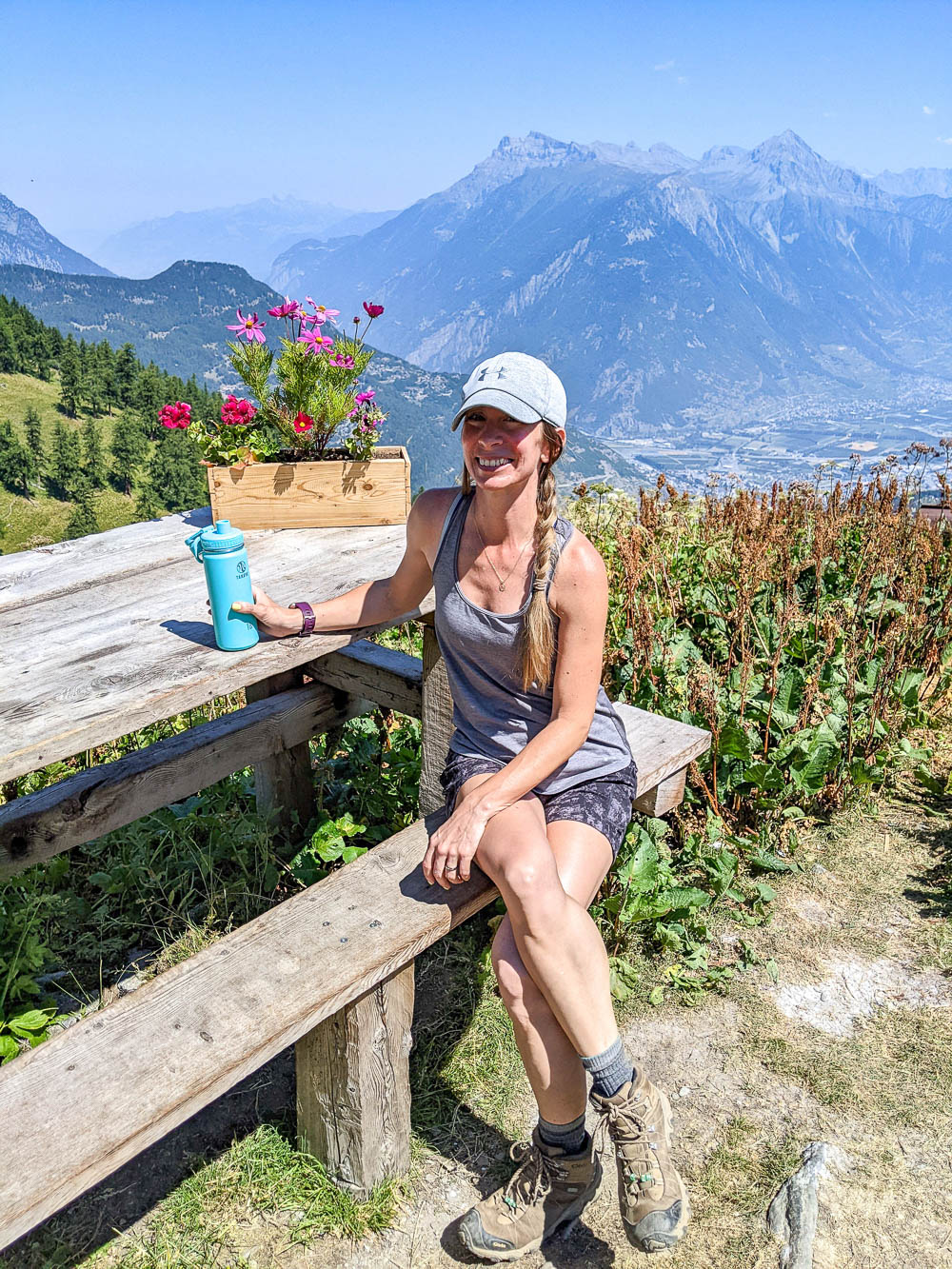
I wear the Oboz Bridger BDry hiking boots and I LOVE them. I’ve hiked all over the world in these things and did so right out of the box. I never had to properly break them in or anything like that. They’re comfortable, heavy duty, and waterproof.
You can get them here for women and/or men:
- Women’s Oboz Bridger BDry – Zappos
- Men’s Oboz Bridger BDry – Zappos
- Zappos always has free fast shipping and free returns (without needing a membership or anything like that). They’re my go-to shoe shop. Just saying.
- They’re also available at REI in case you’re a Co-op member (like I am)
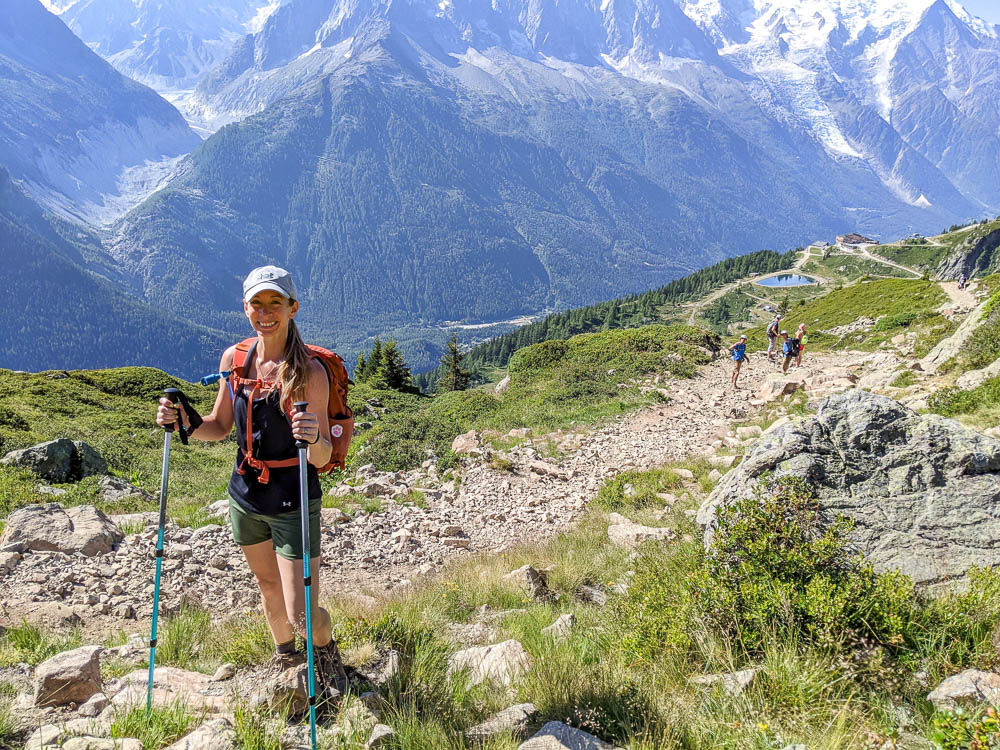
Hiking poles
First of all, trekking poles are life. They make SUCH a difference and I now swear by them. I will go more into this in another post, but just trust me here, you’ll want hiking poles.
There are varying degrees of hiking poles you can purchase. I’ve used some pretty pricey Black Diamond ones and I’ve used $20 poles too. And guess what? I can’t tell the difference. You do you though. Just get the poles.
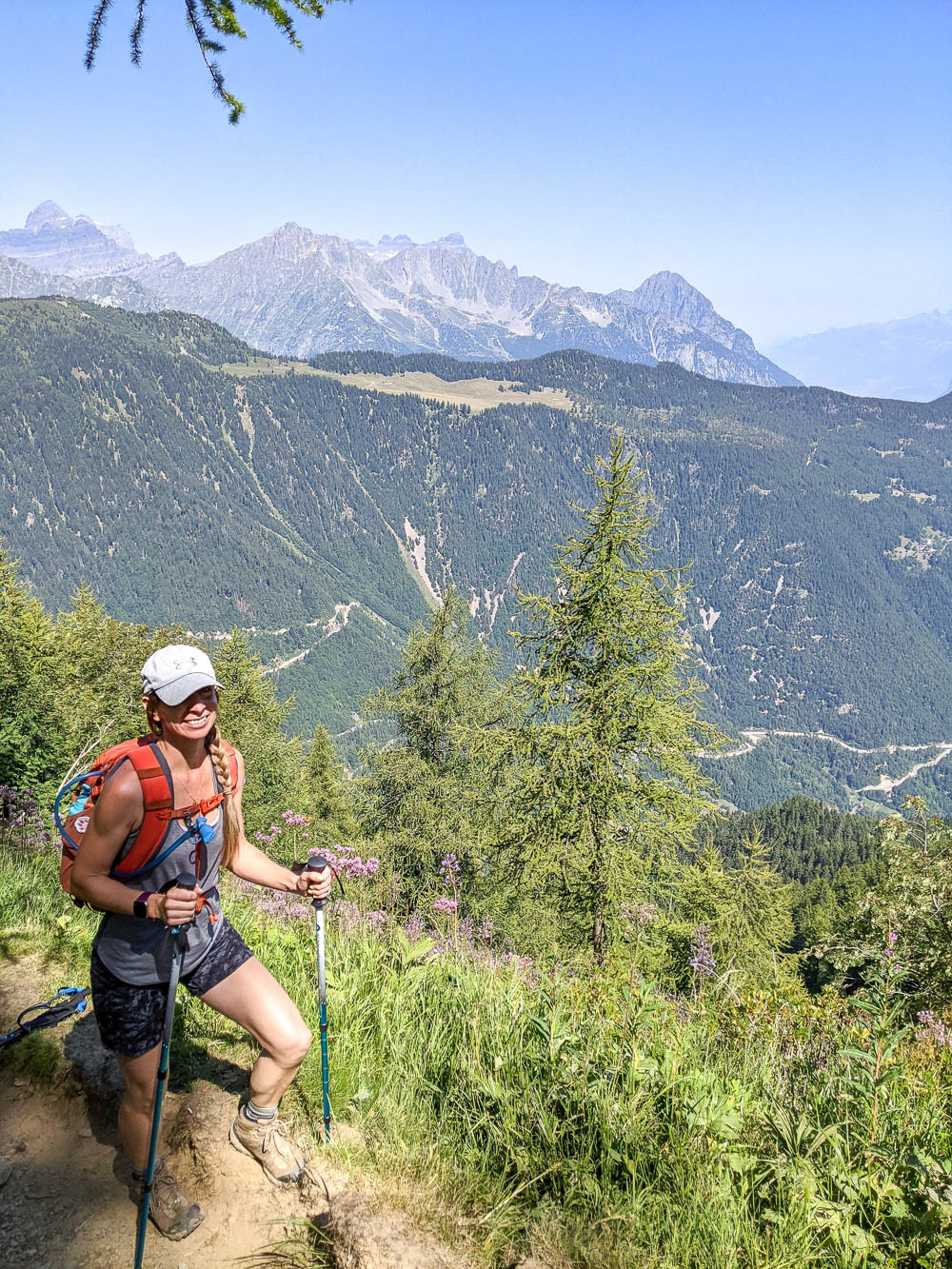
The thing to remember though is that you can’t fly with hiking poles in your carry-on luggage. So unless you plan on checking your hiking bag for your flight to France, you’ll want to just pick up some poles in Chamonix.
I left my super expensive ones at home and simply picked up some cheap poles at the Intersport in Chamonix. I didn’t get the cheapest ones, but I paid around $20 each for mine. And I’ve hiked all over with them! I’ve taken them on many of the day hikes around Chamonix and used them for my complete Tour du Mont Blanc hike. No issues whatsoever.
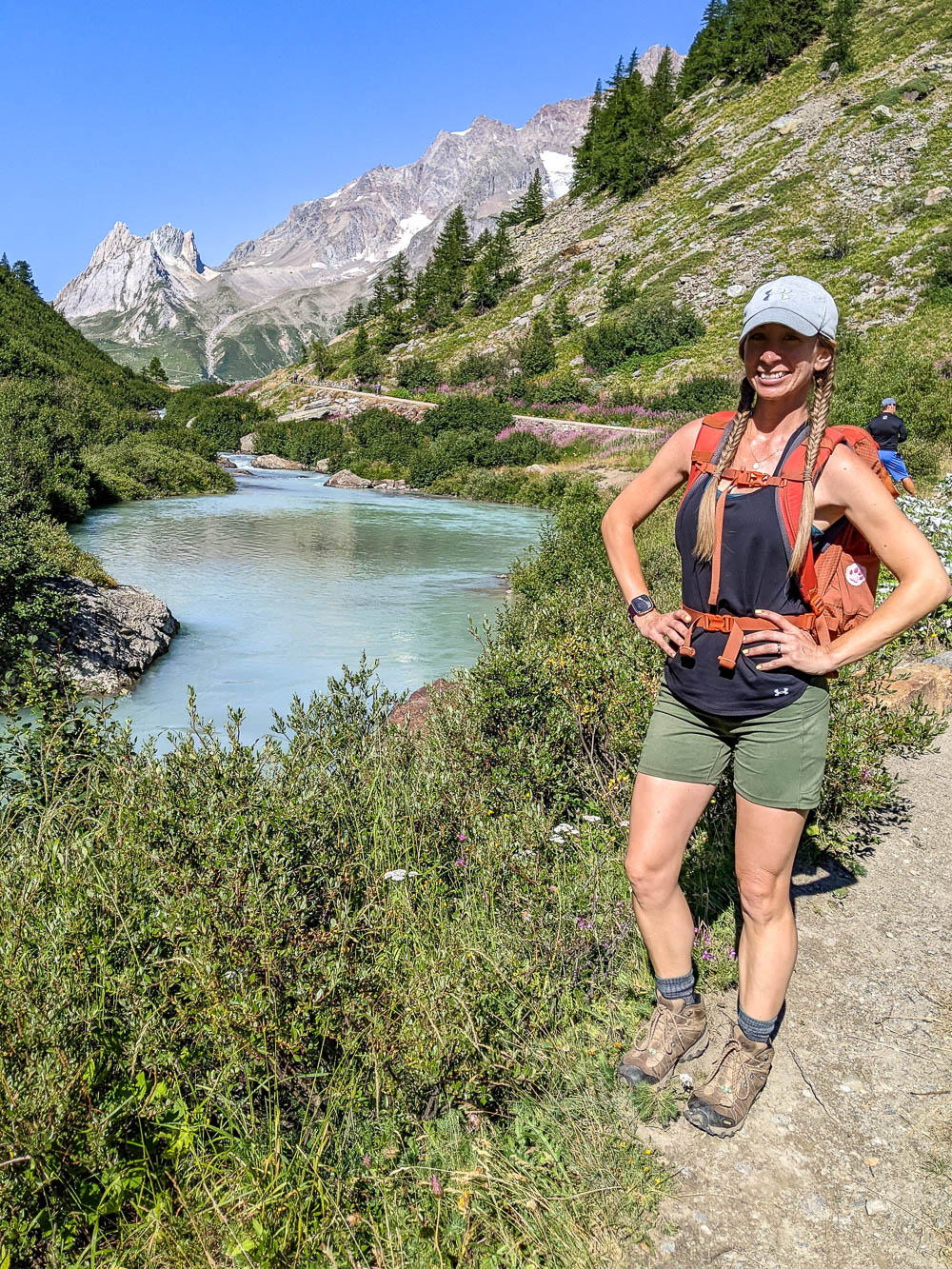
Interested in a guided TMB hike? Check out the exact TMB group hike I joined here.
Tour du Mont Blanc packing list: Hiking equipment
Beyond those three most important pieces of gear, here is the rest of the hiking equipment you’ll need for your ideal Tour du Mont Blanc packing list.
Water bladder / Hydration reservoir
Two liters is optimum. I use the Big Zip EVO from Platypus and love it. Staying hydrated on the TMB is so crucial and there are plenty of places to fill up. Depending on your route you could probably get away with just one liter, but I’m not risking ever being without water. (I drink a ton while I’m hiking.) This never leaks and makes it so easy to literally drink while hiking, hands free.
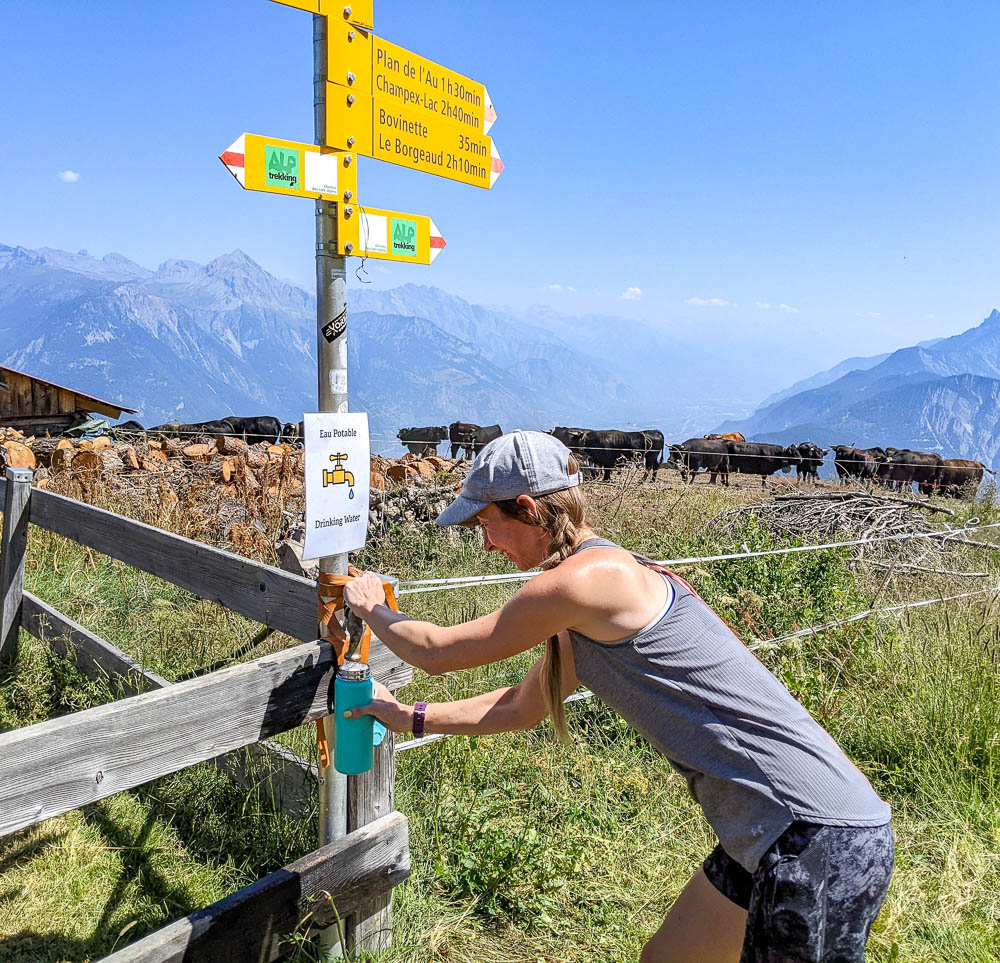
Refillable water bottle
Yes, you could always combine these two and just use a water bottle, but I use them for different things. And I drink a lot of water so I always have it with me. (I actually refer to it as my “emotional support water bottle.”)
The bladder I use to guzzle water while I’m actively hiking. The refillable water bottle I use at breakfast, at dinner, while lunching, while out exploring on my rest day in Courmayeur , and for filling with my Liquid IV packets. All things I can’t do with a backpack water bladder.
I use the ultra-cold insulated stainless steel Takeya water bottle . But there are definitely lighter weight options available. (Like this one or this one .) You could even buy a plastic water bottle (I know, sorry) from the airport and just keep refilling it.
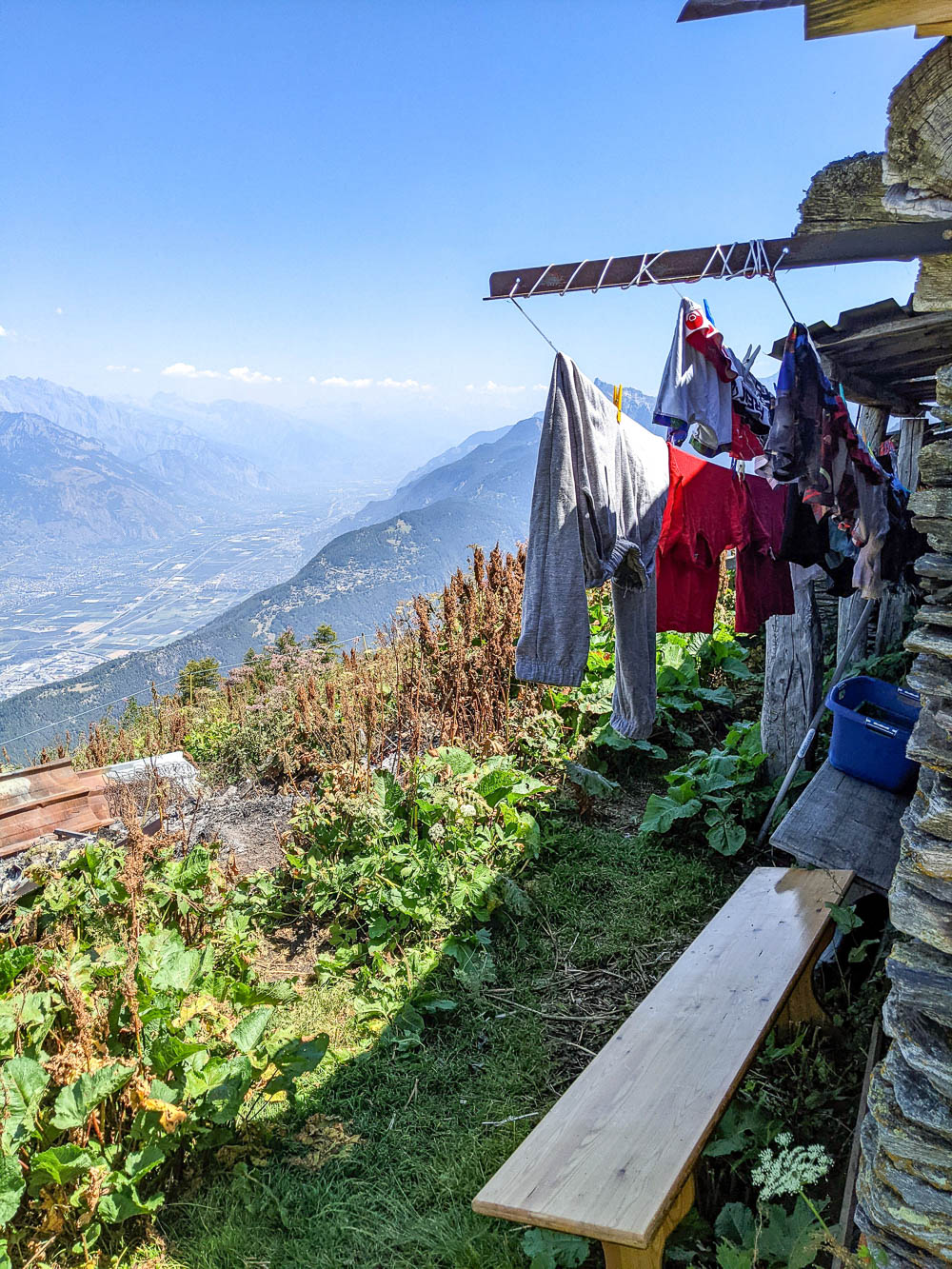
Quick dry towel
Quick-dry, microfiber towels are always good to bring along in your Tour du Mont Blanc packing list. The refuges and hotels all (for the most part) have towels for you to use. But maybe they’re too small, too few, or, in the case of one place I stayed, way, way too stinky. Having your own towel is never a bad idea.
Bring one medium-sized towel or a combination of sizes. (I use this multi-size 3-pack .) They dry quickly so you wash them when you need and pack them up the next morning without all the smell.
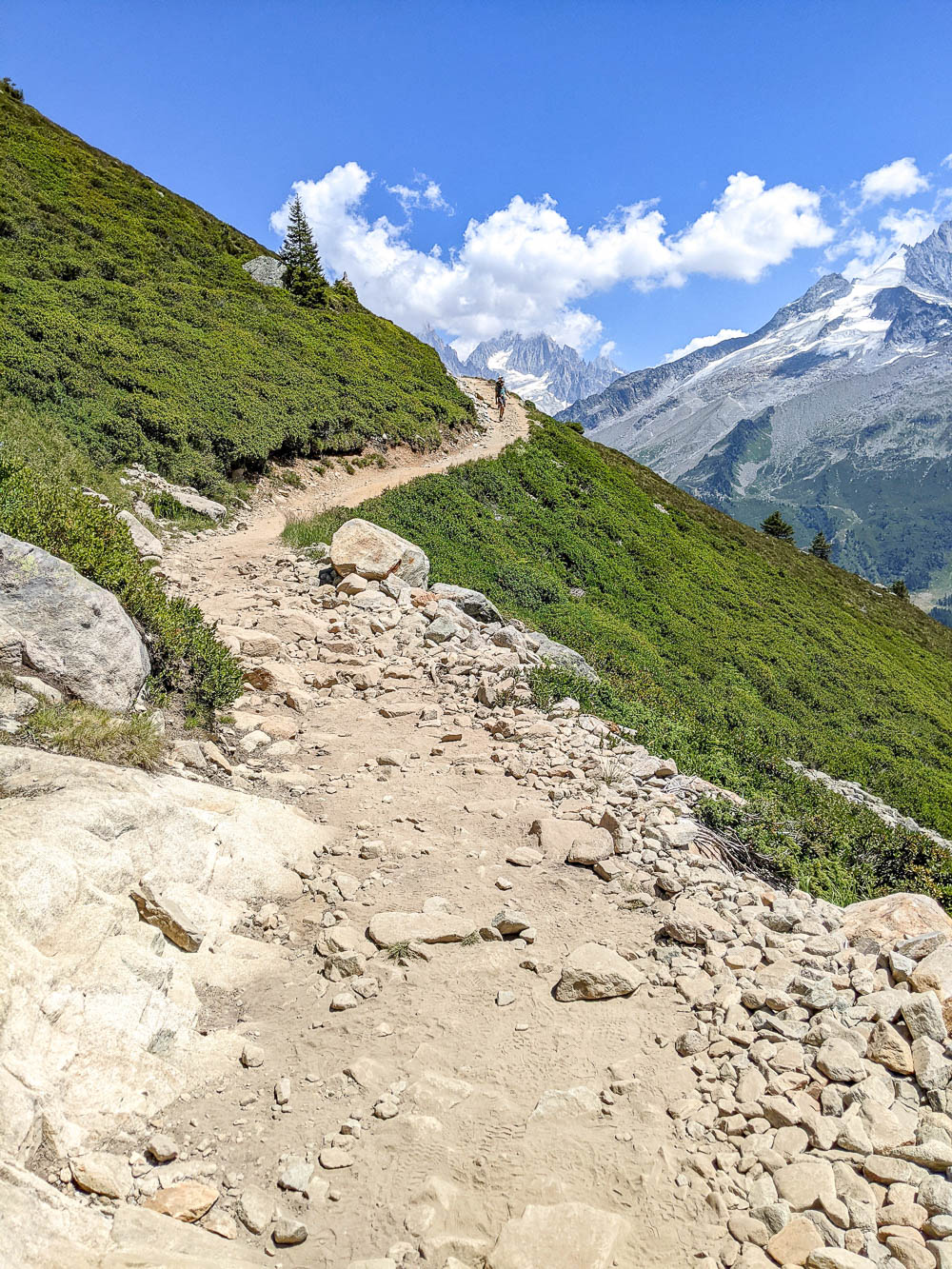
TMB guidebook
I’ve used both the “TMB Bible” (the Kev Reynolds TMB guidebook ) and the Knife Edge Outdoor Tour du Mont Blanc guide . I prefer the Knife Edge version, but you should check them both out to see which is right for you. (I also have the Knife Edge guide to day hikes around Chamonix too!)
Fun fact: While hiking the TMB in 2019, I actually ran into the author of the Knife Edge book on the trail! He spotted me using his guidebook and came over to say hi. I immediately asked him for two things: a selfie and directions.
Also check out: Tour du Mont Blanc Self-Guided Vs. Guided : How to choose which is best for YOU
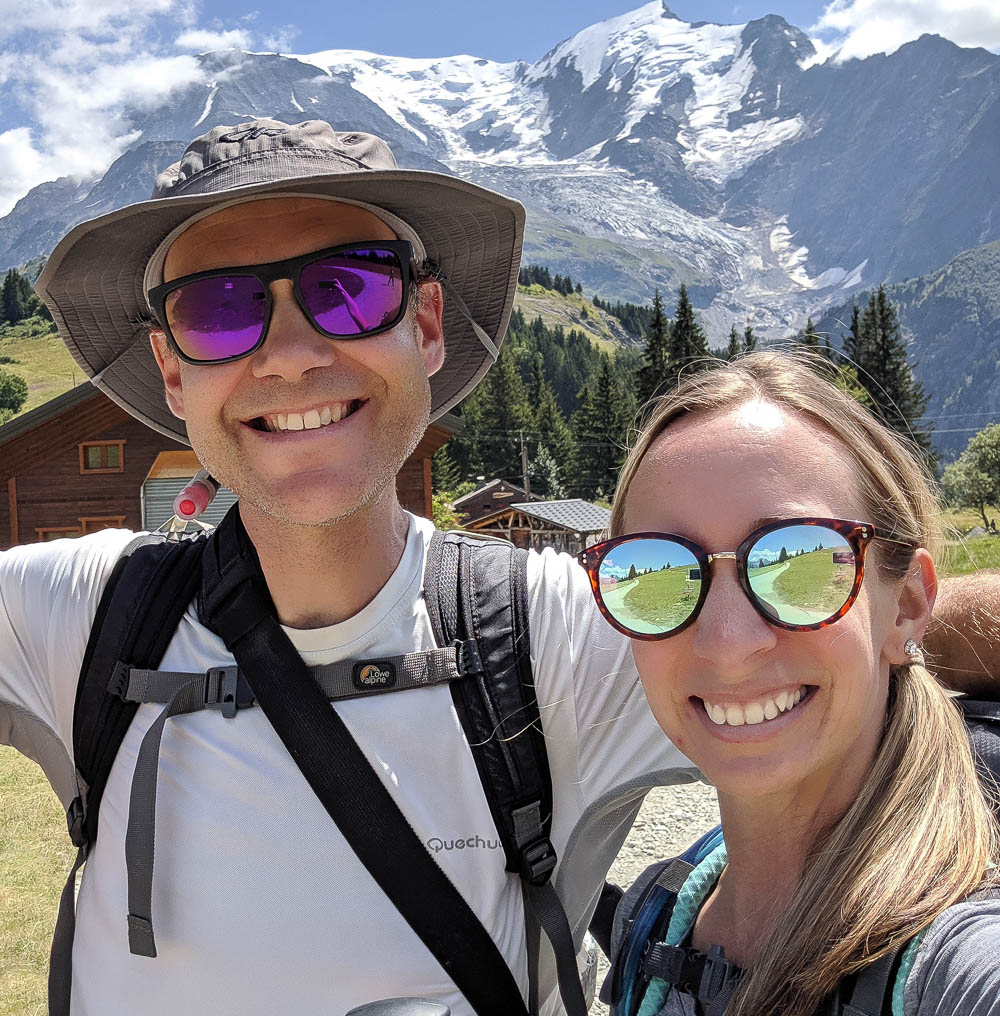
Travel cutlery
Even if you’re not camping the TMB, you’ll still need utensils to eat with out on the trail. You can bring a dedicated travel cutlery set (like this one ), or take the economical route and pick up a lightweight all-in-one utensil, available here in a 6-pack (best deal) or as a single at the Intersport in Chamonix (about 3€ each).
I used mine every day for spreading peanut butter, cutting cheese, bread, and meat, eating canned foods, and more.
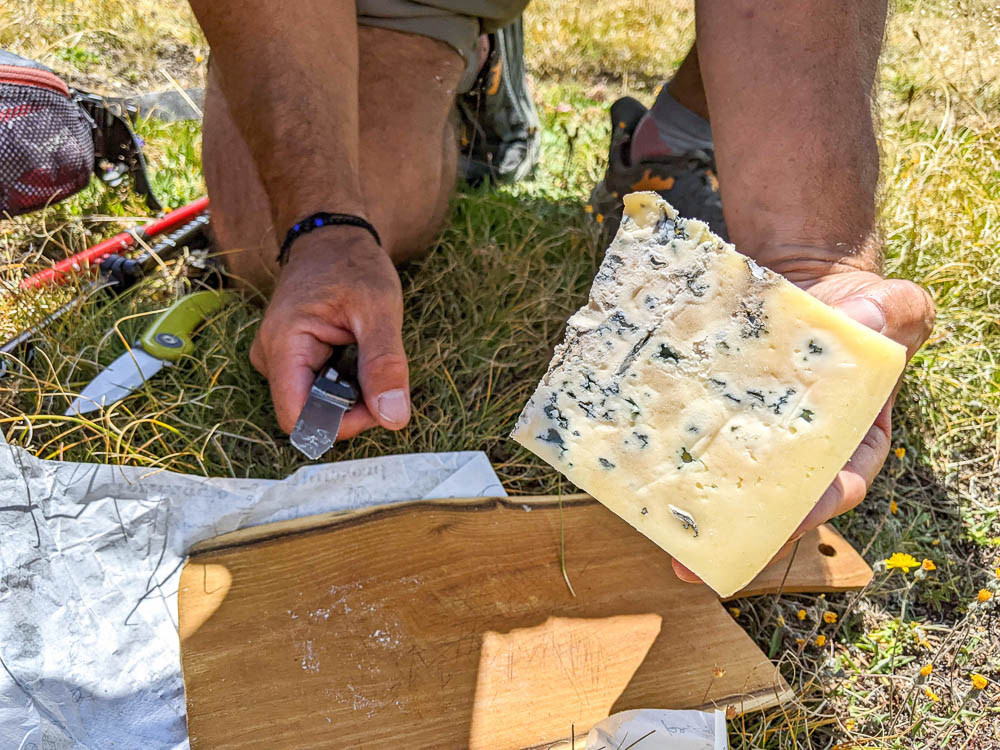
Safety whistle
It’s imperative that you bring along a safety whistle on the Tour du Mont Blanc (and any hike actually). Most hiking backpacks actually have a safety whistle built in which you might not even know about (usually on the chest buckle).
However, if you want something a little more powerful, pick up a dedicated safety whistle like this one. Also, know in advance how to use it. (Three sharp blasts for emergencies in the mountains. Watch this video for a quick lesson.)
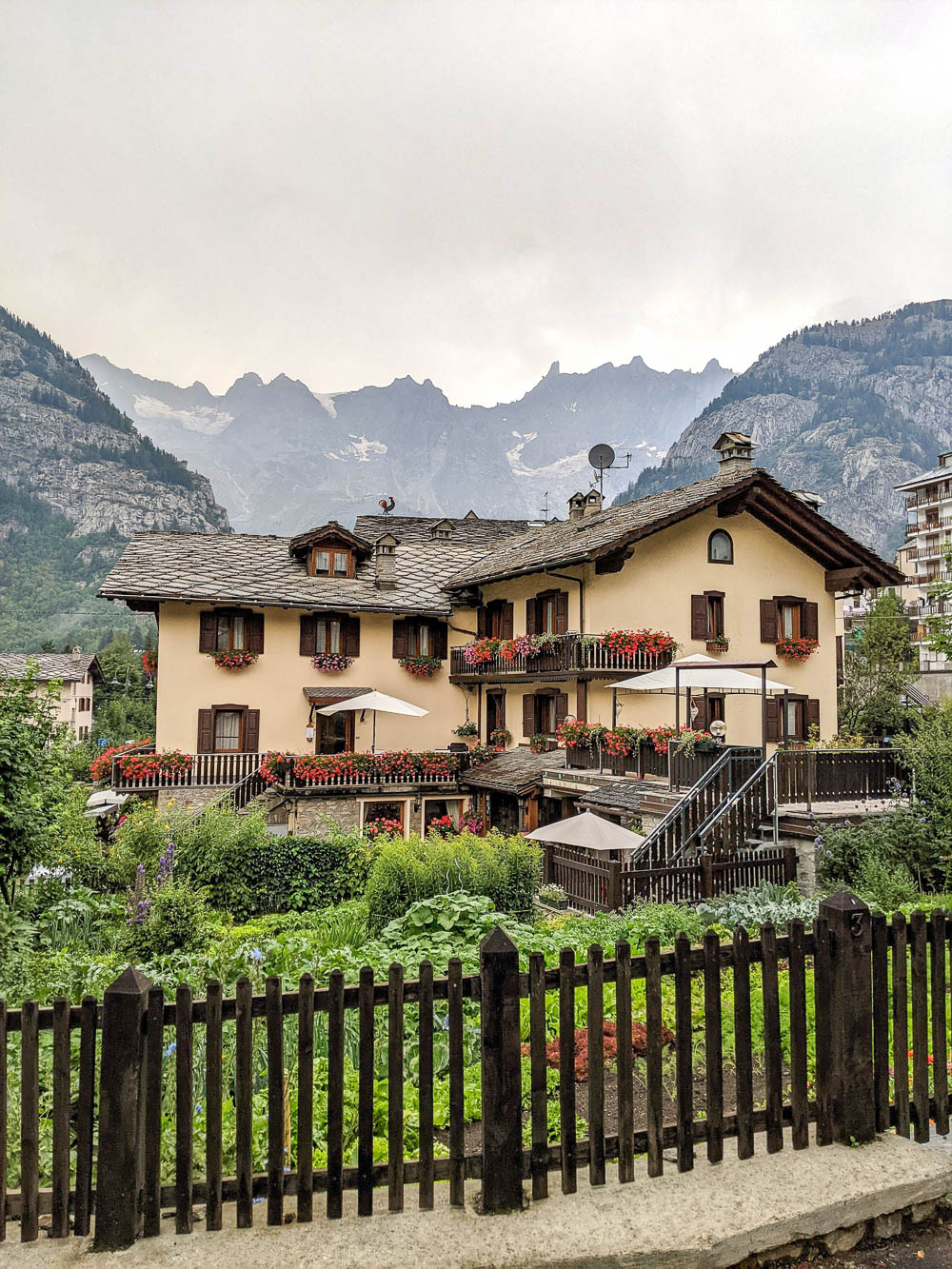
Most hiking backpacks also come with a built-in rain cover—a waterproof pouch of sorts that secures around your backpack to keep everything in it dry.
Check the bottom pouch of your backpack to see if yours has one. If not, you can always pick up a separate backpack rain cover here .
Also read: Where to Find the Tour du Mont Blanc Sign in Les Houches and How to Get There
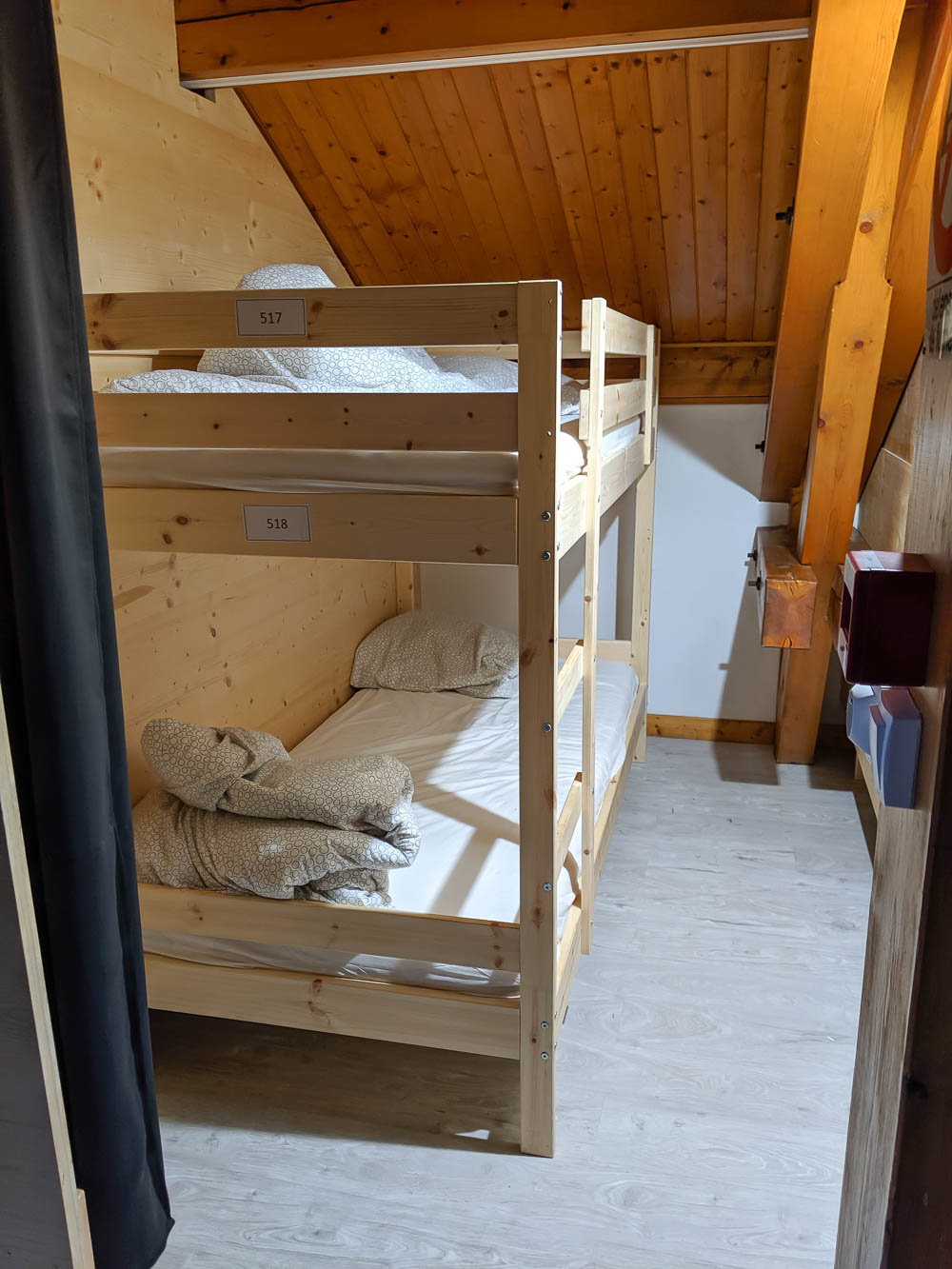
Sleeping bag liner
Sleeping bag liners are a must for your Tour du Mont Blanc packing list. Literally, the refuges require that all hikers bring them. They provide pillows and comforters, but not sheets, so you need to bring your own. I use this sleeping bag liner from the Friendly Swede.
These are thin silk sheets you sleep in when sleeping in public places like refuges and other mountain huts. It’s like a sleeping bag that’s only a sheet. They fold up pretty small and aren’t too heavy.
Fun fact: The French word for sleeping bag liner translates to English as “meat bag.” So when you see “meat bag” as a requirement on a refuge website, this is what they’re talking about.
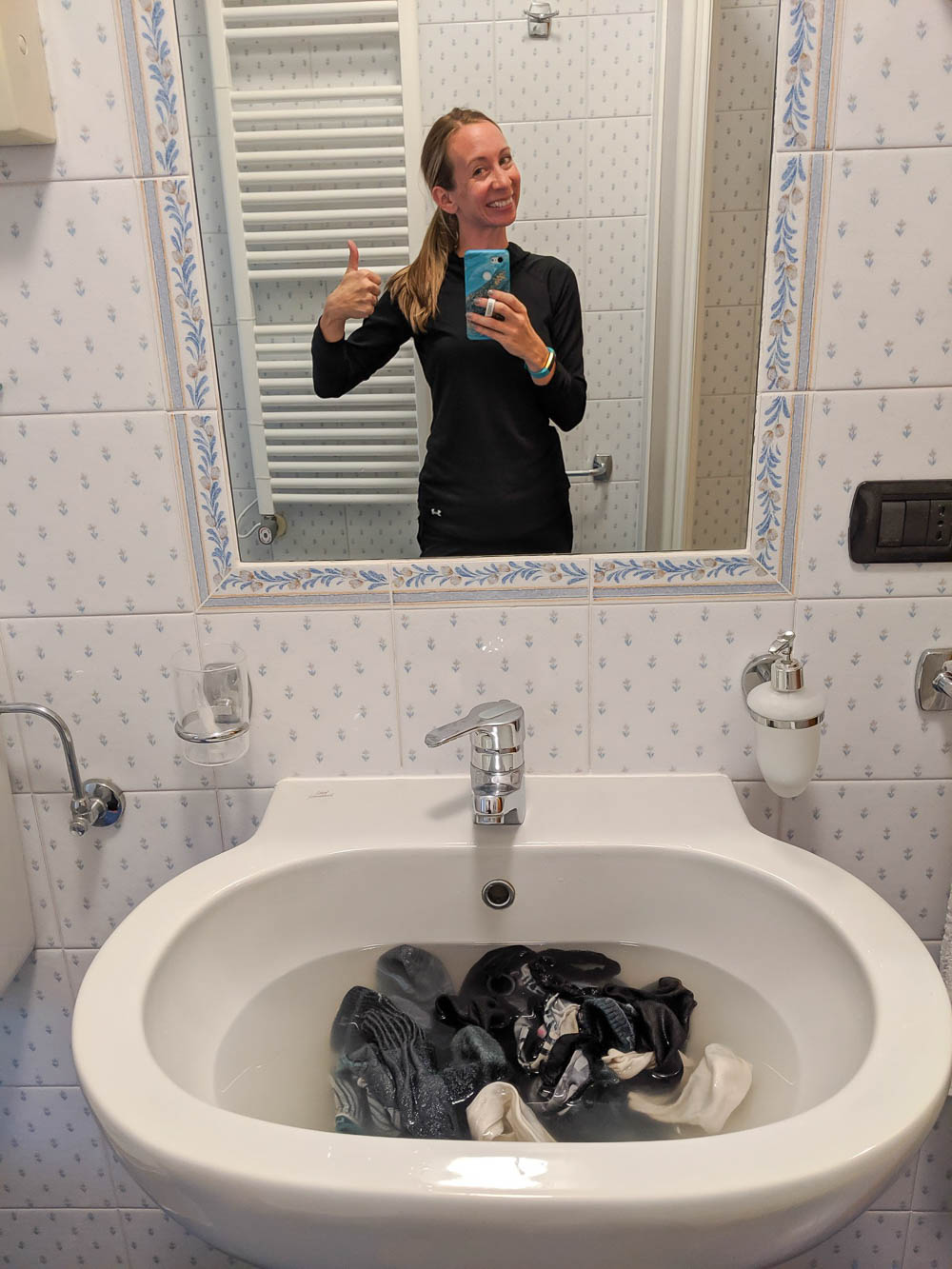
Dr. Bronner’s
I always bring along a small bottle of Dr. Bronner’s whenever I travel anywhere so I can wash things in the hotel sink. It works better than any other travel laundry detergent I’ve ever used and smells nice too. And yes, washing your hiking clothes nightly is an absolute MUST. Don’t miss this post on How to Wash Your Clothes on the Tour du Mont Blanc .
And as I’ve said, you can also use it to wash your hair and body, brush your teeth, and a whole bunch of other things I haven’t attempted yet.
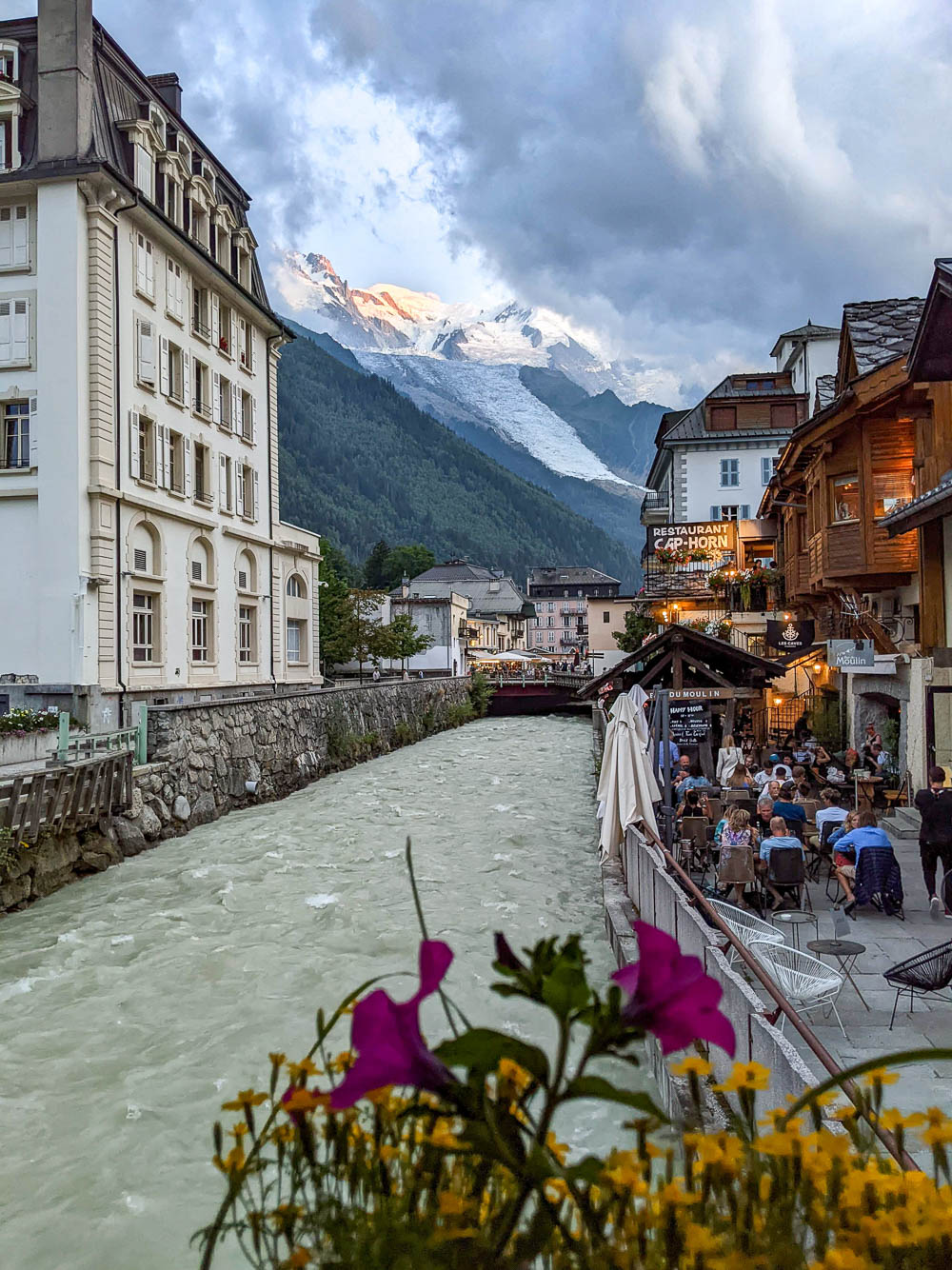
Also check out my full travel guide to visiting Chamonix In the Summer , the perfect Alpine escape.
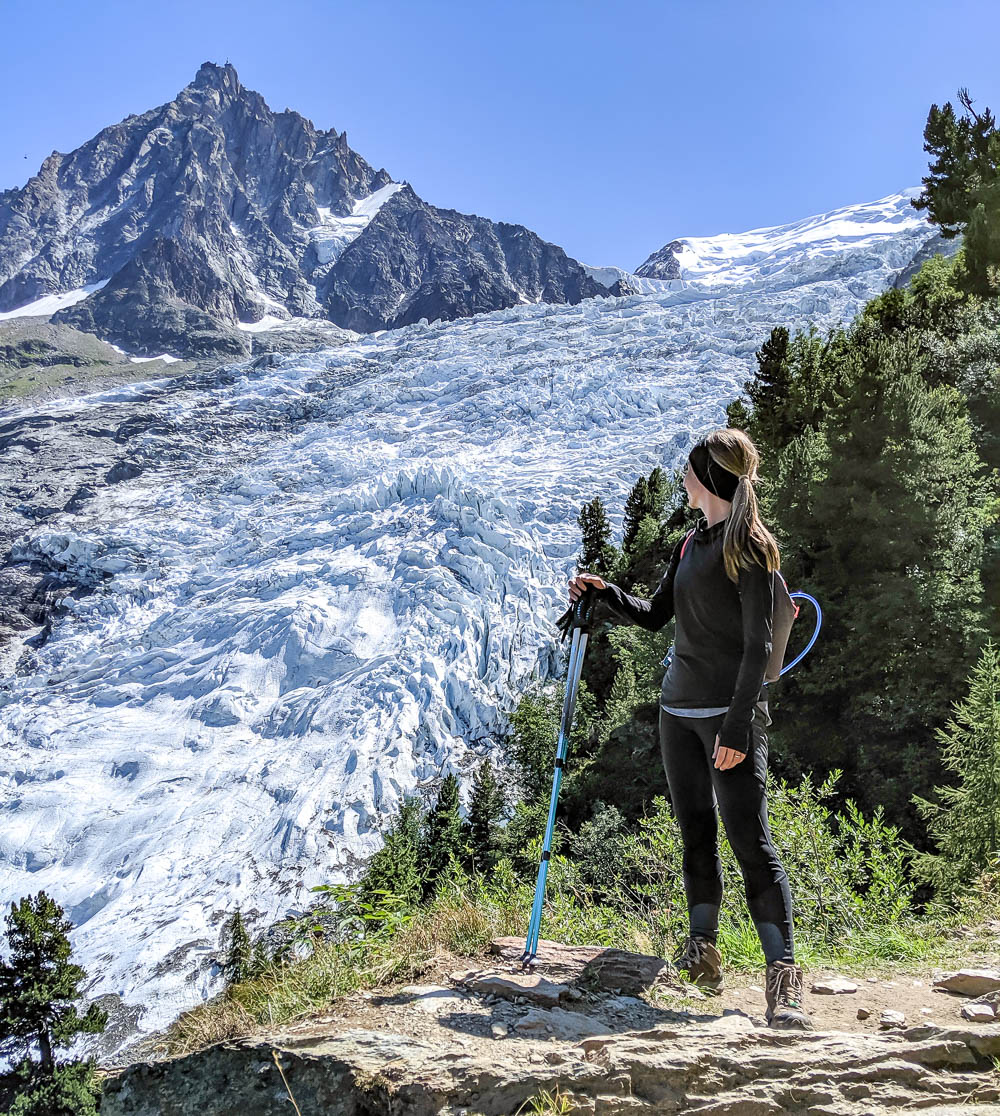
Tour du Mont Blanc packing list: Clothing
Note here that what clothing you add to your personal Tour du Mont Blanc packing list will largely be dependent on weather and time of year. My latest TMB hike in 2022 was during a record heat wave in late July. In 2019 I just about froze every night in August.
The weather in the mountains is notoriously unpredictable. Come prepared for all situations but keep it reasonable too. For me, I was using luggage transfer which meant I really only had to rely on the weather report for each day and could leave behind all the stuff I was sure to not need.
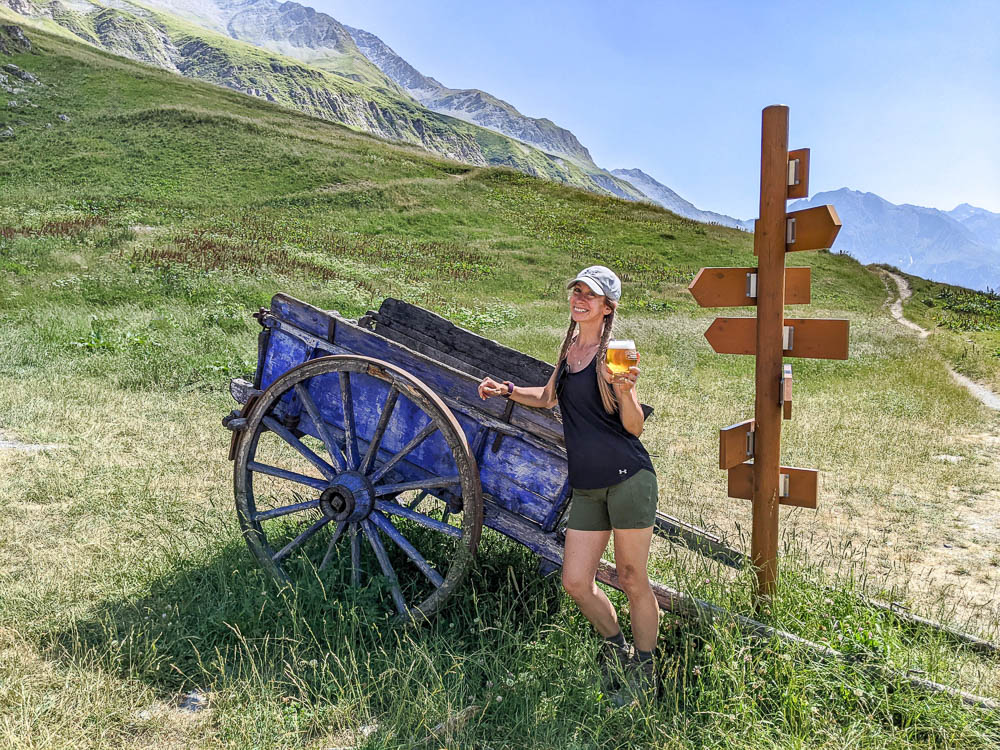
Bring at least 2 short-sleeve hiking tops and 2 long-sleeve hiking tops . (Even during the heat wave I wore the long-sleeved tops over my tank tops every day to keep the sun off.) This way, you can wash the one you hiked in at night and put on a new one the next day in case it isn’t finished drying.
I typically wear Under Armour workout tops but I also love Columbia’s short-sleeve and long-sleeve active tops as well.
Bring 2 tops for non-hiking activities . Things like hanging out in the hotels/refuges, meals, sleeping only, airplane rides, etc.
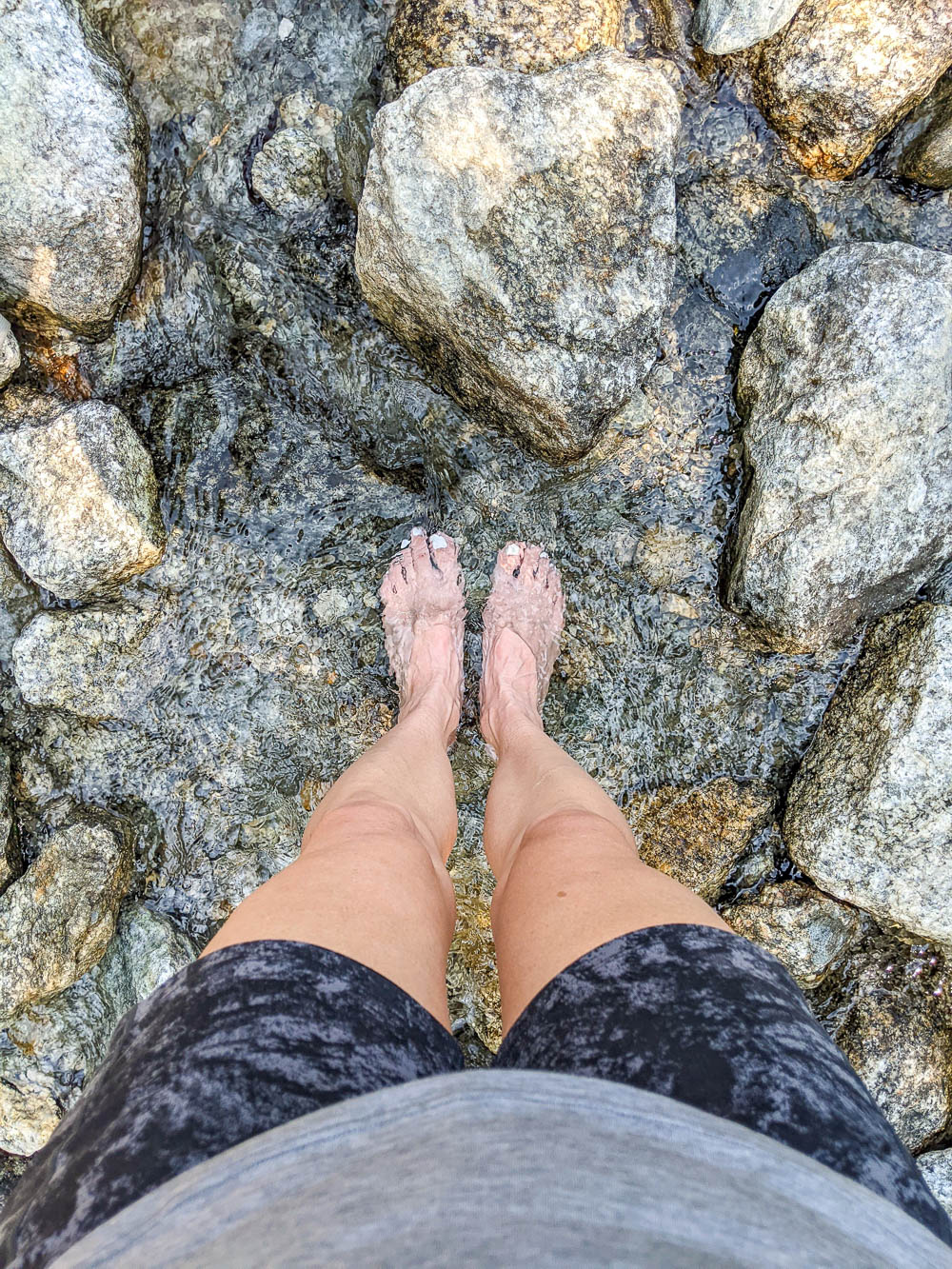
If you prefer shorts, bring 2 pairs of hiking shorts . If you prefer pants, bring 2 pairs of hiking pants . Many hikers prefer convertible hiking pants (this these or these ) so you can have pants + shorts in one garment. I brought two pairs of shorts and a pair of hiking tights I never wore because it was way too hot.
I wear these “yoga” shorts for hiking which are very comfortable and even have pockets. But I know most people prefer to hike in traditional hiking pants or shorts .
Bring 2 pairs of non-hiking pants to sleep in, wear to meals, wear out in town during your rest day, etc. I have this pair of light, fleece-lined leggings that I wear religiously. I’m even wearing them as I type this. However, it was often way too hot in our unconditioned lodging to even think about pants so at dinner I simply wore the pair of clean hiking shorts I was going to wear the next day.
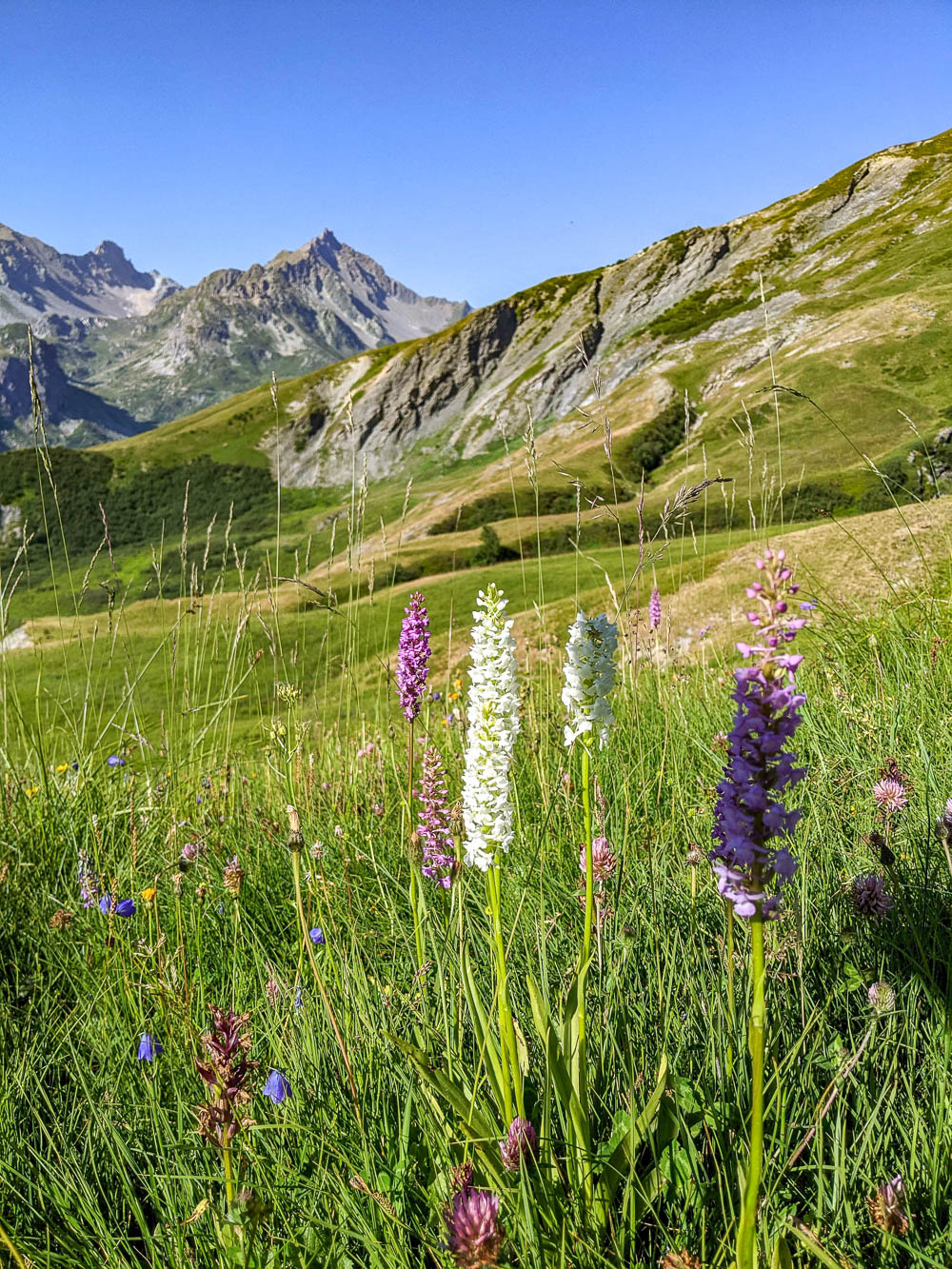
Ladies, bring 2 sports bras and rotate them. Wash the one you hiked in each night, wear the other one the next day while the other one finishes drying. (FWIW, I have found Under Armour sports bras to be far superior to other brands.)
Everyone, bring underwear . Personally, my underwear are small, barely-there affairs (TMI?) so I opt for bringing a clean pair for each day of the hike because they don’t weigh very much. Others will recommend you bring a few pairs and wash them regularly. I don’t want to do that. You do you.
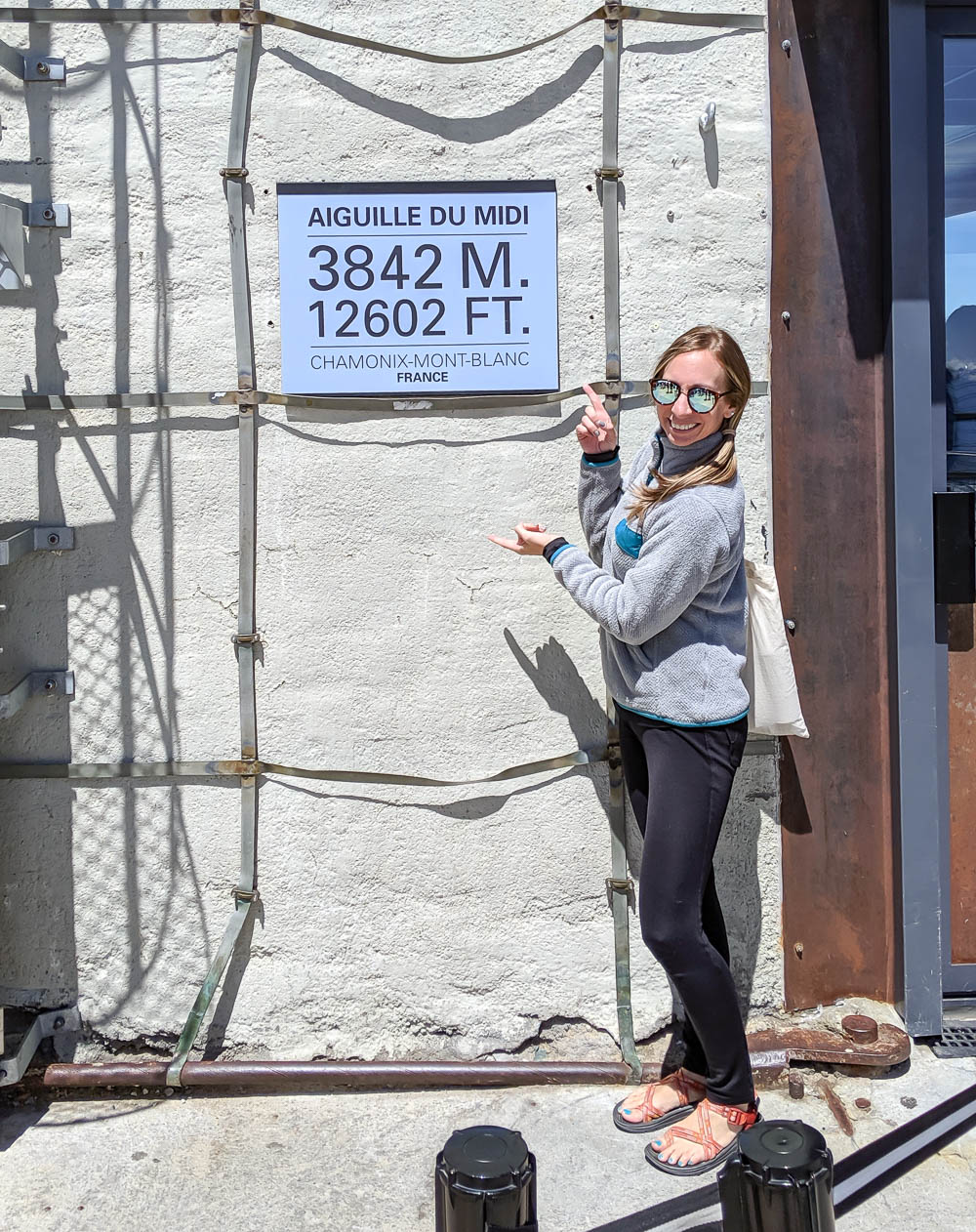
What outwear to pack for the Tour du Mont Blanc is a real toughie. There are so many variables here. On one hand, you want to be prepared for all weather. On the other, you really don’t want to have to carry around a heavy fleece if there’s going to be a surprise heat wave.
The best advice I can give is to follow the weather as closely to leaving for your trip as possible and compromise. Instead of a heavy fleece, maybe consider a light windbreaker and a packable down jacket . Or an extra light layer or two.
I brought a light down jacket and a fleece , neither of which I wore during my TMB. I also had my rain jacket which works as an excellent wind breaker, so I simply wore that on the windiest parts. My TMB experience was not the norm though.
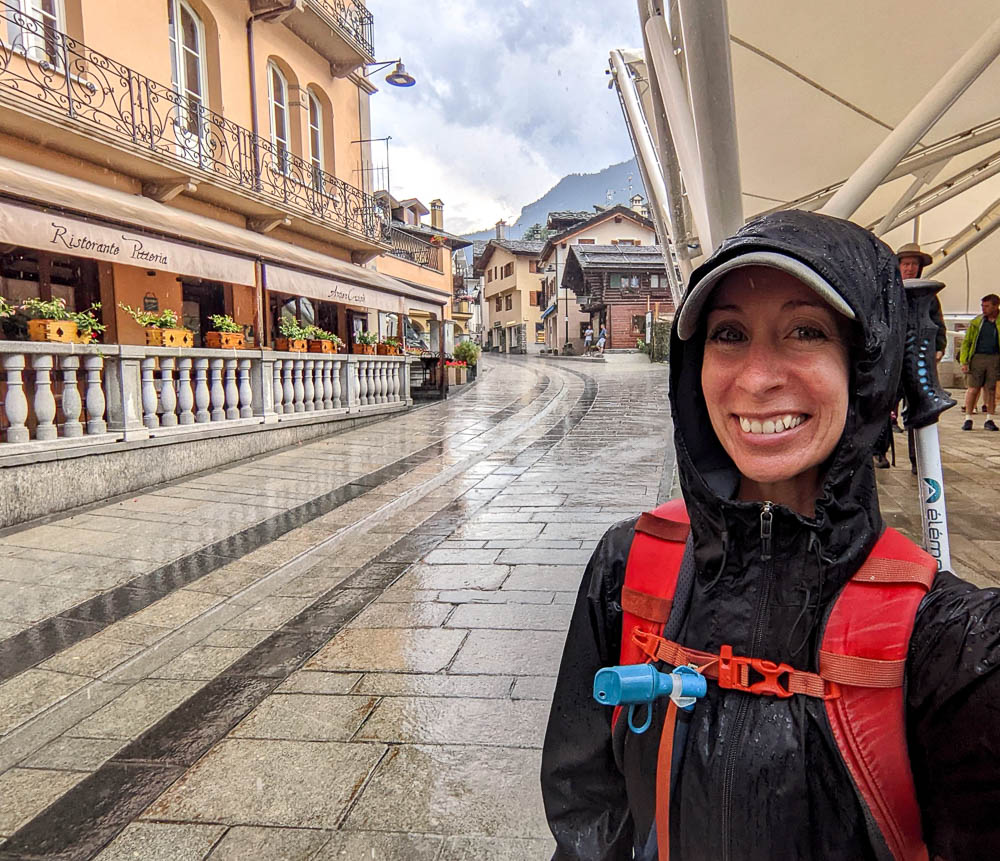
Also crucial for your Tour du Mont Blanc packing list is a lightweight rain jacket and rain pants . The majority of my hikes have been dry and sunny but friends of mine have hiked the TMB is torrential downpours. How. Horrible.
My husband and I have both the Columbia rain jacket and Columbia rain pants and wear them all the time. They are super lightweight and take up very little space. And I can pull them both on over my clothes in a hurry for those surprise showers.
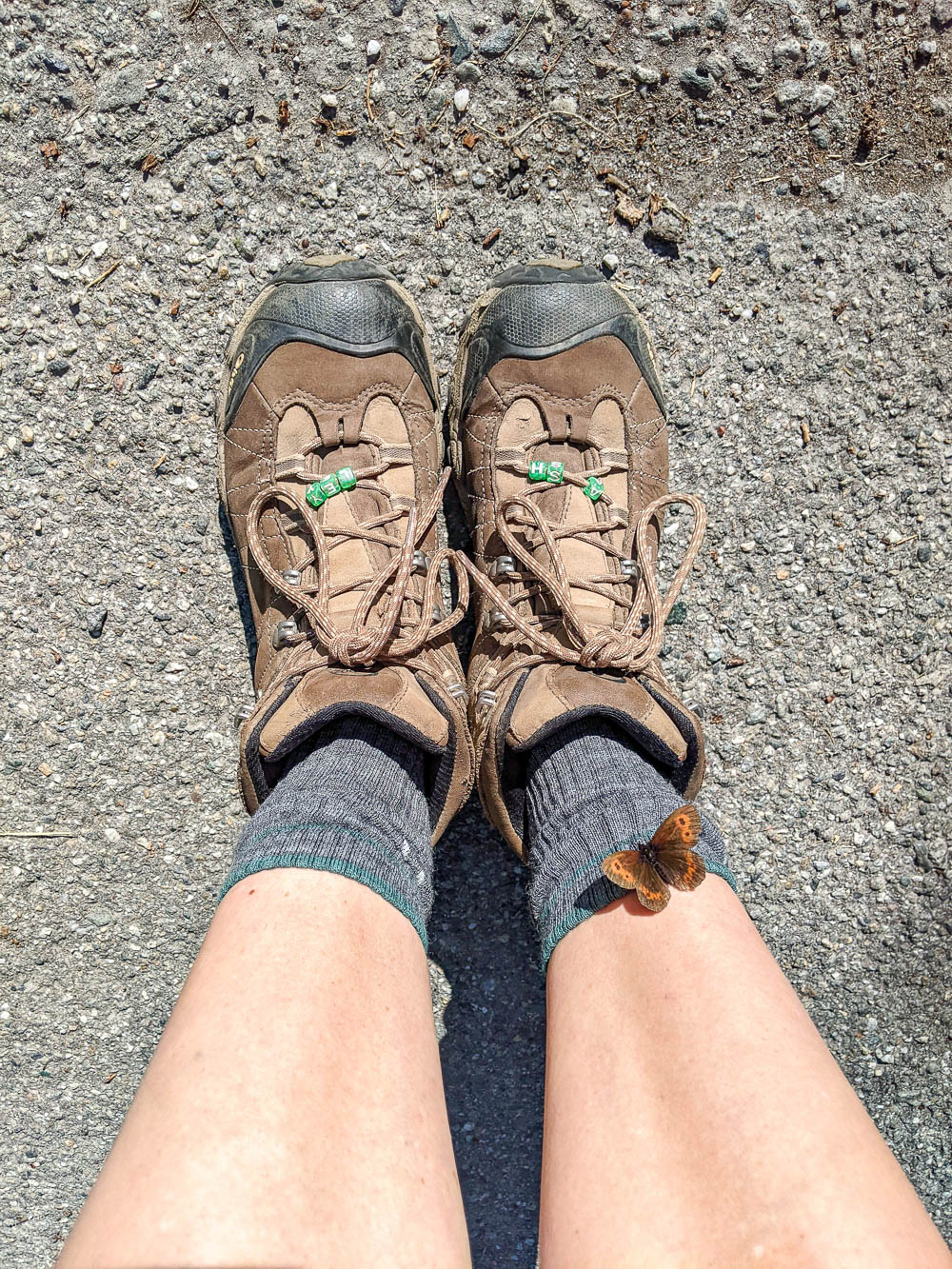
Hiking socks
Bring 3 pairs of hiking socks and do not skimp on these. Yes, they can be pricey, but WOW are they worth it. The health and happiness of your feet on the TMB is vital! Treat those puppies with respect.
Dress them in Darn Tough hiking socks and nothing less. They’re the most comfortable and most reliable hiking socks out there. They’re guaranteed for life. You won’t regret this purchase. Shop Darn Tough on Zappos , Amazon , or REI .
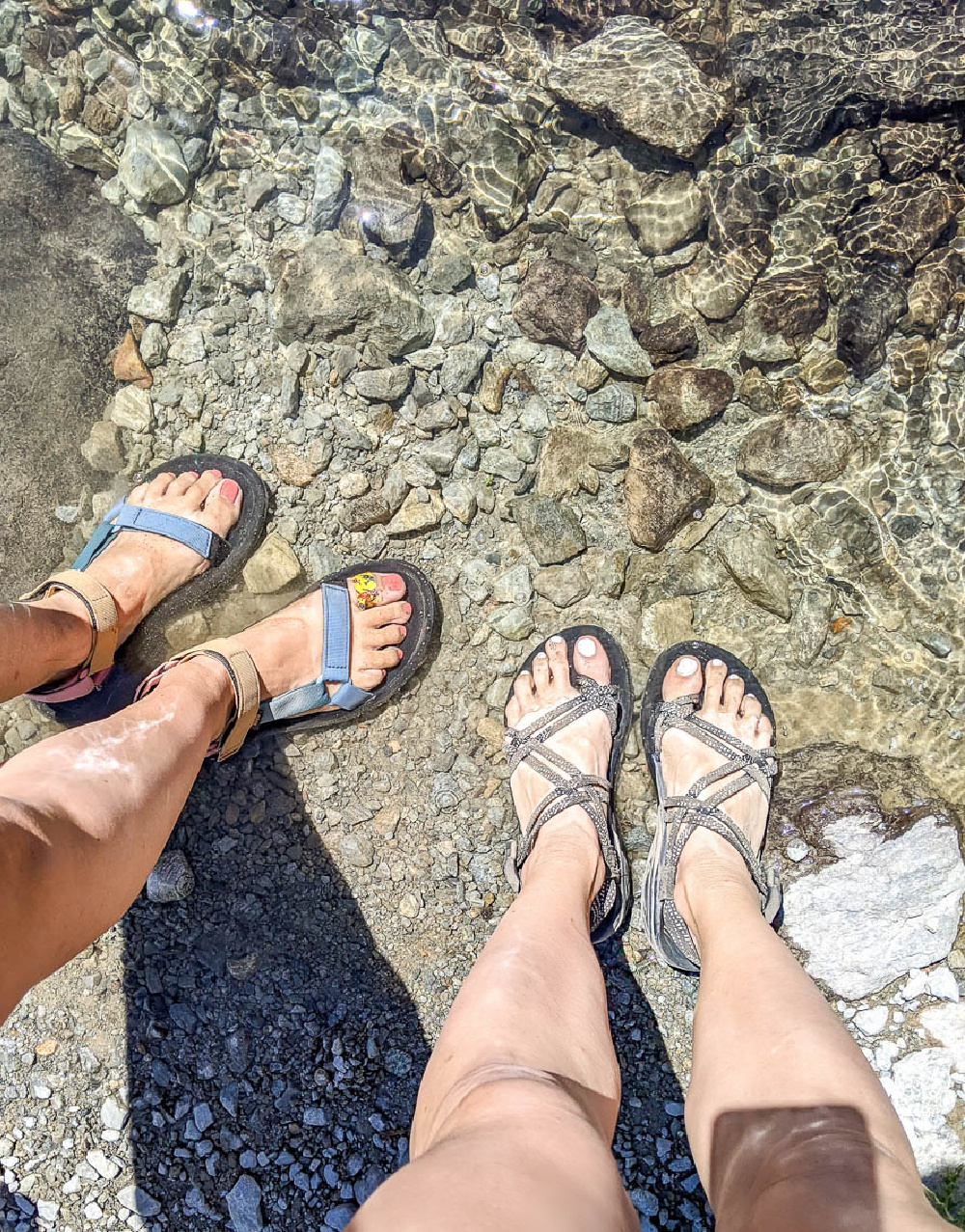
Besides your hiking boots, bring 1 other pair of shoes to wear for all of your non-hiking activities. Going to meals, hanging out at the refuges, walking through town, etc. These can be simple flip-flops, lightweight sneakers, or something in between.
Personally, I always travel with a pair of Chacos . They’re comfortable and versatile, they dry quickly, and I can even hike in them if I want to give my boots a break for a day. (Yes, they actually are “hiking sandals!”) Tevas are another hiking fan favorite.
- Shop Chacos here on Zappos or here on Amazon .
- Shop Tevas here on Zappos or here on Amazon .
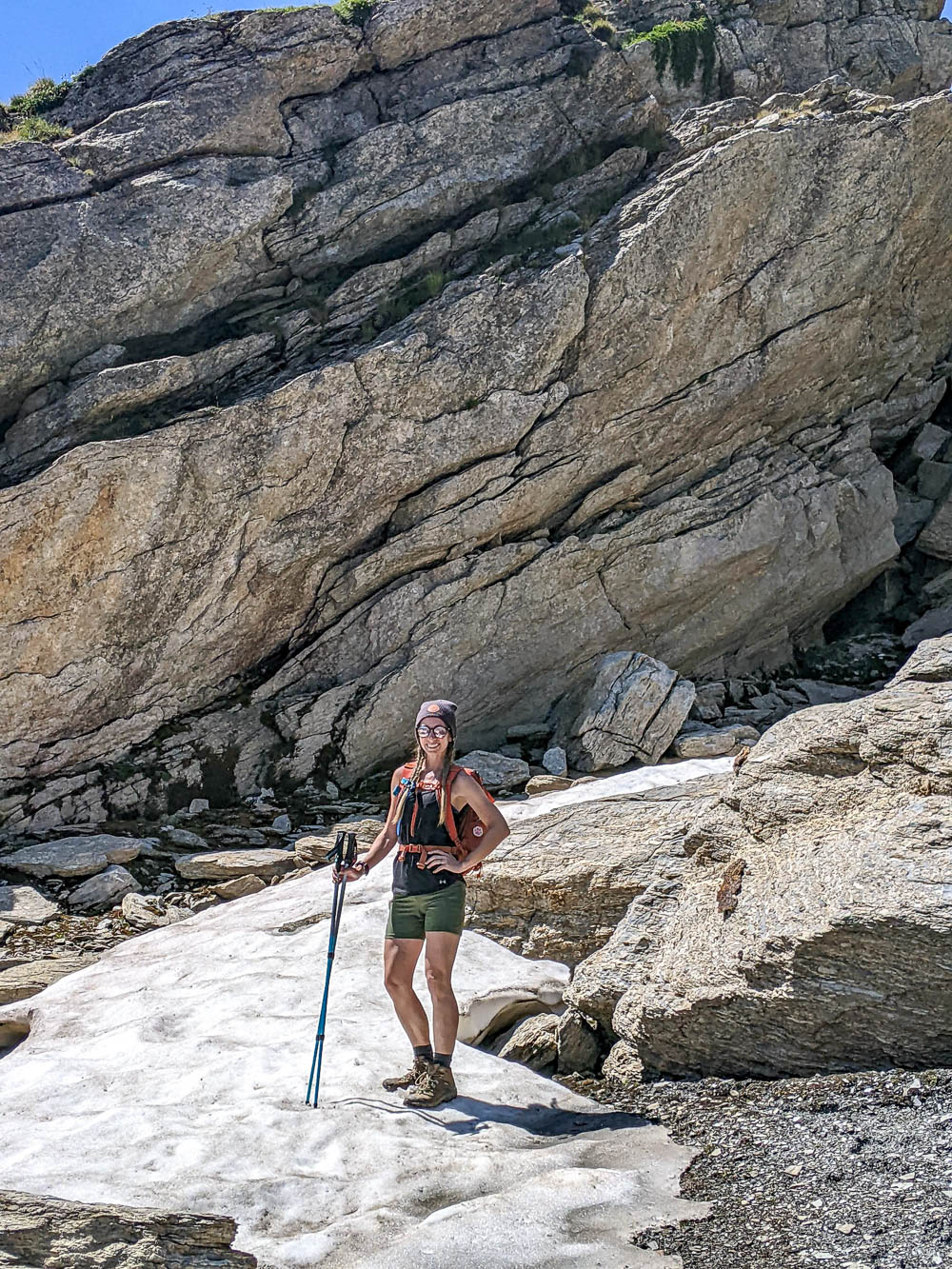
Other accessories
Also for your Tour du Mont Blanc packing list:
- Something to keep your ears warm – a beanie or headband. Even during the heat wave, there were times I wore mine because of the wind.
- Gloves – There’s nothing worse than frigid digits! I didn’t use mine but again, that’s not the norm. I’m still glad I had them. I use these thin glove liners instead of packing heavy gloves with me.
- Hat – either a baseball cap style or a sun hat is crucial. You’ll be highly elevated and exposed on the TMB and that sun is no joke. Save your skin, save your pupils, wear a hat!
- Sunglasses – an absolute must if you plan to look at anything on your hike. Always go for polarized .
- Buff – for all kinds of uses as illustrated earlier. Plus, they can also keep dirt and bugs out of your face and the sun off your neck.
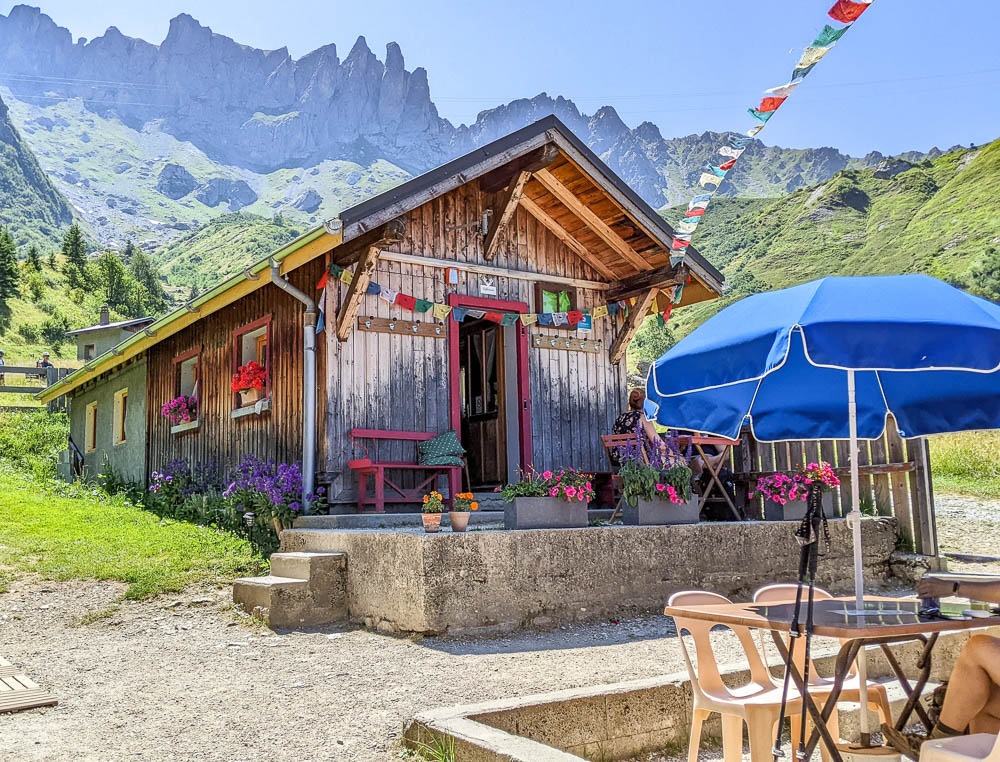
Tour du Mont Blanc packing list: Electronics
The big focus here is to keep electronics to a minimum since they tend to weigh a lot. But we’re not exactly off-the-grid kinda hikers here so there are still a few things you’ll need.
European outlet adapter
Because this is Europe, you’ll need to add an outlet adapter to your Tour du Mont Blanc packing list so you can charge your devices. Go for something small like these so save space and weight.
Hiking the Tour du Mont Blanc is going to be one of the most insanely gorgeous adventures you’ll ever take. Yes, you’ll want to document this even though the photos will never be able to these scenes justice.
Some love hiking with full camera gear because of this, and more power to them. If cameras weighed nothing, I would do the same. Instead, I used my cell phone as my camera and brought along a small point-and-shoot for when I needed a zoom lens. (But I used my cell for about 98% of the photos and video I took.)
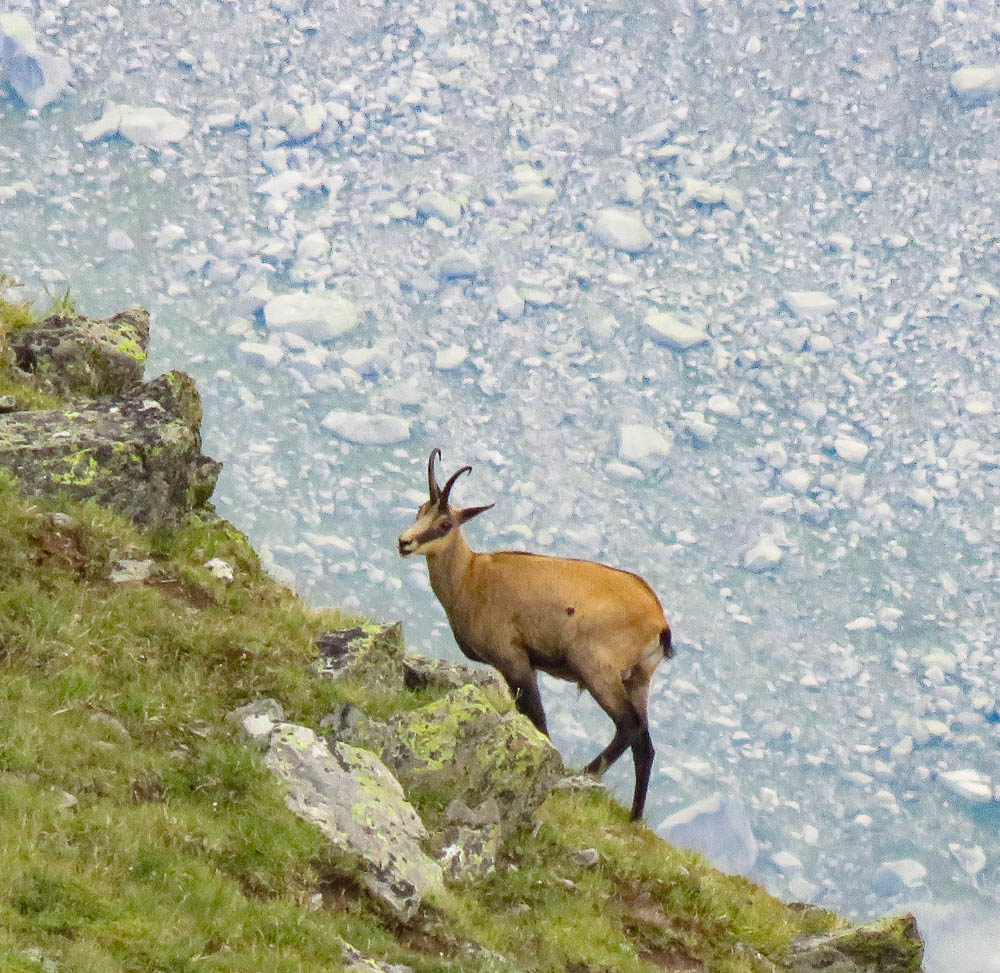
I use a Google Pixel which takes fantastic pictures. If you want to use your phone as your TMB camera, you may need to upgrade depending on how old your phone is. Just saying.
If you do opt for a classic digital camera, make sure it has a big ol’ SD card inside because you’re going to be taking a ridiculous number of photos.
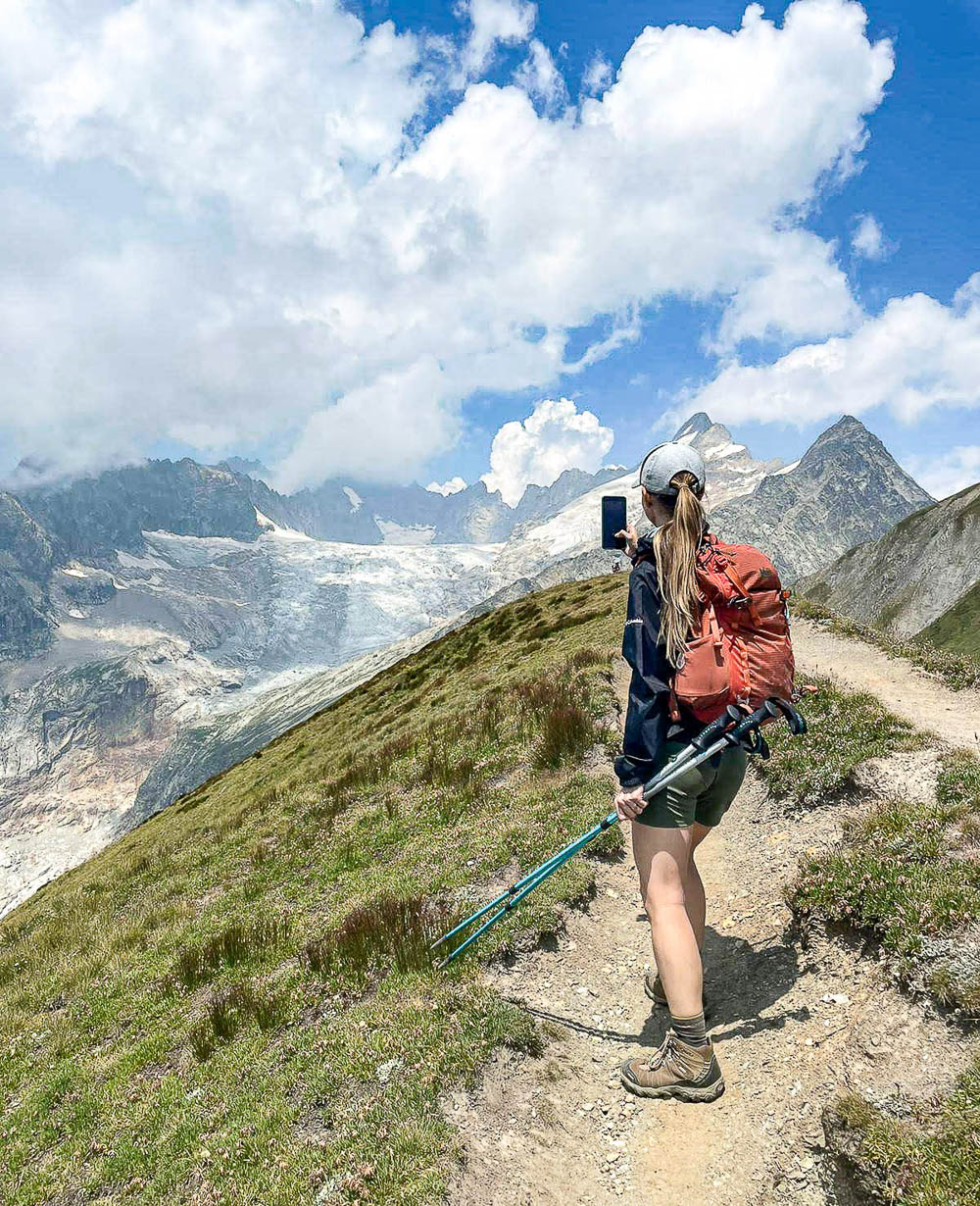
Phone and charger
And yes, you’ll want to bring along your phone and its charger. While I highly recommend leaving that thing in airplane mode until you absolutely need it, you should still always have a way to communicate, call for help, use as a flashlight, sound an alarm, and about 1,000 other things cell phones can do now.
Charge this every night or at every opportunity. Leave it in airplane mode both to save battery life and to stay the hell away from whatever is happening back in the real world that does not have any bearing on your life on the TMB. Ah, bliss.
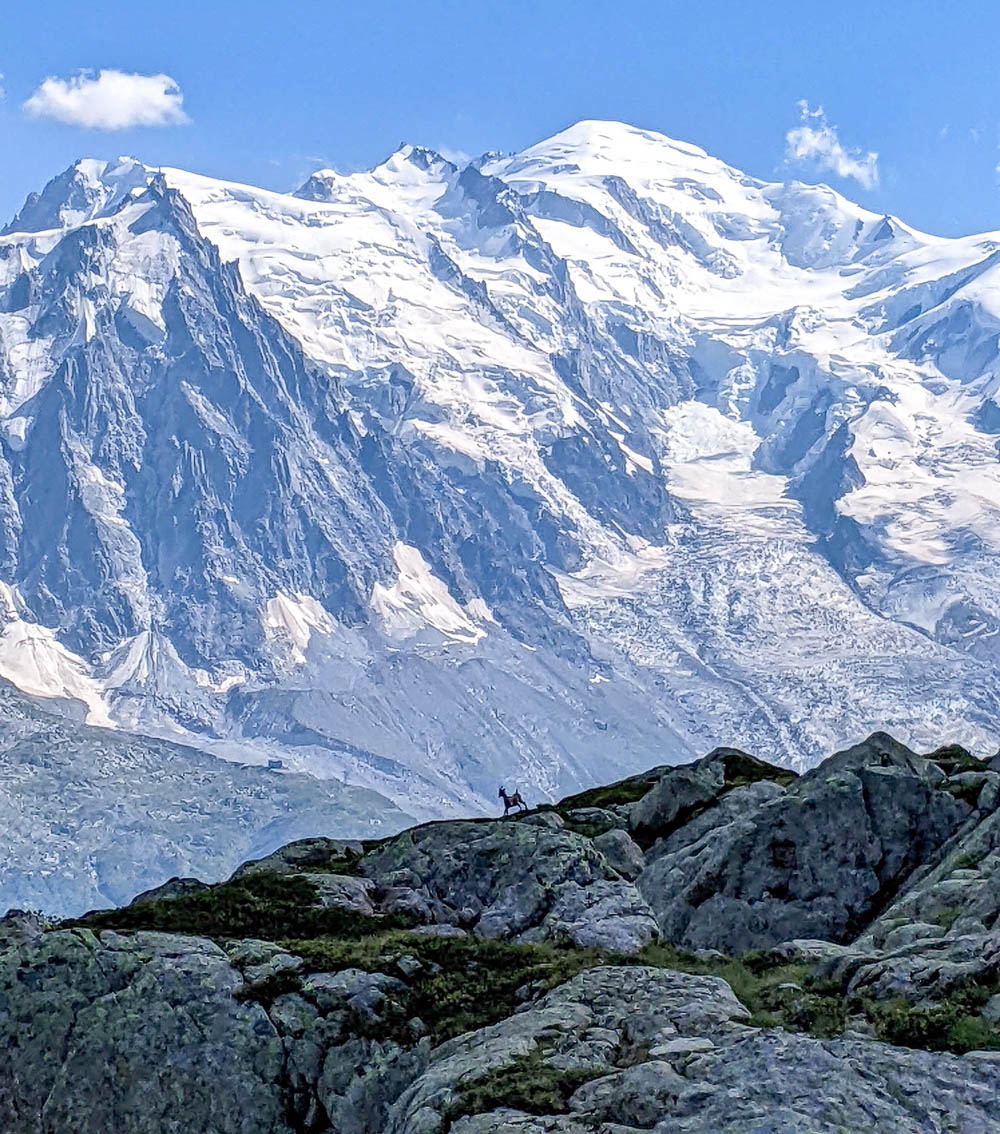
Tour du Mont Blanc packing list: Health & hygiene
This part of the Tour du Mont Blanc packing list will be highly subjective, so simply use my list as a general suggestion of what to bring on your hike.
Rehydration packets
On my hot hike in 2022 I must have sweat gallons every single day. I drank a lot of water, but I also made sure to replenish my electrolytes every day. Everyone has their favorites, but I love Liquid IV for this.
Liquid IV comes in tons of flavors (my favorites are passion fruit and açaí berry ), doesn’t weigh much, and is great for rehydrating on the trail.
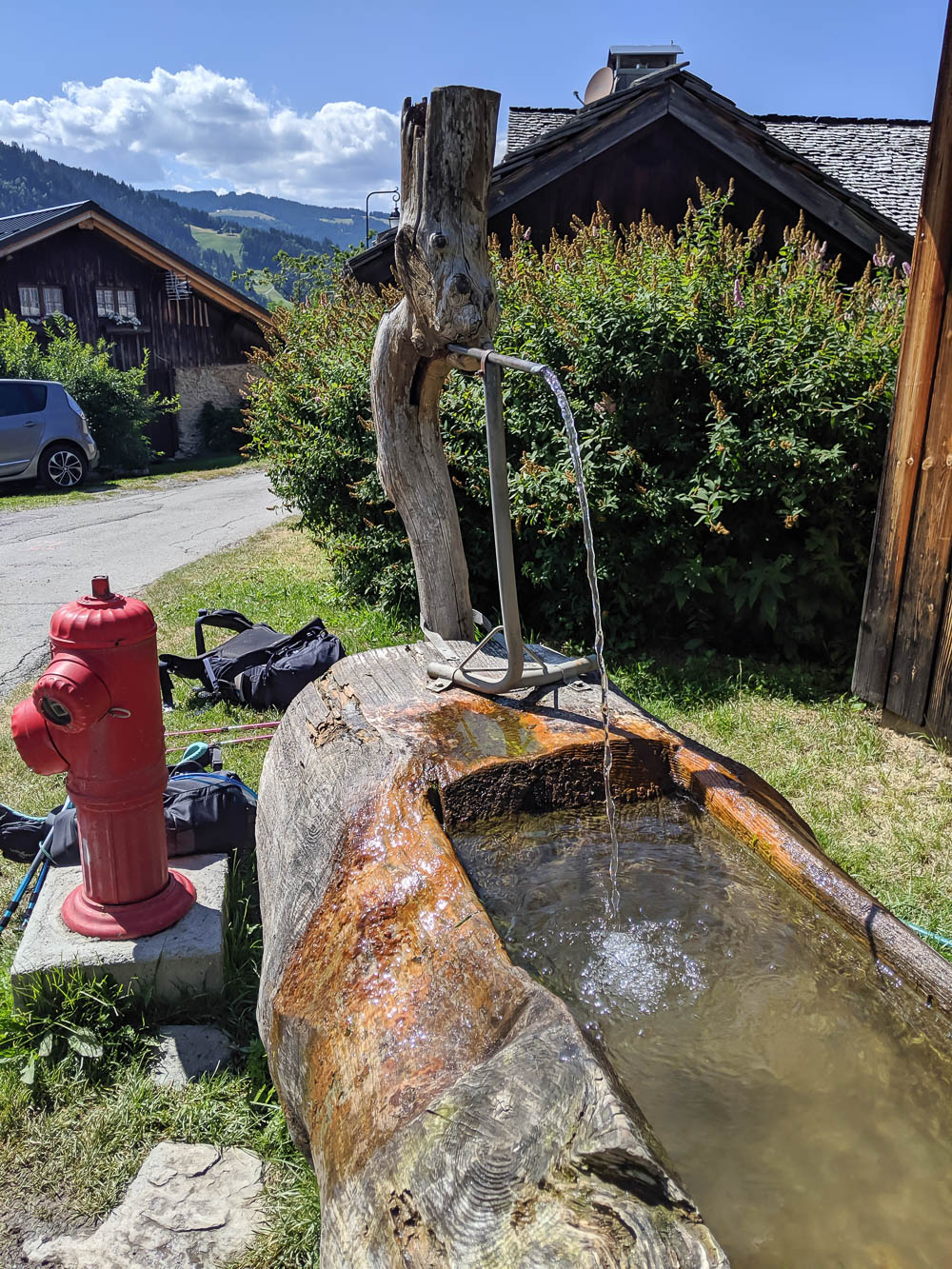
Trail snacks
Again, totally up to you what you bring for this. On the Tour du Mont Blanc you’ll have a great breakfast and dinner each night, while lunch may be up to you. It also helps to bring snacks along in case you get hungry, for some added energy, or in case it’s longer ‘til dinner than you planned.
Even though there are healthier alternatives, I usually bring along Clif Bars . I like the way they taste and they have flavors I (as someone with nut allergies) can actually eat. Other popular options are Kind bars , beef jerky, and trail mix.
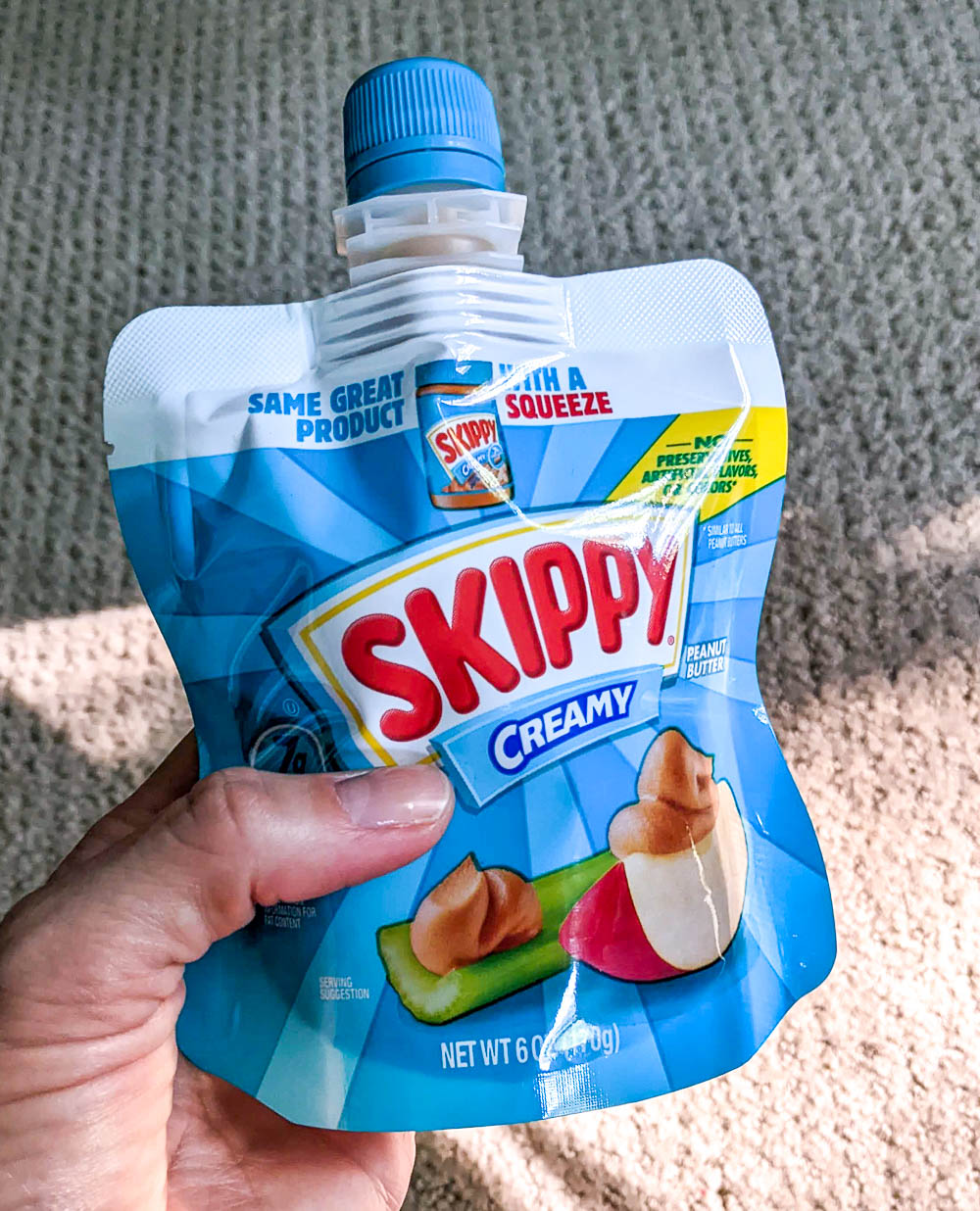
I also bring a long a small thing of peanut butter on my hikes. Lots of protein, adds flavor to simple things like bread and crackers, and tastes great. (Pro tip, get the squeezable kind if you can find it!)
Medications
Prescription medicine – Don’t forget to bring whatever prescription medicine you’re taking and only bring as much as you need plus a little extra in case of emergencies. This includes things like Epi-pens that may be so commonplace in your life that you may even forget to add them to your Tour du Mont Blanc packing list.
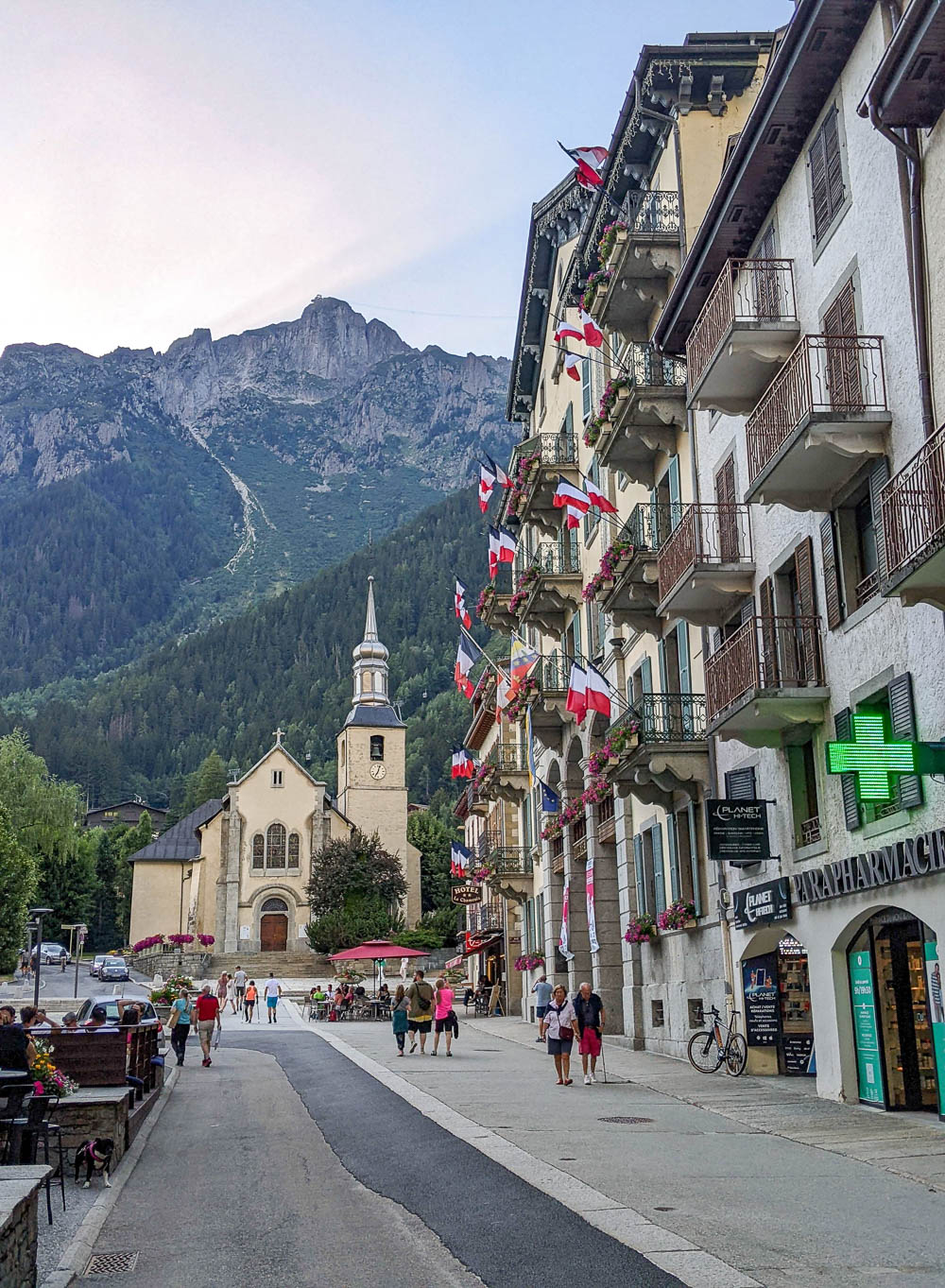
Over the counter meds – There are a few useful OTC medications worth bringing. (Note: I’m not licensed to prescribe medication, I’m just a girl who gets sick all the time while traveling making suggestions.) Things like:
- Pain relievers and headache meds
- Itch creams
- Stomach meds like Pepto (chewables, not liquid), Imodium , or Tums if you anticipate tummy troubles
- Benadryl or other if you have allergies (though the French “Zyrtec” I got in Chamonix is far superior to regular ol’ American Zyrtec!)
- Whatever else you typically use – Pepcid AC , vitamins, etc. – but do know that if you forget something you’ll probably be able to find an alternative at the pharmacies in the bigger cities on the trail.
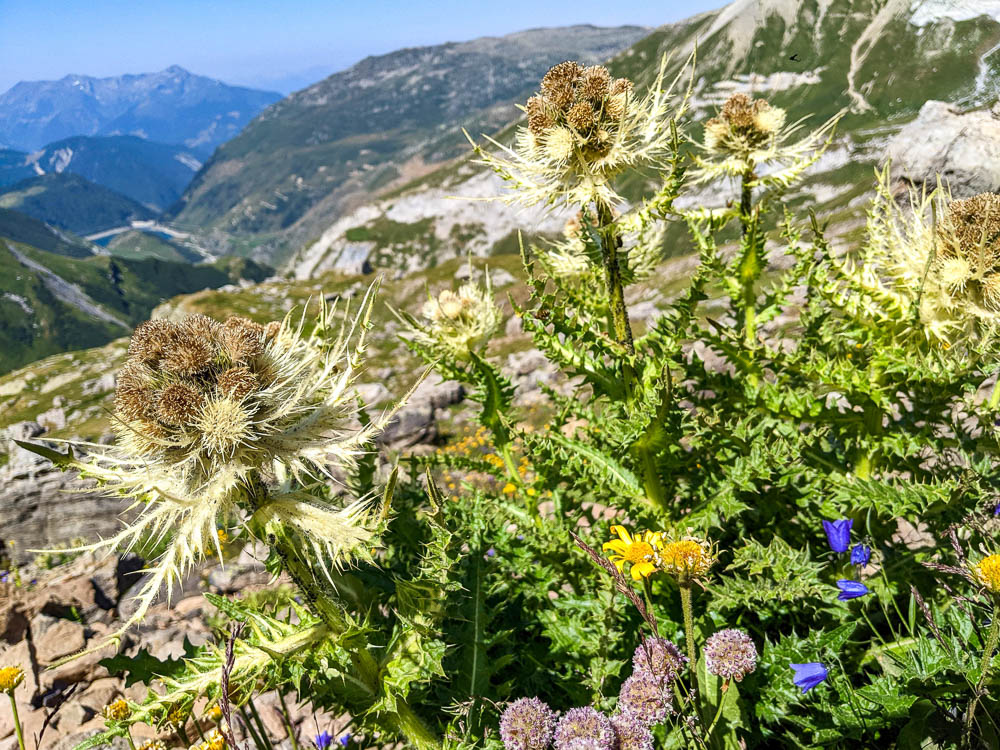
This is a big one! There’s so much dangerous sun exposure on the Tour du Mont Blanc and you’re in it for so many hours a day. Getting a sunburn could wreck the quality of your TMB experience so do your best to prevent it.
I personally brought a regular sized bottle of sunscreen from home and a small travel sized bottle too. Each day I refilled the travel sized bottle to keep in my day pack so I could reapply all the live-long day.
Also, do not forget SPF lip balm . Bring your own or pick some up in Chamonix before your hike. Either way, use it often.

Small first aid kit
You don’t need to go overboard here, but it’s always smart to have a small first aid kit on your Tour du Mont Blanc packing list. You can pick up a prepared travel version like this one, or put together one of your own. If you go this route, make sure to include:
- Bandages and an antibacterial cream like Neosporin
- Moleskin or something else for blisters
- Safety pins
- Gauze and medical tape
- Antiseptic wipes
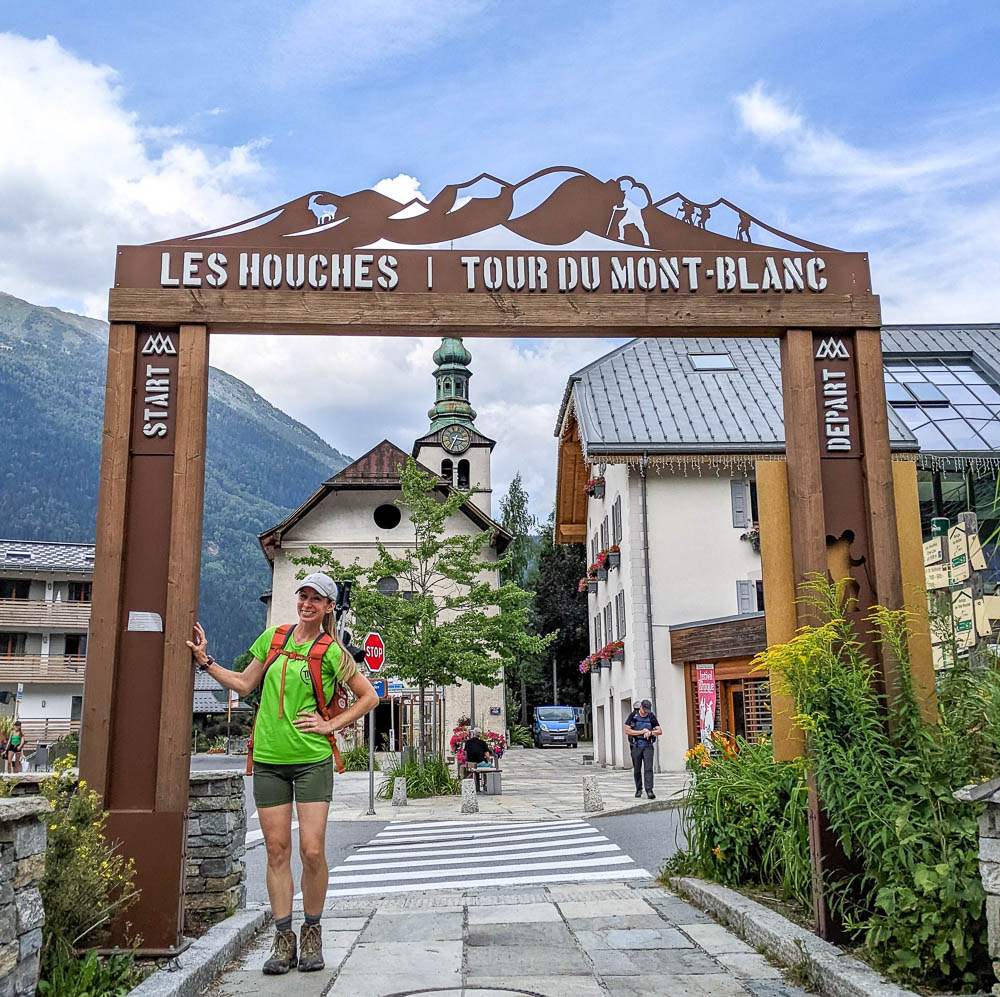
Your everyday hygiene products
This list is largely up to you, but here’s a general idea of what to pack for the Tour du Mont Blanc:
- Shampoo and conditioner
- Toothbrush, toothpaste, floss
- Small bar of soap – you can even cut a regular size bar in half
- Face wash, moisturizer, whatever else you use
- Small bottle of hand sanitizer
- Small toilet paper roll – in case you need to go in the wild or if somewhere you go doesn’t have any (not unheard of).
- Hair brush and ponytail holders (I use these super light soft ones that won’t kill your hair)
- Contact solution, extra contact lenses, case, glasses, eye drops
- Feminine products
- Disposable face masks just in case (During my TMB I still had to wear masks in some places in Italy. You’ll probably also have to wear them if you find yourself needing medical care at all.)
- Extra Ziplock bags – These can be used for all sorts of things: carrying trash, carrying food, picking stuff up, keeping things dry, etc.
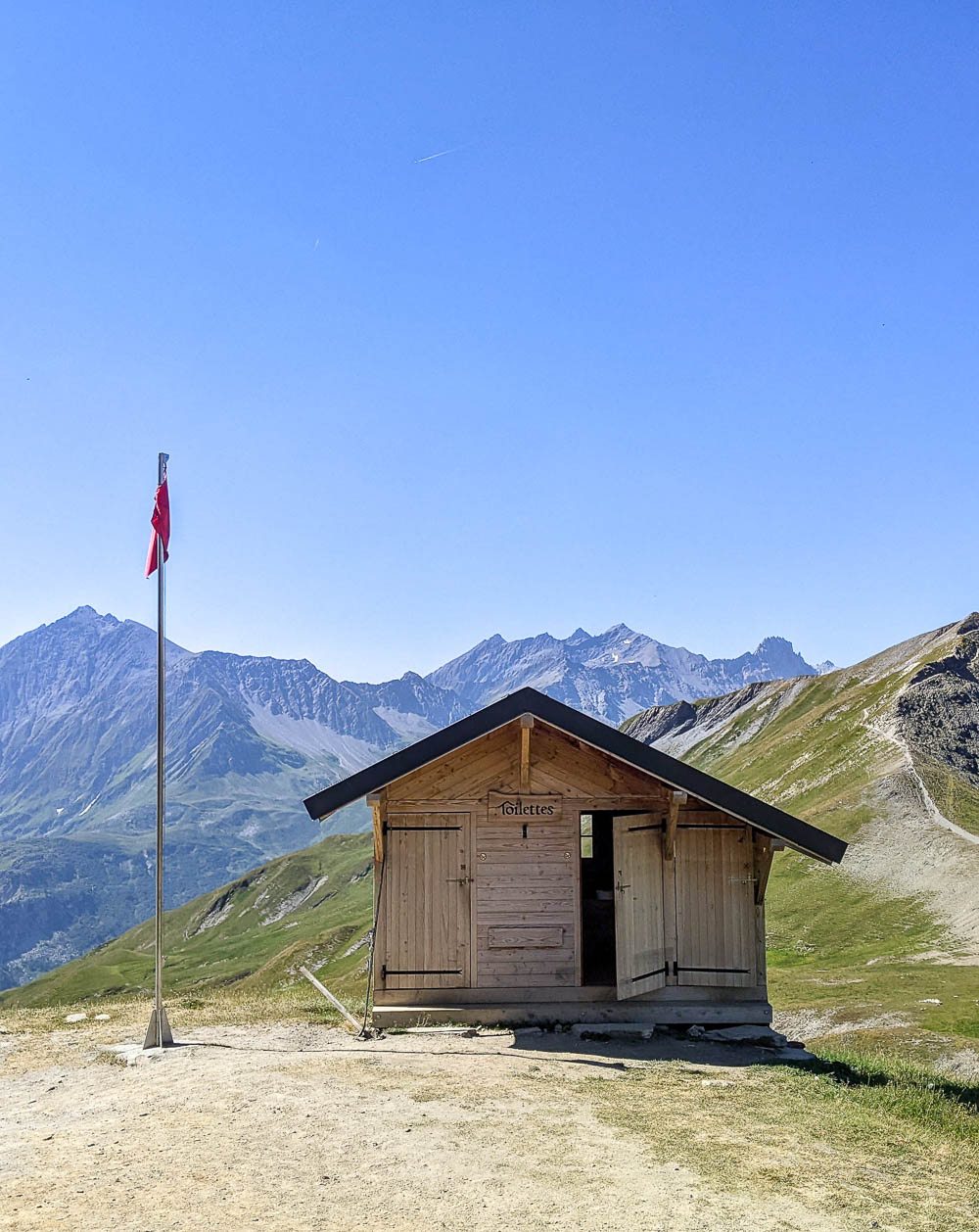
Tour du Mont Blanc packing list: Travel essentials
And we mustn’t forget the regular stuff you need for travel of all kinds, not just hiking trips. To complete your Tour du Mont Blanc packing list, do not forget:
- Your passport
- Money and credit cards
- Your CDC vaccination card – you probably won’t need it, but better to have it anyway
- Ink pen + some form of entertainment
- Ear buds for the plane/your phone
- Ear plugs for sleeping in the refuges or next to hiking partners you just met
- And some sort of small purse or fanny pack to carry your essentials in when you’re not on the trail. I love a good fanny pack for this!
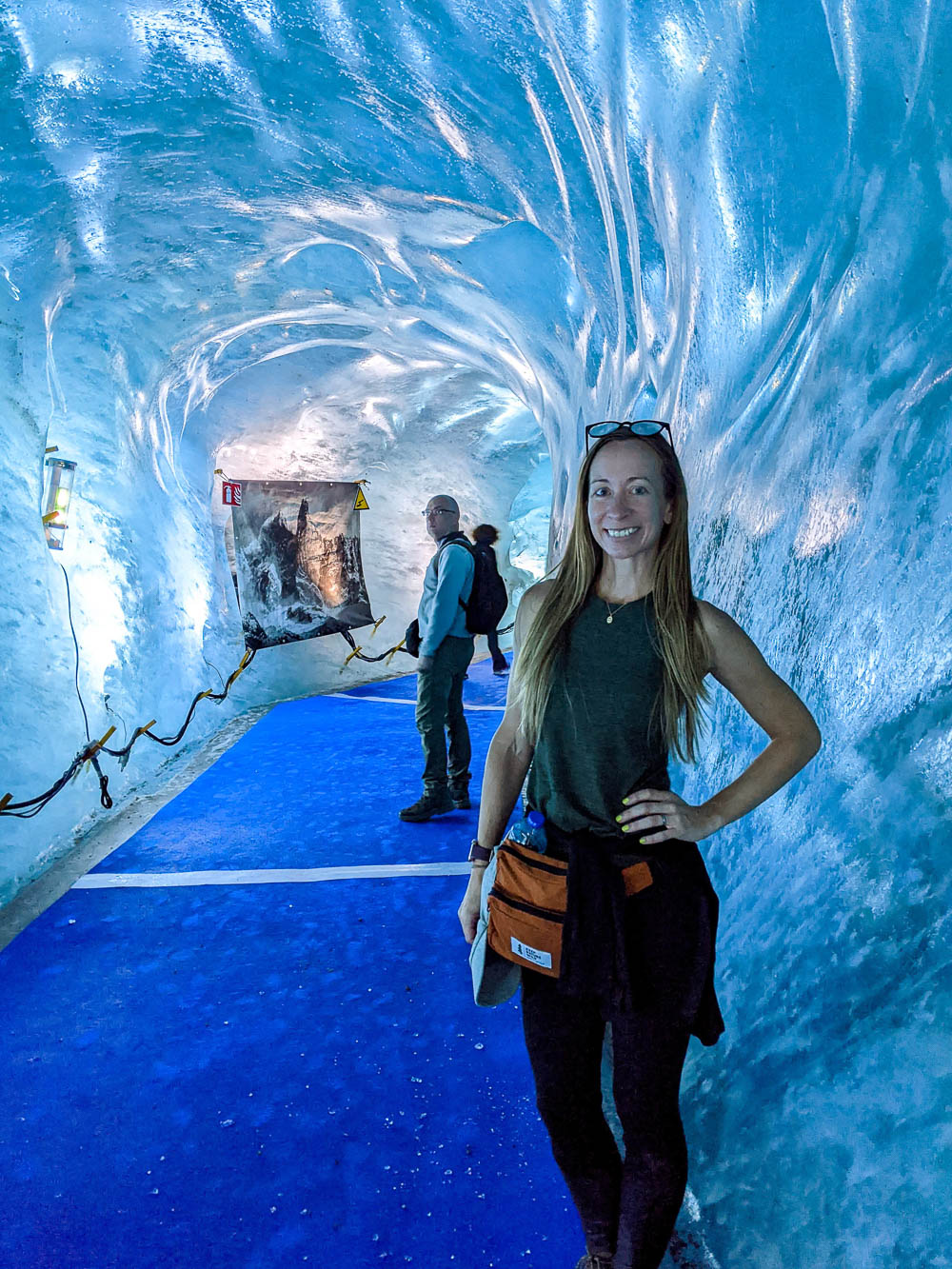
Tour du Mont Blanc packing list: optional
The following are a few things that are optional to bring if, say, you have enough room in your bag, really need them, are using luggage transfer, or just want to bring them.
If you’ll be hiking alone and still want great photos of yourself on this stunning hike, bring along a small tripod. I have this one that is used for cell phones and it’s small and super lightweight (and can be wrapped around trees and more). Something like this is another option.
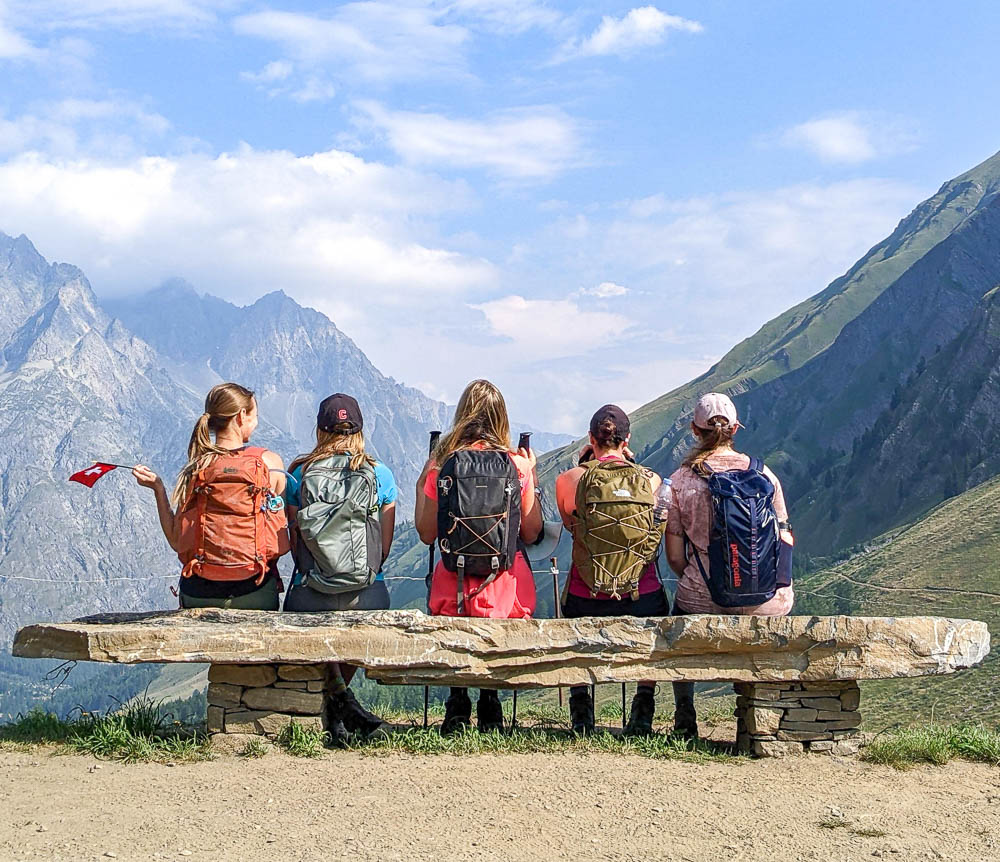
Foot massage ball
I packed this for all three of my TMB attempts but never actually used it. I guess because my Oboz hiking boots are so perfect, I never felt the need for an extra little foot luxury during my hike. If you tend to get foot fatigue, this foot massage ball is pretty light.
Again, I brought this container of Biofreeze on my TMB but never actually needed it. By some miracle* I never had any sore muscles the entire time but the girl I was sharing a room with certainly got some use out of it. Note: The roll-on and gel forms of Biofreeze only contain 4% menthol while the cream contains more than twice that at 10%. Opt for cream, duh.
*Ahem, four years of trial and error, smart packing, and lots of physical preparation.
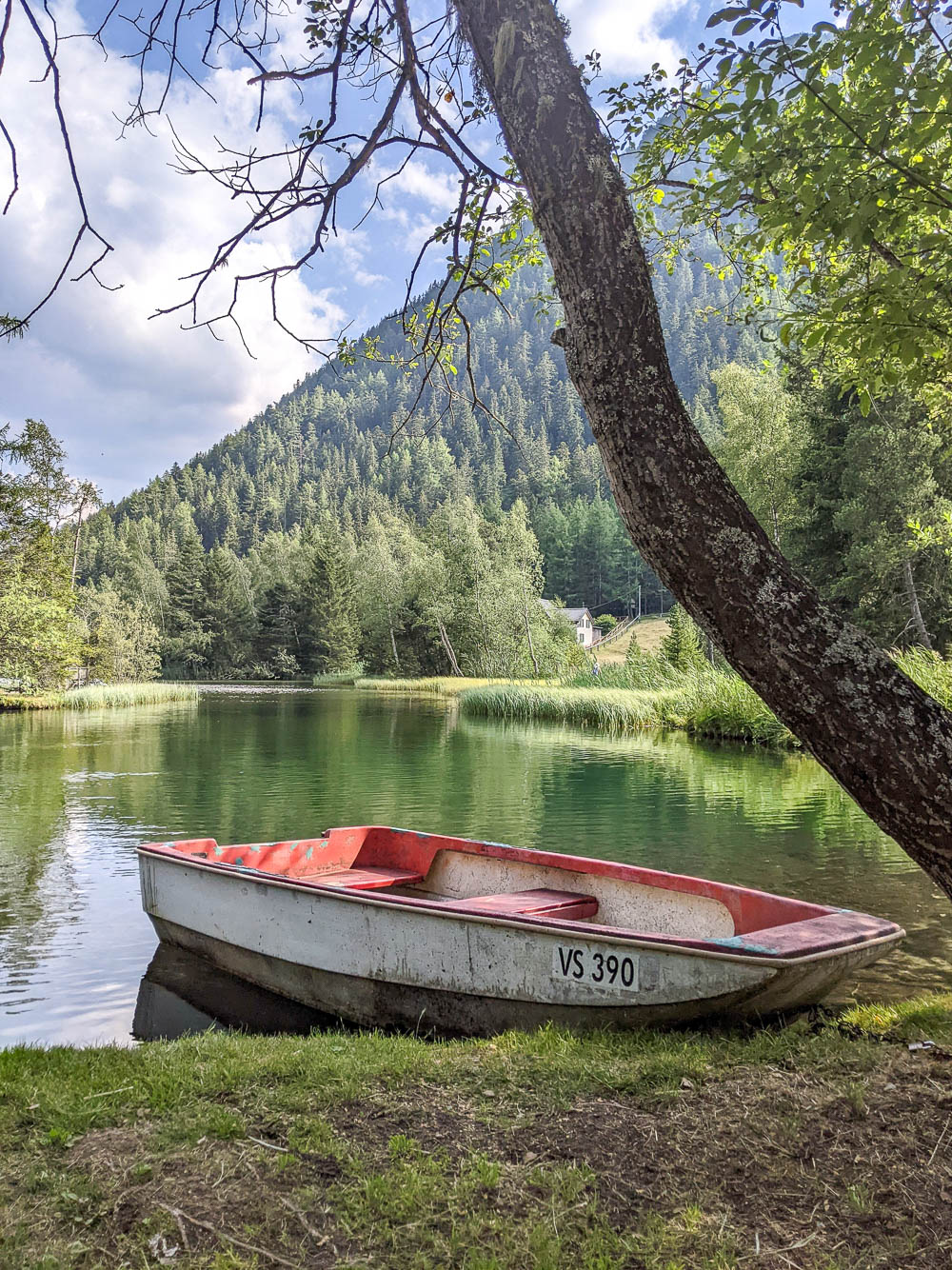
If you have knee troubles, the TMB will surely cause you some stress. These knee braces are lightweight but really help offer support.
Comfy bed socks
This one is just a small luxury that doesn’t weigh a lot and has no other purpose but coziness and comfort. Your feet are doing all the work, they deserve to be pampered. Wear these only around your room after you’ve showered.
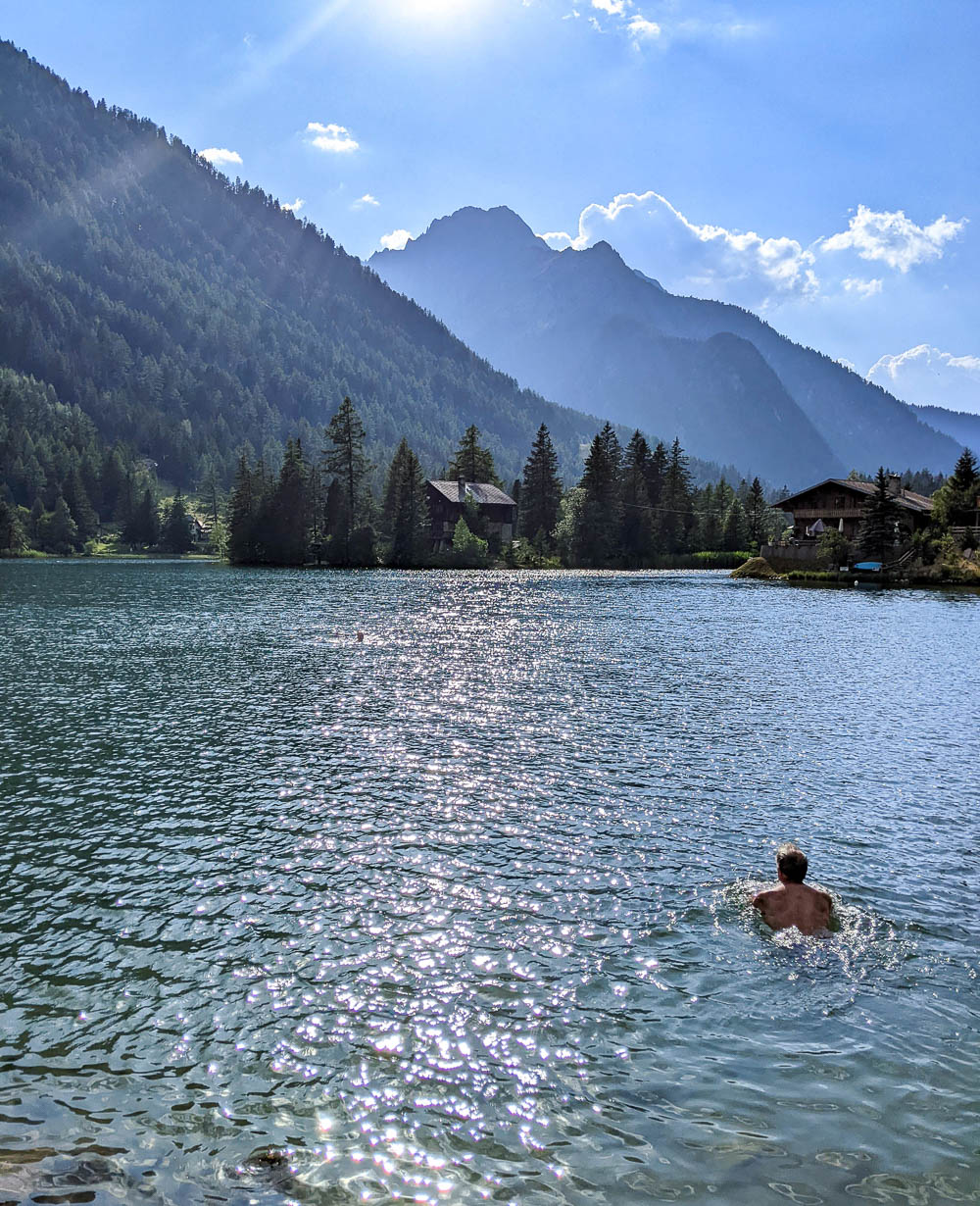
Bathing suit
There are plenty of swimming holes along the TMB (but not all bodies of water permit swimming, so please pay attention!). There are also pools, hot tubs, and spas to be found. I have a few of the suits by Cupshe and really like them.
Backpack travel cover
If you’ll be checking your hiking pack on your flight, I highly recommend getting a backpack travel cover . It bundles your hiking pack up nicely so there aren’t a ton of swinging straps and buckles that could get caught on things and break. It also accommodates locks so the contents of your pack will be safe while en route.
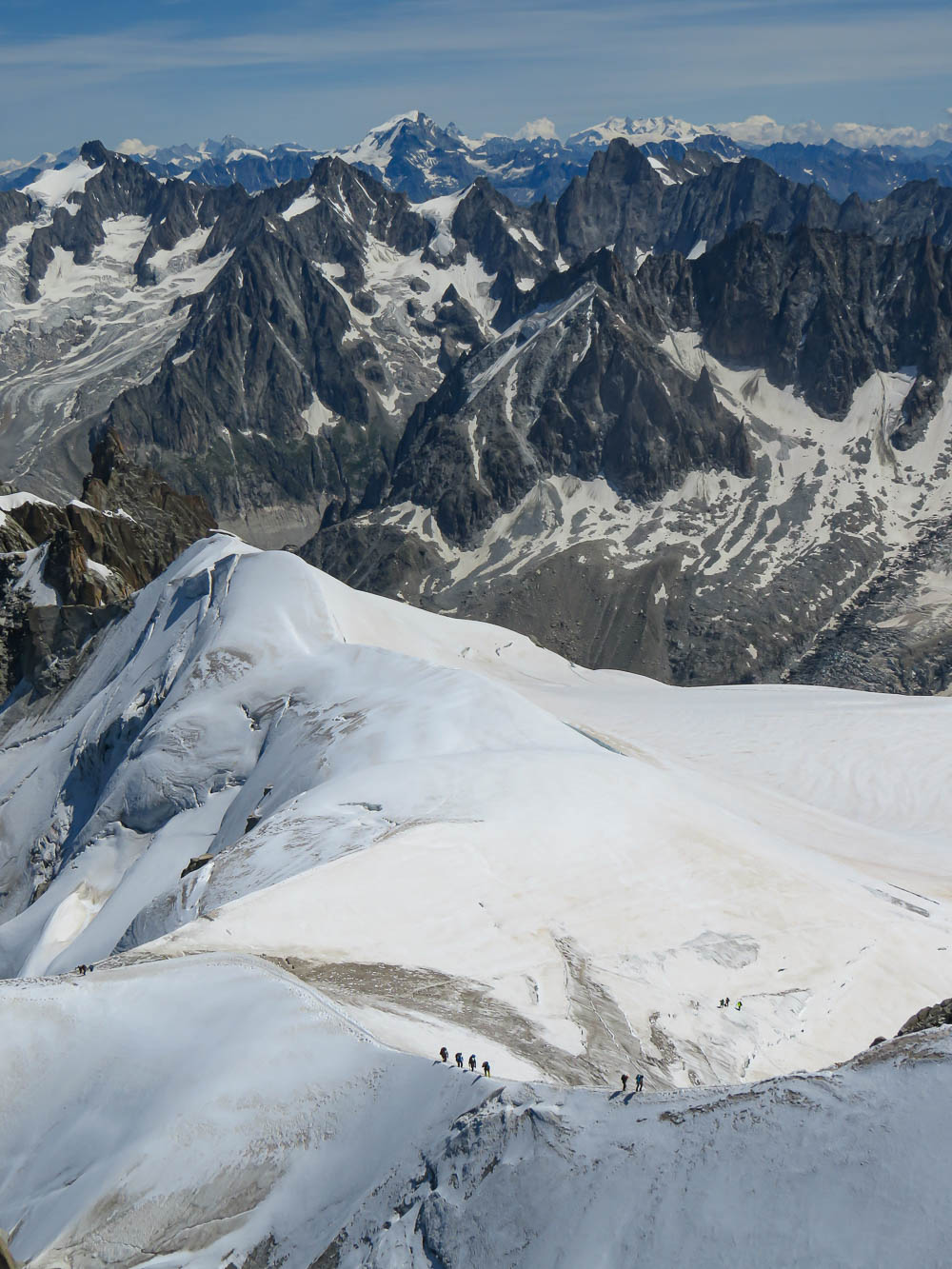
Depending on what time of year you’ll hike the TMB and the current weather conditions, you may need to consider a pair of crampons . They’re not exactly lightweight but they are crucial in snow and icy weather (and things like climbing the Aiguille du Midi ). Big time safety piece right here!
Covid tests
There’s always a small chance you’ll need to take a covid test sometime during your trip. This depends on the rules where you’re going and where you’re coming from, the situation at the moment, your risk level, and other factors. It doesn’t hurt to add some super small and lightweight covid tests to your Tour du Mont Blanc packing list if you think you’ll need them.
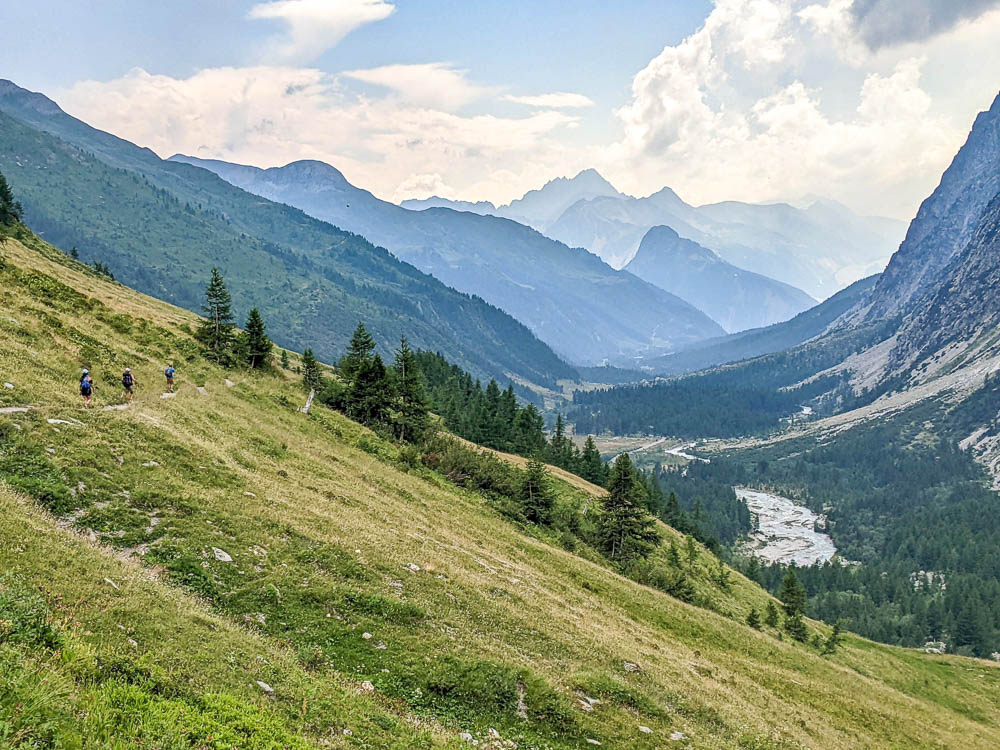
Tour du Mont Blanc packing list: What NOT to bring
Even though keeping your pack as light as possible is the ultimate goal, it’s still so easy to over pack. Lucky for you, I’ve brought along tons of stuff I didn’t need so you don’t have to. Here’s what you can leave off your Tour du Mont Blanc packing list:
This greatly depends though. If you are hiking with a guide/as a group , you won’t need a power bank . You can charge your phone every night in your accommodation. If you are hiking alone or will be camping, this is much more necessary! Otherwise, it’s way too heavy and just not needed.
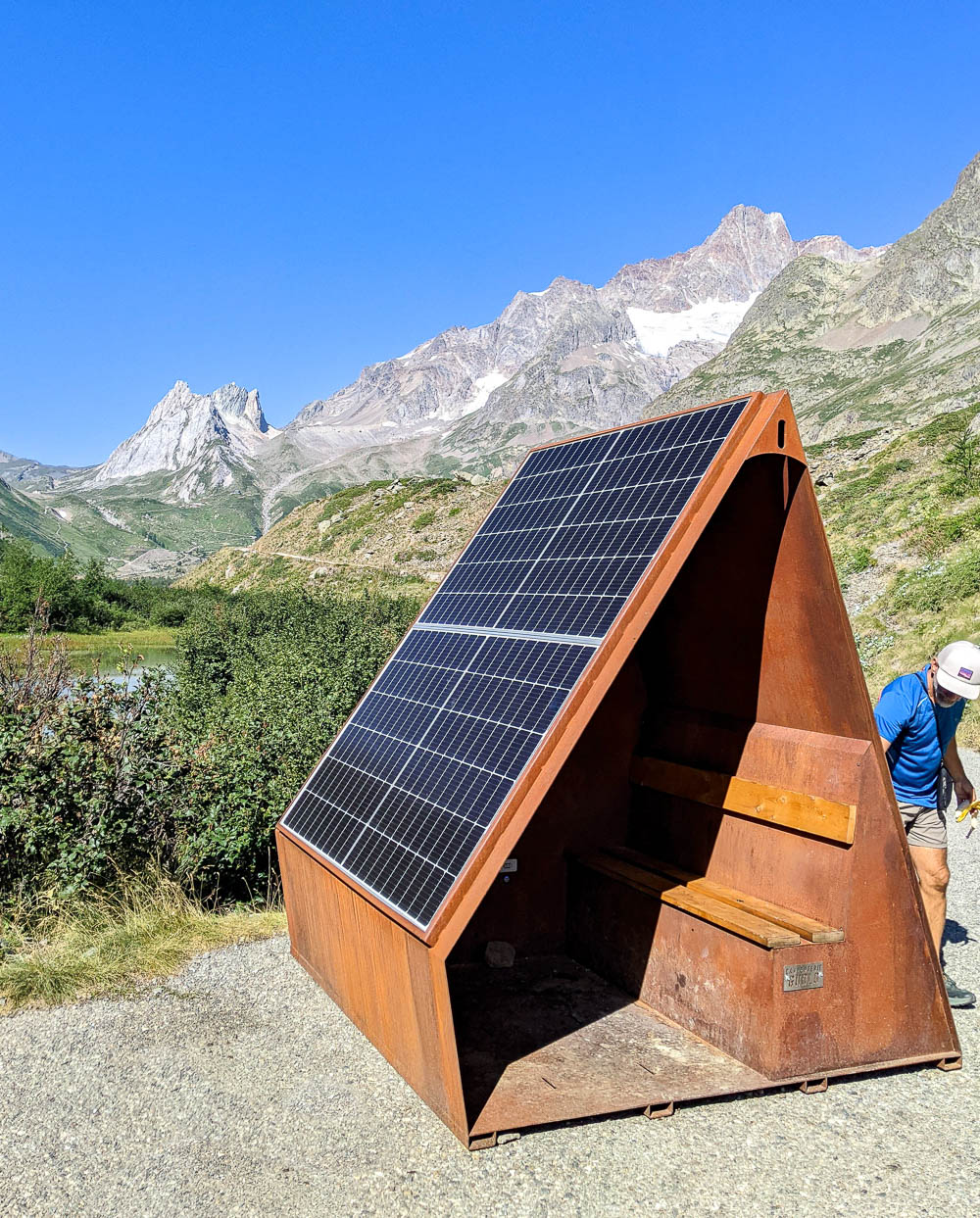
Book or Kindle
I brought a book thinking I would read it at night or while relaxing. That definitely did not happen. I never opened it. Instead, I was either talking to other hikers, people in my group, or passing out cold. Instead, pack a handful of crossword puzzles or something else lightweight to bring on the plane and avoid bringing along big books or heavy electronics.
Bug repellent
Plain and simple, you will not need bug repellent on the TMB. There was only one day when there were a bunch of annoying gnats on the trail, but nothing that was biting or stinging. Otherwise, I have never encountered a single mosquito or really anything else at all.
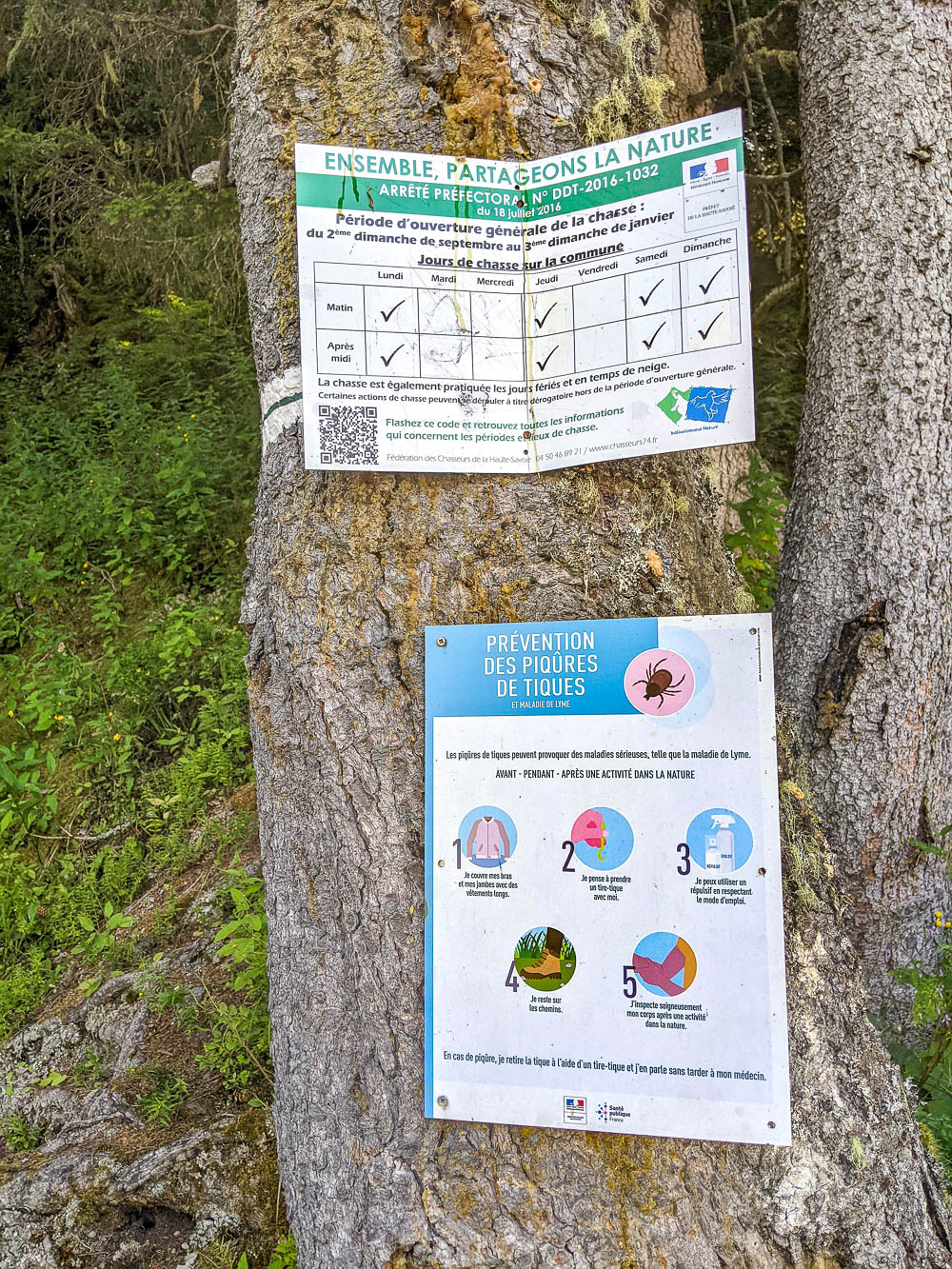
Unless you’ll be hiking alone or camping, you really don’t need a headlamp. We have flashlights on our cell phones for when you need to see around the refuge at night. Only bring a headlamp if you think you’ll be out in the darkness for a good amount of time. With a guide or hiking group, you’ll arrive to your accommodation with plenty of sunlight left.
Binoculars are great for wildlife spotting, but they’re heavy and bulky. My point-and-shoot camera has a 50x zoom lens which is actually more than my binoculars. So whenever I wanted to see animals far away, I just used my camera. This is another example of avoiding packing redundancy.
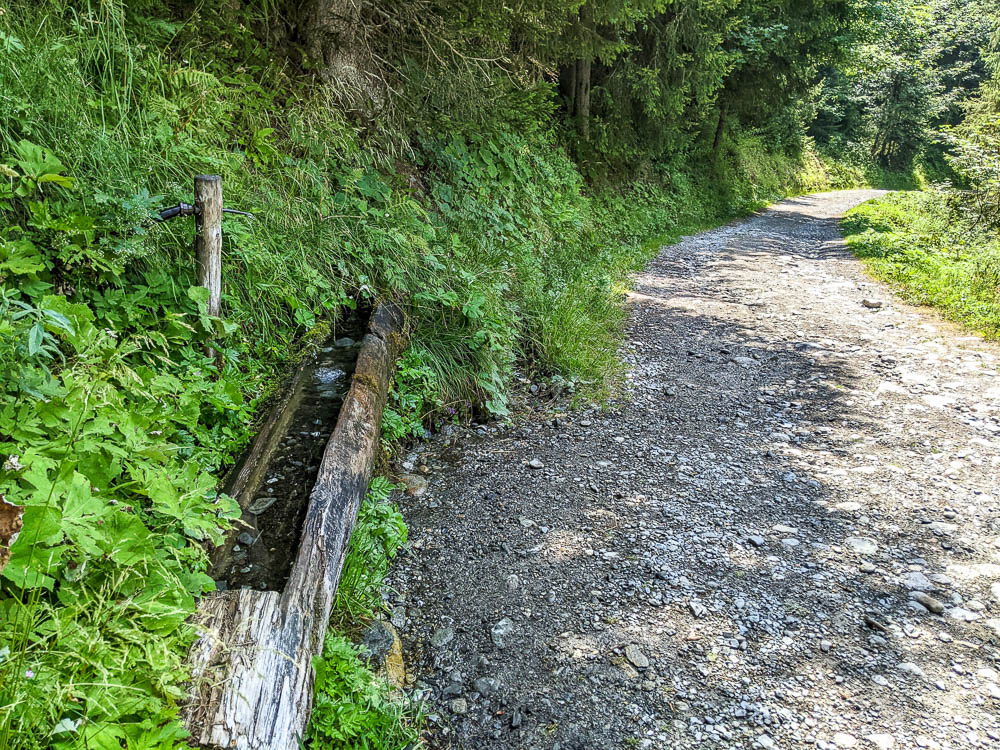
Water filter
There is so much fresh, clean, and cold water available along the Tour du Mont Blanc. This goes for refuges, towns, and random water sources along the trail. There should (hopefully) never be a time when you’ll need to drink out of streams or anything.
Sock liners
Even though I have them and brought them and wore them, I’m still not really sure the point of sock liners . I think they’re supposed to help with blisters? If this is something that affects you, perhaps you will want to look into this. Otherwise, my sock liners were just something annoying I had to deal with unnecessarily.
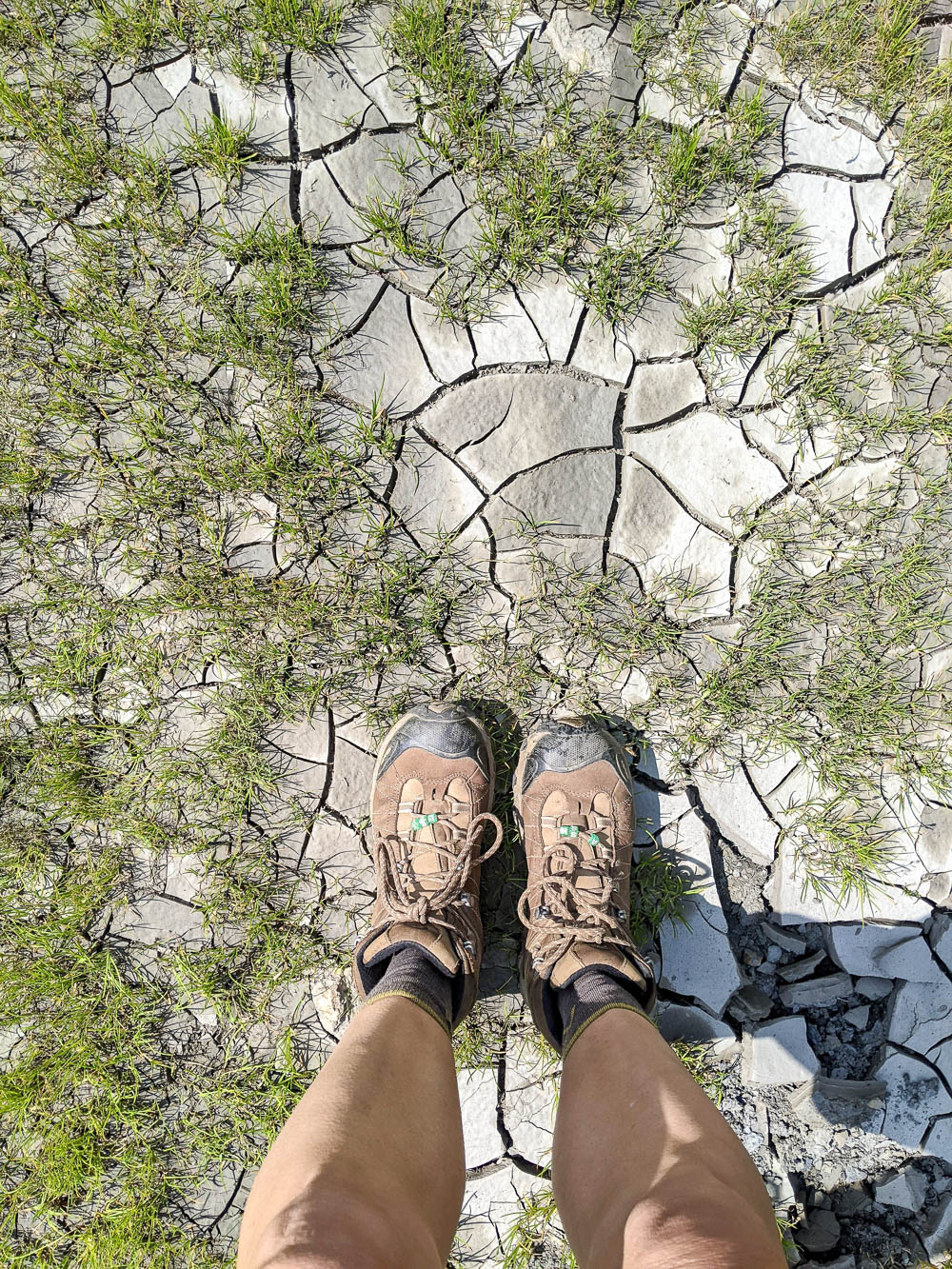
Tour du Mont Blanc packing list: Adjustments
What you have in this list is what I brought, as someone who hiked with a guided group and utilized luggage transfer. If you are not hiking this way, you’ll want to pack a little differently. For instance…
If you are not using bag transfer:
- Bring just a simple pair of flip flops as your backup shoe
- Bring fewer clothes (but you’ll have to make sure you wash them every night )
- Leave optional items behind. You’ll have to get creative—use a rock as a camera stand, etc.
- Make photocopies of only the guidebook pages you’ll need to save space and weight
- Consider consolidating your hygiene products or book hotels instead of refuges that might offer things like shampoo, soap, etc.
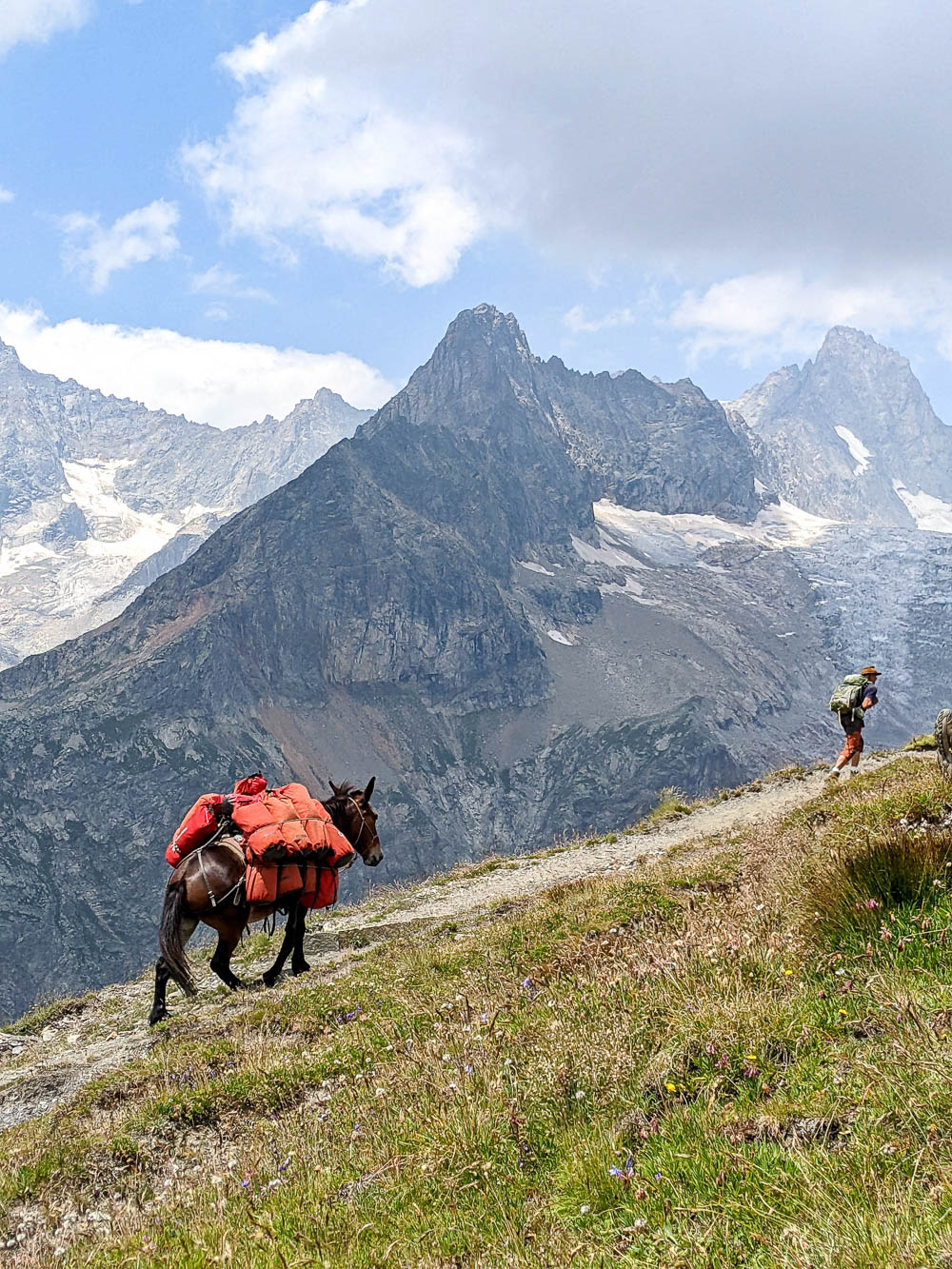
If you’re not hiking with a guide , you’ll also need to pack:
- The proper to-scale TMB maps
- Perhaps a GPS if you’re anything like me
- A compass and the knowledge of how to use it and where you’re going
- Well thought-out contingency plans
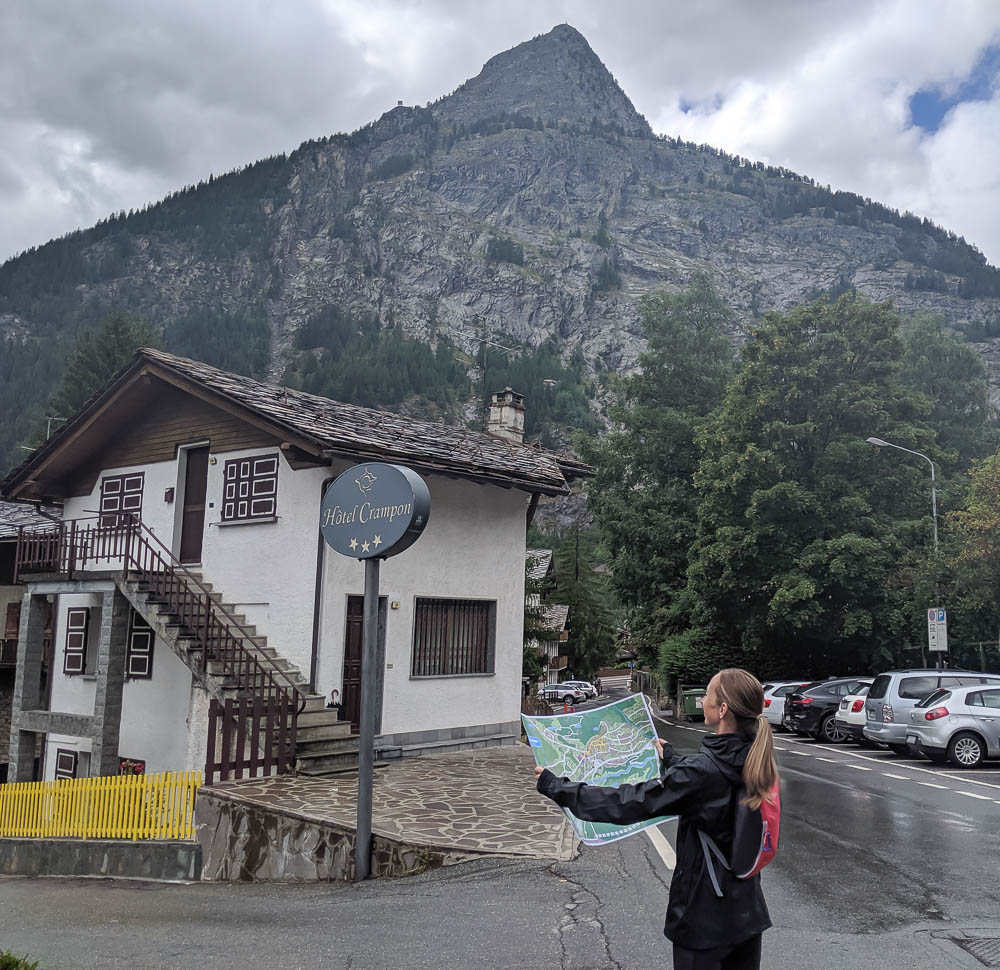
If you’re hiking with a friend or group of friends , you can share the load. For instance, between all of you you’ll only need one of each:
- First aid kit
- Toilet paper roll
- Full size bottle of sunscreen
- Outlet adapter
- Phone charger
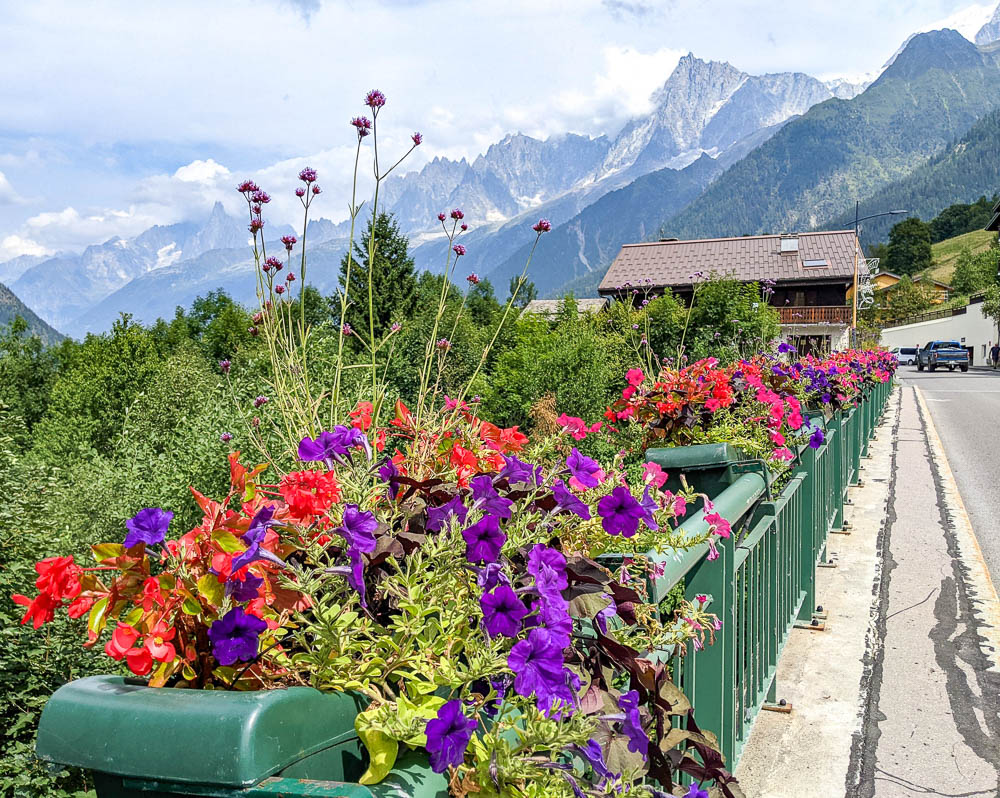
I know this seems like a lot, but figuring out your Tour du Mont Blanc packing list is one of the most important aspects of this incredible adventure. Best of luck! Have questions? Ask in the comments below and potentially help other future hikers as well!
Save this info, pin this image:
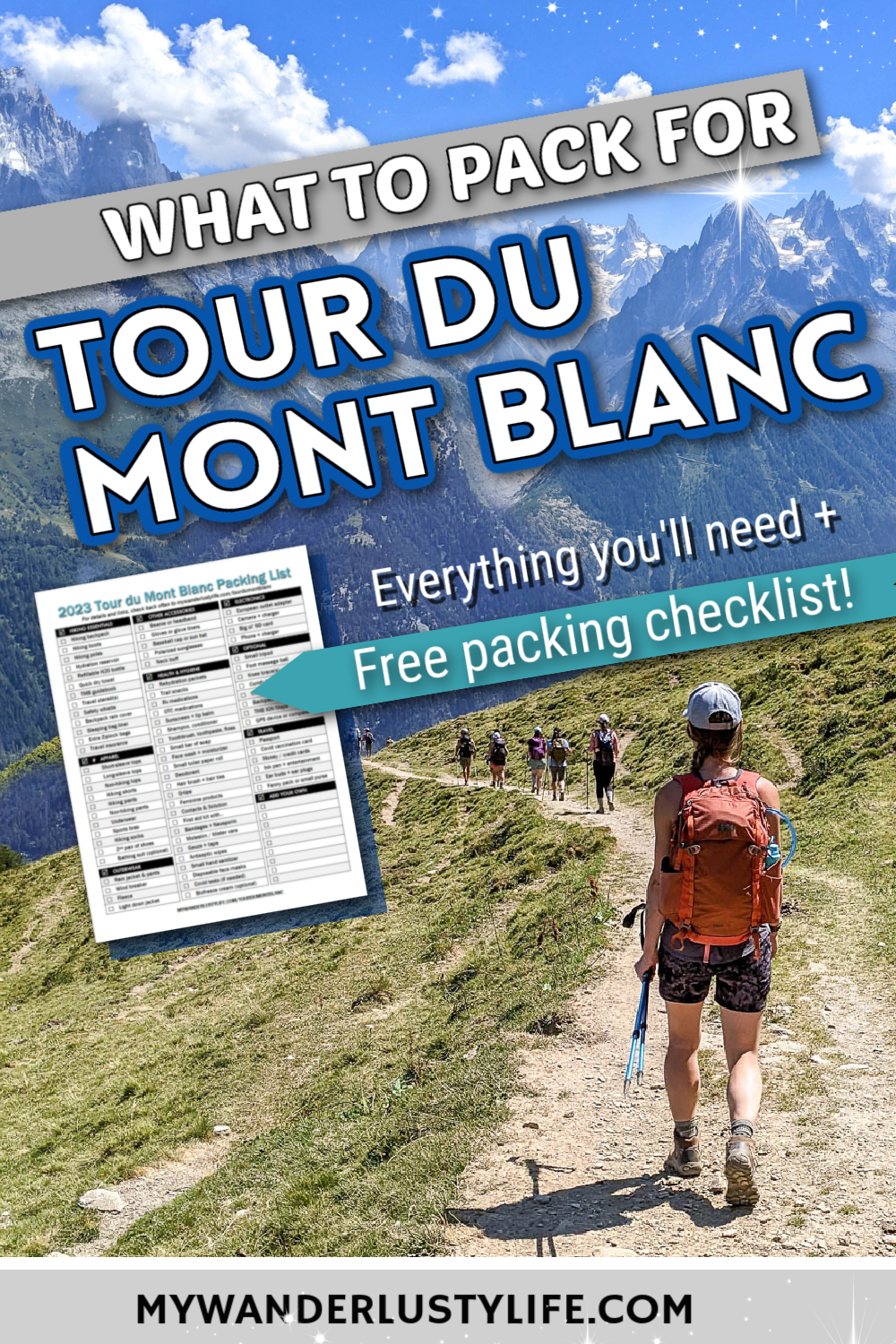
About Ashley Smith
Ashley is a historian and Oktoberfest expert & tour guide. She has traveled to 39 countries and specializes in quick trips throughout Europe and the Americas that prioritize hiking adventures, museums of all kinds, cultural experiences, and jam-packed itineraries. She hails from Memphis, TN and currently lives in Boston with her husband and two feline sidekicks.

Reader Interactions
June 19, 2024 at 2:40 PM
This was awesome and you are awesome! Thank you for sharing. I’m heading out in three weeks 😮
June 20, 2024 at 7:31 AM
Thanks, Beth! Have a great trip!
April 7, 2024 at 11:05 PM
Thank you for this! My family and I are just starting the planning for a trip in summer 2026, and this was SO helpful. I will be coming back to your page a ton during our planning process!
April 8, 2024 at 7:46 AM
Thank you, Jane! You’re going to love the TMB!
October 27, 2023 at 11:09 AM
Girl! I love your article and your list. I am embarrassed to say that it popped up after I searched “should I bring a hairdryer on the TMB?” Hahaha! More often than not I do not even use one at home. Has nothing to do with how my hair looks. But I just cannot sleep with wet hair, nor do I like going out with wet hair when it is cold outside. I am doing TMB in July 2024 with my teen son. I can’t wait!! Such a helpful article. Thank you!
October 30, 2023 at 8:16 AM
Haha! That’s hilarious Marti. Well I hope you’ve decided on your hair dryer question – you’re going to love the TMB!
September 2, 2023 at 11:31 AM
Fantastic article! I leave in 6 days!
September 2, 2023 at 1:54 PM
Thanks, Chris! Have a great time on the TMB!
Leave a Reply Cancel reply
Your email address will not be published. Required fields are marked *
Subscribe to MWL

Get my 2024 Oktoberfest Party Planning Checklist here!
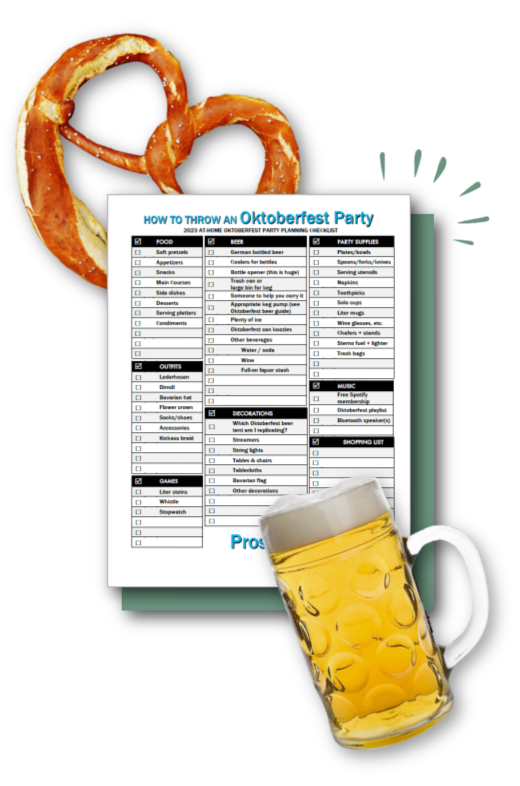
Free 2024 Oktoberfest Packing Checklist
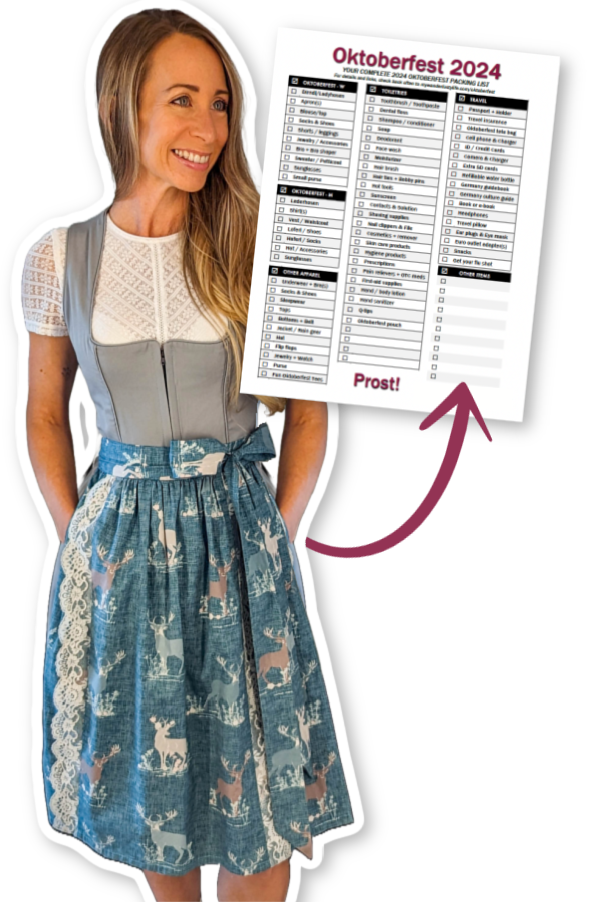
Get my 2023 Oktoberfest Packing List here!
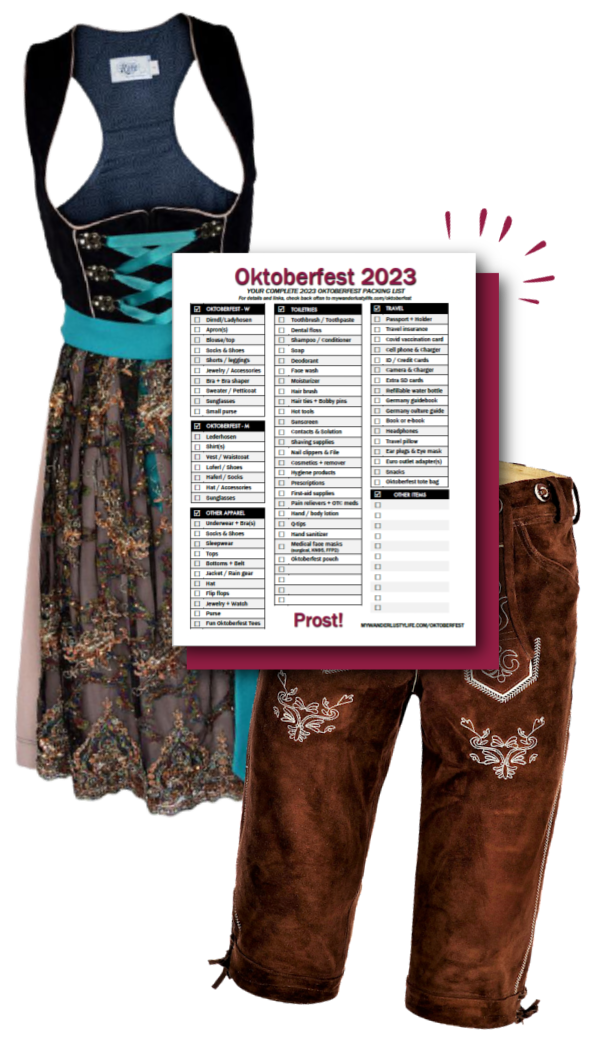
Want more Oktoberfest ?

Belize Packing List
Iceland packing list, get my 2024 hotel booking checklist here.
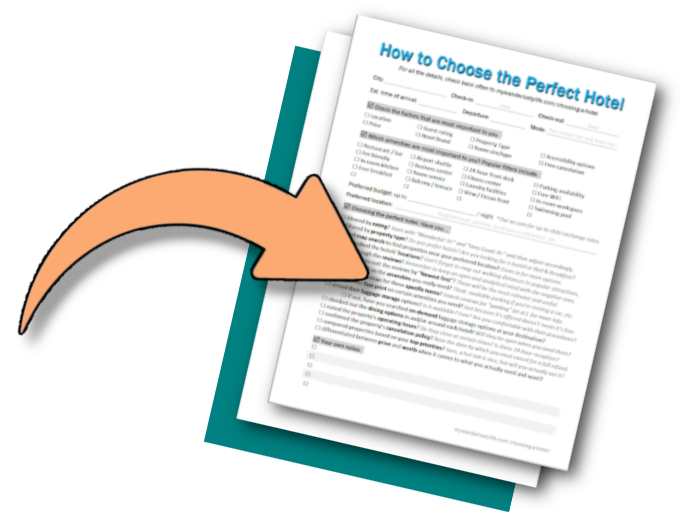
Subscribe to MWL!
Morocco packing list 2024, 2024 oahu bucket list.
Happily Ever Hiker
Tour du mont blanc: our epic guide to all you need to know.
The Tour du Mont Blanc is among Europe’s greatest and most widely known hikes covering an extremely long distance, and completing this hike should be at the top of your travel list.
There’s no denying that doing the Mont Blanc tour can be the most remarkable thing you can plan to do while visiting Europe, which is why we have an epic guide with everything you ought to know about this tour!
Table of Contents
What Is The Tour Du Mont Blanc?
The Tour du Mont Blanc is one of the most famous Mont Blanc trekking trails, and it also happens to belong to the list of world’s oldest trekking trails.
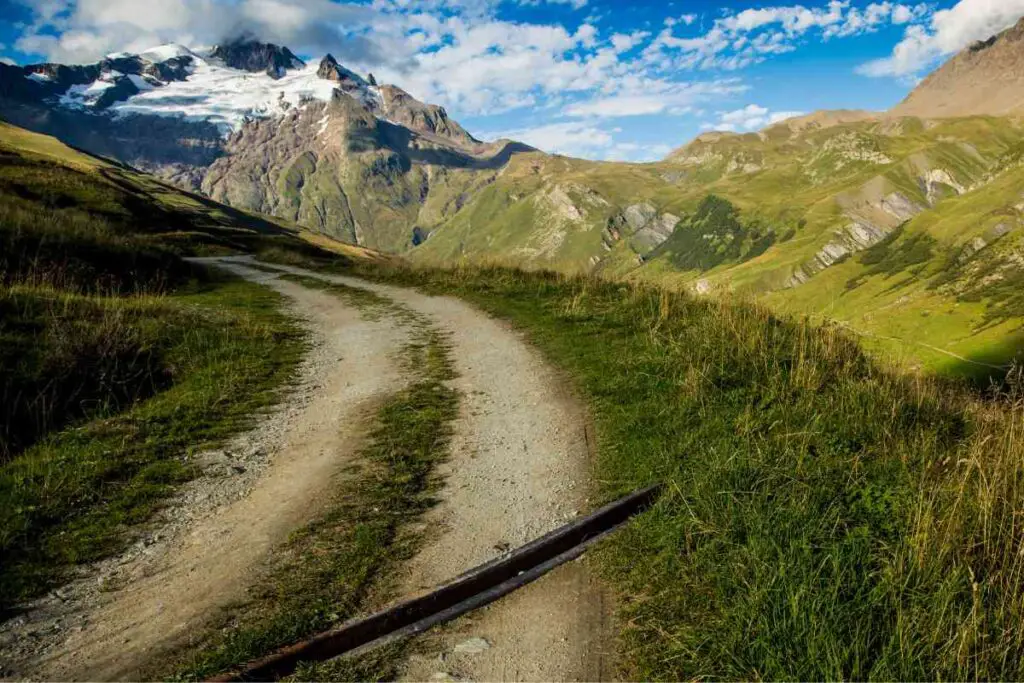
The loop is frequently featured in articles and lists titles as the ’10 Best Hiking Trails In The World,’ which is only fair given how spectacular the trail and its views are.
We’ll talk about the details of the trail later in this article, but expect breathtaking views, delectable food, and authentic mountainous adventures.
On just the first day, you’ll see massive snowy mountains, massive ice caps, majestic streams, and lush greenery.
Who Formed The Tour De Mont Blanc?
The trekking routes that comprise the tour du Mont Blanc loop, similar to the greatest treks in the world, were initially walked by shepherds who used to move their cows from one valley to the other.
However, it was a geologist from Switzerland who popularized this tour in the 18 th century.
The funny thing is that this “discovery” of his happened by accident as what he was trying to do was to figure out how to ascend Mont Blanc.
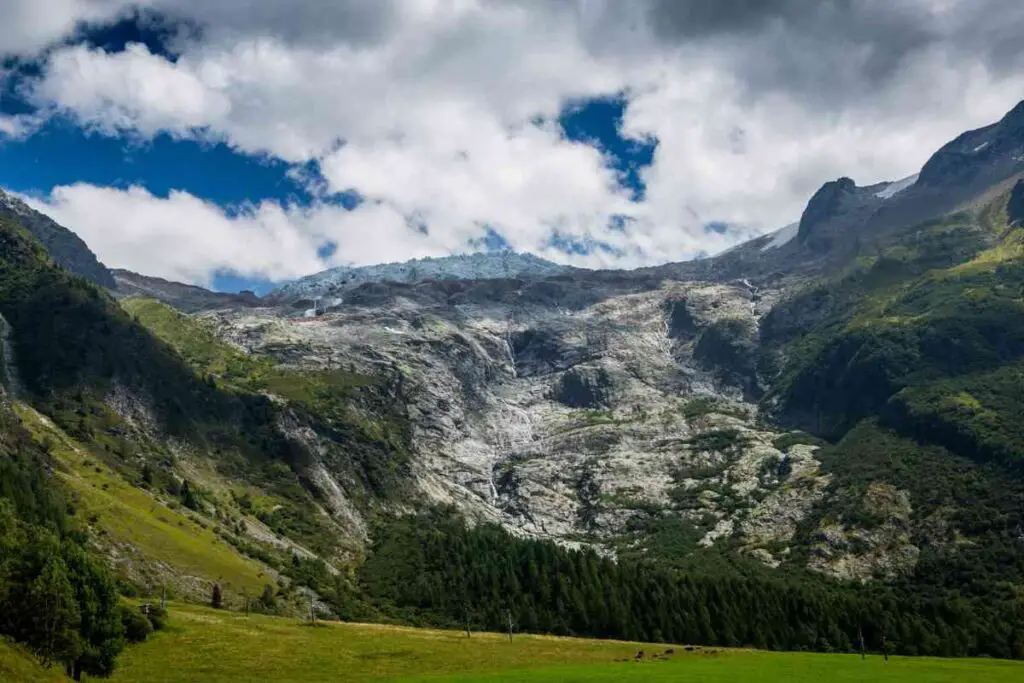
However, he ended up completing a circular trip around the entire mountain searching for the most suitable pathway, and thus was the first one (at least to our knowledge) to walk this trail.
The exact route the geologist followed is unconfirmed, but he went back to the mountain many times, desperately trying to reach the top.
Following several unsuccessful tries and circles around Mont Blanc, promised remuneration to whoever would reach the peak of the mountain.
It was in the late 1780s that two people from Chamonix were given the reward and managed to make the first climb.
He then was the third one to take the same path and reach the top of this famous European mountain.
Historically, Celtic tribal groups and the Roman army had used Col du Bonhomme, a spot located on the tour du Mont Blanc, as a route from which they moved their supplies through the Alpine areas.
Even today, you can discover the tattered remains of the Roman people and armies, with an old bridge built by their army remaining in good condition there, to many people’s surprise.
Where Is The Tour Du Mont Blanc?
TMB circumnavigates the mountain range, passing through Switzerland, Italy, as well as France.
Despite the fact that the trail does not reach the summit, everybody is familiar with Mont Blanc, and its name draws thousands of backpackers, hikers, and mountaineers each year.
How Long Is Tour Du Mont Blanc?
The Tour du Mont Blanc loop is a circuit that is 170 kilometers long and circles the Mont Blanc Mountain range.
Tour Du Mont Blanc Hike

Tour Du Mont Blanc Starting And Finishing Point
The Tour du Mont Blanc starts and finishes in Chamonix, an alpine town and adventure sports mecca on the French side of the Alps.
Despite its small size, Chamonix has always been overflowed with tourists and people looking for adventure thrills.
It is also a highly regarded ski retreat at the bottom of Mont Blanc, which means that there are many skiers and outdoor enthusiasts of all levels, as well as a booming mountaineering community and an abundance of trekking and mountain-bike paths to explore once the snow melts in the warmer months.
Chamonix is only 90 kilometers from the Geneva Airport and has numerous transportation choices available, rendering it a very accessible Alpine town.
The drive takes slightly more than an hour, bus services approximately 2 hours, and trains take closer to 3 hours, contingent on connections.
This town is also known as the World’s Capital of Adventure thanks to its busy rhythms, a plethora of fun activities, and simply stunning mountain ranges right next to it.
Tour Du Mont Blanc Route/Trail
The route follows a long loop of secluded pathways that circumnavigate the Mont Blanc massif in an anti-clockwise direction.
Of course, you have the option to follow the path in a clockwise direction, but the majority of people tend to go the other way around, and this is one of those cases where it’s preferable to go with the flow.
The trail is not challenging if you have prepared and trained right for it, but there are a lot of steep ascents.
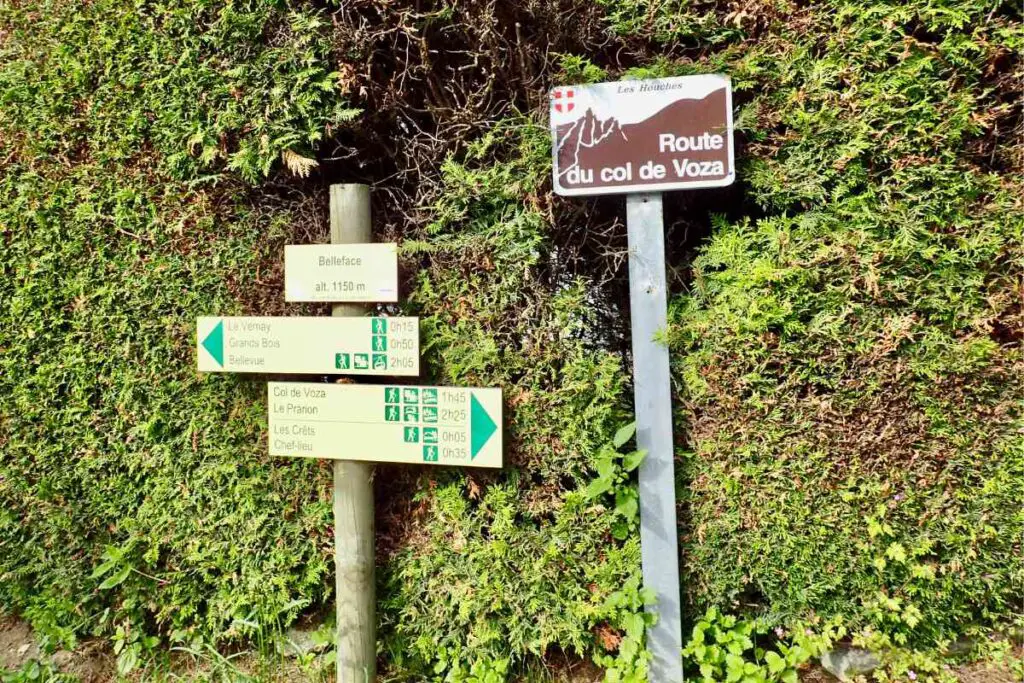
Nevertheless, there are also many variants and easier routes to take, so you can take paths that are slightly more demanding and then continue an easy downhill.
Moreover, the Tour du Mont Blanc trekking trail includes forest areas, desolate rugged terrain, and extensive green hillsides.
You’ll also be surrounded by the ultimate combination of majestic scenery and snow-covered highs above, with each day being unique.
However, if there’s one thing the majority of your tour days have in common, it is the fact that you will be following the same pattern of hiking across hilly areas, or mountain passes, before going down to a Refugio or hotel to rest.
Similarly, your days will begin with an enjoyable uphill walk to a picturesque point where you can enjoy your snack or meal while gazing at the scenery, and then continue with your final hike downhill for a hearty evening meal and some fresh beer.
Tour Du Mont Blanc Altitude
Mont Blanc, Western Europe’s highest mountain, is 4.808 meters above sea level, making its altitude one of the greatest and most challenging ones.
However, as we have previously mentioned the Tour De Mont Black does not involve ascending to its top.
In fact, the highest peak along the standard route is 2.537 meters above sea level, which is considerably lower than the top of the mountain.
This peak is at the Grand Col Ferret, which also serves as a frontier between Italy and Switzerland. Nevertheless, a few alternative routes can take you to the greatest heights.
So, for example, you also have the option of going higher up to enjoy the beautiful scenery from 2.665 meters above sea level. on the Col des Fours or Fenetre d’ Arpette,
Tour Du Mont Blanc Itinerary
Because of the long distance of the trail, most people complete the Tour du Mont Blanc route in 7 to 10 days.
Below you can find the itinerary for a 10-day hiking trip, and which is typically the one most people follow when doing the Tour du Mont Blanc for the first time!
10-Days Itinerary
Day 1: chamonix – les contamines.
On the first day, you’ll take the minibus to Les Houches and start your tour.
This first stage from Les Houches to Les Contamines is filled with lovely pine forest pathways, steep uphills and downhills, and areas of low trees and bushes carpeted with wild blueberry shrubs.

Nevertheless, you won’t be able to avoid the steep hills for the first hour, and if you choose to go from the variant, you can expect approximately 1500 meters of elevation, compared to the 650 meters of the standard route.
If you choose the challenging path, stop for lunch at the Refuge de Miage for some delicious and nourishing salad, and then continue your hike to Les Contamines for a night’s rest and more food.
Elevation Profile (Gain): 1500 meters of elevation gain for the variant, 650 meters of elevation gain for the standard route
Day 2: Les Contamines – Les Chapieux
After spending the night in a chalet, you’ll start the second day of the tour with an uphill trek up to the renowned Col du Bonhomme.
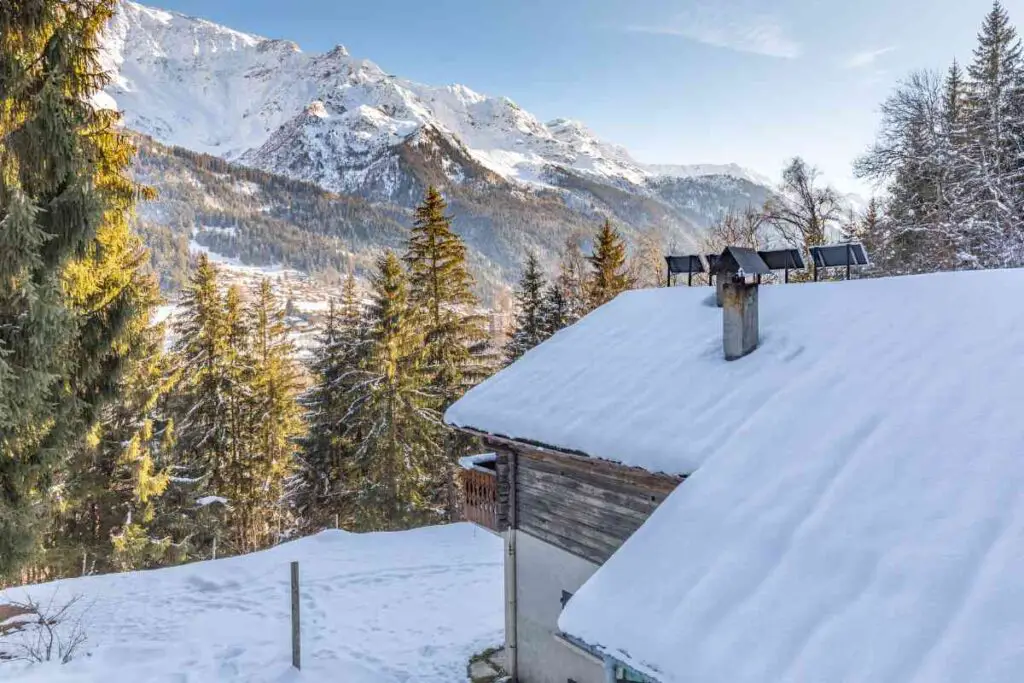
A few hours later towards the late afternoon, you’ll hike across the Croix de la Bonhomme and head straight to Les Chapieux.
This stage of the tour offers much better scenery and is less challenging, so you will certainly enjoy it more.
Les Chapieux is so small that it hardly qualifies as a town, but it’s quite lovely. There are a few guesthouses nearby. There also is a local products shop, where you must absolutely try their goat cheese!
Elevation Profile (Gain): 1300 meters of elevation gain
Day 3: Les Chapieux To Rifugio Monte Bianco
The third day will get you to Italy as you will be on the Col, which is approximately 1000 meters higher than the starting point.

The hike begins with a mild uphill through the valley, followed by several steep hills to the col’s summit. Although there is some altitude gain, this col is among the easiest ones to reach.
After you cross the col and until you reach Refugio Elisabetta it’s an enjoyable downhill. There you can spend some time enjoying some comfort food, and if you choose to stay the night, you’ll get a large dinner and an incredible view of the sunset.
Elevation Profile (Gain): 1000 meters of elevation gain
Day 4: Rifugio Monte Bianco – Courmayeur
This is undoubtedly the simplest hiking day.

An easy walk down the route to Courmayeur (that is nonetheless more than 4 hours long), a little town with many tourists, and you can have a nice break there, dine, enjoy a drink, and walk around the town.
Day 5: Courmayeur – Val Ferret
The fifth day begins with 800 meters of walking up a steep hill for approximately 2 hours, which is not that challenging.
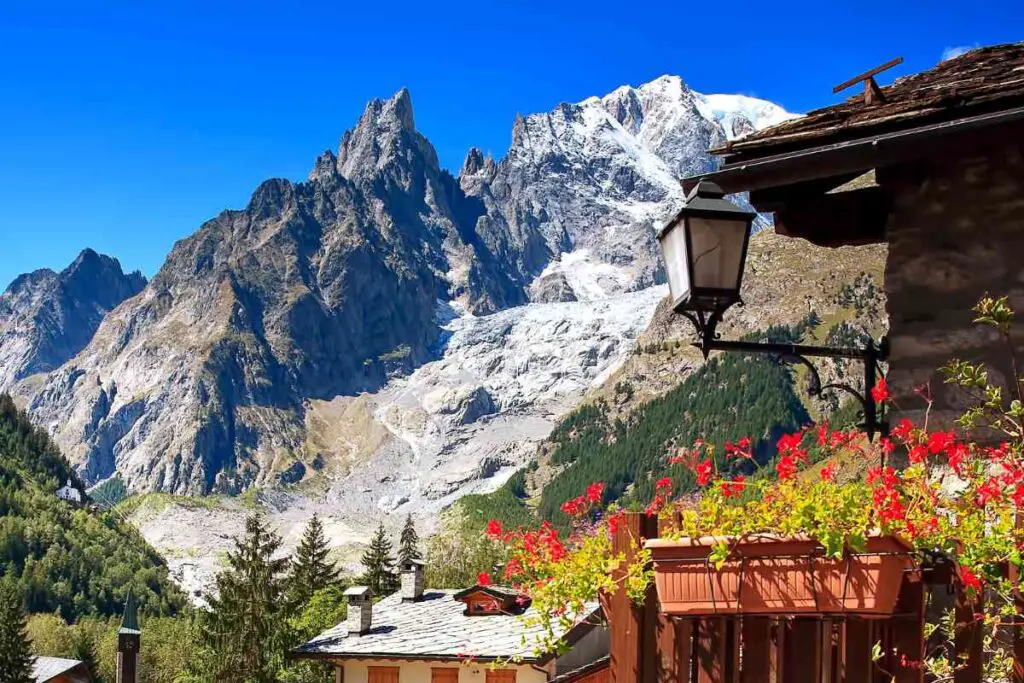
The hike from Courmayeur, at 1224 meters, to Refugio Bertone which is at 1996 meters, is mostly through a lovely forest area full of pine trees and it takes you along the Val Ferret, in between Italy and Switzerland.
When you get to the Refugio at the top, you can decide whether or not to complete the variant, which goes up 500 meters more and is 100% worth it.
Elevation Profile (Gain): 800 meters of elevation gain
Day 6: Val Ferret – La Fouly
On your sixth day, you’ll walk an easy 4-hour trail from Col Ferret to the little town of La Fouly, where you can try the delicious local cheese and other delicacies they offer.

An easier uphill walk all the way to a col will have you literally standing between France and Switzerland! As you descend, you’ll realize that the meal prices in the different Refugios skyrocket but spending some money on food there is worth it.
Day 7: La Fouly – Champex-Lac
This is a pleasant day with a hike through beautiful alpine grasslands and Swiss rural areas. You’ll finish your day in Champex-Lac, an idyllic Swiss settlement with a lovely lake where you can swim on a hot summer day!
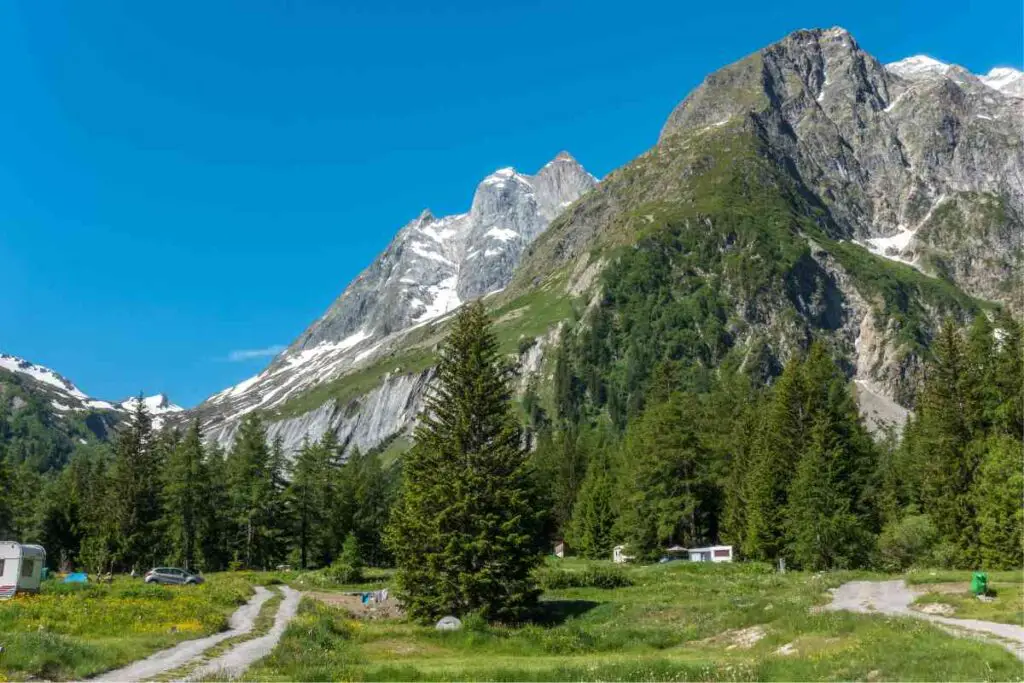
There are also many towns to stop in between, so despite the relatively short hike (in comparison to the 8-hour ones on other days), you need to take into account the hours you’ll spend exploring the towns.
Elevation Profile (Gain): 637 meters of elevation gain
Day 8: Champex-Lac – Trient
After a wonderful night in Champex, you can move on with your journey and begin the long but easy ascent to Bovine. From that point, you can descend to Trient via the Col de la Forclaz.
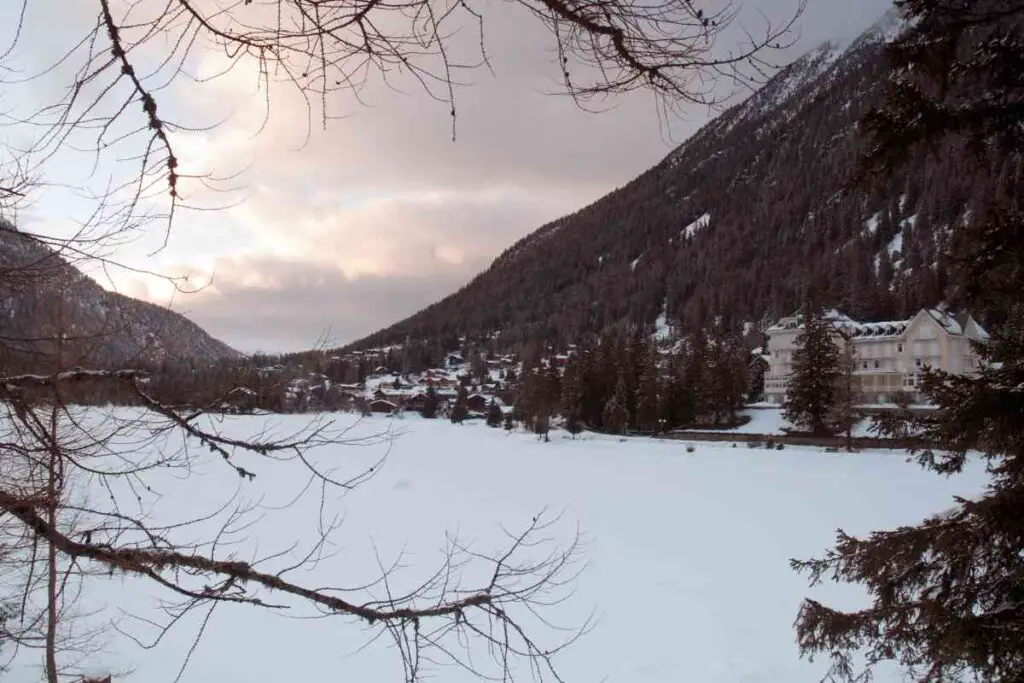
This day begins fairly flat before climbing approximately 1200 meters. The 1200-meter climb isn’t too difficult, and when you get to the top, there is also a cute spot to eat lunch and take in the views.
There are no grocery stores in Trient or La Peuty, so restock in Champex or enjoy your meals in any of the Refugios along the way.
Elevation Profile (Gain): 1200 meters of elevation gain
Day 9: Trient – Argentiere
The penultimate day starts early in the morning with an uphill trek up to Col de Balme, which offers Mont Blanc on a plate.

There’s also a variant that takes you up to Col des Possettes and the Aiguillette des Possettes peak that you can take, while the downhill to La Tour will mark the end of the hiking part of the day, leaving you time to relax and unwind.
Elevation Profile (Gain): 1180 meters of elevation gain
Day 10: Argentiere – Chamonix
The last day of your tour offers either the chance to ascend over Lac Blanc on some daring stairways or choose the standard and easier route.
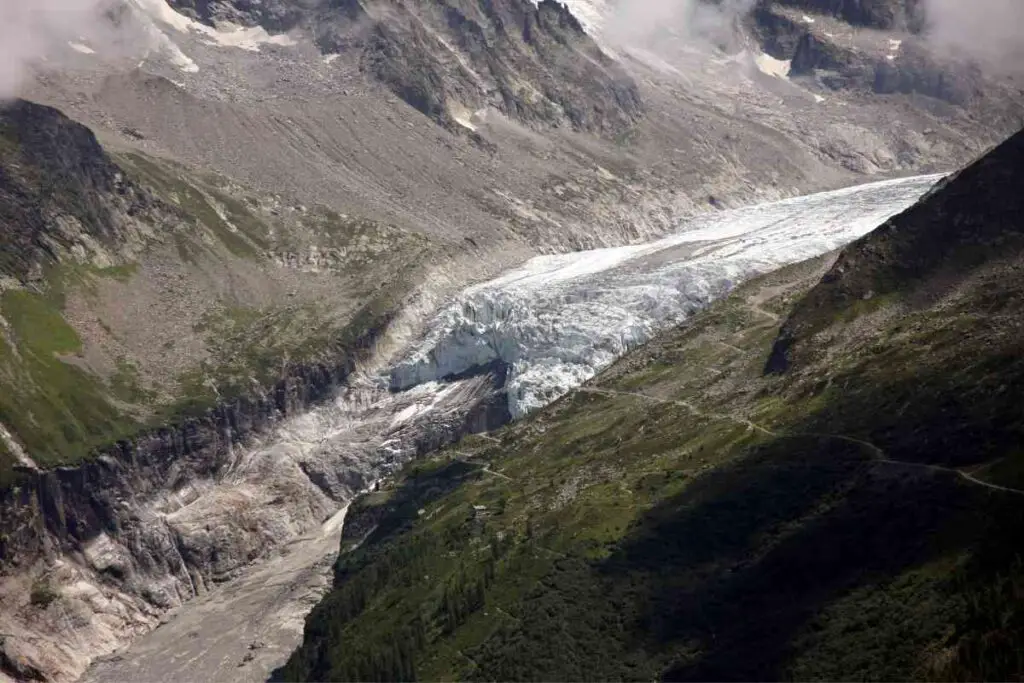
Some of the most breathtaking views are being enjoyed in this last stage of the trip, which will finish with a downhill walk with Chamonix as the final destination.
Elevation Profile (Gain): 1260 meters of elevation gain
Tour Du Mont Blanc Tour Options
There are both guided and self-guided tours you can join to complete the Tour du Mont Blanc, and depending on what you choose to do, the costs will be different.
Here are some examples of guided and self-guided tours offered:
- Macs Adventure Tour
- Tour Du Mont Blanc Holiday
- Alpine Treks
- Wildland Trekking Tour
Tour Du Mont Blanc Map
Mont Blanc Treks offer several maps such as those of the easterly and westerly circuits as well as one of the full circuits around Mont Blanc, and a chart of the elevation profile of the tour.
Tour Du Mont Blanc Packing List
If you are planning on camping throughout the tour, you need to make sure you are packing as light as possible as you will be carrying the extra camping equipment with you which includes a tent and a sleeping bag , as well as a sleeping pad.

The rest of the things you need to carry are:
- Water bottle
- Clothes: fleece or sweater (depending on the weather), extra socks and underwear, shirts and shorts, and long trousers.
- Accessories: bandanas, caps, headlamp
- Microfiber towel
- Power adapter
- First-aid kit
- Passport and/or ID
When To Hike the Tour Du Mont Blanc?
The best time of the year to walk the tour du Mont Blanc is in the summertime when the climate is softer, the sun is up, and all ice has melted.
Given its high altitude and Alpine winters, going there in the summer can guarantee you a good night’s sleep when you choose to camp for the night as well as warmer weather for your hike.
Training For Tour Du Mont Blanc
Depending on which path you take, you should train and get ready for a little more or a little less strain on your legs and work accordingly on your cardio fitness level.
Read next – Is hiking good cardio?
No matter how many variants you choose to hike and how fast or slow you choose to go, you need a great fitness level, so you either have to train consistently for months, even years, before embarking on your journey, or be very athletic and fit.
Previous experience with long-distance hikes will also make this trip easier, but this does not mean you won’t need to prepare for it just because you hiked coast to coast in the UK years ago!
Tour Du Mont Blanc Accommodation
A common question and topic of discussion among hikers to-be of the Tour du Mont Blanc is that concerning the lodging options.
To begin with, there are numerous places to spend the night. If you have a lot of money, you have a plethora of choices.
However, if you’d like to complete your journey without breaking the bank, you can either choose camping or stay in one of the many refugios or guesthouses.
- Find the most affordable places to stay at booking.com
Tour Du Mont Blanc Refuges
A Refugio is a refuge, also called a mountain hut. It is basically a mountain hostel with simple interior decoration and amazing food!
Many Refugios offer private rooms, however, some of them only provide shared hostel-style lodging.
Tour Du Mont Blanc Camping
You also have the option of setting up camp every night. Clearly, it will be the most cost-effective option, but it is also one that allows you to experience this adventure in the best way possible, as it kind of completes the overall experience.
Furthermore, you won’t have to worry about making any reservations, as you can simply arrive at the campground and find a spot to set up your tent.
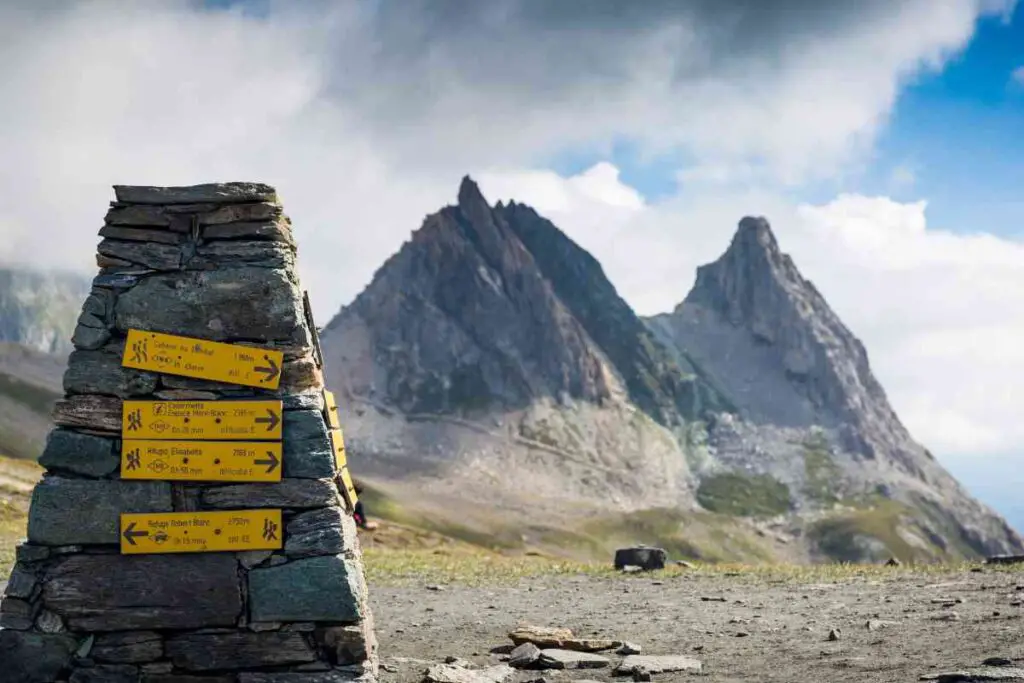
There are numerous ways to organize your trip, in addition to the several accommodation alternatives.
Many people prefer to schedule and plan things on their own, including booking their own accommodation and transporting all their belongings, but sometimes it is better to have some assistance.
During the peak tourist season, which is in July and August, it is preferable to let somebody else book your accommodation and luggage transfers.
Even so, keep in mind that if you choose to stay in accommodations rather than go camping, that means you’ll have to pay in advance and do your best to stay committed to the planned itinerary.
Any delay or injury incident might mean you can lose a night’s stay and, hence, money spent on a room you won’t stay in after all.
On the other hand, if you do the hike off-peak season, you can always make a same-day booking as it is always available in most hotels and guesthouses.
Either way, this website of the Tour De Mont Blanc is very useful for planning your stay throughout the tour.
You can select your intended destination and a precise date, and it will display a list of accommodation options you can stay in, which would include the walking distance from one to the other.
The Bottom Line
The Tour du Mont Blanc is without a doubt an epic multi-day hike on this planet and experiencing this journey is something you will remember forever.
The good thing is that you can always visit this destination again and if you go there on a guided tour the first time, challenge yourself by going on a self-guided tour the next one!
Leave a Reply Cancel reply
Your email address will not be published.
Save my name, email, and website in this browser for the next time I comment.
Latest from Blog

Will Snakes Cross a Rope? Debunking Common Myths
Yes, some snakes can cross ropes, especially if they’re good climbers and the rope provides enough

What to Do if You See a Deer While Hiking: Safe Wildlife Encounters
If you spot a deer while on a trail, the first step is to maintain a

Are Timberlands Good for Hiking? Evaluating Durability and Comfort
While fashion-forward individuals often sport Timberlands in urban settings, a question looms for outdoor enthusiasts: Are

How to Get Better at Hiking Uphill: Techniques for Mastery
Mastering the art of uphill hiking can transform your outdoor experiences, offering not only breathtaking views

Is Hiking Aerobic or Anaerobic: Understanding the Exercise Classification
Often, hiking is primarily an aerobic activity, especially when you engage in it over an extended
Privacy Policy

The Ultimate Guide to the Tour du Mont Blanc
The Tour du Mont Blanc is one of the world’s most iconic treks. Frequently referred to as the ‘TMB’ for short, the Tour du Mont Blanc circumnavigates the Mont Blanc massif and takes trekkers through France, Italy, and Switzerland over the course of 11 stages. Along the way you’ll experience stunning valleys, high-mountain passes, incredible cuisine, and some of the best hiking in the world.
This guide is designed to be the perfect planning companion for your own Tour du Mont Blanc adventure. We’ve included everything you need to know to have a spectacular trip in one place, so you can be sure you’ve thought of everything. Read it through in a single go or jump to a specific section below, but rest assured knowing you’ve found the best resource on the internet for planning your Tour du Mont Blanc trek. Let’s get started!

In this Tour du Mont Blanc Guide
- How long is the Tour du Mont Blanc?
- How difficult is the Tour du Mont Blanc?
- Which direction should I hike?
- When should I hike the TMB?
- Designing your TMB Itinerary
- Shortcuts, detours, and rest days on the TMB
- Stage-by-stage Itinerary for the Tour du Mont Blanc
Tour du Mont Blanc Accommodation
- Getting to Les Houches from Geneva
- Getting to Champex from Geneva
- Luggage storage and transfer on the TMB
- Weather on the TMB
- Food and drink on the TMB
- Maps & Guidebooks
- Budgeting and money
- What to pack for the TMB
- How to train for the Tour du Mont Blanc
Everything you need to plan your TMB – all in one place.
Whether you prefer mountain huts or hotels, fastpacking or meandering, or something in between, we’ve got you covered. Our Guide to the Tour du Mont Blanc is the ultimate tool to help you plan your perfect trip.
When you purchase a guide, you’ll get instant access to all the information you need to plan your trip in our planning portal as well as in a downloadable PDF eGuide.
- Planning Portal Access: Get instant access to our online trip planning portal complete with 9-day, 11-day, and 12-day TMB itineraries.
- Accommodation Insights: You’ll get information on accommodation options for every stage, including where to book when popular huts are fully booked!
- GPS Maps: Every guide comes with custom GPS maps for three different itineraries. Download the maps for offline use so you’ll always be able to find your next campsite.
- Expert Advice: Find detailed maps for every stage, accommodation & booking information, packing lists, and much more.

We’re confident this is the best resource available for camping on the Tour du Mont Blanc. Pick up your guide below and if you’re not satisfied for any reason we’ll give you a full refund!
( 100% Money Back Guarantee )
About the Tour du Mont Blanc
The Tour du Mont Blanc (TMB) is a 170-km trek that circles the Mont Blanc massif. The route is traditionally walked in the anti-clockwise direction over 11-stages. The TMB starts and finishes in the French village of Les Houches , which sits adjacent to the popular mountain town of Chamonix . Along the way the trail passes through seven unique and beautiful valleys, where charming hamlets and regional delicacies abound. Between the valleys, the route traverses a rugged mountain landscape and stunning high alpine scenery.

The TMB is one of the most popular long-distance treks in Europe, with over 10,000 hikers per year embarking on their own walk around Mont Blanc. It is easy to understand why when considering the ease of access to the trek , plentiful accommodation options , and the fact that the route is achievable by most reasonably fit walkers . The closest major city to the TMB is Geneva, Switzerland, located just a few hours north by train or bus .
The route passes through seven mountain valleys (Val d’Arve, Val d’Montjoie, Vallee des Glaciers, Val Veny, Italian Val Ferret, Swiss Val Ferret, and Vallee du Trient) and visits charming alpine hamlets as it winds its way around Mont Blanc. Contrary to what many believe, the TMB does not go through the iconic French mountain town of Chamonix, instead taking a trail high-above this famed destination.

Want to see the entire TMB in three minutes? The fly through video below will take you along the entire circuit, providing a helpful overview of the trek.
How Long is the Tour du Mont Blanc?
The short answer: it depends! The Tour du Mont Blanc has many variations and route options as it makes its way around Mont Blanc. These variations include options to tackle challenging mountain passes (see the Fenetre d’Arpette ), visit crystal clear mountain lakes (such as Lac Blanc ), or to simply avoid some of the more challenging sections of the hike. However, the classic TMB route is approximately 170-kilometers long. Taking alternate routes may lengthen or shorten your total distance, depending on the routes chosen. Throughout the trek, you’ll have options to walk less or more depending on the weather, your preferences, and the conditions encountered on the trail.

How Difficult is the Tour du Mont Blanc?
If you are reasonably fit and have some trekking experience , you should be well-suited to the physical challenges of the TMB. It is a tough trek that involves long, steep ascents and descents on nearly every stage , but it isn’t too technically demanding. Remember, the Tour du Mont Blanc is a hike not a climb! Trekkers should be prepared for long days of hiking with plenty of elevation change, but frequent services along the route make it more approachable. Weather can add to the challenge , and hikers should be prepared to encounter rain and even snow at any time.
Many of the stages of the TMB are structured such that you’ll begin your hike from the valley floor, trek up and over a mountain pass, and then descend into the next valley to finish the day. This provides a nice rhythm to the Tour du Mont Blanc but can also make for some difficult days. Make sure you have healthy knees, as the downhill sections can take their toll! All that being said we truly believe that most walkers who invest a bit of time in training and preparation can complete the Tour du Mont Blanc with no problems and have a great time doing it! Our best advice is to be sure you are in good physical condition and also make sound decisions when you encounter bad weather or snow.
Get The FREE TMB Essentials Handbook

Our free PDF guide covers all the basics – when to hike, accommodation, typical costs, and more!
Your TMB Essentials Booklet will be emailed to you shortly.

Planning Your Perfect Tour du Mont Blanc
Now that you have a bit of background on the TMB let’s get to the heart of this guide: helping you plan your perfect Tour du Mont Blanc! First, we’ll start with some basics such as which direction you should hike in and what time of year will be best for you to tackle the TMB. Then we’ll dive into some more in-depth considerations such as designing your perfect itinerary and selecting your accommodation . Let’s get started!

Which Direction Should I Hike the TMB?

The TMB is traditionally hiked in an anti-clockwise direction beginning in the French town of Les Houches, adjacent to Chamonix. It is also possible to walk the route in a clockwise direction, and trekkers headed this way typically start in the Swiss town of Champex-Lac . Below we’ve outlined some pros and cons of hiking in each direction.
Anti-Clockwise (starting in Les Houches, France)
- Follows the classic route, good if you’re a sucker for tradition.
- Begins near Chamonix, which is easier to get to from the Geneva Airport than Champex.
- Rewards hikers with jaw-dropping views of Mont Blanc on the final stage.
- More people hike in this direction, so the trail could feel more crowded throughout the day.
Clockwise (starting in Champex, Switzerland)
- Fewer hikers walking in the same direction as you.
- The first few stages are a bit mellower, allowing you to get acclimated before tackling the tougher sections.
- You’ll meet different people at each stop along the way.
- You’ll pass a large wave of people walking in the opposite direction each day, which can get tight on narrow trails.
- Champex (your starting point) has fewer amenities and is less conveniently connected by public transport than Les Houches. If you want to start in Les Houches and hike clockwise, be warned that the first day involves a very challenging climb, which can be a tough way to begin your trek.
All things considered, you will be sure to have a great time on the TMB regardless of which direction you choose to hike in. Think through your options and make the best decision for yourself!

When Should I Hike the Tour du Mont Blanc?
The hiking season for the TMB generally lasts from late June through mid-September. July and August are the busiest months, and accommodation (with the exception of camping) must be booked in advance. There’s a chance you could get away without advance bookings in June and September, but we still wouldn’t recommend it.

June : Early in the season, you are likely to encounter snow on the trail. Depending on the snow levels, there could be sections that will be impassible and you may need to reroute. Otherwise, expect cool evenings, bright sunny days, and less crowded trails. Keep in mind that most mountain refuges don’t open until late June.
July : Hikers could still encounter some snow along the trail, but chances of significant snow will diminish as the month wears on. Expect beautiful warm days and abundant wildflowers. This is a popular month to hike.
August : Another busy month on the trail, hikers can expect snow-free paths and warm, sunny weather. The end of August brings the Ultra Tour du Mont Blanc trail race . Although the atmosphere during the race week is incredible, we recommend you try to avoid hiking during the UTMB to avoid crowds and logistical challenges.
September : Expect shorter days and increasingly chilly weather. This is a beautiful time to be on the trail and less crowded, although some accommodation providers may be closed for the season.
The bottom line : The best (and safest) time to hike the TMB is from late-June through early September. You’ll need to make advance bookings if you plan to hike during this time frame.

Designing Your TMB Itinerary

Now that you have a sense of which direction you’ll plan to hike in as well as which month you’ll embark of your trip it’s time to start thinking about your specific itinerary! As we’ve mentioned, the Tour du Mont Blanc in traditionally hiked over the course of 11 days, which will be a great pace for many hikers. However, there are certainly those who will want to tackle the trail in fewer days or savor their time in the Alps and extend their hike over the course of two weeks or more!
Whatever you choose be sure to consider your personal abilities, how much time you’ll have, and what you want your typical days on the TMB to look like. Given the amount of accommodation options on the TMB your itinerary possibilities are nearly endless! Checkout our general guidelines below as well as our stage-by-stage itinerary for the traditional 11-day Tour du Mont Blanc circuit to get some ideas of your own. Here are our general guidelines for thinking about how many days you’ll need to complete the TMB:
- 8-10 days : Fast pace (8 – 10 hours of hiking each day)
- 10-11 days : Average pace (without a rest day) (6-8 hours of hiking each day)
- 11-12 days : Average pace (with a rest day) (6 – 8 hours of hiking each day)
- 12-14 days : Leisurely pace (6 – 7 hours of hiking each day)
Shortcuts, Detours, and Rest Days on the TMB
One of the great things about trekking the Tour du Mont Blanc is the ability to alter your route based on the conditions encountered. Bad weather, injuries, fatigue, burnout, limited time; there are countless reasons why you may need to use alternative means of transportation to get from one point of the TMB to another. Fortunately, the trail rarely strays too far from civilization, meaning you have tons of options along the way for when you need them. Below, we’ve listed some of the most common detours and shortcuts used on the TMB, as well as a few great resources for problem-solving your unique situation.
Bellvue Cable Car: This option allows you to eliminate the lion’s share of the climb out of Les Houches on the traditional (anti-clockwise) first stage of the trek . Once you get to the top, follow the signs a short way to rejoin the main trail.
La Maison Vielle Cable Car (and chairlift): If you’d like to avoid the knee-wrenching descent into Courmayeur ( Stage 4 ), you can take a chairlift from La Maison Vieille down to Plan Chécrouit, where there’s a cable car that terminates in the town of Dolonne, across the river from Courmayeur. You can take a bus from Dolonne to Courmayeur if needed, otherwise it’s just a short walk.
La Flégère Cable Car: This gondola departs directly next to Refuge la Flégère and ends in the village of Les Praz. From there, it’s possible to take a bus or taxi back to Chamonix. This is a good option if you need to cut out the final day of the TMB , or if you want to hike in reverse and avoid the long, long climb out of Les Houches. You could also take the cable car down into Les Praz for more accommodation and services at this stage, and then take it back up the next morning to continue your trek.

La Chapelle to Notre Dame de la Gorge Navette : This free shuttle bus, or “navette,” runs from La Chapelle (a short walk from the trail on the outskirts of Les Contamines) to Notre Dame de la Gorge (at the beginning of Stage 2 ). This means you can pick it up at the end of Stage 1 to cut out the last hour or so of walking before reaching Les Contamines, and you can also take it from Les Contamines to Notre Dame de la Gorge on the next day to get a bit of a head start (30-60 minutes, depending on where you stay in Les Contamines).
Les Chapieux to Refuge des Mottets Navette : This shuttle allows you to avoid about 2 hours of road walking at the beginning of Stage 3 . It only costs a few euros to ride, and you can pick it up at the tourist information office in Les Chapieux. Make sure to buy your tickets in advance (do so the previous day, at the tourist office), as the shuttle fills up quickly in the mornings!
Arriva Bus-In and around Courmayeur: This is the bus network you’ll use if you need to take any alternative transportation in Val Ferret or Val Veny (the two valleys in the surrounding area). You can take a bus from La Visaille to Courmayeur to cut out the final hour of walking on Stage 4 . This bus can also be used to reach campgrounds that are not located directly on the TMB route. Additionally, you can use the Savda bus to get to either La Fouly or Champex (although you will need to transfer in Orsières and take a Post Bus the remainder of the journey).
TMR/SBB Bus La Fouly to Champex: You can get from La Fouly to Champex (effectively cutting out all of Stage 7) by bus. You’ll need to take line 272 from La Fouly to Orsières, where you’ll transfer to the 271 that will take you to Champex. Service is relatively frequent and easy to navigate.

SBB Train from Champex to Trient: It’s relatively easy and straightforward to take the Swiss SBB train from Champex to Trient, effectively cutting out all of Stage 8. You need to utilize the local bus in Champex and may need to transfer a few times on the way, but Swiss trains really do live up to their reputation for being timely and efficient.
Keep in mind that there are many more transportation options along the TMB! We’ve simply listed a few of the most common and straightforward ones. If you need to find a specific detour, we recommend using Rome2Rio or Google Maps as a starting point. PostBus and SBB also have excellent apps that can be used to plan trips and buy tickets.
NOTE: Many of the buses and cable cars only run during the peak months of the hiking season (July and August). Make sure that you check the websites and timetables before planning to use any of the options listed above.
Stage-by-Stage Itinerary for the Tour du Mont Blanc
We recommend most hikers take between 10-12 days to hike the Tour du Mont Blanc, depending on their hiking ability, pace preferences, and weather conditions. The classic itinerary described below takes 11 days to complete and will be the best option for the majority of hikers. We’ve given you a brief overview of each of the classic eleven stages, as hiked in the anti-clockwise direction. While your specific itinerary may look different, it’s still helpful to look over these stage descriptions to get an idea of what you can expect on the trail.
Be sure to check out our interactive map and elevation profile to get a comprehensive understanding of all of your options!
Stage 1: Les Houches to Les Contamines
- Distance & Elevation: 17 km // +1,112 m, -902 m
- Estimated hiking time: 5 – 6 hours
- Where to stay: Chalet-Hôtel La Chemenaz
Description: This stage is a perfect introduction to the TMB. It’s not too technical or demanding, yet it still gives walkers a decent challenge. You’ll start by climbing fairly steeply up out of Les Houches and past a ski area before topping out at Col de Voza . From the Col, you’ll descend along dirt then paved roads while enjoying incredible views of the surrounding glaciers and aiguilles. Continue along the road through some very quaint hamlets, before veering off onto a trail (pay attention-this is easy to miss). You’ll end this stage by walking along a mellow riverside path all the way to Les Contamines.

Stage 2: Les Contamines to Les Chapieux
- Distance & Elevation: 19 km // +1,440 m, -1,024 m
- Estimated hiking time: 7 – 8 hours
- Where to stay: Auberge de la Nova
Description: Start this stage by passing by the Baroque chapel of Notre Dame de la Gorge . From there, you’ll follow an old Roman road steadily uphill before getting a break when the trail levels out and passes through open meadowland. After that, prepare for another steep climb, much of it on stony steps and scree, up first to the saddle of Col du Bonhomme, and then even higher to the Col de la Croix du Bonhomme. Here you’ll find the Refuge de la Croix du Bonhomme , which makes a great spot to enjoy a break and small meal. Early in the season, it’s common to encounter snow on this section.
Upon reaching the summit of Col de la Croix du Bonhomme, begin your descent towards Les Chapieux. The trail on the way down begins as a steep footpath, eases to join a jeep road for a bit, and then finishes with steep zigzags through a pasture above Les Chapieux.

Stage 3: Les Chapieux to Rifugio Elisabetta
- Distance & Elevation: 14 km // +1,079 m, -480 m
- Where to stay: Rifugio Elisabetta
Description: Choose to begin this stage with either a couple of miles of road walking, or by short-cutting it on a bus to Refuge des Mottets . From the refuge, you’ll begin a relatively short and easy climb to the Col de la Seigne. Reaching the Col is special for a few reasons. First it marks the first of three international borders that you’ll cross on your trek. Standing at the top of the Col, you can look back towards France while also gazing ahead into Italy. Additionally, the wide-open views here are downright marvelous. From Col de la Seigne, enjoy a mellow descent to Rifugio Elisabetta.

Stage 4: Rifugio Elisabetta to Courmayeur
- Distance & Elevation: 16 km // +603 m, -1,536 m
- Where to stay: Maison La Saxe
Description: As indicated by the elevation statistics, this stage is dominated by a very long and steep descent into Courmayeur. Before beginning that section, however, you’ll cross through the expansive Vallon de la Lee Blanche, where Lac Combal reflects the magnificent surrounding peaks. From there, you’ll climb for awhile on an undulating path to reach Col Chécrouit, where the path begins its long downhill trajectory.
After passing a few ski areas (options to take the cable car down may be available), you’ll complete numerous switchbacks through the woods until you reach the quaint town of Dolonne. Walk through the town of Dolonne and cross the river to enter Courmayeur. Enjoy a wide arrange of excellent food and luxurious accommodation in Courmayeur. This is also a great place to take a rest day.

Stage 5: Courmayeur to Rifugio Bonatti
- Distance & Elevation: 12 km // +1,225 m, -415 m
- Estimated hiking time: 5 hours
- Where to stay: Rifugio Bonatti
Description: The views along this stage are some of the most spectacular of the entire walk, but you have to earn them with a very steep climb at the outset. You’ll enjoy the satisfaction of watching Courmayeur grow ever smaller down below you as you zigzag your way up the hillside to Rifugio Bertone.
From the Rifugio, you’ll enjoy an undulating, mellow walk with unparalleled views of Col de la Seigne, Aiguille Noire, Mont Blanc and the Grandes Jorasses. It’s an incredible experience to look back and see Col de la Seigne far in the distance, knowing you’ve traversed such an expanse in just a few days with your own two feet. The beautiful views continue to abound all the way until you reach Rifugio Bonatti, an atmospheric and memorable place to spend the night.

Stage 6: Rifugio Bonatti to La Fouly
- Distance & Elevation: 19 km // +1,032 m, -1,456 m
- Estimated hiking time: 6 – 7 hours
- Where to stay: Hotel Edelweiss
Description: This stage rewards hikers with another border crossing and more tremendous views. The walk begins with a relatively flat path that crosses a lovely hillside. Eventually, you’ll descend into Val Ferret (the Ferret Valley) before beginning a steep climb past Rifugio Elena and up further until you finally reach the Grand Col Ferret. At the top of the pass, you’ll enjoy your first views of Switzerland as well as phenomenal views of majestic peaks in every direction. It’s all downhill from there, much of which is pretty manageable, save for a few steep sections. There’s a rather uninspiring stretch of road walking at the very end of the day, but the charming town of La Fouly makes it all worth it.

Stage 7: La Fouly to Champex
- Distance & Elevation: 15 km // +729 m, -860 m
- Estimated hiking time: 4 – 5 hours
- Where to stay: Au Vieux Champex
Description: All of the guidebooks will tell you that this is the easiest day of the TMB (which is technically true), but don’t expect this stage to be completely effortless. Sometimes the “easiest” days can end up feeling really tough if we go into them with too cavalier a mindset. The first two thirds of this stage are quite mellow indeed; you’ll wind your way gently downhill through a quintessential Swiss valley filled with small farms and picturesque hamlets.
A substantial climb to Champex waits for you at the end of the stage, however. Even though it really is much less strenuous than the ascents of previous stages, it can be a shock to the body at the end of the day. Fortunately, the trail stays in the shade of the trees for much of the way up, and you’ll also get to experience the many wooden sculptures that are interspersed throughout the woods.

Stage 8: Champex to Col de la Forclaz
- Distance & Elevation: 14 km // +1,125 m, -1,066 m
- Where to stay: Hotel de la Forclaz
Description: On stage 8, the main TMB route follows an undulating path up to the Alp Bovine and then descends to Col de la Forclaz, but there are quite a few options to consider here. The Fenêtre d’Arpette route is a popular variant for those seeking challenge and adventure. With either route, you’ll also have a few options to choose from when it comes to your stopping point. For a shorter day, you can stop at Hotel de la Forclaz or you can continue on further to either Le Puety or Trient. There isn’t a clear “best” choice for what to do on stage 8, but it is important to think about what is best for you in terms of challenge, distance, and accommodation.

Stage 9: Col de la Forclaz to Tré-le-Champ
- Distance & Elevation: 14 km // +1,112 m, -1,229 m
- Where to stay: Auberge la Boerne
Description: This stage isn’t without physical demands, gaining and losing quite a bit of elevation in a relatively short distance. While most of the climb maintains a grade that isn’t crazy steep, the descent is another story. Even if you don’t love the arduous nature of stage 9, you’ll almost certainly be smitten by the scenery. Not only does summiting Col de Balme mean you’ll celebrate your third and final border crossing (back into France), but you’ll also get incredible views of Mont Blanc, back in sight for the first time in several days. Seeing Mont Blanc again and being back on French soil will likely remind you that your trek is nearing its end. Make sure to savor the final two stages of this incredible experience!

Stage 10: Tré-le-Champ to La Flégère
- Distance & Elevation: 7 km // +892 m, -446 m
- Estimated hiking time: 4 hours
- Where to stay: Refuge de la Flégère
Description: Allow yourself to sleep in on this stage, as you’ll have just a short walk ahead of you. Better yet, get to Refuge la Flégère early and enjoy a walk to the nearby Lac Blanc and a meal or beverage at the refuge. The final two days of the TMB follow the Grand Balcon Sud, a balcony trail with unrivaled views of Mont Blanc and the surrounding peaks. To reach the high point, you’ll need to climb a series of ladders, catwalks, and platforms that go on for longer than you might expect. If you have a fear of heights, we recommend taking the Col des Montets variant. This route takes about the same amount of time and still has great views. Upon reaching Refuge la Flégère, join in the festive revelry of your fellow hikers marking their final night on the trail.

Stage 11: La Flégère to Les Houches
- Distance & Elevation: 17 km // +969 m, -1,821 m
- Where to stay: Hotel Le Morgane (Chamonix)
Description: The final stage of the TMB is a big one in every way. Even though it’s dominated by downhill walking, the physical demands shouldn’t be overlooked. Start the walk on a very mellow uphill grade, before beginning a steeper climb past a ski area until reaching Col du Brevent. Take in the scenery (and catch your breath) here, but keep in mind that the best is yet to come. Climb further on more rugged terrain until you reach the almost-summit of Le Brevent (you can take a 5-minute detour to get to the actual top if you’d like).
From Le Brevent you’ll have an unobstructed and totally breathtaking vantage point from which to take in the entire Mont Blanc range. Take time to study every intricate glacier and craggy spire before finally tearing yourself away to make your way down towards Les Houches. Fortunately, you’ll continue to enjoy the scenery for awhile as you descend on a very long and very steep path. As you near Les Houches, the trail enters the woods where it passes a zoo and the large Christ Roi statue. Finally, the path ends at a road and perhaps the least scenic part of Les Houches. Keep walking to reach the more charming part of town, then stop and toast to your remarkable accomplishment!

There are accommodation options along the TMB to suit every budget and travel style. While not all of these options are available at every stage of the route, you can certainly customize your itinerary to fit your needs. It’s nearly inevitable that you’ll need to stay in a mountain refuge on at least one stage of your trek. Be prepared for basic, communal facilities, but don’t fear! These special places often yield the most memorable stays of the entire trip. We’ve provided a brief explanation of each of the options below:
Hotels on the Tour du Mont Blanc

Typically small and independently owned, the hotels along the TMB serve up a dose of luxury to the weary hiker. Unless otherwise noted by the hotel, expect all of the usual amenities (hot shower, private bathroom, breakfast offered, linens and towels provided, etc). Hotels typically cost upwards of €65 per person. For an additional fee, many hotels offer half-pension (AKA half-board or demi-pension ) which includes dinner and breakfast. A few hotels along the route have dortoirs in addition to private rooms. Dortoirs are dormitories that offer a good budget option.
Read More: TMB Accommodation and Refuge Guide
Refuges on the Tour du Mont Blanc
We consider a stay in a mountain hut to be a highlight of any TMB trek. Set in stunning and remote locations, the ambiance at the refuges (or rifugios in Italian) can’t be beat. Half-pension gets you a bed in a dorm (linens not provided), a delicious communal dinner, and a basic breakfast. Some refuges also offer private rooms (with shared bathrooms). Expect to pay around €55 per person for half-board in a dorm.

Gites d’Etape and Auberges
These are simple guest houses offering basic, dorm-style accommodation. Half-pension (dinner and breakfast) is typically included in the price. There are shared bathroom facilities with hot showers. Bed linens are usually provided. These are a good option for those who want to stick to a smaller budget, but don’t want to carry camping gear. Expect to pay around €50 per person for half-pension.

Camping on the Tour du Mont Blanc
Although they are the cheapest accommodation option along the TMB, the campgrounds on the route are quite luxurious. All provide sinks and toilets, and many offer hot showers and even WiFi! Expect to pay around €15 per person to camp. Note: you cannot camp on every stage of the TMB. Be sure to check out our Complete Guide to Camping on the Tour du Mont Blanc for a full camping itinerary.

Do I Need to Book my Accommodation in Advance?
This is a question that creates stress and anxiety for many hikers as they are planning for their TMB adventure. The short answer is that you should try to book your accommodation as early as possible, but the longer answer is a bit more nuanced. We’ve broken it down for you here, so you can plan with more confidence and less worry.
- Mountain refuges are the most important to book ahead of time. Many of these huts are quite small, so they fill up quickly. Many refuges accept reservations year-round, typically allowing you to book up to 12 months in advance. Some, however, do not respond to reservation requests during the winter months (September-March, typically). You should still try to email or call the refuge to reserve your spot as soon as you know your itinerary, even if it’s prior to March.
- Gites, auberges, and guesthouses should be your next priority when it comes to advance bookings. This is especially true in the smaller villages where accommodation options are limited, and/or if you have specific preferences for your lodging (ex; private room, linens provided, etc). As soon as you’ve made your travel plans, reach out to the gite/guesthouse (or book online). For peak summer months, it’s optimal to have these bookings made by the end of March.
- For larger hotels, you have a bit more wiggle room when it comes to making reservations. You should definitely still try to do it as early as possible, but they have more rooms and are often located in places with greater availability of lodging options.
- You do not need to make advance reservations for any of the campgrounds on the TMB. In fact, we recommend that you don’t. This will allow you to maximize the freedom and flexibility that camping provides, and it will make it much less complicated to check in at the campgrounds.

Booking your Accommodation for the Tour du Mont Blanc
When it comes to booking your TMB accommodation, there’s good news and bad news. Let’s get the bad news out of the way first. There’s no single, streamlined booking platform for all of the refuges and/or accommodation providers along the route. In fact, the way you book will vary greatly from place to place. The good news is that most (but not all) can be booked using the Autour du Mont Blanc platform . Many refuges, hotels, and gites also have their own websites with easy online booking platforms. Some require that you send an email or complete a contact form on their website.
The TMB is relatively easy to get to given its close proximity to Geneva, Switzerland. Flight connections from the rest of Europe, the US, and other international destinations are frequent. Travel by train to Geneva is also straightforward, if not a bit more time consuming than air travel. We recommend booking you flights as soon as you are able, as fares during the peak summer season can be quite high.
Getting to Chamonix/Les Houches from Geneva
The vast majority of walkers will get to the start of the Tour du Mont Blanc by first flying into the Geneva Airport (GVA). There are frequent flights to Geneva from the rest of Europe as well as a good number of flights from the U.S. Once you’ve landed in Geneva, you’ll have several options for getting to Chamonix/Les Houches:
- FlixBus – This is one of the least expensive and highest rated options. The service departs directly from the Geneva Airport and will take you to the Chamonix Sud bus station, in the heart of Chamonix. Expect the journey to take about two hours.
- AlpyBus – AlpyBus runs a door to door transfer service from the Geneva Airport to hotels in the Chamonix Valley. It is more costly than FlixBus, but also more convenient since they’ll drop you directly at your hotel or campground.
- Mountain Drop-offs – Similar to AlpyBus, Mountain Drop-offs runs a door-to-door transfer service for walkers arriving in Geneva. Very highly rated.
All of the options above will also be able to transport you back to the Geneva Airport at the end of the TMB. Many also offer discounts for booking a return ticket.

Getting to Champex from Geneva (for clockwise TMB hikers)
If you plan on walking the Tour du Mont Blanc in the clockwise direction, you may be choose to start your hike in the Swiss town of Champex. You’ll likely begin your travel by first flying into the Geneva Airport (GVA). Once you’ve landed in Geneva, you’ll need to connect via train and local bus to reach Champex. Unlike Chamonix, you have few options other than public transportation to reach Champex. However, Swiss trains are renowned for being on time and generally pleasant. Here are the instructions for reaching Champex from the Geneva Airport:
- Step One – Train to Martigny : Upon exiting the airport in Geneva you’ll need to catch a train to the Swiss town of Martigny. Most of these trains will be signed in the direction of Brig, so be sure to inquire that the train you are boarding stops in Martigny. The journey should take around 1 hour and 45 minutes.
- Step Two – Train to Sembrancher : From Martigny you’ll take a 15-minute train ride to the town of Sembrancher.
- Step Three – Train to Orsières : From Sembrancher, you’ll catch another train to the town of Orsieres. This is a short, 10-minute ride from Sembrancher.
- Step Four – Local bus to Champex : Unfortunately, Champex is not on a train line so you’ll have to complete the final leg of your journey via the local bus. From outside the Orsieres train station, you’ll need to catch bus #271 to Champex. The ride takes approximately 30 minutes and will drop you conveniently in the center of Champex.
The Swiss train provider, SBB , has an excellent website to help you plan your journey. We also recommend downloading the SBB app to your phone, which is very helpful for viewing timetables while traveling. Rome2Rio is also an excellent resource for mapping out your specific trip.

Luggage Storage and Transfer on the Tour du Mont Blanc
Many walkers will be traveling with more luggage than they might want to carry for the entire TMB. Storing extra luggage or having it transferred to your next stop is a great way to avoid carrying excess weight on your trek, while still allowing you to have everything you need for the remainder of your trip. This is especially true if you plan on traveling elsewhere on your holiday.
Luggage Storage on the TMB
Unfortunately, there are no luggage storage facilities at the train station in Chamonix. Walkers can store their extra luggage at the Gite le Chamoniard , which charges €4-6 per day, depending on the size of the bag. Other hotels and accommodation may store your baggage if you have a reservation before and after you walk, but you’ll want to confirm this ahead of time.
Luggage Transfer on the TMB
If you’re concerned about the difficulty of the TMB and have room in your budget, using a luggage transfer service can be an excellent way to reduce your effort on the trail and make your trek more enjoyable. Both of the companies we’ve recommended below come highly rated and allow you to customize services to your itinerary and preferences. Each morning of your trek, you’ll simply leave your bag in the designated storage location to be picked up by 8:00am. Your luggage carrier will deliver your bags to the next stop on your itinerary by 6:00pm each evening. Keep in mind that they will not be able to deliver your luggage to any of the mountain refuges that are inaccessible by road (including Rifugio Bonatti and Rifugio Elisabetta). Additionally, they will not drop your luggage at private residences or AirBnB’s.
- Besson Taxi Mont Blanc : This carrier typically charges between €150-€300 per bag for transfers, depending on how many days you use their services and how many people are in your group. They charge per bag and have a strict policy that bags may not exceed 15kg. This company also can provide shuttle services between stops on the TMB, if needed.
- Chamonix Valley Transfers : This company offers a variety of customizable luggage shuttles that range in price from €400-€800 for up to eight bags. The price increases with the number of stops added to your itinerary. They get good reviews for their reliability and friendly service.

Tour du Mont Blanc Weather
Mountain weather is always volatile, and what you’ll experience on the Tour du Mont Blanc is no different. Conditions can change very rapidly in the Alps, meaning that you can find yourself in the middle of a whiteout blizzard or on an exposed ridge during a thunderstorm without much warning. However, for the most part the weather during the hiking season is ridiculously lovely. Expect warm, sunny days, cool evenings, and not too much rain. You should also need to be prepared for very hot temperatures, very cold temperatures, rain, and storms (and you could even see all of these in the same day!)
Getting caught high up in the mountains during a storm or without the right gear is extremely dangerous, but you can greatly minimize your risk by taking a few important precautions:
- Meteoblue is arguably the best resource for predicting the weather. It allows you to see the forecast for specific peaks or coordinates, plus it has excellent radar displays and wind predictions. Check it every time you have cell service. Chamonix-meteo also gives detailed and accurate forecasts for the Mont Blanc region.
- If you’re ever unsure about whether you should hike in the current conditions, it can be helpful to ask the warden at the nearest mountain refuge. When in doubt, it’s usually better to air on the side of caution and give the mountains the respect they deserve. You can almost always find a detour or shortcut to get back on track the following day.
- Start hiking early in the day! This will allow you to avoid hiking in the heat of the day and greatly reduce your risk of getting caught in afternoon thunderstorms.

Food & Drink on the TMB
One of the many wonderful things about the Tour du Mont Blanc is that you don’t need to worry about carrying (and eating) eleven days’ worth of underwhelming freeze-dried backpacker meals. Due to the fact that the trail passes through many towns and villages, you will be able to resupply every few days. For budget travelers, it is possible to self-cater and keep your food and drink costs quite reasonable. You’ll need to bring your own camp stove and cooking equipment if you plan on fixing most of your own meals along the TMB. You can purchase baguettes, good local cheese and charcuterie, fresh fruit, and delicious pastries for very reasonable prices.
Most of the shops along the route have convenient foods like instant noodles and canned soups, as well as dried fruits, nuts, energy bars, and other snacks so you should have no problem putting together quick and delicious meals and snacks along the route. Some hikers choose to use some backpacker meals and supplement with foods they purchase along the way.
Additionally (for those with slightly deeper pockets), nearly all of the hotels, gites, and refuges offer the option of purchasing meals. You can just show up for lunch or a snack, but you’ll need to order ahead of time for dinner. Most refuges and many hotels and gites offer the option of half-board ( demi pension ), which includes dinner and breakfast.
Dinners at the mountain refuges are typically indulgent, multi-course affairs. Expect a soup or salad as a starter, a hearty pasta dish as the main, and either a cheese course or dessert to finish. Breakfast is much simpler, typically consisting of a selection of breads, cold cereals, juice, and coffee or tea.
Whichever way you approach your food and drink strategy, we think you’ll find that trekking in the Alps is every bit as much a culinary delight as a natural one!

Dietary Restrictions
The restaurants and accommodation providers along the TMB are generally quite willing to provide a vegetarian option. Those who are vegan, gluten-free, or have a specialized diet will have a harder time finding suitable meals. While certain places will be able to accommodate your needs, that will be the exception and not the norm. Make sure to inform all of your lodging providers of your dietary needs in advance, as they will be much more likely to accommodate you. That being said, we’d recommend bringing along plenty of your own food as a back up.
All of the hotels, gites, and campgrounds provide potable water ( eau potable ). You will pass through many villages with public drinking fountains, but make sure to plan ahead and carry 1-2 liters of water each day. Due to the presence of agricultural activity near large swaths of the trail, we do not recommend drinking any water from natural streams without filtering it first.
If you need to purchase fuel for a camp stove, your best bet is to get this in Chamonix or Les Houches. Both towns have outdoor retailers that sell a few different kinds of fuel, and will be able to accommodate most standard stove types. It is unlikely that you’ll be able to find it at most of the stops you’ll pass through along the TMB, so plan on getting enough fuel to last your entire trek.
Maps & Guidebooks for the Tour du Mont Blanc
Carrying a good map is essential on the Tour du Mont Blanc. While the trail is generally well-marked and easy to follow, there are countless trail junctions, detours, and confusing sections that require some form of navigation.
When we hiked the Tour du Mont Blanc we did not rely on traditional, paper maps that are available for the route. Instead, we preferred utilizing GPS maps on our phones to ensure we knew where the trail was as well as where we were in relation to it . Cell phone service is very limited along the TMB, so it is critical to have a good offline mapping app such as Gaia GPS to ensure you’ll be able to view the map at any point along the route.

You can learn more about how to navigate on the Tour du Mont Blanc here.
With all this considered, we still recommend carrying a paper map. While technology has done a tremendous amount to make navigating while hiking easier, there is simply no replacement for carrying a physical map with you. We recommend bringing the IGN 3630 OT Chamonix and IGN 3531 ET St-Gervais with you, as they provide a detailed view of the TMB route. A weatherproof carrying case like this one wouldn’t hurt to have either.
Find everything you need to know about Tour du Mont Blanc maps here.

As for guidebooks, you’ll have two excellent options to choose from. The first, and the one we recommend, is Kev Reynolds excellent Tour of Mont Blanc: Complete two-way trekking guide published by the renowned guidebook company, Cicerone. Another good option is the Trailblazer Guides Tour du Mont Blanc guidebook . Trail Blazer guides are known for their excellent maps and exhaustive list of accommodation options.
Budgeting & Money on the Tour du Mont Blanc
At first glance, the Tour du Mont Blanc might seem physically daunting, but many might find it even more financially intimidating. The beautiful thing about the TMB, however, is that it’s pretty much up to you how expensive you want to make it. There are hikers who choose to spend more to take guided tours, stay in private rooms at upscale hotels and huts, and buy all of their meals at restaurants along the way. Others take a more frugal approach, camping as much as possible, cooking their own meals, and minimizing expenses wherever they can.

Regardless of your budget and travel style, it’s important to get an idea of what to expect in terms of expenses so you can plan accordingly and avoid any stressful situations when it comes to money. Additionally, you might find that an experience like the TMB is more within reach than you originally thought, if you just make a few intentional decisions when planning your travel.
In this section, we’ve broken down the typical costs for things like transportation, accommodation, and food. Obviously, prices will vary from place to place, but this should give you a good starting point.
- Average Hut Price: €65 (per person)
- Average Campsite Price: €15 (per person)
- Hotel in Chamonix for before and after the hike: €140 (per night)
- Hotel in Courmayeur for rest day: €150 (per night)
- Bus from Geneva to Chamonix: €50 (round trip)
- Bus from Chamonix to Les Houches: €3 (each way)
- Shuttle Bus from Les Chapieux to Refuge Des Mottets: €3
- Average one-way cable car ticket: €25
- Bottle of Wine: €10
- Baguette: €2
- Breakfast/Lunch Mountain Hut: €15
- Dinner at Mountain Hut: €25
- Coffee/Tea: €3
- Sandwich: €10
- Stove Fuel: €7
- Laundry: €4 for wash and dry
Find more detail on how to budget for the Tour du Mont Blanc here.
Cash or Credit?
While an increasing number of accommodation providers, shops, and other services are beginning to accept credit cards, cash is still the primary payment method used along the TMB . It is important to carry enough cash to cover all of your expenses for several days, as ATMs are infrequent along the trail . Below we’ve provided a list of stops along the TMB that have ATMs:
- Les Houches
- Les Contamines
- Argentiere*
*These stops require a short detour from the main TMB route.
Currency on the TMB
The TMB crosses the borders of three different countries, meaning that you’ll need to switch from using Euros in France to Swiss Francs in Switzerland then back to Euros upon entering Italy . While most places in Switzerland will accept Euros, you’ll be better off using Francs if you can.
What to Pack for the Tour du Mont Blanc
Making smart choices about what to pack (and what to leave behind) is a vital part of setting yourself up for a successful and enjoyable Tour du Mont Blanc experience. It’s simple- the heavier your pack, the harder your effort . However, with a little thoughtful planning, you can keep your pack weight manageable while still ensuring you have everything you need to be comfortable on the trail and while relaxing at the refuges, campgrounds, and villages along the way.
Find our complete Tour du Mont Blanc Packing List here.
Our best advice for packing for the Tour du Mont Blanc is to adopt the mantra less is more . Here’s a few tips for ensuring you pack weight is manageable:
- You only need a couple of shirts. Same goes for underwear and socks. You’ll have plenty of time and sunshine to wash and dry laundry Second, clothes are heavy, so cutting out everything but the absolute essentials will make a huge difference.
- Plan out when/where you’ll restock food provisions and don’t carry more food than you need. This is especially true for those camping along the route.
- Consider leaving your bulky camera equipment at home. Unless photography is your passion, most smartphones take great photos and save a ton of space and weight.

A few of our essential items for the Tour du Mont Blanc are outlined below:
- Trekking poles : You (and your knees) will be so glad to have them on steep sections, and this is especially true for campers who are carrying heavier loads
- A good backpack: Backpacks need to be broken in through use, and your body needs to get used to the feeling of wearing it for extended periods of time. In terms of size, most campers will need between 45 and 65 liters. Those staying in refuges will find that 30-40L is perfect
- Down jacket: We’ve found this to be a perfect piece of gear for the Tour du Mont Blanc. It can be quite chilly in the Alps in the early morning and evenings, but a heavy fleece or bulky jacket can really sabotage a lightweight pack.
- Ear plugs: A must for sleeping in mountain refuges!
- Good base layers: A good base layer is an essential part of any complete TMB gear list. We always bring a high-quality merino wool base layer and recommend all TMB hikers do the same.
- How to Train for the Tour du Mont Blanc
With just a bit of advance work and preparation, you can make sure you’re physically ready to have your best experience on the Tour du Mont Blanc. Because of its relatively low elevation and minimal technicality, the TMB is a pretty approachable long-distance trek for the casual hiker. That being said, it’s still a serious physical challenge that will push your body to new limits. You will enjoy your trip infinitely more if you train ahead of time. Here is a rough outline of a training plan to get you in shape for the TMB:
- Six Months Before Your Trip: Build the Base Obviously, everyone will approach the TMB with varying levels of fitness, past injuries, and overall health needs. You’ll know your individual situation best, but you should generally focus on building your aerobic endurance in the months leading up to your trip. Start to incorporate longer bouts of walking or running into your regular fitness routine.
- Three Months Before Your Trip: Go Uphill Ideally, at this point in your training you should increase the frequency and intensity of your hiking. If possible, try to hit the trails once a week and select hikes that would take two hours or longer with at least 1,500 feet of elevation gain.
- Two Months Before Your Trip: Put on Your Pack In the eight weeks or so before your trip, try get in as many longer hikes (or walks) with your gear as possible. Think of it as a “dress rehearsal” for your trek. The benefits of breaking in your gear at this point are twofold. First, you’ll be able to test your boots, backpack, socks, and so on to ensure that they fit well during longer hikes. Second, you’ll begin training your body to hike while wearing a heavy backpack.
- One Month Before Your Trip: Time for a Test Run If at all possible, try to take a 1-2 night backpacking trip in your local woods. If you aren’t planning on camping along the TMB you don’t need to take an overnight trip, but you should still try to fit in two back-to-back days of long, hard hiking. This important step allows you to try out different ways of packing your backpack for maximum fit and comfort, practice setting up camp, and get your body used to hiking for consecutive days in a row.
Follow our outline above and you will be able to enjoy every moment of your incredible trip so much more. Plus, the time and effort you spend working towards your goal will make the real thing that much sweeter!
For more details on how to train for the Tour du Mont Blanc check out our comprehensive guide here.

Let Us Make Your TMB Trip A Success
We have used our experience, research, and passion to create effective and trail-tested resources for all TMB hikers. If you plan to trek without the support of a tour company, our resources can help you with the logistics of preparing for the trip of a lifetime.
- Camping Guide (Our Best Seller): If camping is more your style, our dedicated camping guide is just for you. It includes detailed campground descriptions and camping-specific itineraries.
- GPS Digital Downloads (2nd Best Seller): Navigate the TMB with ease using our GPS files, updated yearly and compatible with most devices. The files cover the entire trek, including common alternate routes.
- Guide to the TMB: Our comprehensive guide includes everything you need to know about the TMB. It’s available on our online planning portal and as a downloadable eGuide. The guide includes accommodation recommendations, offline GPS & maps, and video fly-throughs of the trail.
- Custom Itineraries: We’ll help you design a TMB itinerary that fits your specific needs, including your trip length, accommodation type, hiking ability, budget, and more.
- Custom GPS Files: For a truly personalized experience, we can create a GPS file customized to your specific itinerary, including your accommodations and route preferences.
As passionate hikers, we’ve made it our goal to empower you with all the information you need for your best TMB experience. We’ve helped over 2,500 hikers prepare for their trips, navigate on the trail, and simplify the planning process.
What’s Next?
If you’ve made it through our post above, you’re well on your way to having an incredible experience on the Tour du Mont Blanc. However, you still have lots of preparation before you’re truly ready! Be sure to read our entire series on the TMB to learn everything you’ll need to know to prepare for your trip and don’t hesitate to comment with your questions below!
- Tour du Mont Blanc Packing List – Be sure you’ve got everything you need!
- Tour du Mont Blanc Logistics – Don’t forget the small details!
- How to Navigate on the TMB – Turn your smartphone into a GPS!
- How to find all of your campgrounds on the TMB – Know where you are and where you’re going!
- TMB Trip Report – Know what to expect!
- 10 Essentials for the Tour du Mont Blanc- The quick and dirty basics
- Guide to Camping on the Tour du Mont Blanc – The essential resource!
- Tour du Mont Blanc Photo Galley – Find some inspiration!
- How to hike the TMB for (nearly) free – save BIG on your TMB costs!
- How Much It Cost Us to Hike the TMB
- Tour du Mont Blanc Map
- Tour du Mont Blanc Accommodation and Refuge Guide
Leave a Comment Cancel reply

We’re Emily and Ian, outdoor lovers and planning nerds who live in Boulder, Colorado. The only thing we love more than researching and mapping out our next adventure, is actually being out there on the trail. Between the two of us, we’ve been to over 30 countries, and much of our travel in these countries has been on two feet or two wheels. When we’re not in a far-flung destination, we spend a lot of time exploring the amazing camping, hiking, and biking destinations in our home state of Colorado. Learn More About Us
Tour du Mont Blanc
West highland way, laugavegur trail, walker's haute route, coast to coast walk, national parks.
Let Us Help Plan Your TMB!

We’re here to help! We offer comprehensive TMB planning support so you can plan your perfect trip!
TOP 5 CAMPING FAVORITES FOR 2024
1. Rumpl Puffy Blanket - The coziest camp blanket out there.
2. Solo Stove - Elevate your campfire with this smoke-free fire pit.
3. Solar Power Bank Charger - Keep your gadgets charged with the power of the sun.
4. Yeti Tundra 45 Cooler - The ultimate camping cooler.
5. Gaia GPS - Download offline maps for easy navigation! Get 20% here .


- Best Hikes In The World
- Appalachian Trail
- European Hikes
- Nepal Hikes
- Patagonia Hikes
- See All Hikes
- Mount Kenya
- Mount Kilimanjaro
- Mount Toubkal
- See All Mountains
- South Africa
- New Zealand
- Switzerland
- United Kingdom
- Packing Lists
Tour du Mont Blanc (Expert Guide)
Europe , France , Hikes , Italy , Mountains , Switzerland
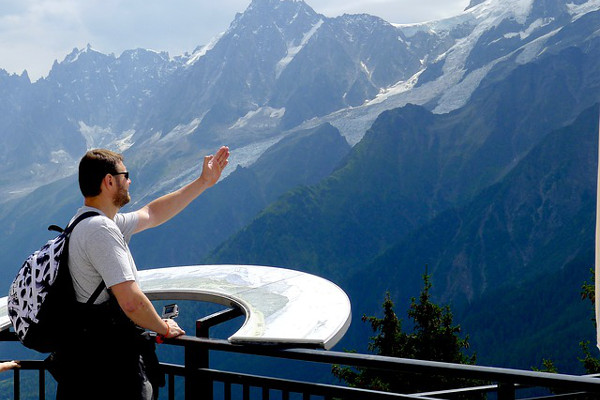
The Tour du Mont Blanc is one of the most popular treks in Europe. It covers a distance of roughly 170 kilometres and gains more than 10,000 meters of altitude over 11 stages.
In this guide we cover: what weather to expect and the best time to hike the Tour du Mont Blanc, which huts to book, what gear you might need, and much more...
Join a Tour du Mont Blanc Highlights Hike
Book with our recommended local guide
Tour du Mont Blanc
Route overview.
The Tour du Mont Blanc covers a distance of roughly 170 kilometres and gains more than 10,000 meters of altitude over 11 stages. Most people start their hike in Les Houches, France going in an anti-clockwise direction.
During this trek you will hike in the French, Italian and Swiss Alps and spend the night in mountain huts. This is one of Europe's best hikes and is a classic alpine trek. On the hike you will get splendid views of some of the highest mountains in Western Europe, as well as glaciers and alpine meadows.
The highest point reached is 2,665 meters.
The hike passes seven valleys along the way, which means there is a lot of altitude to be gained, making the Tour du Mont Blanc a physical challenge.
Fortunately, walkers are rewarded with some of the best views you can get of Mont Blanc . The route is not only one of the most beautiful long-distance treks in Europe (up there with the Walker's Haute Route ), but one of the most popular ones as well.
Nights can be spent in either mountain huts along the route or back in the valley, where you can have the luxury of a warm bed in a hotel.
What we like and dislike about the hike
- Incredible views of the Mont Blanc massif
- Hike in three countries
- Visit the beautiful villages of Chamonix and Courmayeur along the way
- Spend the night in some of Europe's most iconic mountain huts
- More expensive than other treks in Europe due to the cost of mountain huts
- Physically challenging
- Can be crowded during the summer months
Join the full Tour du Mont Blanc Hike (10-Days)
Tour du mont blanc circuit.
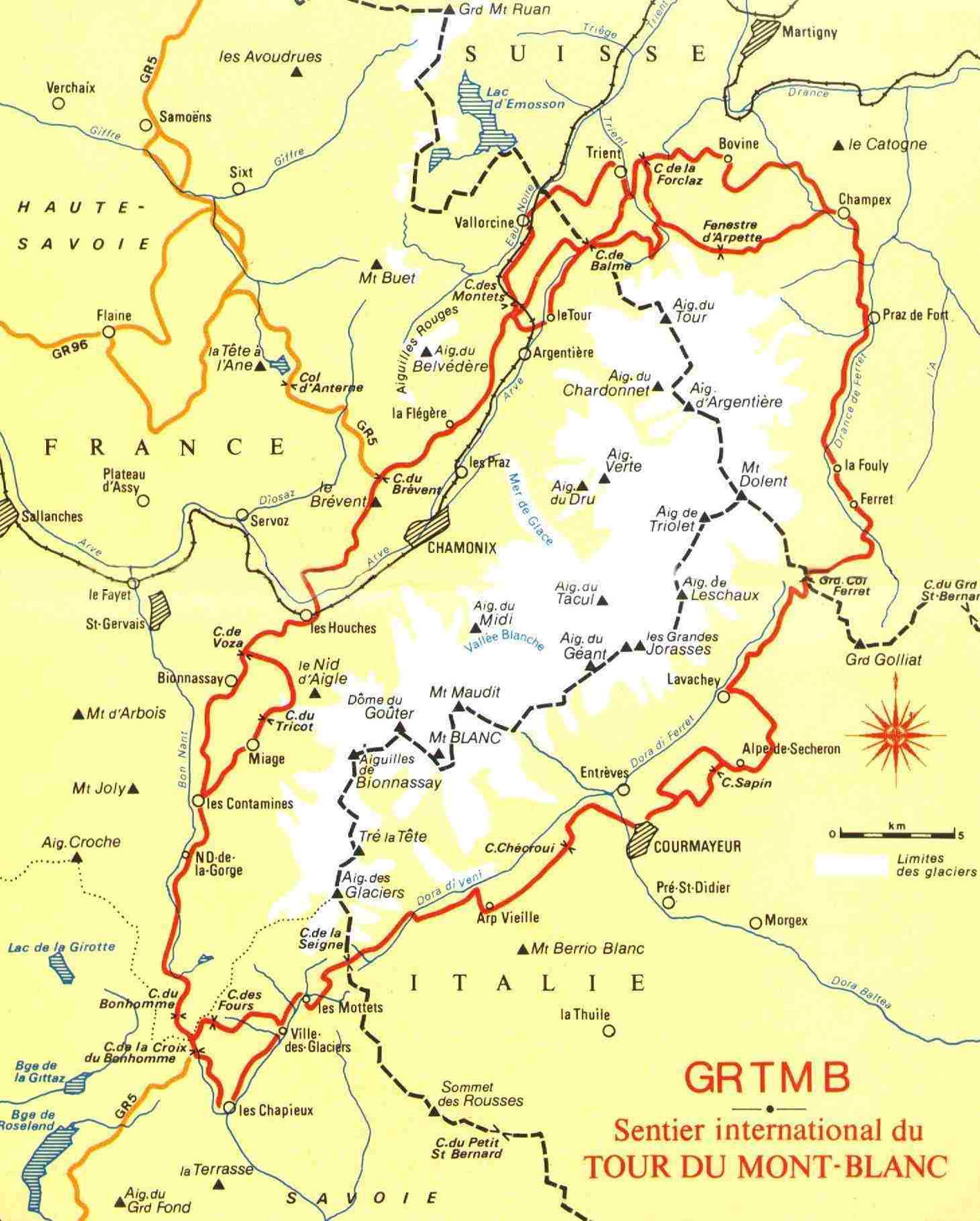
Source: chamonix.net
This map illustrates the Tour du Mont Blanc route. It starts off at Les Houches, France close to the Swiss and Italian border before heading west towards the Italian side of Mont Blanc.
There are 11 stages depending on your physical level. The route is circular around the Mont Blanc Massif, crossing the borders of France, Switzerland and Italy.
In terms of a trekking map we recommend:
- Chamonix, Mont-Blanc ~ IGN Top25 3630OT 2012 (English and French Edition)
And in terms of a trekking guide we highly recommend:
- Cicerone's The Tour du Mont Blanc: Complete two-way trekking guide
Altitude Profile
In the chart below you see the altitude profile of the full hike. It is quite clear there is a lot of altitude to be gained over the 11 stages, with the highest point reached just above 2500 meters. You can see that there are a few strenuous stages reaching high mountain passes that will require great effort.

Mont Blanc Route Itinerary
Below we have laid out the most popular version of the Tour du Mont Blanc Route – 11 days, starting and finishing in Les Houches. The itinerary includes approx. distances, hiking times and elevation changes.
Day 1: Les Houches – Les Contamines
Distance: 16 km Ascent: 646m Descent: 633m Hiking time: 5hrs
Easy first stage along, this is the most roadway you will see during the trek. The best views are to be seen at Col de Voza, where you get a look at Dome du Gouter and Aiguille de Bionnasay, with the glacier splitting it in half.
Day 2: Les Contamines – Les Chapieux
Distance: 18 km Change in elevation: 1316m+, 929m- Hiking time: 7.5hrs
A bit tougher than the first stage. Especially, since there is quite some altitude to be gained and distance covered.
Day 3: Les Chapieux – Rifugio Elisabetta
Distance: 15 km Change in elevation: 1004m+, 258m- Hiking time: 4.5hrs
This is the day you will leave France and enter Italy via Col de la Seigne. Despite being a short day, there still is some elevation to be gained as you will pass Col de la Seigne. At the highest point, you will gain some great views of both France and Italy and gaze into Val Veni. This is the first night you will spend in a mountain hut.
Day 4: Rifugio Elisabetta – Courmayeur
Distance: 18 km Change in elevation: 460m+, 1560m- Hiking time: 5hrs
Another short day, since you will mainly be descending. Still, some great views will be shared before reaching Courmayeur, the Italian equivalent of Chamonix.
Day 5: Courmayeur– Rifugio Bonatti
Distance: 12 km Change in elevation: 860m+, 101m- Hiking time: 4.5hrs
Often described as the most scenic stage of the Tour du Mont Blanc. With views on the glaciers of Planpincieux and Frebouze it’s not hard to see why. The high route along the Mont de la Saxe Crest is thought of as one of the best viewpoints of the southside of the Mont Blanc.
Day 6: Rifugio Bonatti – La Fouly
Distance: 20 km Change in elevation: 895+, 1410m- Hiking time: 6.5hrs
Today will cross another border and enter Switzerland. Cowbells and tiny villages that have been stuck in time are your scenery for the next few days.
Day 7: La Fouly - Champex
Distance: 15 km Change in elevation: 420m+, 565m- Hiking time: 4hrs
This probably is the easiest stage of the Tour du Mont Blanc since there are no cols to be conquered. This stage mainly is a valley trek with some great charming villages along the way. However impressive views of the mountains remain.
Day 8: Champex – Col de la Forclaz
Distance: 16 km Change in elevation: 742m+, 682m- Hiking time: 4.5hrs
There are two ways to reach Col de la Forclaz. A lower route via Alp Bovine, or the more scenic and higher route along the Trient Glacier. This latter passes the Fenetre d’Arpette, the highest point on the Tour du Mont Blanc, and should only be considered in good weather.
Day 9: Col de la Forclaz – Tre le Champ
Distance: 13 km Change in elevation: 1069m+, 1168m- Hiking time: 5.5hrs
From this point you re-enter France via Col de Balme. A lot of elevation is to be gained and lost, which makes the stage a strenuous one.
Day 10: Tre le Champ – Refuge Flegere
Distance: 8 km Change in elevation: 733m+, 257m- Hiking time: 3.5hrs
Short stage, but with some ascent. You will spend another night in a mountain hut. Refuge Flegere offers great views and is a perfect last night in the mountains before arriving in Les Houches the next day. There are some ladders to be climbed before reaching the refuge however.
Day 11: Refuge Flegere – Les Houches
Distance: 17 km Change in elevation: 772m+, 1546m- Hiking time: 6.5hrs
This last stage of the Tour du Mont Blanc goes along Le Brevent in the Aiguille Rouge. There are some splendid views of the Chamonix Valley before finally descending and arriving back in Les Houches.
Video Overview
A beautiful video overview, filmed with a GoPro, of the Tour du Mont Blanc by Eugenio psnt .
Join a Tour du Mont Blanc Hike
Frequently asked questions, how much does the tour du mont blanc trek cost.
The cost of the Tour du Mont Blanc trek is dependent on whether you plan to do a self-guided hike or join a planned tour. Self guided hikes cost in the region of $1500 (estimate of $50-$75 dollars a day). Most mountain huts / gites are around $50 (incl. breakfast).
Guided trekking tours can be quite expensive since not only do you pay for the guiding service, but you eat and spend most nights in hotels or mountain huts. This mostly includes a luggage transfer to your next accommodation as well, so you can hike with a small backpack. Guided tours range from $2000-$3500, depending on the company / season / size of the group.
Self guided is the cheaper option, however, it does mean you carry more weight in your backpack and some planning of logistics in the weeks / months before.
Are permits required for the Tour du Mont Blanc trek?
No permits are required for the Tour du Mont Blanc trek.
When is the best time to trek the Tour du Mont Blanc Route?
The best time to trek the Tour du Mont Blanc is between July-September, but exact start and end dates depend on the amount and timing of the previous winter’s snowfall and the onset of cold weather in the Autumn.
Since the Tour du Mont Blanc crosses high passes, snow could create problems / dangerous conditions. Therefore in a normal year it is not advisable to set out before July. In the summer months, mid-July through to end of August, are the busiest, and temperatures during the day can rise to 25 degrees. Nonetheless, thunderstorms or a dump of snow is possible as well.
By the end of September, huts will close and it might get a lot harder to complete the trek.
Is altitude sickness a risk?
No, you will cross passes slightly higher than 2500 meter and since you’re hiking slowly to this altitude, you have more than sufficient time to acclimatize. Most people don’t feel any symptoms of altitude sickness before reaching 3000-3500 meter.
How difficult is the Tour du Mont Blanc trek?
Hiking the Tour du Mont Blanc comes with great rewards. Rewards that will be more easily gathered when physically fit and mentally attuned. There are many steep and uphill sections to conquer, so exercising regularly at home before the trek is necessary to get in shape for the physical demands of this route. Mental fitness is as important and often go hand in hand.
The Tour du Mont Blanc is doable for any fit mountain walkers who are able to hike between 5h and 7h30 min per day for several days in a row.
If you are finding the trek tough there are a few sections where you can use public transport to shorten your hike.
What gear do I need?
To do a serious trek like the Tour du Mont Blanc, appropriate clothing and equipment is a must.
Some comfortable lightweight trekking boots are a must to enjoy this trek, while good waterproofs might be essential, not only to protect you against rain or snowfall but to double as wind-proofs. Since you’ll be crossing passes of more than 2500 meters, gloves and several layers will prove useful. Trekking poles are a good way to not overload your knees and ankles
To help you plan and prepare for your trek we recommend our Tour du Mont Blanc packing list .
What travel insurance do I need?
Trekking insurance is important when going into the mountains. See our article on insurance for more information.
Do I have to carry my own gear all the way?
It’s up to you. There are many organisations offering guided trips for this hike, meaning they do all the logistics for you. This often includes a luggage transfer to your next accommodation in the valley, so you only need to carry a small backpack with some lunch, snacks and clothes.
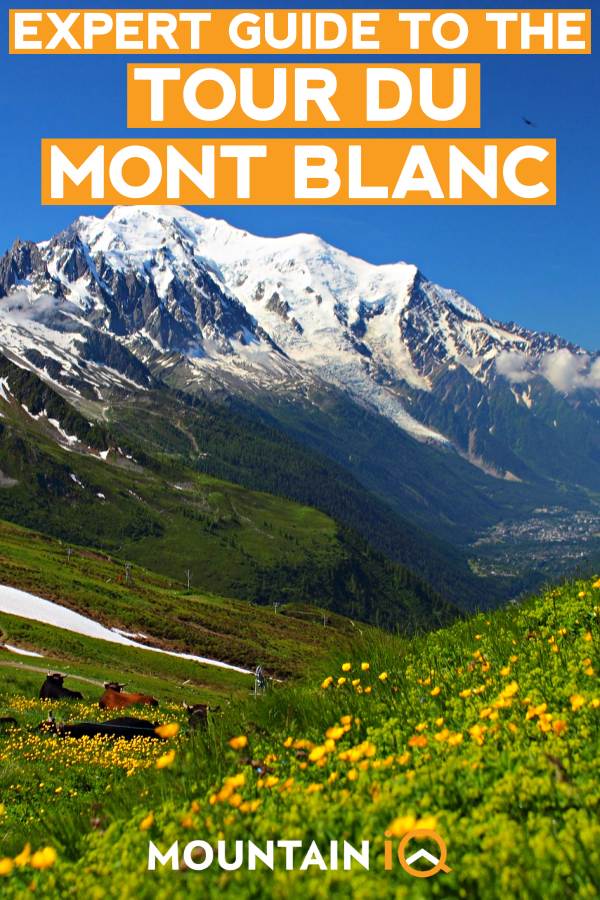
Browse more hikes in Europe
See our top European hikes picks, or check out these popular hikes.
- Tour de Monte Rosa
- Walkers Haute Route
- Camino de Santiago Routes
- Cinque Terre Hiking
- West Highland Way Hike
- El Caminito del Rey
- Laugavegur Trail
- Kungsleden Trail
- Rota Vicentina
- Slovenian Mountain Trail
About the author
Mark Whitman
Mark has trekked extensively in Asia, Europe, South America and Africa. He founded Mountain IQ in 2014 with the sole aim to be the best online information portal to some of the most popular mountain destinations around the world. When not writing for Mountain IQ, Mark is out exploring the outdoors with his wife!
Leave a Reply
Your email address will not be published. Required fields are marked
Hi Dempsey,
I’ve been thinking about doing that hiking for a long time and I think, after this pandemic crisis, it’s the time to see my dream coming true. I hope to do it as soon as possible, and to see it how beautiful the nature around is. Stay safe,
João Leite.
Wife and I are interested in doing this in last half of August. I know it is (too) late to reserve now. We plan to show up and hope for the best, perhaps taking advantage of late cancellations on a guided/luggage transfer arrangement. Any advice?
Hi Mike, there are a few dates available on this TMB highlights tour, which is amazing if you’re looking for a short circuit: https://www.skyhookadventure.com/trips/tour-du-mont-blanc-highlights
We work with local guides to offer great value adventures at unbeatable prices

Well and Good Travel

The Foolproof Tour du Mont Blanc Itinerary: 10-Days
10 days of hiking in the Alps – the ULTIMATE wellness trip if you ask me. This Tour du Mont Blanc self-guided itinerary follows the traditional TMB route, includes tips, daily trail specs, and accommodation suggestions, and addresses some of the most common questions you might be asking yourself as you begin planning your tour.
The Tour du Mont Blanc, or the TMB, is a 105-mile (170 km) trail that circumnavigates Mont Blanc, the highest peak in Europe. The TMB is often considered one of the most beautiful through-hikes in the world, introducing hikers from around the globe to the exquisite and dramatic scenery of the Alps.
👉 Don’t forget travel insurance for this trip! I always use SafetyWing !
Want to save yourself a lot of planning time? Check out Skyhook Adventures’ 10-day guided trek if you want all of your accommodations, food, and transportation taken care of!
Tour du Mont Blanc Itinerary 10 Days

This itinerary does not include, but I recommend, staying in Chamonix for a couple of days before and after your tour, first to acclimate and then to relax.
The TMB is broken up into “stages”. Traditionally, there are 11 stages but depending on how many days you want to trek you can find different versions of the stages.
During your planning, and your trekking, take all distance, time, and elevation markers or estimations with a grain of salt. Mileage on GPS and in guidebooks and blogs rarely match up, and there are a lot of variables that affect the accuracy of the time estimations. The trail markers seem to allot 30 minutes for every mile, but depending on your age, the weather, and what shape you’re in, that will be different for every person. For your own sake, just always assume you’ll have an additional mile or 30 minutes 🙂

Tour du Mont Blanc Trek Specs:
- Distance: 105 miles / 170 kilometers
- Route Type: Loop
- Starting Point: Les Houches (traditionally)
- Direction: Counter-clockwise (although it can also be hiked clockwise)
- Total Elevation Gain/Loss: 33,632ft / 10,251 m
- Maximum Altitude: 8,500 ft / 2600 m
- Days To Hike: 7-12 days
- Countries: France, Italy, Switzerland
- Difficulty: Difficult (never flat, always up or down)
Tour du Mont Blanc Itinerary Disclaimers:
- Most stages have alternative route options, or “variants”, as they are called. This itinerary follows the traditional TMB route, except for day 10. Refer to the recommended guidebooks for variant options.
- Some stages have options to use public transport and lifts/gondolas to accelerate and shorten the path. This itinerary discloses any shortcuts by calling out *SHORTCUT*.
- There are many mountain huts/refuges along the TMB to choose from. This allows for total personalization of your trek. The huts recommended in this 10-day Tour du Mont Blanc itinerary are huts that I stayed in and will provide my honest opinion about.
Day 1: Les Houches to Les Contamines

Do not get off at the first stop in Les Houches – stay on until you see the Office de Tourismo (on your left). Here you will see the TMB starting point arch. Take a photo and walk onward for about 10 minutes until you see the “Telecabine Bellevue”. *SHORTCUT* This will cut off a 2600 ft / 800 m climb through the forest. Begin your trek at the top of this cable car.
You’ll pass through many towns and villages today, and you won’t feel very “out there”. The signage is decent, just make sure you pay attention and don’t pass any turnoffs. Use the guidebooks and GPS for support.
✔ Mileage: 9 miles / 14.5 km (if you take the cable car, 11 if you don’t)
⛰️ Elevation Gain: ~ 1000 ft / 300 m (if you take the cable car, 3550 ft if you don’t)
✔ Estimated hiking time: 5 hours (with cable car)
💤 Where to stay: Gai Soleil

Gai Soleil is a quaint and quiet hotel just off the main road in Les Contamines. There is a lovely yard to relax in after hiking all day. The rooms are basic but very comfortable with amazing views. Breakfast was great and there is wifi. I would recommend staying here.
Day 2: Les Contamines to Les Chapieux
💪 This is one of the most challenging days of this 10-day tour du mont blanc itinerary.

Today you will climb over two Cols (mountain passes). You will see fewer towns and be pleasantly surprised by the beauty that is everywhere. Be prepared for lots of elevation gain and possible weather. It can get very cold (and wet!) at the top of the cols.
When you begin to descend from the second col, you’ll pass Croix du Bonhomme – a refuge. Stop here for hot chocolate or coffee but DO NOT stay here (outhouses, flies, no showers, etc).
BONUS: Look out and listen for lots of Marmots as you descend from Croix du Bonhomme!
✔ Mileage: 14 miles / 22.5 km
⛰️ Elevation Gain: 4500 ft /3000 ft down
✔ Estimated hiking time: 7 hours
💤 Where to stay: Auberge de la Nova
You will see the Auberge immediately as you descend into Les Chapieux (there isn’t much else here!). Try to get a private room if you can – unless you are fully comfortable sleeping in dorms. The dinner was one of the best dinners of the trek! Hot showers but no wifi or service.
ALSO READ: Tour du Mont Blanc Packing List 🥾 👚 👖 🧳
Day 3: Les Chapieux to Rifugio Cabane du Combal
🌀 One of the most beautiful days of the trek!

Today you will get your first view of Mont Blanc from the trail and cross over into Italy via Col de la Seigne. To begin, take a bus from Les Chapieux to Les Mottets (NOT Ville des Glaciers). *SHORTCUT* This will cut about an hour and a half of walking on a skinny paved road which made sense to us (and most others).
There is a small wooden information center in Les Chapieux, just outside Auberge de la Nova. You can buy bus tickets here – try and buy them the night before in order to get the first bus, otherwise, you may have to wait until the 9 am bus (or just walk).
BONUS: When you get to Cabane du Combal, continue on another 10 minutes to see Lac Miage and the adjacent moraine – you’ll see the signs outside the rifugio. If you sit and listen at the top, you’ll hear small rockslides happen every few minutes as a result of the melting glacier.
The All Trails map linked below maps you to Rifugio Elisabetta. A lot of people like to stay here but I saw the sleeping area and would highly recommend continuing on to Cabane du Combal. It’s another 30 minutes and 1.5 miles on FLAT gravel road. Definitely stop at Elisabetta for a cappuccino though. You’ll have to climb up their long and steep driveway but it is worth it!

✔ Mileage: 10 miles / 16 km
⛰️ Elevation Gain: 3400 ft / 1036 m
✔ Estimated hiking time: 5.5 hours
💤 Where to stay: Cabane du Combal

Cabane du Combal is a very sweet rifugio with large, clean rooms and the dinner was really very good. They tend to get herds of ibex hanging around (hence their logo), so be on the lookout! We saw several here 🙂 Lastly, there is no wifi or service here.
ALSO READ: Tour du Mont Blanc Refuges: Everything You Need to Know
Day 4: Cabane du Combal to Rifugio Maison Vieille
🌀 One of the most beautiful days of this tour du mont blanc itinerary!

This was one of my absolute favorite days. It was a short day but SO beautiful. On several days you trek through villages and towns, but this day you are just in the mountains the entire time. You’ll be walking at eye level with glaciers and alongside grazing sheep and cows. Take your time and admire the beauty in every direction.
ALTERNATIVE ITINERARY: As much as we loved Maison Vielle, I recommend continuing past Rifugio Maison Vielle and booking a hotel in Courmayeur. Courmayeur is the largest town you will go through and a great opportunity to stay somewhere nicer, and it will balance out the distances on days 4 and 5. The Alltrails map below goes to Courmayeur.
✔ Mileage: 6 miles / 9.6 km (to Maison Vieille)
⛰️ Elevation Gain: 1900 ft / 600 m
✔ Estimated hiking time: 3 – 4 hours
💤 Where to stay: Rifugio Maison Vieille

As I mentioned, I would continue on to Courmayeur. However, if you choose to stay at Maison Vieille you can spend the afternoon lounging in lawn chairs and sipping on cold beers. This is a popular lunch stop for day hikers so it’s very busy and fun. They only have dorms – no private rooms, FYI. But, they do have wifi.
Day 5: Rifugio Maison Vieille to Rifugio Walter Bonatti

Maison Vieille is situated at the top of a ski lift. When you depart on day 5 you can either sleep in and wait for the ski lift to open at 9 am to take you down to Dolonne or you can walk down the very steep descent which will take you about 2 hours. * This is another reason to stay in Courmayeur because you can take the ski lift down in the afternoon the day before.
*SHORTCUT* We chose to save our knees and took the ski lift as soon as it opened. You have to take a Gondola following the lift which drops you in Dolonne. You’ll walk about 10 minutes to Courmayeur. Build in some time to walk around and get some coffee if you can because it’s very cute here.
Next, begin your ascent through a paved neighborhood and then into a popular wooded hiking area. Stop at the top at Rifugio Bertone for a snack and beverage and then continue on. Today is another day of hiking eye to eye with massive glaciers… in fact, you’ll be sleeping directly across from one at Rifugio Bonatti!
✔ Mileage: 9 miles / 14.5 km (from Maison Vieille)
⛰️ Elevation Gain: 3600 ft / 1100 m
✔ Estimated hiking time: 6 hours
💤 Where to stay: Rifugio Walter Bonatti

Rifugio Bonatti is situated directly across from a massive glacier – it is an unbelievable location. The rifugio is a little newer and offers dorms and private rooms that are quite comfortable and clean. The dinner was pretty good. You have to get a coin for the shower and only get 4 minutes. There is no wifi, but some service. Although, if you ask nicely the staff might share the wifi password.
Day 6: Rifugio Walter Bonatti to La Fouly

On day 6 of this Tour du Mont Blanc itinerary, you’ll cross over into Switzerland. This is an absolutely stunning day of hiking, especially the climb to Grand Col Ferret (tough!). Prepare to see lots of rolling green hills, glaciers, cows, and sheep.
⛰️ Elevation Gain: 3200 ft. / 975 m
⏳ Estimated hiking time: 7 hours
💤 Where to stay: Auberge des Glaciers

This Auberge is right in the center of town – as soon as you enter La Fouly you will see it. The rooms were cute (private) and the showers were hot! Dinner was delicious but it was an expensive auberge/refuge. Conveniently, there is a market right next door if you need to stock up on snacks.
Day 7: La Fouly to Champex

Day 7 is one of the easier days of this Tour du Mont Blanc itinerary. You will be in the forest most of the time. Look for wooden animal carvings along the whole trail. This day was very rainy for us – several people ended up taking the bus from La Fouly to Champex to avoid hiking in the rain. We were soaked by the time we got to La Fouly but ultimately we were glad we didn’t take the bus. You’ll pass through some really interesting and tiny Swiss towns today – not the most exciting day though.
✔ Mileage: 9 miles / 14.5 km
⛰️ Elevation Gain: 2000 ft. / 609 m
✔ Estimated hiking time: 4.5 hours
💤 Where to stay: Hotel Splendide

I had originally booked Hotel Belvedere, but when we arrived I was informed I accidentally booked it for the night before. They didn’t have room for us the night we needed it but it ended up being a BLESSING IN DISGUISE. Belvedere was very dark and dingy and the husband of the husband-wife combo was RUDE. We went next door to Hotel Splendide which happened to have a cancellation. It was such a treat to stay there. The rooms are sweet and gorgeous – amazing views and breakfast!!
Day 8: Champex to Trient

This day was challenging for us, mentally. Not incredibly tough but it felt very long. This was the easiest stage to get lost, in my opinion. When you leave Champex Lac, stay on the main road through town, following the TMB signs. If you turn off the road too soon you’ll find yourself in a maze of trails and the GPS is unreliable here. You’ll see a large boulder with “bovine TMB” painted on it. This is where you turn off.
When you reach Trient, continue on another km (15 minutes) to reach Le Peuty – it’s on the map.
BONUS: If you do the main route and not a variant, you’ll pass by Alp Bovine, a small unassuming rustic restaurant in the hills. The homemade tarts are AMAZING. The views and atmosphere are warm and authentic. A must-stop.
✔ Mileage: 12.5 miles / 20 km
⛰️ Elevation Gain: 2800 ft. / 853 m
💤 Where to stay: Le Peuty

I booked Le Peuty on a whim because it looked unique and fun and wow am I so glad I did. This was one of, if not the top place of all the places we stayed in this tour du mont blanc itinerary. The atmosphere and vibes here are unbeatable. There is a dorm above the kitchen, a huge field for camping, and one private yurt. I booked early enough that I was able to get the yurt and it was awesome. The BEST part of our stay though was hands down the food. Dinner was cooked fresh from scratch and could have come from a multi-star restaurant. Breakfast was equally as delicious. Best food and best vibes of the trip.
Day 9: Trient to Tre le Champ

This was one of our favorite days of the TMB. Our bodies felt conditioned to the daily grind and the weather and views were gorgeous. You’ll return to France today, via Col du Balme. It’s a steep ascent to the top so stop at the top for a coffee or beer (and photos!). As you reach the top you regain an unobstructed view of Mont Blanc and it remains in site the rest of the trek.
✔ Mileage: 10.5 miles / 17 km
⛰️ Elevation Gain: 3400 ft. / 1036 m
💤 Where to stay: Auberge la Boerne

The location of this Auberge is great, it’s very cute and rustic, unique, and has a very cool history. However, the dorm we stayed in was literally the size of a closet (not joking see pictures). It was fine – just funny. The dinner was also not very good – maybe the worst of the whole trip. All part of the experience though! I’d probably choose to stay here again versus hiking down into Argentiere if that’s any consolation.
Day 10: Tre le Champ to Chamonix

The final stretch! Today you will go through the “ladder section” which you will hear about during your TMB planning. It is a little nerve-wracking, but totally doable so don’t be deterred. If you have an intense fear of heights, you can avoid the ladders by doing the Col Des Montets variant.
We decided to take our first variant today and go to Lac Blanc. It adds on another hour or so and a bit of elevation gain but the views are worth it in my opinion. And the hike out of Lac Blanc is very cool and different from much of the rest of the path.
When you reach the ski lift, take it down to La Flegere, then continue on the TMB path to the Plan Praz gondola. This will drop you in Chamonix! Below is the trail map to La Flegere. If you want to do the Lac Blanc variant, just follow the signs once you get to the top of the ladder section.
There are a number of options to descend into the Chamonix valley (i.e. at La Flegere, Plan Praz, or further along) so decide what is best for you. We felt strong when we reached La Felgere so we decided to continue to Plan Praz. You do NOT need to buy lift cable car tickets ahead of time. However, make sure you get there before they close (5 pm).

✔ Mileage: 11.5 miles / 18.5 km
⛰️ Elevation Gain: 3200 ft. / 990 m
💤 Where to stay: Grand Hotel des Alpes

Treat yourself! Stay at the Grand Hotel des Alpes , in the center of Chamonix. They have an amazing spa with a gorgeous sauna and hot tub area (this was the major selling point for me). The rooms are stunning and the beds are amazing just stay here!!
Tour du Mont Blanc Itinerary Planning Resources
Blog posts, facebook groups, the official TMB website, GPS and weather apps, and guidebooks are all of the resources you will need to plan and hike your tour du mont blanc itinerary.
This Facebook group is very active and super helpful. People share their experiences, share all sorts of tips, and provide a decently accurate picture of what the current conditions and situation is on the trail.
I carried Jim Manthorpe’s Tour du Mont Blanc guidebook (2nd edition) with me and while it is not always 100% accurate, the detailed maps and elevation and distance charts were really helpful. He also covers all of the different variants available to you.

The official TMB website is a somewhat helpful planning resource. It is also the only way to book some of the refuges so if you plan on staying in mountain huts you will need to utilize this site.
Meteoblue is a helpful weather app to have – again, not always accurate of course but it’s more detailed than weather.com.
Tour du Mont Blanc Alltrails
While not always accurate, alltrails was the best GPS app for us. There are a number of route options that are downloadable. This way, if you don’t have service (which you won’t) you can still use the map. Alltrails has all of the traditional stages mapped out, as well as variants, alternative stages, and the entire loop even.
You will need to create an AllTrails account. Search for your desired stage, crosscheck it with guidebooks to make sure it’s accurate, and then download it. While you are hiking you will be able to go into the app and click on the respective stage and the app’s GPS will follow along the route.
FAQs About the Tour du Mont Blanc Hike
If you are just getting started with your TMB planning, I’m sure you have a LOT of questions. Don’t worry, everything will start to make sense and come together. It seems more daunting than it actually is. Hopefully, this FAQ gets you off to a good start!
What is the best time to hike the Tour du Mont Blanc?
August. I hiked this tour du mont blanc itinerary August 13th-22th and it rained two of those days. Earlier August you may see less rain, but I think generally anytime in August is a great time to hike the TMB. It was in the 80s in Chamonix, but higher up on the trail it was perfect hiking weather (60s and 70s).
If you go in June, you may encounter remnants of winter, in July it may be scorching hot, and in September it could snow. That being said, the trail will be busy June through September.

How much water should I carry on the TMB?
At least two liters. Although, you may need three liters during the hottest months or if you are planning on hiking longer distances than most people each day.
I carried two 1 liter Nalgene’s (I am not a fan of camelbacks) and never ran out of water. There are several water troughs along the route to refill if you are running low, although I recommend that you never begin the day with less than two liters just in case.
There are some occasions, particularly towards the end of summer, when the water is not flowing in all of the troughs along the trail. That being said, we found at least one water refill trough at every stage – and usually several.
How far in advance should I plan my Tour du Mont Blanc Itinerary?
Approximately, 6 to 10 months. If you plan on staying in refuges/mountain huts along the trail, you’ll need to book them well in advance. I booked all of our accommodations about 7 months ahead of our trip. If you plan on camping you have some more freedom to start your planning later.

Do I have to start the TMB in Les Houches, Chamonix?
No, absolutely not! Les Houches is the “official” starting point, and made the most sense for us because we wanted to spend time in Chamonix before and after our trek. However, there are several other starting points – pretty much any main town along the path can be a starting point. The only other starting point I would consider, personally, is Courmayeur.
How do I book the refuges?
The refuges, also called mountain huts, rifugios, and auberges, depending on what country you’re in, can be somewhat challenging to reserve. They need to be booked early if you want a guaranteed spot, and they all have different booking processes. For more information on how to book the refuges, refer to my post Refuges: Everything You Need to Know .
What gear do I need for the TMB?
See my Tour du Mont Blanc Packing List .
What To Expect on The Trail
- A variety of weather! Make sure you pack for every condition.
- Wildlife! Specifically, marmots, ibex, chamois, vultures, deer, sheep, cows, and goats.
- Crowds. The TMB is one of the most famous treks in the world, you are going to be hiking with a lot of people. There are days when you may not see many people, but most days you will see a lot. One positive is that it makes the trek feel very safe and is a great option for solo female hikers.
- Wild berries! You will find wild blueberries along much of the route, and occasionally some wild raspberries.
- Water refill stations. As I mentioned earlier, there are several water refill troughs along each leg of the hike. Make sure to always pack enough water for the day in case they are dry. Check Facebook groups to know the status of the water before you go.

Wrap-Up: Tour du Mont Blanc Itinerary 10 Days
So, if you are on the fence about hiking the TMB, let me just give you a little push. Allow yourself to breathe in the freshest of air, to gravel at the massive glaciers all around you, to sleep in places so remote that the stars seem brighter and more abundant than any place you’ve ever been. Give yourself a screen break, clear your head, and meet amazing people from around the world. Eat fresh homemade food every day, and drink untouched mountain spring water.
Use this Tour du Mont Blanc itinerary as a starting point – take what works for you and customize the rest to your needs.
Jade Gershen is the founder of Well and Good Travel. She has lived on three continents and explored more than 20 countries in the past 10 years. U.S. based, she also shares her favorite places to go and things to do in the States. Having experienced the impacts of chronic stress Jade has a particular interest in using travel and outdoor adventure to improve well-being and shares that with her readers.

Hiking the Tour du Mont Blanc: An Overview Guide
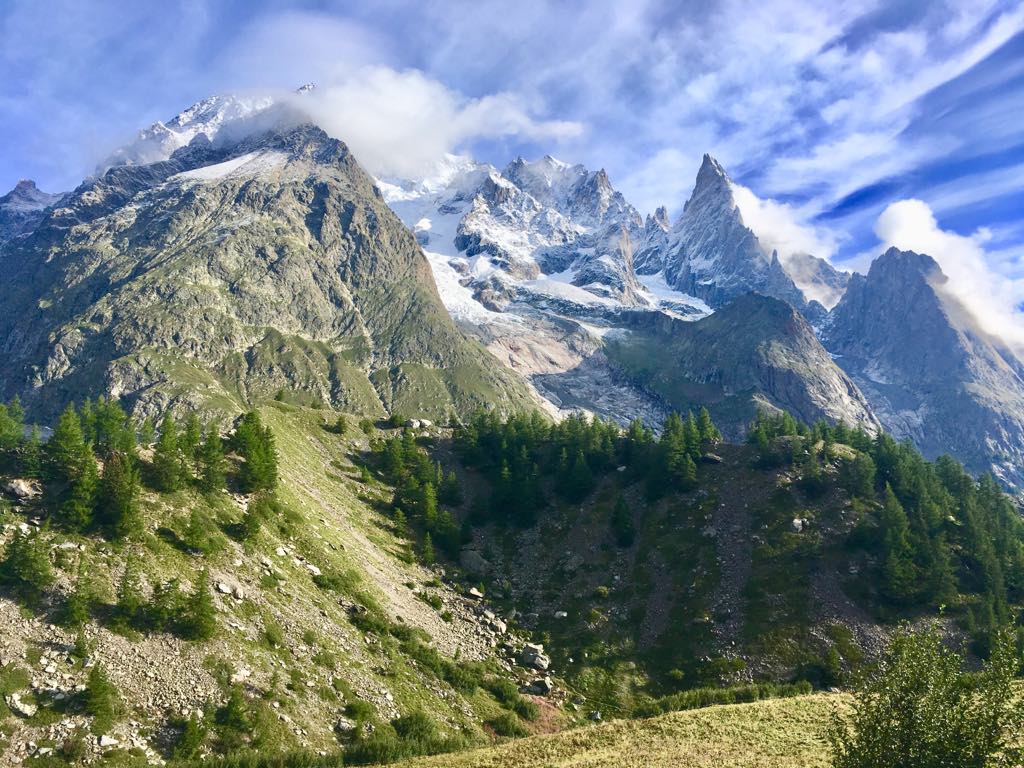
Top tips and recommendations to hiking the Tour du Mont Blanc
[Updated April 2020]
This post contains affiliate links for which Expedition Wildlife may receive a commission (where applicable) at no additional cost to you.
Tour du Mont Blanc Statistics
Distance Total: 105 miles (170 kilometers).
Total Elevation Gain : 8,900 meters (29,200 feet).
Total Elevation Loss : 9,100 meters (29,855 feet).
Duration : 11 days .
Physical Difficulty Level : High – the consistent elevation gain and loss requires hikers to be in good physical shape prior to the trek.
Mental Difficulty Level : Low – well-marked trails, ample food and lodging availability, and lack of isolation on the trail give hikers a better peace of mind.
Gear Necessity : Good hiking shoes and trekking poles will be your most cherished pieces of gear on the TMB. Acquire sturdy layers, especially a high quality rain coat and rain pants.
Recommended Guides: Cicerone’s T rekking the Tour of Mont Blanc by Kev Reynolds is an essential, step-by-step guide to the trail. *This is our recommended guide to take with you on the trail!!*
The Tour du Mont Blanc website , montourdumontblanc.com has information about all of the refuges and their contact information and availability. The Tour du Mont Blanc Facebook page is a great place to ask others about their experiences and recommendations for the trail as well as keep up with trail conditions and news as you prepare for your journey around Mont Blanc.
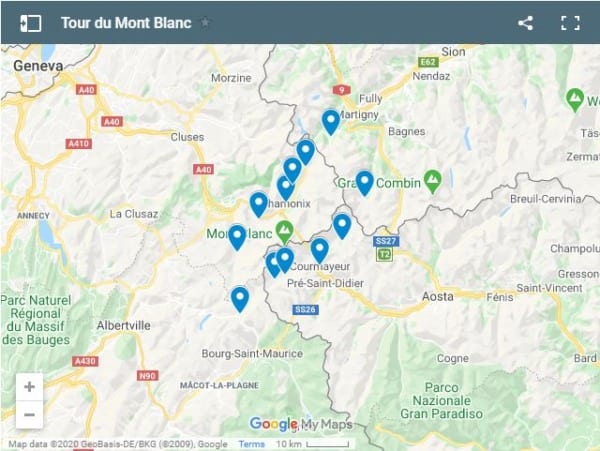
Click the Google Maps image to see all the stages listed on this trek.
About Mont Blanc and the Tour
About the tmb: a quick look.
The Tour du Mont Blanc (aka the “TMB”) traverses the alpine environment surrounding the stunning and imposing Mont Blanc. It leads through three countries: France, Italy, and Switzerland.
This famous trek has been listed as one of the top long-distance treks in the world time and time again, and for good reason.
The elevation gain and loss are what make this trek more challenging, but overall the path is well-worn, well-marked, and wide enough that serious safety issues largely aren’t a concern.
Distinctive yellow diamonds with “TMB” inscribed in the center and red-and-white blaze marks are your hiking route markers. Note that some of these markers look like street signs, with a red and white blaze, and a direction towards a specific location. Because of this, knowing the main points along your hiking route will come in handy throughout the day.
You’ll walk through sweet towns, into remote mountain passes, through cow and sheep paddocks, along beautiful streams, and so much more. If you love hiking, this is definitely a trek for you!
About the Mont Blanc: A Quick Look
Mont Blanc is the symbol of the Alps, stretching high above the valley and imposing over everything in its wake.
The Mont Blanc, meaning “white mountain” after its year-round white peaks and glaciers, stands at 15,771 feet (4,807 meters) and is the tallest mountain in the Alps and Europe , outside of those found in Russia. Quite literally during this trek, you will ascend and descend the equivalent of about 8 mountains , so the elevation gain and loss throughout the trek is no joke!
The Mont Blanc had been circumnavigated through its adjoining valleys and mountains by people for centuries. It wasn’t until 1786 that two men, Jacques Balmat and Dr. Michel Paccard, summited the beast.
While you won’t summit the Mont Blanc on this trek (summiting is for those with mountaineering experience, a permit, and (usually) a guide), you’ll certainly experience everything this beautiful region and its people have to offer.
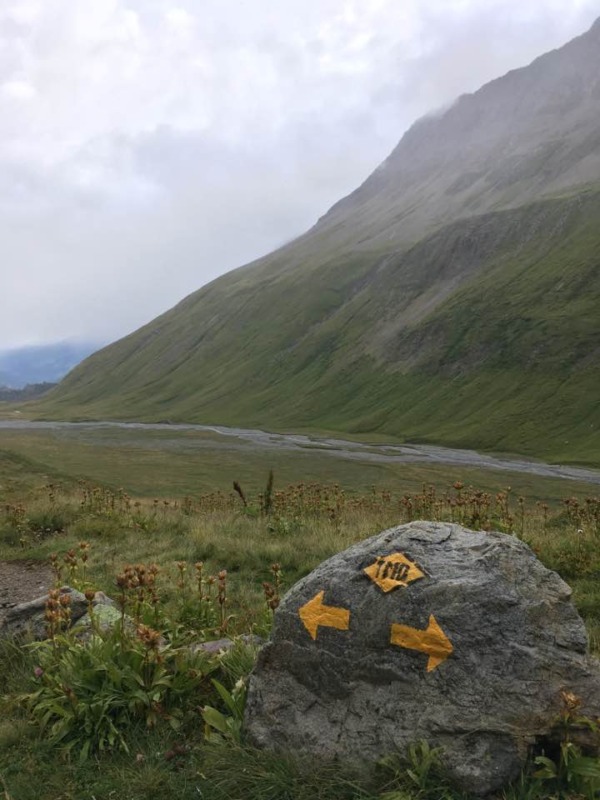
Follow the yellow diamonds labeled “TMB” for “Tour du Mont Blanc,” or the red-and-white blaze paint, as your route throughout the duration of the trek. Photo by Christa Rolls
Hiking the Tour du Mont Blanc: An Overview
The Tour du Mont Blanc was a shock to my system after hiking the wilderness trails of Washington State.
This is a hut-to-hut hike
Most people “hut-hike,” or hike from hut (or hotel) to hut. Tent camping is limited along most sections of the TMB, including in the Vallee de l’Arve, the Vallee des Galciers, and in the Swiss and Italian valleys along the route.
The TMB is very popular
The trail will be busy – and I mean BUSY, especially in summertime. If you’re looking for more solitude, you won’t find wilderness or alone-time here. However, the experiences with your fellow hikers and the sights you will see make this a once-in-a-lifetime experience.
Directionality matters
The most common direction of travel is counterclockwise . This affords hikers the best views of the surrounding valleys as you come over the handful of passes from the west. However, it is, of course, possible to hike clockwise and go against the flow of traffic.
Chamonix is the popular starting point
Most people use Chamonix as their home base. It is a resort and mountain-side town famous for its association with the Mont Blanc.
The tramway that takes visitors halfway up the mountain to the Nid D’Aigle for the Mont Blanc views is popular among day visitors. The Tour du Mont Blanc trail itself, however, officially starts in Les Houches, a quick bus ride outside of Chamonix.
Weather can change quickly in the mountains
If the weather looks bad, DON’T opt for the high routes along the trail, such as through the Col de Tricot to Refuge de Miage.
Of course, if you choose to stay at this refuge and others along high routes, this will prove more difficult to avoid. The route is very exposed and can be dangerous in inclement weather.
On the first day, we ended up taking the low route through Bionnassay because thunder and lightning shrouded the mountains the entire day of our hike. Don’t worry, you’ll still have a beautiful hike on the low routes!
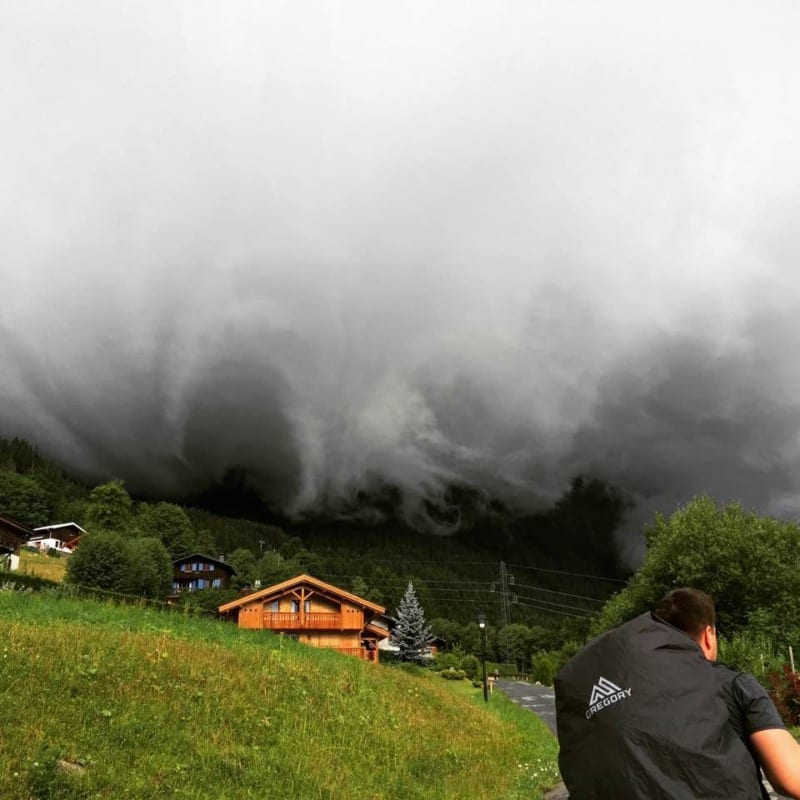
Dark thunderclouds shroud the mountains over Les Houches on day one of our trek. Photo by Christa Rolls
When to Go/Best Season to Hike the TMB
Late June to Late September i s the typical time frame for hiking the TMB . This is entirely dependent on snow leftover from the previous season and winter weather that comes into the mountains in the autumn.
The high season is July and August, largely because of the more reliable weather and because this is the prime vacation period for most European countries.
The weather is very unpredictable in the mountains and can change extremely quickly. Keep this in mind as you plan your trip.
The Refuges, gites, and hotels will begin to open in June and will remain stocked and open in September. If snowy weather comes in early, it is possible for accommodations to close their doors early. A lot of these places require mules or helicopters to re-stock, or driving along winding mountain roads, hence why they might close earlier in inclement weather.
Avoid Ultra-Trail Season, if possible
The end of August is the ultra-marathon race around the TMB (the Ultra-Trail du Mont Blanc).
I recommend avoiding traveling during this time (unless you plan to do the Ultra, of course!). Otherwise, book your accommodation ahead of time, yield to runners, and prepare for things to be busy.
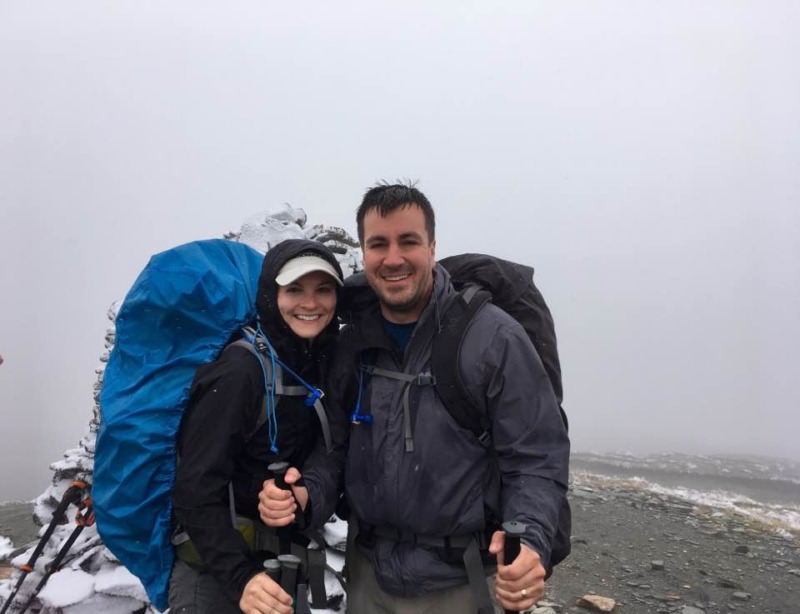
Even at the beginning of August, we experienced snow and cold, windy weather on the Col de la Seigne high pass. Photo by Christa Rolls
Cost of hiking the Tour du Mont Blanc
Plan for around 1000 Euro for the whole trek , including half-board accommodation (which includes a bed, breakfast, and dinner) and lunch options and snacks.
Upscale accommodation and luggage transfers cost more
You’ll pay about 500 Euro extra for more upscale accommodations, or private rooms, and luggage transfers.
Yes, LUGGAGE TRANSFERS. It might cost quite a bit extra to get, but you’ll save a TON on weight carried. Remember all those mountains I said you would have to climb up and down?
Luggage transfers are possible only to other towns that have a connecting road, so there may be a night that you wouldn’t have your bag with you. In this case, you’ll want a decent sized day pack (around 30L or so) to hold your lunches/snacks, water, toiletries, and an extra change of clothes along with your layers and sheet liner.
There are a number of options for luggage transfers along the trail – Mont Blanc Treks , Taxi Mont Blanc , and AlpenWild are just a few of the options.
Added costs at refuges
Contact your on-trail accommodations to see whether you are required to bring your own linens and towel. Some will provide these to you at extra cost, and others you must provide for yourself.
In the event that you need to provide them for yourself, purchase a travel sheet liner and a lightweight, packable travel towel .
We didn’t experience issues with bed bugs, but note that the blankets provided in refuges and gites aren’t washed between uses. This is why you would need the cover sheet.
Money on the trail
You will switch from Euro to Swiss Francs (CHF) along the trail. Swiss accommodations will usually accept Euro, but if you change out for CHF ahead of time you’ll be guaranteed a better rate.
When you contact the refuges for your reservation, ask them ahead of time if they accept credit card. Many locations outside of main cities do not accept them. People have also noted that the Swiss territory, in comparison to the French and Italian sides, are comparatively more expensive.
Banks and ATMs can be found in Chamonix, Les Houches, Les Contamines, Courmayeur, and La Fouly.
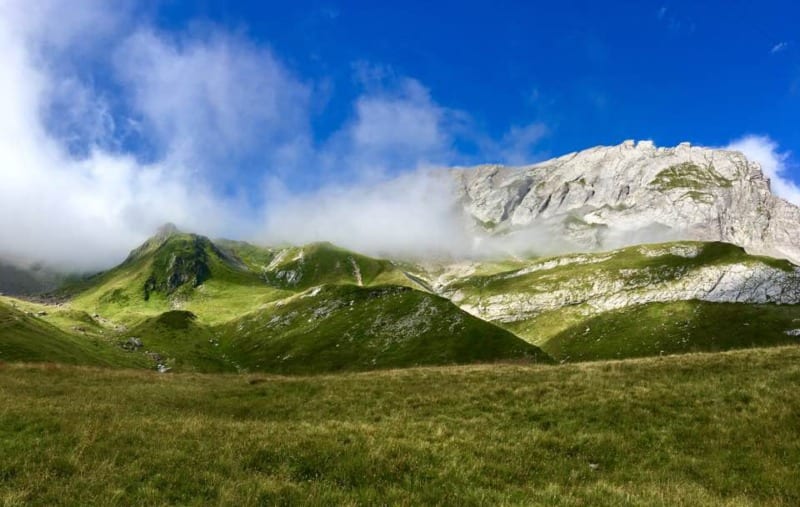
The mountains and surrounding scenery is stunning at every turn along the Tour du Mont Blanc. This is the view walking up the Bon Nant Torr. Photo by Christa Rolls
Getting to Chamonix
Again, Chamonix is the primary location where people stay to prepare for the Tour du Mont Blanc trek. The trailhead, however, starts in Les Houches, so select which town you prefer. Chamonix is busier, but also has more shopping and other sights.
We flew into Geneva (the closest, large airport) and took a FlixBus to Chamonix. FlixBus actually ended up being an easy and inexpensive way to get to the trail, for around 30 Euro round trip. OUIbus , SwissTours , and EuroLines buses will also make the trip from Geneva to Chamonix-Mont Blanc. The main bus station drops you off in the middle of Chamonix, about two blocks from the centralized, pedestrian walk of the town.
Use a Rideshare
If the timing lines up with your flight arrival, you can also look into using BlaBlaCar , a ride-share app where locals will charge a reasonable fare for a spot in their car to a pre-specified end-destination. BlaBlaCar is a good option if you arrive at an odd time in the day, especially later, when the bus tickets are substantially more expensive.
Take the Train
The regional TER and TGV trains connect from main cities to Saint Gervaid-le Fayet. From here, you can hop on a local SNCF train, specifically the Mont Blanc Express, that goes to multiple villages in the area, including Saint Gervais-le Fayet to Martigny, Les Houches, Chamonix, Argentiere, and Vallorcine. Keep in mind, however, that trains have the potential to be affected by any government shut-downs, as well as funding and personnel staffing issues.
Want more epic hiking destinations? Check out our post on other long distance hikes, such as the GR 20!
Staying near and Getting to the TMB Trailhead
Staying in chamonix.
Our favorite place to stay in Chamonix-Mont-Blanc is the Chalet Hotel le Prieure – Chamonix .
If you book ahead of time, you can get insanely good deals on their recently updated rooms. Inquire about getting a mountain view room, for STUNNING views of the mountains at sunset!!
The rooms are spacious, clean, comfortable, and have a balcony. The location is such that you won’t be right in the middle of the loud pedestrian walk.
They also offer luggage storage for a reasonable cost of 5 Euro per day if you want to leave one of your big pieces behind during your trek. This is what we did, as Nathan brought his camera gear for the second leg of our trip to Spain, but he didn’t want to hike with all of it.
The Carte d’Hote, or Guest Card
Your accommodation in Chamonix should provide you with a Carte d’Hote , or Guest Card, upon your arrival.
With this, you’ll have access to free services, including the buses that transport visitors around the Chamonix Valley (including to Les Houches!) and train travel between Servoz and Vallorcine.
You really won’t need this if you are just in town to hike the TMB. However, there are discounts to the Alpine and Mountain Museums, car parks in the Saint-Michel and Mont-Blanc region, and the Richard Bozon Sports Center.
If you are using an Airbnb or staying in another kind of private accommodation, you will have to visit the Town Hall or Tourist Office to acquire this card for 10 Euro per person for a weekly stay. Again, this isn’t worth it unless you plan to extend your stay in the Chamonix area to visit some of the other sites and museums. This is why staying in one of the hotels in Chamonix can be worth the cost!
Getting to the trailhead
The official trail of the Tour du Mont Blanc begins in Les Houches, at the Telepherique de Bellevue. Hike up the forest trails from town, or take the tram up. The hike starts heading uphill right away – It’s a long and arduous hike nearly every day, so prepare yourself.
It is up to you whether you would like to hike to Les Houches from Chamonix or start in Les Houches to end your trek in 12 days in the Chamonix-Les Houches region. Some people will opt to go straight to Les Houches to spend the night.
We took the free bus (with our Carte d’Hote) from Chamonix to Les Houches to get us started.
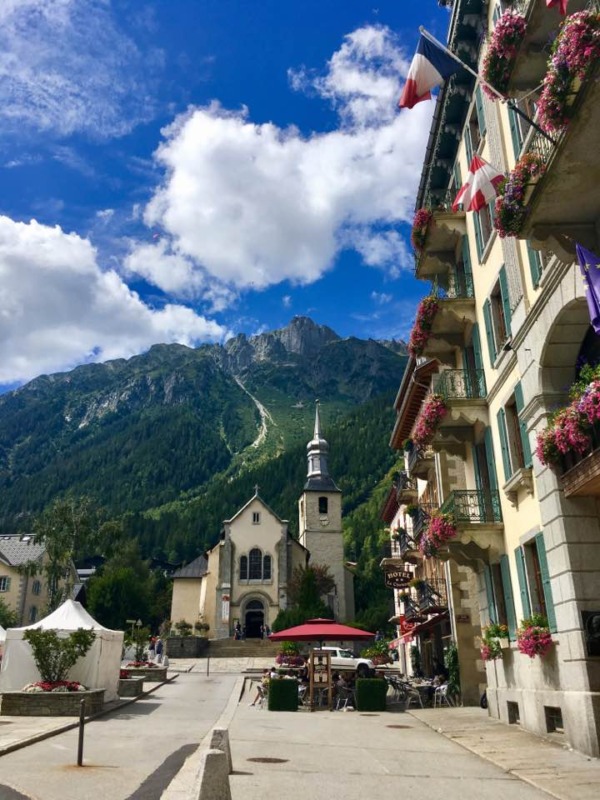
Chamonix is a beautiful and fun town to explore before or after your trek. Photo by Christa Rolls
Where to stay on the Trail
Planning out your accommodations for the trail is quite time-consuming, and likely why many people end up pre-purchasing a guided or self-guided tour.
In planning out our days, I mostly stuck to what the Cicerone guide recommended for us .
The challenge is ultimately contacting each refuge/hotel and keeping track of the following:
Deciding Which Refuge to Stay in
Consider the total distance you will need to travel between your starting and ending locations, and whether that distance is feasible for you.
A variety of room types may be available at various locations on the trail. Private rooms with shared or private bathrooms to ten person shared bunk rooms can be booked. If you have a preference, ask about availability during your correspondence.
Contact Each Refuge
To contact the refuges/hotels, some will have online forms available on the TMB website. Others may only respond via email or phone line.
If your French is minimal, emailing is a good option, as you both can use Google Translate if needed.
I contacted all refuges/hotels by email and created a separate “Tour du Mont Blanc” folder in my Gmail account to keep track of TMB-specific correspondence with refuge/hotel personnel.
How Much Money is Needed per Refuge
Determine whether the refuge/hotel accepts credit card or cash only. In addition, keep track of those you pay for ahead of time and those who want you to pay on arrival.
I kept an excel spreadsheet with the locations I still needed to pay cash for on the trail. This way, I made sure to take out the appropriate amount prior to starting our trek.
What you Need to Stay at Each Refuge
Certain refuges provide linens and towels and some don’t. Ask during your correspondence whether this is something you will have to bring along with you.
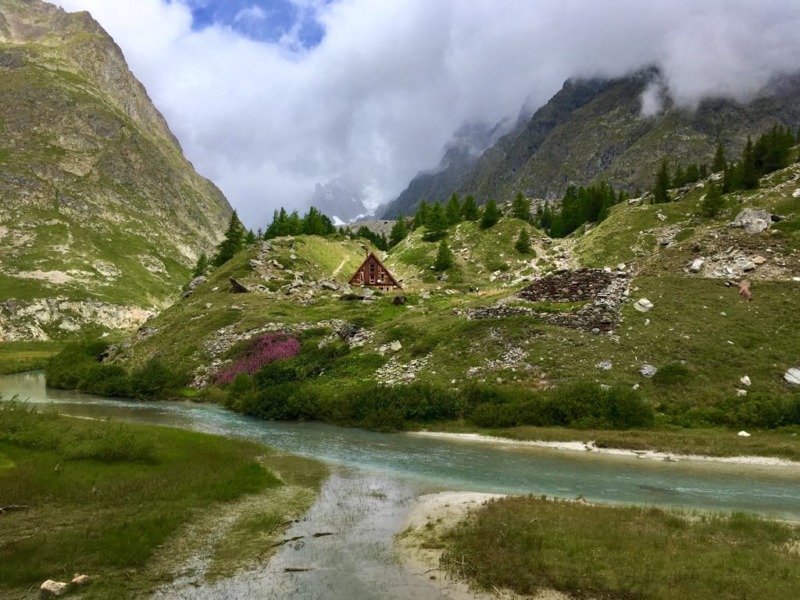
The Caban du Combal sits along the Val Veni next to Lac Combal, a stunning, clear blue, glacial lake. This was one of our favorite places to stay during our entire trek. Photo by Christa Rolls
The main reason why you would want to book accommodation ahead of time is to secure yourself a bed without the worry of having to beat everyone else to the refuge.
Some people do this – get up first thing in the morning and hoof it as quickly as possible to their next refuge site.
As I mentioned before, I’m a pretty slow hiker and would always tend to arrive at my destination by mid-afternoon even after getting up earlier in the day. It was for my peace of mind that we had spots secured. Even though it took time to coordinate, it was worth it.
If you don’t book anything, you have the freedom to continue on or stop short on your hike whenever you would like. Otherwise, you risk losing a deposit to the places you’ve booked ahead of time.
Check out the embedded map found at the top of this post for the primary recommended huts, hotels, and refuges along the Tour du Mont Blanc.
Food on the TMB
You won’t ever run out of food availability on the trail (unless you go in the off-season and huts are closed until the following summer). There are so many places that offer snacks and full meals along the way in summer.
Of course, some breakfasts and dinners are better than others along the way. Our most favorite dinner was at Les Chambres du Soleil in Les Chapieux. Even if you don’t end up staying the night here, consider taking them up on their fabulous dinner and dessert.
Breakfast typically comprises of a hot beverage, bread with butter and confiture (jam), and sometimes some yogurt, cheeses, and meats.
There largely aren’t kitchens that are open to visitors in these locations, so if you’re attempting to save money by just renting a bed and cooking your own food, keep in mind that you’ll need to bring your own equipment.
The dining areas of refuges at dinnertime will be for those dining in ONLY, so if you’re making your own food you’ll need to do that elsewhere. Some places are pickier about this than others. Dinner always consists of salad or soup, a main course, and a desert.
Water on the TMB
Because of all the grazing land around the trail, DO NOT drink the water in streams without filtering it first. Cow, horse, and sheep feces can be found all along the trails and streams on the Tour du Mont Blanc. Consuming tainted water can give you a nasty stomach bug.
You will frequently come across accommodations where there will be potable water to fill up your bottles or Camelback. Given this, you really only need to fill up for the day when you embark each morning.
If you’re planning any side excursions, however, and tend to drink a ton of water during your hikes (like me), it might be worth it to bring along a Sawyer Mini or Lifestraw , or water purification tablets . I always hike with a 3L Camelback on longer day hikes. Despite the added weight (every 16 oz. of water is about a pound of weight), this is worth it to me since I hydrate so much.
Some streams along the trail may stop flowing in late summer, but you really won’t have an issue with filling up along the way.
TIP: Consider doing some longer day hikes prior to your trip to gauge your water intake.
All potable water locations will be clearly marked as such with “ Eau Potable . ” Avoid water sources that say “ Eau Non Potable ,” as the “ non ” (meaning “ no “) indicates it should not be consumed.
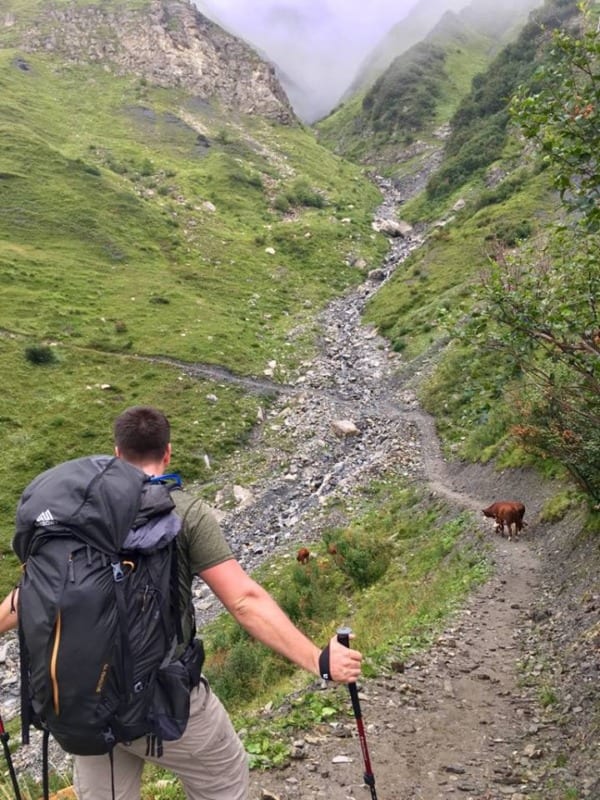
Livestock of all kinds can be found literally on the trail along the Tour du Mont Blanc. Exercise caution when passing animals with young. Photo by Christa Rolls
Miscellaneous Tips for Hiking the Tour du Mont Blanc
Be mindful about where you end up hiking.
And follow the TMB trail blazes (a yellow diamond or red-and-white blaze).
The extensive number of hikers and subsequent erosion has created some meandering trails that lead off of the main trail. Most eventually lead back to the main trail, but some don’t. These have the potential to create other unwanted trails from people hiking all over.
Learn some French
I know, I know, learning languages is hard. But learning a few phrases will make speaking to some of the locals a lot easier.
Many people will be speaking English on the trail, as people from countries all over the world will be hiking the trail. However, refuge personnel may speak less English.
Although you’ll pass through Italy, French is still widely understood in this bordering region next to France. In addition, the region you will be hiking through in Switzerland is the French-speaking side of the country.
At the very least, learn to say the basic phrases, such as: hello ( bonjour or bonsoir ), please ( s’il vous plait ), and thank you ( merci ).
Get good hiking poles
The consistent elevation gain and loss can be especially hard on your knees and legs. Hiking poles will alleviate the pain somewhat. These are my favorite .
Get good hiking shoes
You’ll be walking in your shoes A LOT over a two-week time frame. While good hiking shoes or boots can be expensive, it’s worth it to get a pair that fit your feet well and are comfortable.
I swear by my Vasques , and I never have to break them in.
Take time to explore some of the towns and villages along the way
You’ll come across some wonderful valleys and alpine prairies, as well as plenty of places to do a side hiking trip.
This is another reason I like to book my accommodation ahead of time. My mind is on exploring and taking my time along the trail instead of racing to the next hut!
Take time for a rest day
If you need it, there’s absolutely nothing wrong with giving your body a break.
This is a long trek, so listen to what your body needs and modify your hiking days accordingly.
For a halfway hike, Courmayeur is a good place to stop if you don’t have as much time to hike. Buses go through the mountain pass straight back to Chamonix, costing around 15 Euro per person.
By the time you get to Courmayeur, your body will likely be ready to keep on trekking!
Don’t take the hiking guide to heart 100% of the time
While guides are there to help you with some navigation, logistics, and accommodation information, everyone hikes differently.
The difficulty level and hiking times for each day may vary from person to person. I tend to hike an hour or two longer than the suggested hiking times, while some people I know hike about two hours faster than the suggested hiking times.
Be kind to yourself and recognize you can hike your own hike!
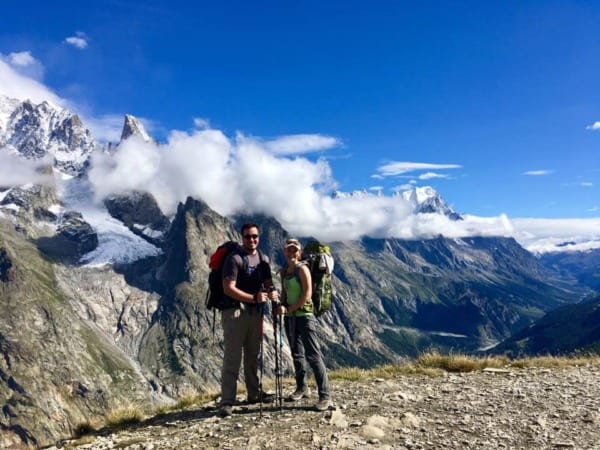
The sun is a welcome friend after getting snowed on in the high mountains! Note that layers are incredibly important for this trek, as the weather can change very quickly. Photo by Christa Rolls
Gear Recommendations for the Tour du Mont Blanc
My pack weighed about 10 kg without water – your pack should only be about 20% of your body weight . The full list of the gear I brought is as follows.
Backpacking Gear
- Deuter Lite 60+10 SL Hiking Pack with Rain Cover (her)
- Gregory Baltoro 85L Pack (him)
- Small, lightweight, collapsible day pack (for day hikes)
- Black Diamond hiking poles
- Petzel Headlamp
- Collapsible cup /mug
- T itanium spork other eating utensil
Food and Water
- Camelback 3 L bladder
- Lunch and/or snacks for day-time hiking on the trail
Clothing and Footwear
- Vasque hiking boots
- Three pair hiking socks ( SmartWool and Darn Tough )
- Reef flip flops (or other house shoes)
- Three pair Patagonia hiking underwear (originally purchased on discount at REI)
- Two hiking bras (originally purchased on discount at REI)
- One pair Columbia convertible pants
- Two moisture-wicking long sleeved shirts
- Two moisture-wicking short sleeved shirts
- Patagonia fleece (given to me by a mountain hut manager after someone left it for a month)
- Smartwool long john pants (originally purchased on discount at REI)
- REI puffy jacket
- North Face rain jacket
- Columbia Rain Pants
- Buff neck warmer
- North Face glove liners
- Prana ear warmer
Emergency and First Aid
- First Aid kit : alcohol wipes, antibacterial ointment, antidiarrheal, antihistamines, ibuprofen, Dramamine, antacid, epipen, gauze, medical tape, small round of duct tape, safety pin
- Hiking whistle (check the chest buckle on your hiking pack – some have a whistle built in)
- Travel Insurance – we recommend this for every trip you take!
Health and Hygiene
- Toiletries: wet wipes, face wipes, toilet paper, hand sanitizer, nail clippers, contacts and glasses, sunscreen, mini toothbrush, toothpaste, concealer wand (for after trip), sunscreen lip balm, collapsible hair brush, care plus clean bio soap (biodegradable; for skin, hair, dishes, and clothes)
- Lightweight camping towel
- Sac a la viande/sleeping bag liner , or travel sheet liner
- Sunglasses and baseball hat
- Cicerone guide to hiking the Tour du Mont Blanc – excellent guide for the surrounding area’s accommodations, food options, alternative routes, and natural features
- Waterproof trekking map of the Tour du Mont Blanc
Tools and Repair items
Backpacking extras.
- Eye mask and earplugs (if you are a light sleeper, definitely don’t forget ear plugs if you’re sleeping in dorm style rooms)
- Phone charger and battery charger pack
- Dry bag and large trash bag to line the inside of our our packs (in addition to rain cover)
- Stuff sacks for organizing gear (e.g., one sack for kitchen, one for food, one for clothes, etc.)
Personal Items
- Credit cards and ID/passport
There are a few other gear considerations to keep in mind for your trip
- We did not end up deviating from the regular route to alternative routes or climbs, so we didn’t end up using the detailed trail map. If you decide you want to go on some of the higher routes or add climbs to your trip, consider obtaining IGN 3531 ETR and IGN 3630 OTR waterproof maps to assist in your navigation.
- We monitored the online forums prior to our trek to ensure there was no snow left on the ground. By mid-to-late July most of the snow has begun melting away. If you anticipate there being snow on the trail, bring crampons or yak-traks along in the event that things get slick and icy.
- Accommodations will provide you at least with a pillow and wool blanket, but they may not wash them or put covers on them. This is what the travel sheet liner is for.
Tourist Office Locations and Information
For more information on activities in the surrounding area, contact the region’s corresponding tourist information office.
Chamonix Tourist Information Center
Address: 85 Place du Triangle de l’Amitié, 74400 Chamonix-Mont-Blanc, France
Phone: +33 4 50 53 00 24
Website: chamonix.com
Tourist Office Les Houches
Address: 9 Place de la Mairie, 74310 Les Houches, France
Phone: +33 4 50 55 50 62
Website: leshouches.com
Courmayeur Tourist Information Office
Address: CSC Centro Servizi, Viale Monte Bianco, 10, 11013 Courmayeur AO, Italy
Phone: +39 0165 842060
Website: lovevda.it
Champex-Lac Tourist Information Office
Address: Route du Lac 38, 1938 Orsières, Switzerland
Phone: +41 27 775 23 83
Website: champex.ch
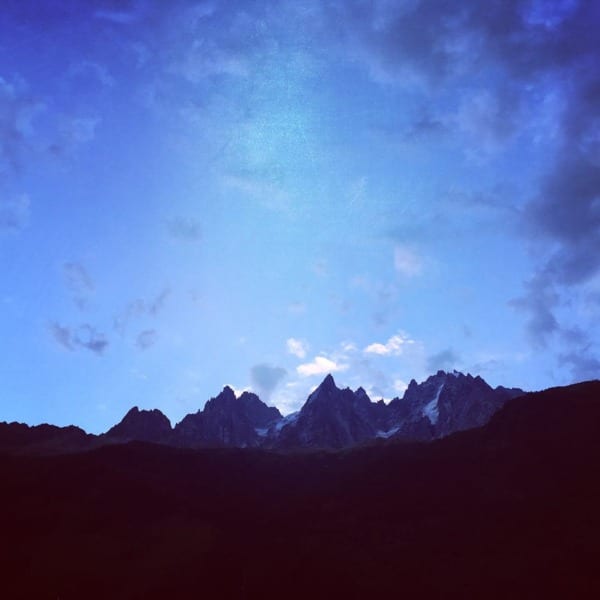
Get ready for an incredible display of stars at night if the sky remains clear. Photo by Christa Rolls
The Tour du Mont Blanc is one of the top treks in the world for good reason. It’s a stunning, fun, and unforgettable way to experience the Alps.
After your trip, consider visiting the Aiguille du Midi and Mer de Glace to see the Mont Blanc up close .
Tell us about your TMB experiences in the comments and feel free to message us with any questions or for more details!
Happy Hiking!
Christa and Nathan
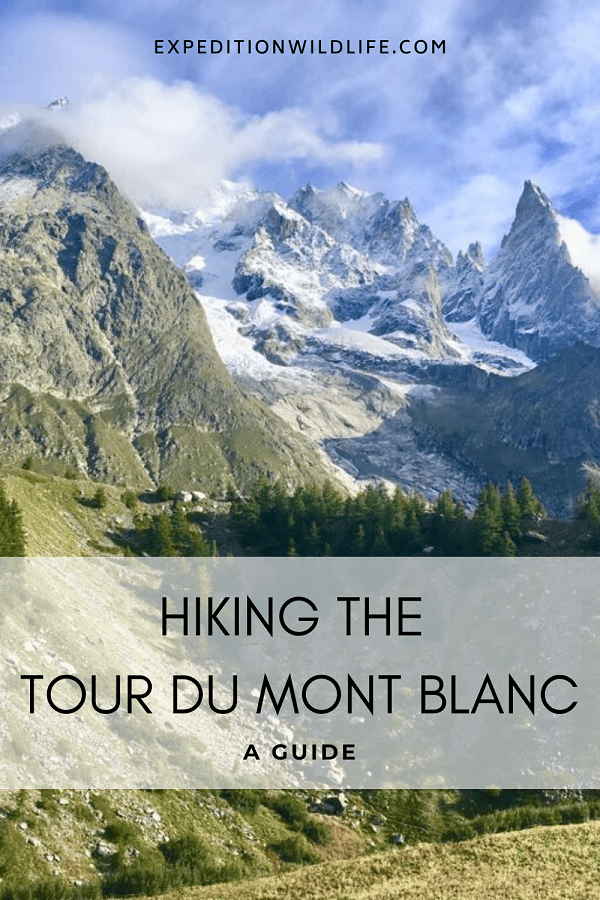
About the Author: Christa
Related Posts
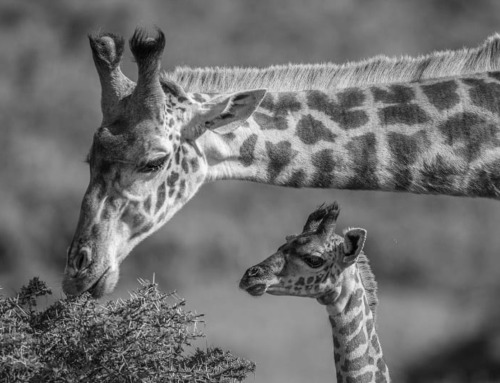
Ethical Safari Guiding Experience: The Wild Source
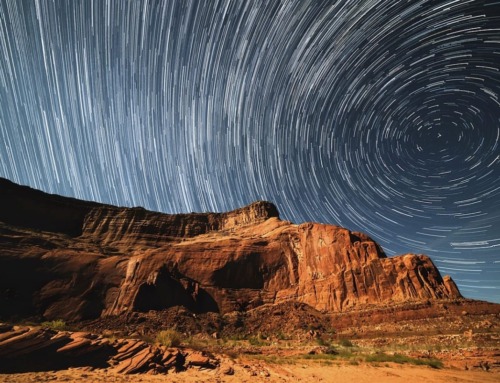
Must-Visit Dark Sky and Stargazing Destinations Worldwide
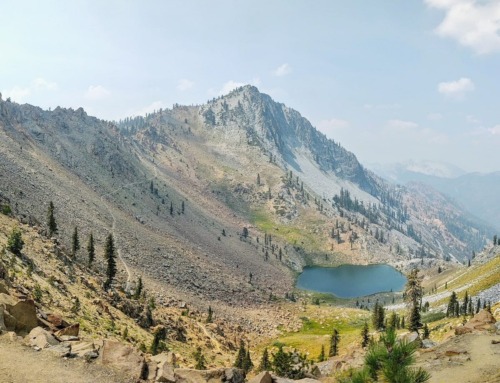
Trinity Alps Weekend Getaway: Northern California’s Four Lakes Loop
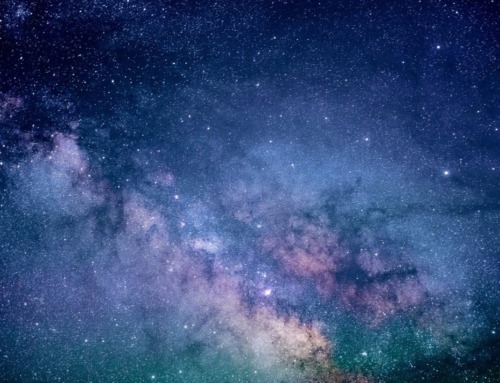
Must-visit Dark Sky Parks in the USA
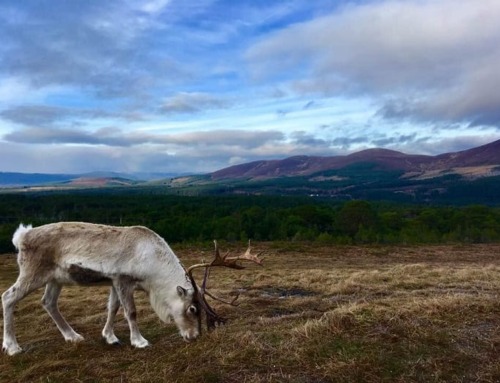
Cairngorm Mountains, Scotland Must-do Activities
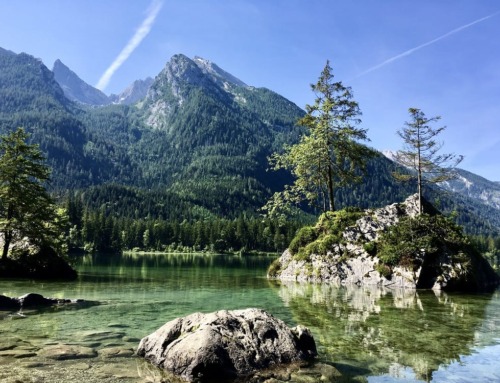
Must-visit Mountains in Europe
I’m off to hike the TMB at the start of August so I really appreciated your article. Whilst we are doing a 7 day itinerary there is some really useful information in here which i will be using for our trip, thanks for taking the time to write this piece. Cheers and happy hiking!
Ceri, so glad some of the information was useful for you! Have a safe and wonderful trip, and please let me know how it went when you get back!
Leave A Comment Cancel reply
This site uses Akismet to reduce spam. Learn how your comment data is processed .
- "Death from exhaustion" 4 alpinists trapped near the summit of Mont Blanc
- Four climbers trapped on Mont Blanc
- Chamonix Lift Systems open in September 2024
- Closure of the Mont-Blanc tunnel: alternative routes
- Two Spanish climbers lose their lives at the Gervasutti corridor
At the foot of Mont Blanc (4808m or 15,770ft), the highest mountain in western Europe, Chamonix's alpine town atmosphere

The resort of Chamonix has three 5 star hotels, eleven 4 star hotels, twenty two 3 star hotels, thirteen 2 star hotels

Alpy Transfers Is the Best Transfer Option in the Alps for Traveling from Geneva to Chamonix This Summer.

Since 1934, Snell Sports has been the largest mountain shop in the Chamonix Valley.

Compare & Book Online with Chamonix.net
Tour du mont blanc hiking - routes, maps and itineraries.
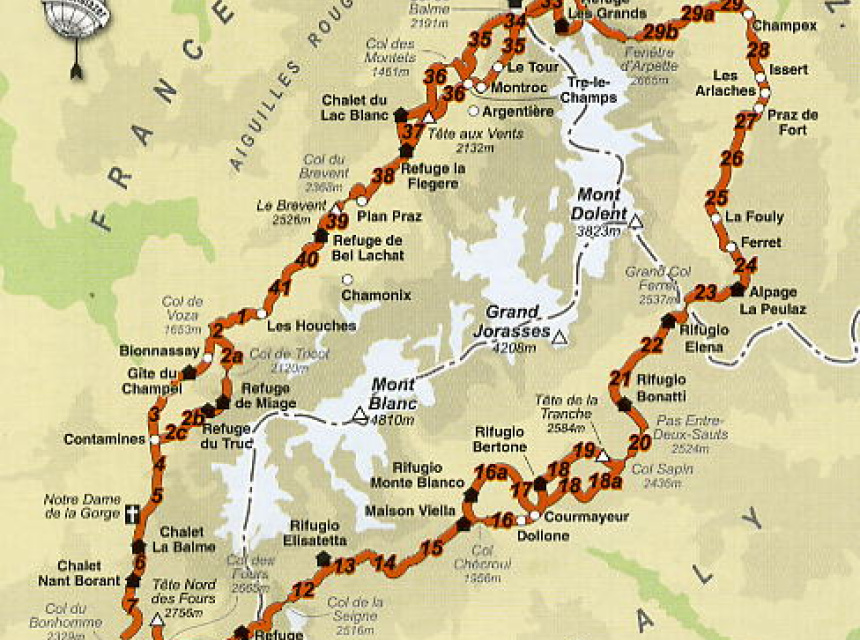
The Tour du Mont Blanc (TMB) is a 170 km trek that encompasses the whole of the Mont Blanc Massif; with nearly 10 000m of cumulative descent and ascent it is usually completed in a number of days.
The TMB has a variety of accommodation facilities along the route (hotels and mountain huts with possibility for vehicle support) that allow you to really enjoy the scenery, take lots of photos and walk each day with just a light pack.
Alternatively, the TMB can be done completely self-sufficiently: you carry all your own food and camping gear. This gives you a better sense of freedom and the ability to go where you please whenever you want.
Tour of Mont Blanc General Information
Mont Blanc Tour mountain huts are open, in general, from mid-June until the first or second week in September. It is advisable to reserve a bed, particularly in the high season of mid July to mid August.
Early in the season is the quietest and most beautiful, but beware of old snow on the higher paths which could be icy and dangerous and would make an ice axe essential.
For additional safety or to just show you the way you could hire an Independent Trek Leader .
Wildlife on the Tour du Mont Blanc
Have a look at the Chamonix.net nature, fauna and flora page for more information on wildlife you might encounter on the Tour of Mont Blanc. Chamois, deer, eagles and a range of beautiful alpine flowers can all be seen and photographed.
Tour du Mont Blanc Maps, Kit List and Equipment
Lightweight boots and shorts are sufficient as long as there are warm clothes in your backpack. Waterproofs are essential and trekking poles useful. Here are some of the best mountain equipment shops in Chamonix .
Do not forget sunglasses, skin and lip protection. Always carry drinking water and check the Chamonix weather forecast before starting your journey.
Maps for the Tour of Mont Blanc:
Tour of Mont Blanc - Route Descriptions
You have plenty of options: from 4 day sportive hikes to leisurely 12 day cultural experiences; there is not only one way to do the Tour of Mont Blanc. Here are a couple of different suggestions which may help you make up your mind on your particular style.
- You can go on your own with your own GPS track, or benefit from a mountain leader's experience
- You can carry your own gear or hike with a light pack with vehicle support
- You can sleep and eat in the refuges or carry a tent
Here is a list of contact information for the various mountain huts .
4 day trip: Not quite racing - but fast enough: For the hardcore hiker
This itinerary follows pretty much in the footsteps of the Ultra Trail race (which varies slightly from year to year). This is for very fit hikers and is done with only a light day pack, eating and sleeping in huts and is basically the run/walking version of the Tour du Mont Blanc. The times noted are for fit spandex-wearing (not obligatory!) hikers.
7 day trip: Hiking the Tour of Mont Blanc - hiker
Start with the previously mentioned itinerary and break up the days a bit depending on where you would like to spend the night.
For people who carry their own gear, plan on a 7 day trip.
9 to 11 day trip: Taking the time to look at the scenery
Of course if you really do have time, you can expand the experience. Here's an example of a slower pace, with time to veer a little off the path. This is described as an 11 day trip, but it would be really easy to knock off the first and last days as those days are dedicated to trekking in the Chamonix Valley.
Each year, in the last days of August, the trails around the Mont Blanc get really busy. This is because of one of the most amazing human competitions ever organized on this planet - The Ultra Trail du Mont Blanc - so keep this in mind when planning your hike of the Tour du Mont Blanc.
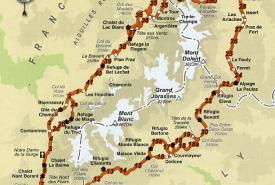
Social Networks

Latest News

UK Edition Change
- UK Politics
- News Videos
- Paris 2024 Olympics
- Rugby Union
- Sport Videos
- John Rentoul
- Mary Dejevsky
- Andrew Grice
- Sean O’Grady
- Photography
- Theatre & Dance
- Culture Videos
- Fitness & Wellbeing
- Food & Drink
- Health & Families
- Royal Family
- Electric Vehicles
- Car Insurance Deals
- Lifestyle Videos
- Hotel Reviews
- News & Advice
- Simon Calder
- Australia & New Zealand
- South America
- C. America & Caribbean
- Middle East
- Politics Explained
- News Analysis
- Today’s Edition
- Home & Garden
- Broadband deals
- Fashion & Beauty
- Travel & Outdoors
- Sports & Fitness
- Climate 100
- Sustainable Living
- Climate Videos
- Solar Panels
- Behind The Headlines
- On The Ground
- Decomplicated
- You Ask The Questions
- Binge Watch
- Travel Smart
- Watch on your TV
- Crosswords & Puzzles
- Most Commented
- Newsletters
- Ask Me Anything
- Virtual Events
- Wine Offers
- Betting Sites
Thank you for registering
Please refresh the page or navigate to another page on the site to be automatically logged in Please refresh your browser to be logged in
Tour du Mont Blanc: The complete travel guide to Europe’s popular long-distance walk
If you relish hiking 18km a day at altitude in all weathers for days on the trot, the tmb offers a classic adventure, writes margaret batty, article bookmarked.
Find your bookmarks in your Independent Premium section, under my profile

Sign up to Simon Calder’s free travel email for expert advice and money-saving discounts
Get simon calder’s travel email, thanks for signing up to the simon calder’s travel email.
“Top Ten Hikes of the World” lists always feature the Tour du Mont Blanc (TMB). And rightly so; it loops 170km (106 miles) around Mont Blanc, the highest mountain in western Europe which is 4,810m (15,781ft), traversing not one but three countries: France, Italy and Switzerland. Vistas around the Tour du Mont Blanc are superlative and, with a lung-busting 10,251m (33,631ft) meters of ascent, they will, quite literally, take your breath away.
Mont Blanc is surrounded by seven valleys radiating from its core. The TMB links them all via high mountain passes. Chunk the trail down into 11 sections and it starts to form the energetic backbone of a superb two-week holiday. You can start and end anywhere and walk in either direction. The French resort of Chamonix is a logical start/finish point and most people walk the trail in an anti-clockwise direction. The main trail is well sign-posted and is not technically difficult (but avoid “variant” options involving chains and crampons). The TMB does not summit Mont Blanc itself, however: that is an entirely different mountaineering adventure.
How long does it take?
There is a rare breed of ultra trail endurance runners who complete the TMB non-stop in a phenomenal sub-20-hour annual event. These are world-class athletes with lungs and legs that defy science. Lesser mortals, ie competent, fit walkers, take nine to 11 days to complete the whole circuit.
The Mont Blanc road tunnel slices through the mighty mountain, offering hikers an easy option to split the TMB over two holidays using local coach services to and from Chamonix and Courmayeur (eg year one trek Chamonix to Courmayeur, the following summer complete your circumnavigation from Courmayeur to Chamonix).
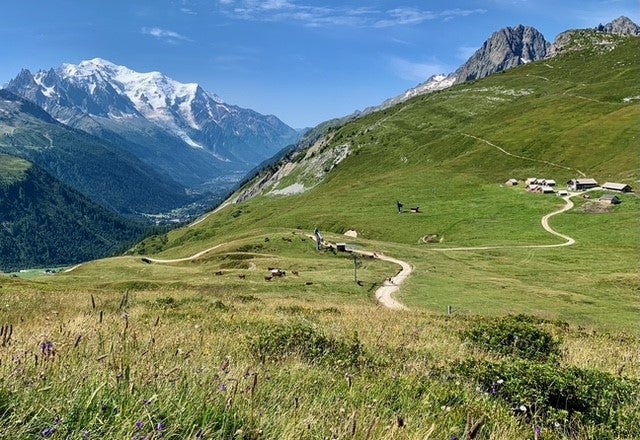
If you don’t want to commit to the whole TMB, base yourself in Chamonix and tick off a few sections of the route, using local transport each day.
11-day itinerary
Sample daily itineraries: +/-18km (11 miles) distance/1,000m (3,280ft) ascent/6-8 hours walking
Day 1: Chamonix Les Houches (Bellevue cable car) to Les Contamines, France
Day 2: Les Contamines, via Col de la Croix Bonhomme is 2,476m (8,123ft), to Les Chapieux
Day 3: Les Chapieux (valley bus), via Col de la Seigne is 2,516m (8,254ft), to Refugio Elisabetta, Italy
Day 4: Elisabetta to (Dolonne cable car) Courmayeur, Italy
Day 5: Courmayeur to Lavachey, Switzerland
Day 6: Lavachey, via Grand Col Ferret is 2,537m (8,323ft), to La Fouly, Switzerland
Day 7: La Fouly to Champex, Switzerland
Day 8: Champex to Forclaz, Switzerland
Day 9: Forclaz, via Col de Balme is 2,191m (7,188ft) to Le Tour, France
Day 10: La Tour, via Col des Montets, to Flegere, France
Day 11: Flegere, via Brevent is 2,368m (7,769ft) to Les Houches Chamonix, France
How to plan a trip
The TMB does present logistical challenges, but overcoming them is all part of the fun.
You can plan your route and reserve most refuges using one incredibly useful website, autourdumontblanc.com , enabling you to join the dots between each day’s walk.

As you plot your itinerary, bear in mind that walking at altitude can impact stamina and sleep quality, and that the ascent profile of a walk is as important as the distance. Alpine guides indicate the typical number of hours per walk as a good benchmark of effort required. Before you go, practise long, hilly, multi-day walks, with a loaded backpack.
If you’d like hiking buddies or an expert guide, organised group trips are also available (eg exodus.co.uk , keadventure.com ). Some even offer luggage transfer.
Mid-June til late September is TMB season. The main snow melt ends in June, long summer days are a bonus, Alpine flower meadows peak in July and, come September, summer tourists are replaced by glorious autumnal colours.
If you yearn for solitude, avoid the week of the annual Ultra Tour du Mont Blanc event (28 August 2023), when Chamonix and the TMB trail will be ultra-busy, with 10,000 runners and their supporters zipping around.
Packing list
- Quality trail boots
- Collapsible trekking poles
- Sunhat, sunglasses and sun lotion
- Water bottles and energy bars
- Basic first aid kit and blister repair
- Euros: many refuges are cash-only and lack wifi
- Flip-flops and dry, warm kit for evenings
- Sleeping bag/liner
- Earplugs to block out noisy bunk companions
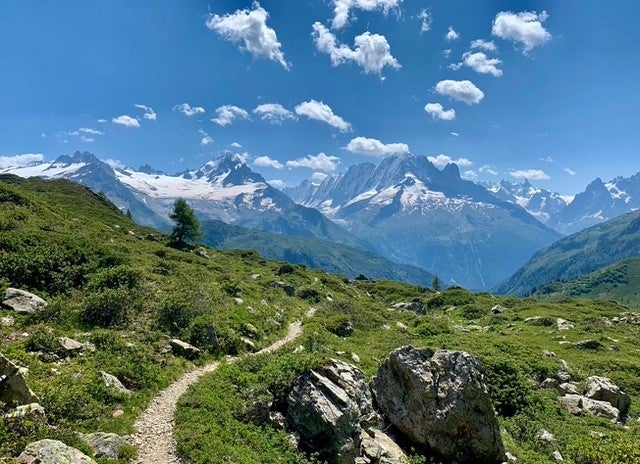
Delight in the rustic charm of ‘refuge’ mountain huts. You’ll be thankful for their warmth, chilled beers, hot meals, and beds. Some refuges offer private rooms, although most have mixed-sex bunk dormitories; all have shared bathrooms and water (sometimes hot!). Bed and half board costs around €60-80 (£53-71). But it’s impossible to put a true price on the experience of staying in these off-grid, remote locations, nestled amid extraordinary Alpine scenery, with sublime starry skies.
Where the trail touches the resorts of Chamonix, Les Contamines, Courmayeur and Champex, you can swap these stripped-back stays for normal hotels.
It helps to like cheese on the TMB. A hunk of Comte and baguette for lunch? Tartiflette (melted cheese, potatoes, and ham) for supper? “La Vache Qui Rit”, soft, triangular cheese, for breakfast? And repeat... This is Savoie mountain food. You won’t go hungry, and you won’t have to carry much with you. Refuges ensure hikers are fuelled up with breakfast, supper and packed lunches.
Highlights of the TMB
- The views. Impossible to pick one (Col de Balme? Col de la Seigne? Val Ferret?). Each day will reveal stunning scenery: vertiginous mountains, ancient glaciers, and snowy 4,000m (13,123ft) peaks.
- The simplicity of the daily TMB rhythm is a tonic: life slowed to a walking pace, mountain air, summer pastures filled with wildflowers and jingly cowbells.
- Meander through three European countries, witnessing rural life in traditional mountain communities.
- Experience warm camaraderie between fellow hikers relaxing in remote mountain refuges.

- Underestimate the TMB at your peril. You’ll be climbing more than the equivalent trek to the summit of Everest.
- Book accommodation early (especially Les Chapieux), ideally before Easter.
- Acclimatise in the Alps for a day or so and consider a rest day in Courmayeur.
- Don’t overpack, aim for 10kg maximum.
- Use cable cars where they make sense (unless you’re a route purist).
First up, treat your weary body to a luxury spa in Chamonix when you finish. QC Terme is bliss. Indulge in a Brasserie du Mont Blanc beer on a cafe terrace by the glacial River Arve, and be sure to take a celebratory ride up the Aiguille du Midi cable car. From Chamonix, the distinctive red cable car shoots up to a giddy 3,842m (12,604ft), seemingly within touching distance of Mont Blanc itself. Survey your route around the massif. This is the 360-degree panorama to beat them all. Mission accomplished.
“Holiday” doesn’t do the TMB justice: the post-trek sense of accomplishment is profound and will leave a lifelong imprint.
Getting there
Chamonix is accessible by flights to Geneva and onward by a 90km (55 miles) mini-bus transfer from the airport. Chamonix is also connected by train, via the scenic Mont Blanc Express Railway.
Join our commenting forum
Join thought-provoking conversations, follow other Independent readers and see their replies
Subscribe to Independent Premium to bookmark this article
Want to bookmark your favourite articles and stories to read or reference later? Start your Independent Premium subscription today.
New to The Independent?
Or if you would prefer:
Hi {{indy.fullName}}
- My Independent Premium
- Account details
- Help centre
- Register | Login
Tour du Mont Blanc Hiking Tours
Tour du mont blanc.
- Hike Europe's incredible, world-famous long-distance Alpine route
- Awe-inspiring panoramic mountain views at every bend of the trail
- Three countries in one hike; France, Italy & Switzerland
- Savor delicious classic cuisine, from tasty cheeses to local wines
- Stay in traditional alpine mountain huts or cozy historic hotels
- Hassle-free hiking: all our trips include bag transfer & 24/7 phone support
Circling Western Europe's highest mountain, Mont Blanc (15,780 ft), this 100-mile alpine trail crosses through three beautiful European countries- France, Italy and Switzerland. With far-reaching landscapes, wildflower meadows, high mountain passes, and snow-covered peaks, this glorious route is the epitome of an alpine adventure. The unmatched sunsets and alpenglow are the perfect complement to the unique mountain culture of the Tour du Mont Blanc.
Not only do we have unrivaled knowledge and expertize in the area, we’ve also sent thousands of Macs customers on the TMB and refined our tours to provide the most fulfilling self-guided hiking experience. Self-guided hiking means having the freedom to explore independently at your own pace, along well-waymarked routes, with our 24/7 first-class support. The hiking days are consistently long and remote, making it a suitable accomplishment for the experienced long-distance hiker.
The option to choose between the Complete Tour du Mont Blanc in Comfort , staying in cozy hotels, and the Tour du Mont Blanc in Huts , staying in traditional mountain huts, allows hikers to choose their experience based on their preferences. Staying in the huts not only immerses you in the mountain culture but also fosters comradery with fellow hikers, adding to the overall sense of adventure and community.

Featured Tours - Tour du Mont Blanc

Complete Tour du Mont Blanc in Comfort

Highlights of the Tour du Mont Blanc in Comfort

Complete Tour du Mont Blanc in Comfort (extended)

Complete Tour du Mont Blanc in Huts

Highlights of the Tour du Mont Blanc in Huts

Classic Walks of Mont Blanc
Discover tour du mont blanc.
It's an awesome, long distance circular hike around the mountain of Mont Blanc, crossing three countries – France, Switzerland and Italy.
We've constructed various routes to choose from. Complete the full route , which is around 100 miles or if you're short of vacation time, just the best stages .
The highest elevation you'll reach is 8,823 ft, which is at the mountain pass ‘Grand Col Ferret’. This is on the Italy / Swiss border – so you can have your feet in both countries!
July to mid-September is the time to travel. Outside this period snow can be problematic.
There's a lot of ascent– in total a staggering 34,776 ft but the incredible views and experience you're rewarded with, make the journey worth it!

HUTS - Tours In Huts
Traditional mountain huts (refuges/rifugios) create a sense of comradery, mountain culture, and good spirits. Dining is a communal event where one pot meals served by the local hut owners are enjoyed round a long table with other travelers. This is often a highlight where memories are made. Chat with fellow trekkers, exchange stories from the previous days, and get excited about future hikes.
The beds are set up dormitory style and are either bunk beds or raised mattresses next to each other. The dorm rooms range from sleeping 4 to 20 people and are mixed gender. The huts have shared and mixed gender restroom facilities.
COMFORT - Tours In Comfort
The 'In Comfort' tours offer overnight stays in historic alpine hotels nestled in iconic TMB mountain towns. We hand-pick the hotels for their location, welcoming staff members, and local cuisine.
On some nights there are no alternatives to mountain huts. In these instances, we try to book you in a private room. These will most likely have shared restroom facilities and may not have a double bed option.

The best place to view all the tours together is in the ‘featured tours' on this page. From here you can select your tour depending on the below questions.
- The majority of days are 12 miles longs with ascent and descent.
- How many days am I able to walk back to back this distance
- How fit do I need to be for the TMB
- We offer 14 days / 12 days / 8 days or 5 day tours.
- Hotels with the odd night in a private room in a refuge
- Huts in dormitories rooms
We have several excellent blogs with further information, our favorites are: 25 Frequently Asked Questions and Top tips for hiking the Tour du Mont Blanc

Raclette - A type of cheese that's melted and eaten with potatoes, gherkins, pickled onions and cured A type of melted cheese that is enjoyed with potatoes, cucumbers, pickled onions and cured meats. Raclette is just as delicious as it is filling. Depending on the hut, the cheese will either be melted over a personal table-top grill or a massive hot iron and will coat your plate and toppings.
Tartiflette - Reblochon cheese melted over a mixture of potatoes, onions, bacon and chives. It's the epitome of alpine comfort food—providing the perfect balance of warmth and satisfaction, especially after a long day on the trail.
Rosti - A Swiss version of Tartiflette that includes grated fried potatoes covered in Gruyére cheese and topped with ham and often a fried egg. Mushrooms are also often added, traditionally foraged from the surrounding hills.
Beers - If you enjoy a drink, be sure to look out for Bierre Leman and Veyrat - two local beers that are often served in the area.
Wine - There's a French belief that wine expresses the characteristics of the area it's grown in. If you enjoy wine, we absolutely recommend you taste the local varieties along the way!
Génépi - A local liqueur often enjoyed after dinner, Génépi tends to be an acquired taste with a sweet herbal chamomile and absinthe flavor. We encourage anyone with adventurous palates to try this!

Great news - Luggage transfer is included as standard. This means you are able to enjoy the hiking with just your essentials in your daypack.
Our responsible and friendly baggage handlers will take you main suitcase/luggage to your next overnight destination. As they move hundreds of bags each day, they can only accommodate one 33lbs bag, per person.
The Bonatti Refuge and Lac Blanc Refuge are incredible alpine mountain huts that you may stay in during your trip. Due to their remote location, they are inaccessible by road. Therefore, you will need to carry your overnight items on these days if you are booked in Bonatti or Lac Blanc, but no stress, you will be reunited with your main bag the following day!
Availability dependent, the 'complete' TMB tours will have an overnight at Refugio Bonatti, and the 'complete in huts' will have nights in both Bonatti and Lac Blanc.

Macs Adventure has been running self-guided hiking adventures on the Tour du Mont Blanc since 2010.
Follow Bill and Malin on their TMB journey!

The Biggest Choice
Founded in 2003, 21,000+ customer reviews, positive impact, follow us on social media.
- twitter-x-logo@2x
- Where to stay – Chamonix
- Geneva Airport to Chamonix
- Tour du Mont Blanc public transport
- Itineraries
- Tour du Mont Blanc Refuges
- Refuges ebook

CLASSIC TMB - 11 DAYS
This classic Tour du Mont Blanc 11 day itinerary follows the traditional route of the TMB. Trek every step of this glorious 170km trail through France, Italy and Switzerland basking in the magnificent scenery of this once in a life time long distance trek.
Our Tour du Mont Blanc 11 day itinerary eases you into the trail with a nice easy first day on the spectacular variant stage 1 and then takes the remaining stages day by day.
Choose from carrying everything on your back or booking a luggage transfer so that for the most part where possible, you carry just a day sack.
This itinerary is perfect for trekkers who want to complete the entire circuit. However with an accumulated elevation higher than Everest do not underestimate the 11 day itinerary – it’s still tough trekking this 170km trail! For those who have time and want to enjoy the trail drinking in the views without feeling rushed and to have a day off consider a 12-14 day itinerary. For those who want a day off and happy to to trek full days then our 10 day itinerary might be better, making it 11 with a day off half way round.

Classic TMB – 11 days
Start point: Les Houches, France End point: Les Houches, France Length: 11 days
- Day 1 Les Houches – Refuge Miage / Auberge du Truc
- Day 2 Refuge Miage – Refuge Croix du Bonhomme / Les Chapieux
- Day 3 Refuge Croix du Bonhomme / Les Chapieux – Val Veny
Day 4 Val Veny – Courmayeur
- Day 5 Courmayeur – Val Ferret (Refugio Bonatti or alternative accommodation)
- Day 6 Val Ferret – La Fouly
Day 7 La Fouly – Champex-Lac
Day 8 champex-lac – la peuty/trient, day 9 la peuty/trient – tré-le-champ.
- Day 10 Tré-le-Champ – Refuge de la Flégère
- Day 11 Refuge de la Flégère – Les Houches
timings, distances, elevation
Timings for this itinerary are approximate and non-stop , meaning you should add extra time for stopping to take photos, rest stops and your lunch break. Expect this to always be more than you imagine. Consider adding 2 hours onto your timings per day (for a full day). Remember it’s best to set off early and arrive early – thunderstorms commonly occur around 4pm each afternoon in the peak summer months on the TMB trail.

Day 1 Les Houches – Refuge Miage/Auberge du Truc
1445m up / 740m down / 14.7km / 5-6hrs, this itinerary takes the variant 1 stage via the col du tricot which is the only variant safe to take early season from mid june. most trekkers now take this variant – more spectacular for not that much more effort it’s a winner. in bad weather however the traditional trail through the woods must be taken, route overview:.
Today is an easy first day to ease into the trek. Ascend on foot up to the Col du Voza and then follow path along parallel to the train tracks to the Bellevue train station where the variant Col du Tricot trail leads down to the right.
Bellevue cable car saves the day!
Did you know that you can bypass the first 7km of the TMB by taking the Bellevue cable car from Les Houches. It’s a godsend to those who want to omit the first 2 hours of up (680m/7km) on the Tour du Mont Blanc. This section doesn’t have fabulous views so for me it’s a no brainer to take the cable car – its perfect for the variant Col du Tricot trail as it drops you off just five minutes away from the trail. I always take this cable car when it’s operating (early June to approx 10 Sept). Of course many others would prefer to trek this section and I begrudgingly do so if I’m trekking later in September (which is a glorious time to trek!)
If you don’t want to take it easy on the first day, you can stay overnight in the town of Les Contamines. It’s a further 2-2.5 hours on the trail. Refuge Miage has private rooms but Auberge du Truc does not. If Miage is full and you want a private room we would alter the itinerary for you to stay in Les Contamines. This would make for an easy day 2. If you are booking our self guided option for this itinerary speak to one of the team & they can easily tweak this itinerary for you.
Taking the Bellevue cable car you’ll reach the Bellevue Plateau in minutes. It’s then just a 5 minute walk (very well signposted) to pick up the variant trail. Cross the railway tracks and follow the path for Col du Tricot. After traversing the alpine meadows with views of the spectacular Bionnassay glacier you’ll cross the iconic Himalayan suspension bridge. After a short climb you’ll come to a clearing with several large boulders – the view of the glacier is a good one from here and it’s great spot to have lunch. If you look carefully here you’ll find wild bilberry bushes everywhere.
You can now see the top of the Col du Tricot before you. It’s a steady climb up to the grassy saddle. Spend some time here to admire the views over the Miage Valley and over to the Col du Bonhomme. You can spot Refuge Miage far down in the valley. If you look carefully to your left, you’ll see a stone archway on the ‘smugglers route’ to Refuge Plan Glacier (see our adventure itinerary ).

The descent down is STEEP and takes around an hour. Take it easy and use your poles. Reaching the valley floor follow the signs to reach Refuge Miage in just 5 minutes. This cluster of farm buildings in set in an idyllic rural setting and is charmingly French. Refuge Miage is a good place to stay as a family as children receive a discounted price (not the case in high mountain refuges). You can even book tiny chalets around the refuge which are well worth the money for extra privacy. The view of the Dômes de Miage (3600m) from the refuge is outstanding.
how can I make today easier?
At Les Houches most trekkers opt to take the Bellevue cable car (open normally first week of June to approximately 10 Sept) instead of hiking up from the valley floor. This saves around 2 hours and slashes around 7km off your day. The Bellevue cable car costs €17.50 one way for an adult (2023 prices) and takes just five minutes.
lunch stops
As today is a nice short day, it’s probably best to pick up something in Chamonix or Les Houches to take with you for lunch. If you take the Bellevue cable car the trek is only approximately 4 hours today
accommodation on your first night
Accommodation on your first night on this itinerary is at either Refuge Miage or Auberge du Truc. They are approximately 45 minutes apart. Refuge Miage does have private rooms however these book out incredibly fast so if you want a private room contact us before September so we have a good chance o getting this for you. If you are booking this itinerary self guided just add this into the special notes during the booking process.
Alternatively if you want a private room and are happy with a longer day, we can arrange for you to stay in the town of Les Contamines in private room 2-3 hours further.

Day 2 Refuge Miage – Refuge de la Croix du Bonhomme
1361m up / 635m down / 16.9km / 5-6hrs.
If departing from Refuge Miage you’ll have an initial short climb from the Miage Valley up and over to Auberge du Truc. You may well have stayed in this humble, authentic refuge if Refuge Miage was full. Just before here on the left is a ‘pointe du navigation’ which shows the names of each of the peaks you can see.
From Auberge du Truc it’s a long steady descent through the forest into Les Contamines. Have a leisurely coffee in this small French town before walking along the river to Notre Dame de la Gorge where the trail heads out into the wild once more. If you’re trekking in July or August you can pick up the free shuttle bus ( navette ) outside the Les Contamines Tourist Office to Notre Dame de la Gorge.
Take a moment to visit the beautiful Notre Dame de la Gorge chapel next to the gushing water before setting out on the well marked path. Warning – the trail is VERY steep here along an ancient slabbed Roman road to Refuge Nant Borrant but pleasantly flanks the bubbling racing gorge for much of the ascent. Be sure to look out for the pont naturel sign leading to a natural arch on the river, just a few minutes from the trail (navigate down a steep, mud track – I normally leave my backpack at the top!). Cross the roman bridge, take in the rushing gorge below. Expect to hike for around an hour from Notre Dame de la Gorge to Refuge Nant Borrant which makes an excellent lunch stop.
This afternoon you’ll make the climb over two mountain passes Col du Bonhomme (2329m) and Col de la Croix du Bonhomme (2483m). You’ll stay in the cavernous Refuge de la Croix du Bonhomme, a high mountain refuge with epic views. This is one of the most remote high mountain huts on the trail so bring your adventure spirit with you. Bunks and storage are excellent & dinner is unforgettable served by candle light to save solar power.
snow on the Col du Bonhomme
You can expect to have a stubborn patch of snow on the Col du Bonhomme well into the end of July. This is normal and as there is no exposure this is really just a novelty. You will not need hiking crampons if you are trekking from the end of the first week July
If you are trekking early season (14 June – 7 July) then there could be a considerable amount of snow on the TMB trail still. In this case yes you do need to bring hiking crampons. During this period it’s very important that the only variant trails you undertake is only variant stage 1 via the Col du Tricot. This is the only safe variant early season. You can read my article on trekking the TMB early season here .
shuttle bus in July & August
In July and August you can catch the free shuttle bus (navette) from outside the Les Contamines Tourist Office to Notre Dame de la Gorge instead of walking along the river on the flat path. This saves around 45 minutes as it approximately 1 hour to walk whist the bus takes 15 minutes (leaves approximately very 45 – 60 minutes or so throughout the day. Find out more about taking this short cut here .
You can either order a packed lunch (pique-nique) from Refuge Miage or Auberge du Truc for today or eat in one of the many restaurants or cafes in Les Contamines. There are also three small supermarkets and a bakery in Les Contamines in case you want to pick up your own provisions.
accommodation on your second night
Accommodation on your second night is at Refuge Croix du Bonhomme. Perched at 2443m this high mountain refuge commands a spectacular position on the trail. With provisions delivered by helicopter or carried up on backpacks, this is one of the most remote refuges on the Tour du Mont Blanc route. It’s not luxury, there are no private rooms and sometimes there are no showers. However if you bring your sense of adventure & come with more realistic expectations, this refuge will not disappoint. Top tip is to bring extra snacks for breakfast!
Why do I recommend Refuge Croix du Bonhomme over Les Chapieux?
Les Chapieux is the biggest bottle neck on the whole of the TMB. It books out very quickly and is then a cause of untold stress to try to get into. We would rather clients be kept on the trail than having to go down to the nearest down of Bourg St Maurice and re-join the trail in the morning. Refuge Croix du Bonhomme is the refuge before and is in our opinion the best option for staying on the trail. If you book the 10 day option or if you book the private room option by the end of the September before you trek then we can do our very best to get you into Les Chapieux.

Day 3 Refuge de la Croix du Bonhomme – Val Veny
1032m up / 1288m down / 18.7km / 5-6hrs.
Today you’ll descend from Refuge de la Croix du Bonhomme to the hamlet of Les Chapieux and then embark on the steady climb up to the top of the Col de la Seigne – the border between France and Italy! From here, in good weather, you can once again see the gleaming white dome of Mont Blanc with an exceptional view down into this Italian valley.
Dropping down into the Vallée Lee Blanche you’ll marvel at this wide U shaped valley with the fortress of the Mont Blanc Massif dominating to your left. It’s all downhill from here to Refugio Elisabetta – a cavernous refuge perched on a spur just below two glaciers. You’ll either stay at Refugio Elisabetta or 1 hour further in Cabane Combal.
Les Chapieux shuttle bus
From Les Chapieux you can pick up a shuttle bus to Ville des Glacier (or Refuge Mottets parking) which cuts the trail to only 14.9km today. Highly recommended! The shuttle bus costs €4 and leaves frequently throughout the day. Taking this shuttle is reflected in the shorter hike time of 14.9km 6-7.5 hours.
side trip today
A brilliant side trip just minutes from the trail today is a visit to a tiny cheese farm that produces the delicious local cheese – Beaufort. Read my post Don’t Miss: La Ville des Glaciers cheese farm .
A great place to stop for lunch today is Refuge Mottets.
If you want to buy a packed lunch, it’s worth mentioning that the Refuge de la Croix du Bonhomme has a very basic packed lunch (just a sandwich and an extra optional cereal chocolate bar). I would pick up lunch at the deli in Les Chapieux (a great shop with fresh sandwiches, coffee, wine, snacks, fruit) which is a 2.5 hour descent from Refuge de la Croix du Bonhomme or stop and eat at Refuge Mottets.
accommodation on your 3rd night
Accommodation is limited in the Val Veny so you will be either stay in Refugio Elisabetta or Cabane Combal, whichever has availability. Refugio Elisabetta is one hour before Cabane Combal. Refugio Elisabetta is a large cavernous refuge perched on a spur with not one but two glaciers dripping down behind her. It’s large & busy but does offer private rooms. Cabane Combal is a smaller affair with small dorms with en-suite bathrooms (no private rooms).

540m up / 1532m down / 15.7km / 4-5hrs
Todays hike takes you up out of the Val Veny floor climbing steadily up to the highest point, a spur from Mont Favre. Looking back you can see the monstrous moraine of Glacier Miage dwarfing Cabane Combal and on a clear day all the way back to Col de la Seigne. From here you’ll trace the contours of the south flank of the Val Veni, following the rise and fall of the mountain side with jaw dropping views of sawtooth peaks and Monte Bianco opposite before descending down into the Italian town of Courmayeur.
From Refugio Maison Vielle during peak season (Aug & Sept) you can opt to take the chair lift and connecting cable car down to Dolonne which is a 10 minute saunter into Courmayeur. The descent from Maison Vielle is brutal so if you’re weary or just want to spend longer in the lovely Italian town of Courmayeur this is definitely a good option.
exit point at Cabane Combal
Should you be mildly injured, not feeling well, in the case of severe weather or perhaps you have not been able to secure accommodation in Val Veny – there is an exit point from the trail at the bridge just before Cabane Combal. Turn right after crossing the bridge & walk down the Cabane Combal access road to the village of La Visaille. It takes between 45-60 minutes to descend. There is a free bus that runs from La Visaille to Courmayeur in July & August. The bus stop is immediately on the right after crossing the last bridge. If you are not hiking in July or August you can call a taxi to meet you at the bus stop. (there is a barrier across the access road so no traffic can drive up to Cabane Combal).
During July and August you can cut off the 2-2.5 hour descent from Refugio Maison Vielle to Courmayeur by taking the Maison Vielle chair lift and the Dolonne cable car. Read more about this short cut in my post here.
If you’re trekking in June or September and would prefer to not do this brutal descent, perhaps you have bad knees or perhaps your itinerary is very long that day then its possible to walk a further 30 minutes from Maison Vielle and organise a taxi pick up.
Either organise a packed lunch from your refuge or if you set off early you could have lunch at Refugio Maison Vielle.
accommodation on your 4th night
Accommodation will be in the Italian town of Courmayeur. You can choose to upgrade your hotel to a 4 or 5 star. Add requests to your online booking in the notes or speak to a member of our team.
It’s worth noting that Courmayeur is the natural place to have a day off if you want a rest day during your Tour du Mont Blanc trek. This itinerary does not have a day off built in but this is easy to organise with our team.

Day 5 Courmayeur – Val Ferret
1088m up / 263m down / 12.1km / 4-5hrs, you will sleep preferabl y in the coveted refugio bonatti hut high above the val ferret..
Today starts with a push up to the Bertone hut for a late morning Italian coffee. Here, if the weather is good and it’s not early season (14 June – approximately July 7th) you can take the Mont Saxe variant to incorporate an extra peak: it takes a bit longer but it really is a stunning day – not many people, breathtaking scenery and avoids the crowds on the traditional balcony route.
You’ll reach the delightful Rifugio Bonatti hut, where you will either stay (based on availability) or make the easy 30 minute descent down to the valley floor to make your way to the hotel there, or back to Courmayeur for your accommodation.
Unfortunately there are no short cuts today!
I would suggest picking up lunch provisions in Courmayeur as there are no refuges to stop at for lunch today.
accommodation on your 5th night
Accommodation will be at Refugio Bonatti (preferably book with us by the September before the summer you want to trek!), Hotel Lavachey, Hotel Chalet Val Ferret or Courmayeur. If booking late, expect to stay in your Courmayeur hotel again for a second night (which some clients love as it stage 5 becomes a day hike with a small pack!)

Day 6 Chalet Val Ferret – La Fouly
907m up / 1331m down / 18.6km / 5-6hrs.
Today you’ll climb over the Grand Col Ferret and cross into Switzerland! The gentle Swiss alpine meadows are in stark comparison to the jagged wild landscapes you’ve trekked through in Italy and France. Take it easy as the gentle trail gradually descends to Ferret and the La Fouly.
La Fouly sits at the foot of two mighty mountains, Tour Noir (3, 836m) and Mont Dolent (3,823m) which incredibly is the tri-point where all three of the Tour du Mont Blanc countries, France, Switzerland and Italy’s borders meet!
skipping La Fouly to stay in Champex Lac
A quick note here on skipping stage 7 between La Fouly and Champex Lac. Now this
There is no real short cut worth taking today. There is a bus that picks up in Ferret that stops in La Fouly. This would save you 45 minutes at the end of the day.
I would recommend taking a packed lunch today or face the crowds to eat the Refugio Elena. Another option for a late lunch is Alpage de la Peule on the swiss side
accommodation on your 6th night
Accommodation will be in a gîte or hotel in either Ferret or La Fouly

578m up / 709m down / 14.8km / 3-4hrs
Today is the most gentle day of all the TMB stages. There is no col to climb and the route meanders easily through the valley past Swiss mountain pastures. Drink in the delightful scenes of rural life in Switzerland as you potter leisurely along this stage.
Many trekkers actually choose to omit this stage opting to take the bus but for trekkers who are intent to complete the entire route this is a lovely day that your tired legs will be grateful for.
Champex-Lac, your home for the night is a beautiful little town next to a pretty lake. Nicknamed ‘Little Canada’ it’s not hard to imagine why – this beautiful lakeside town is surrounded by hills of pine and is genuinely a beautiful spot.
How can I make today easier?
You can take the bus all the way to Champex-Lac if you want to skip today or only part of the way if you’d like to walk for less hours today.
I would pick up something from the well stocked shop at La Fouly or order a packed lunch (pique-nique) from your accommodation as there are little options to eat out for lunch today.
accommodation on day 7
Accommodation in Champex Lac can be as lavish or as basic as you’d like. There are plenty of accommodation options at varying levels of budget and comfort from 5 star to a basic gîte. Warning though, Champex-Lac does book up quickly even though it’s a town with numerous places to stay.

856m up / 1052m down / 16.7km / 4-5hrs
Today you’ll leave the serenity of beautiful Champex-Lac and take the Bovine route to the Col de la Forclaz and then drop down into the Swiss village of Trient, famous for it’s pink church, to spend the night.
The variant route via the Col du Fenêtre can be considered instead of the Bovine route but only in good weather, and only in peak season (not to be attempted in June, possibly in first week of July). Note this route is technically the most difficult on the entire TMB trail – the trail can be hard to follow and crosses a boulder field. It’s a much more difficult route however much more spectacular.
There are no transport options or short cuts on this day. In the case of severe weather it is possible to take public transport around to Trient.
If you choose to take the variant across the Fênetre d’Arpette you will need to organise a packed lunch as there is no-where to eat on the trail until Buvette du Glacier which is too late in the day. This section is particularly dry so you will need to carry extra water with you.
If you are trekking the traditional route (Bovine) you can stop to have lunch at the wonderful L’Alpage du Bovine, one of the most authentic experiences on the trail. If it is raining it may not be possible to eat here without a prior reservation as their interior is tiny (only 20 seats). In good weather there is plenty of exterior seating.
accommodation on your 8th night
Accommodation this evening is either in the Hotel Col de la Forclaz or further down in the village of Trient, famous for its pink church. Trient is slightly off the trail but has two large hotels. The fourth option is to stay at Refuge Le Peuty.
The end of this stage has very limited accommodation which gets booked up very quickly. If all accommodation options are full, then it is possible to get public transport to Vallorcine or back to the Chamonix Valley.

1151m up / 1024m down / 13.9km / 4-5hrs
Today you’ll ascend from Trient up the Col du Balme. It’s a gradual climb and not too taxing.
From Refuge Col de Balme perched on the Swiss side, you’ll have a splendid view of the entire Chamonix Valley – well done you’ve almost completed the circuit! You can now see where you set off from down the other end of the valley and Mont Blanc will be ever present with her snowy dome to the left of the valley.
Descend down into France to the saddle of Col des Posettes before ascending the rock spine ridge to L’Aiguillette des Posettes (2201m). L’Aiguillette des Posettes forms the beginning of the impressive northern flank of the Chamonix Valley. In good weather the 360 degree panorama here will take your breath away – the icy dome of Mont Blanc, the iconic spire of the Drus, the Aiguilles Verte as well as Glacier du Tour Lac Blanc and the Lac d’Emosson dam over your shoulder in Switzerland. Bear in mind this high route along the Posette ridge should never be taken in bad weather – the ridge is known for lightning strikes.
The descent down to Tré-le-Champ is brutal. Take your time. Home for the night is at the historical Auberge de la Bœrne.
There is no short cut or transport options today unless you want to miss out the whole stage in which case you can take public transport around to Chamonix.
I like an early lunch at Refuge Col du Balme, just because the location is outstanding with magnificent views back along the Chamonix Valley and crazy views of Mont Blanc. I suggest setting off 45-60 minutes later on this morning, have a leisurely breakfast and set off a little later. By the time you’ve ascended up to Refuge Col du Balme it will almost be 12 noon when they will start serving lunch. Don’t forget to order a refreshingly cold beer, make your way to the back of the refuge and plonk yourself in the grass to soak up that just so incredible view. For me its a pinch me moment – you can see Les Houches in the distance where you set off all those days ago and for me, it’s one of the most euphoric moments of the trek, even more so than crossing the finishing line!
accommodation on day 9
Accommodation on day 9 is in the lovely Auberge la Boërne in Tré-le-Champ. For those who would prefer private rooms, its a short distance on the bus or train to the village of Argentière.

Day 10 Tré-le-Champ – Refuge La Flégère
997m up / 510m down / 8.2km / 3-4hrs, for those who would prefer private rooms its possible to take the cable car down from refuge la flégère directly down to a hotel in the village to les praz or a short bus ride to chamonix centre.
The well marked trail has a knee jarring descent from the L’Aiguillette des Posettes eventually meandering through the forest to pop out on the main road winding up to the Col des Montets. From here you’ll begin the 3 hours climb up to Lac Blanc. The route climbs steadily for between 1.5-2 hrs until you reach the infamous TMB ladders – a series of 13 ladders and metal ware built into the rock. It’s the most exciting physical aspect of the entire Tour du Mont Blanc – teenagers will love it! This is the Aiguille Rouge National Park so look out for chamois or bouquetin – there’s a good chance of seeing them, often just on the trail.
A further hour up brings you to Tête aux Vents, a large cairn (2132m) which borders the national park. From there you can choose to deviate from the trail and ascend a further 1hr 30 mins to reach stunning Lac Blanc (2,352m) or turn down to follow the trail to Refuge La Flégère, a further 60-90 minutes.
Today is a short day and is the day of the infamous TMB ladders! Yay! If you suffer from vertigo and are sure you absolutely do not want to tackle the ladders on the traditional route, there is an alternative route which takes around an hour longer.
Lunch at Refuge Lac Blanc is a good option today. It takes around 3 hours on the traditional route up to Refuge Lac Blanc and around 4 hours on the alternative non-ladder route up to Lac Blanc. Aim for a late-ish lunch so take your time with breakfast today. Refuge Flégère is only a 1.5 hour descent from Lac Blanc so there’s no need to rush. You can allow plenty of time to walk around the lake and hopefully spot the plentiful chamois and ibex that live in this protected area of natural beauty.
Note that stage 10 is a very dry section and Refuge Lac Blanc cannot re-fill water bottles as there is no potable water available. You can buy bottled water if needs be (cash in euros only) but we would recommend carrying extra water for today.
accommodation on day 10
Accommodation on day 10 will be at Refuge Flégère. We can arrange for those who would prefer private rooms to descend via the cable car at Refuge Flégère to stay in the village of Les Praz or Chamonix and return to the trail the following morning.

Day 11 Refuge La Flégère – Les Houches
811m up / 1682m down / 17.4km / 4-5hrs.
Today you’ll continue along the Balcon Sud with it’s staggering views of Mont Blanc to reach Le Brévent. Choose to take the cable car up to the peak or hike the route that ascends behind that entails a couple of ladder sections. Soak in the magnificent views of Mont Blanc from the top of Le Brévent – undoubtedly the best viewing point of the highest point in Western Europe!
From here you’ll descend on the stony trail along the ridge line to Refuge Bellachat – a great spot for a refreshment with again insane views of Mont Blanc from their lovely sunny terrace. The descent into Les Houches is brutally long – watch those knees! However the pink wild azaleas that line the path are beautiful and there’s a high chance of spotting chamois and bouquetins as you descend.
For those looking to cut some kilometres today (yes it is a long day) you can cut the Col du Brévent off the trail by taking the cable car from the mid station Plan Praz to the summit Le Brévent. Those trekking early season are advised to do this as snow can linger on the Col du Brévent in June and can be difficult to pass.
Lunch at Refuge Bellachat is a good option. Bellachat has a lovely terrace facing Mont Blanc. Note that stage 11 is a very dry section and Refuge Bellachat cannot re-fill water bottles as there is no potable water available. You can buy bottled water if needs be but we would recommend carrying extra water for today.
Read my Chamonix and Les Houches accommodation guide here
Tour du mont blanc hike, privacy overview.
- Route planner
Hiking on the roof of Europe – Tour du Mont Blanc

Hiking Collection by Chloé Perceval
The Tour du Mont Blanc (TMB), one of the most well-known GR footpaths in Europe, takes you 170 kilometres (105 mi) along magnificent trails between France, Italy and Switzerland. Three countries, seven days of walking, and a succession of breathtaking landscapes. The scenery changes frequently, allowing you to discover the Alp’s true variety. You plunge into the heart of glacial valleys, climb sumptuous passes, cross alpine pastures, forests and mountain villages, all while enjoying breathtaking views of Mont Blanc. This hike is impressive. In this Collection, I propose a seven-step itinerary which is quite challenging but also leaves plenty of time to enjoy all that the route has to offer. You can of course do the TMB at your own pace. There are many refuges and gîtes along the way, allowing you to tailor the hike to your needs. The TMB has few technical passages and is suitable for anyone who is in good shape. This itinerary follows the main route of the TMB in the classic direction of walking (counter-clockwise). Each stage of this hike ends at a refuge, which is part of what makes the TMB so special. You can enjoy delicious local food and products, but you’ll need to have a certain affinity to cheese to fully enjoy it. For those who prefer to pitch a tent, I suggest bivvy and camping options wherever possible. I did part of the TMB with a bivvy bag and would strongly recommend splitting the nights between camping and refuges. Bear in mind that bivvying is not permitted across the TBM. The rules concerning bivvying are as follows: - In France, bivvying is authorised in dedicated areas; - In Switzerland, it is forbidden to bivvy; - In Italy, bivvying is allowed above 2,500 metres (8,200 ft) of altitude. The route starts at the train station in Les Houches. You can get there by train or by bus. If you drive to Les Houches, you can park in the free parking dedicated to the TMB next to the Prarion gondola, and join the trail directly from there. If you arrive a day before you set off, you can easily find a place to stay in Les Houches either in a campsite or hotel. The trail also ends at a train station. In addition to the maps in this Collection, you regularly find road signs with the letters TMB along your hike, indicating that you are on the right track. I recommend doing the TMB between mid-June and mid-September when the mountain huts and gites are open. Book your nights in a refuge, especially if you plan to hike during the high season between 14th July and 15th August. From the end of June until the beginning of September, the TMB is calmer and the temperatures are milder. Avoid planning your hike during the last week of August when the series of races of the Ultra-Trail du Mont-Blanc (UTMB) take place. General information about the TMB (accommodation, map, reservations): autourdumontblanc.com Information about the bus lines to Les Houches: chamonix.montblancbus.com/fr/ligne-de-bus
Do it yourself
Ready to get going? Create and customize your own version of this adventure using the full Tour below as a template.
The Tour du Mont Blanc
Last updated: June 3, 2024
Plan your own version of this adventure in the multi-day planner based on the stages suggested in this Collection.
Step 1: from Houches to Refuge de la Balme — The Tour du Mont Blanc
This first day starts at Les Houches SNCF station, where you can arrive by bus or train. If you come by car to Les Houches, you can park in the parking lot dedicated to the TMB, next to the Prarion cable car, and join the path directly.

Step 2: from the refuge de la Balme to rifugio Elisabetta Soldini Montanaro — The Tour du Mont Blanc
A very nice stage that takes you to the top! From the Balme hut, you start by going up to the Col du Bonhomme, at 2,329 m altitude. A superb path then takes you to the Col de la Croix du Bonhomme and its refuge, at an altitude of just over 2,400 m. The panorama is splendid, you can see from the Haute … read more
Sign Up To Discover Places Like This
Get recommendations on the best single tracks, peaks, & plenty of other exciting outdoor places.
Step 3: From rifugio Elisabetta Soldini to rifugio Giorgio Bertone — The Tour of Mont Blanc
A magnificent third stage, which I personally really loved. You start in the Italian Vény Valley, surrounded by glaciers, alpine lakes and towering peaks. A mountain path takes you to altitude. This is a passage that I personally found quite unreal. I had this great feeling of walking alongside the glaciers … read more
Step 4: from Giorgio Bertone refuge to La Peule mountain hut — Tour of Mont Blanc
A superb stage through the Italian Val Ferret, which takes you to Switzerland.
Throughout this stage, you take superb mountain trails, surrounded by glaciers and peaks. The views never cease to be breathtaking. It is not uncommon for you to come across a few herds of cows as well.
The challenge of the … read more
Step 5: from Alpage de la Peule hut to Champex-Lac — Tour du Mont Blanc
On this fifth day, a little less elevation gain on the program. From the Peule alpine gîte, you descend into the Swiss Val Ferret.
Total change of scenery as soon as you arrive at La Fouly. You then cross a series of very typical small villages and hamlets. Traditional wooden chalets, flowered windows … read more
Step 6: from Champex-Lac to Tré-le-Champ — The Tour du Mont Blanc
A very beautiful stage, between passes and villages, which will bring you back to the Chamonix Valley. There are many water points on this section.
From Champex-Lac, you start by going up to Col de la Forclaz via a pretty mountain path. From there, you begin your descent to Trient, a pretty little very … read more
Step 7: from Tré-le-Champ to Les Houches — Tour du Mont Blanc
This is your last stop on the TMB. Today, you will rally Tré-le-Champ to Les Houches in an incredible setting.
You start your day by going up to the Aiguillette d'Argentière. You are then in the Aiguilles Rouges national nature reserve. With a little luck, you may come across ibex on this section. After … read more
Like this Collection?
Questions and comments.
Sign up for a free komoot account to join the conversation.
Collection Stats
- Distance 104 mi
- Duration 68:20 h
- Elevation 30,700 ft 30,700 ft
You Might Also Like

Sending email...
Email sent!
You are using an out of date browser and this website will not function properly.
Please upgrade to Edge or Chrome browsers.

+33 (0)781586903
montblanctreks
- Dates & Prices
Trail Conditions Season 2024 See our News Page
The Tour du Mont Blanc
Guided & self guided trekking holidays.

Experience one of the world’s most spectacular classic treks and join Mont Blanc Treks this summer, with our great range of professionally guided and self-guided trekking holidays.
The Tour du Mont Blanc features in the World’s top ten 'must do' treks and it's not hard to understand why, as this trek is outstanding with amazing views day after day. The full circuit takes you on a 170 km journey around the Mont Blanc mountain range accumulating 10,000m of height gain and descent. You will trek through three alpine regions within France, Italy and Switzerland, circumnavigating the mighty Mont Blanc which stands at 4810m.
The route is generally done in an anticlockwise direction starting and finishing in Chamonix. Having trekked the route many times, we have put together a selection of guided and self guided treks that we feel work well. The full circuit will take you 10 days and journeys through the most stunning environment day after day. For those who don't quite have the time to devote to the full circuit we have the 'Best of', a six day trek which focuses on the highlights. We also offer the Westerly section from Chamonix to Courmayeur or Easterly section from Courmayeur to Chamonix. If you prefer to be self guided, all our treks can be tailor-made to suit your needs with changes to the route and additional rest days.
See our Video and Photo Gallery for day by day visual information of the terrain and the views you will encounter. Get in touch for further information, we would love to share our passion and wealth of knowledge with you.
Our Trek Packages
Full Guided Trek
- 12 nights, 10 days trekking
- UIMLA guided trek
- 165k classic trek through France Italy & Switzerland
- Full circuit touring the ‘Mont Blanc Massif’
- Good quality accommodation
- Bag transfer included
- Rest day in Courmayeur
- Trekking in the shadow of Europe's highest mountain
Westerly Guided Trek
- 6 nights, 4 days trekking
- 65k westerly section
- Chamonix to Courmayeur
- 1 day to explore Courmayeur & Chamonix
- Breathtaking mountains views and pretty alpine villages
- Add in additional days
Easterly Guided Trek
- 7 nights, 6 days trekking
- 100k trek the easterly through Italy, Switzerland and France
- Courmayeur to Chamonix
- Spectacular alpine flora and fauna
- Stunning alpine scenery
- Add in additional days in Courmayeur or Chamonix if required
Full Circuit Self-Guided Trek
- 11 nights, 10 days trekking
- 165k full circuit starting & finishing in Chamonix
- Self-Guided Trek trek
- Hassle free independent trekking
- Flexible start date to suit you
- Maps, route cards, guide book & expert advice
- Option to select daily route using traditional Tour du Mont Blanc or variants
- Add additional days or tailor made to suit you
Best Of Self-Guided Trek
- 110k shortened 'Best of' Tour starting and finishing in Chamonix
- Maps, route cards, guide book and expert advice
Westerly Self-Guided Trek
- 65k from Classic trek from Chamonix to Courmayeur
- 1 free day to explore Courmayeur & Chamonix
- Add additional days or tailor made
Easterly Self-Guided Trek
- 100k classic trek from Courmayeur to Chamonix
Full Trek in Refuges Self-Guided Trek
- 12 nights, 11 days trekking
- 165k full circuit from Chamonix to Chamonix
- Dormitory accommodation in refuges & hotels
Best Of Refuges Self-Guided
- 7 nights, 6 day trekking
- 110k shortened 'Best of' Tour starting & finishing in Chamonix
Photo Galleries
Tour du mont blanc, tour du mont blanc accommodation, alpine flora and fauna, tmb 29 june 2024, tour du mont blanc trail conditions full report, looking back on summer 2023, sign up to our newsletter, marketing permissions.
Mont Blanc Treks will use the information you provide on this form to be in touch with you and to provide updates and marketing. Please let us know if you are happy to receive emails from us by checking the box below.
You can change your mind at any time by clicking the unsubscribe link in the footer of any email you receive from us, or by contacting us at [email protected]. We will treat your information with respect. For more information about our privacy practices please visit our website. By clicking below, you agree that we may process your information in accordance with these terms.
We use Mailchimp as our marketing platform. By clicking below to subscribe, you acknowledge that your information will be transferred to Mailchimp for processing. Learn more about Mailchimp's privacy practices here.

IMAGES
VIDEO
COMMENTS
Water stops on the TMB. September 25, 2023. One piece of advice I always give to my zoom clients is not to carry too much water along the Tour du Mont Blanc trail. This is a welcome piece of news, as compared to some other hut to hut treks - Italy's Alta Via 1 for example (which is notoriously dry), the TMB has plenty of water sources.
The Tour du Mont Blanc is roughly 170 kilometres (110 miles) long with 10,000 metres (6 miles) of ascent/descent as it passes through parts of Switzerland, Italy and France while circling the Mont Blanc massif. As much as some super-hikers like to let everyone know how they raced around it in 7 or 8 days, anyone who says it was easy is either ...
Here is a complete Tour du Mont Blanc packing list along with important tips, the must-haves, and all the things you really don't need at all. Close ... There is so much fresh, clean, and cold water available along the Tour du Mont Blanc. This goes for refuges, towns, and random water sources along the trail. There should (hopefully) never be ...
Expected weather for Tour du Mont Blanc (TMB) for the next 5 days is: Sun, September 8 - 54 degrees/showers. Mon, September 9 - 63 degrees/mostly sunny. Tue, September 10 - 57 degrees/pm rain. Wed, September 11 - 43 degrees/rain. Thu, September 12 - 43 degrees/rain/snow. One of Europe's best-known hikes. This hike comprises several segments in ...
The Tour du Mont Blanc is a long-distance hiking trail (GR) that circles the Mont Blanc massif, the highest peak in Western Europe. This iconic hike traverses three countries - France, Italy, and Switzerland - and offers a unique experience in the heart of the Alps. With a total elevation gain of 10,000 meters, a distance of 170 km, and ...
The Tour du Mont Blanc is one of the most famous Mont Blanc trekking trails, and it also happens to belong to the list of world's oldest trekking trails. The loop is frequently featured in articles and lists titles as the '10 Best Hiking Trails In The World,' which is only fair given how spectacular the trail and its views are.
The Tour du Mont Blanc (TMB) is a captivating multi-day hike that circuits the Mont Blanc massif in usually 10-11 days, passing through France, Italy and Switzerland. The main Tour du Mont Blanc route is 170 km (105 miles) long and involves 10,080 meters (33,071 feet) of elevation gain and loss. The Mont Blanc mountain range takes its name from ...
The Tour du Mont Blanc is one of the world's most iconic treks. Frequently referred to as the 'TMB' for short, the Tour du Mont Blanc circumnavigates the Mont Blanc massif and takes trekkers through France, Italy, and Switzerland over the course of 11 stages. Along the way you'll experience stunning valleys, high-mountain passes, incredible cuisine, and some of the best hiking in the ...
One of Europe's best-known hikes. There are several sections in France, Italy and Switzerland. The 11-day walk around Mont Blanc is clockwise. There are plenty of accommodation options along the way. You will have the opportunity to shorten or extend your hiking days thanks to these accommodation options. The usual starting points are Les Houches in the Chamonix valley or Les Contamines in the ...
The Tour du Mont Blanc covers a distance of roughly 170 kilometres and gains more than 10,000 meters of altitude over 11 stages. Most people start their hike in Les Houches, France going in an anti-clockwise direction. During this trek you will hike in the French, Italian and Swiss Alps and spend the night in mountain huts.
The Foolproof Tour du Mont Blanc Itinerary: 10-Days. 10 days of hiking in the Alps - the ULTIMATE wellness trip if you ask me. This Tour du Mont Blanc self-guided itinerary follows the traditional TMB route, includes tips, daily trail specs, and accommodation suggestions, and addresses some of the most common questions you might be asking ...
Tour du Mont Blanc Statistics. Distance Total: 105 miles (170 kilometers). Total Elevation Gain: 8,900 meters (29,200 feet). Total Elevation Loss: 9,100 meters (29,855 feet). Duration: 11 days. Physical Difficulty Level: High - the consistent elevation gain and loss requires hikers to be in good physical shape prior to the trek.
This is because of one of the most amazing human competitions ever organized on this planet - The Ultra Trail du Mont Blanc - so keep this in mind when planning your hike of the Tour du Mont Blanc. Alpine hiking at its finest, TMB is a 170 km trek through the French, Italian and Swiss Alps. Find here 4 days, 7 days and 9 to 11 days itineraries ...
It's worth noting that each 'stage' is LONG averaging between 13-20km per day over challenging terrain, expect between 700m up to 1000m elevation gain each day! Covering the entire Tour du Mont Blanc in 11 days is no walk in the park - expect to be on the trail between 7-9 hours per day.
The Refuge Les Grands variant (variant for stage 9 of the Tour du Mont Blanc also known as variant 5 via Les Grands in the Kingsley Jones guidebook & map) is the least known variant on the TMB. ... Note that you cannot fill your water bottle at the cafe as the water is non-potable but you can refill filter bottles or buy bottled water.
Vistas around the Tour du Mont Blanc are superlative and, with a lung-busting 10,251m (33,631ft) meters of ascent, they will, quite literally, take your breath away. ... Water bottles and energy ...
The Tour du Mont Blanc or TMB is one of the most popular long-distance walks in Europe. It circles the Mont Blanc massif, covering a distance of roughly 165 kilometres (103 mi) with 10 kilometres (6.2 mi) of ascent/descent and passing through parts of Switzerland, Italy and France. It is considered one of the classic long-distance hiking trails ...
A community for anyone who has completed, wants to attempt, or otherwise appreciates the Tour Du Mont Blanc route in France, Italy, & Switzerland. ... The only day we were hurting for water was the last day (Lac Blanc to Les Houches- they were low on bottled water at the Refugio and you can't drink water from the lake) and we did have to ...
Circling Western Europe's highest mountain, Mont Blanc (15,780 ft), this 100-mile alpine trail crosses through three beautiful European countries- France, Italy and Switzerland. With far-reaching landscapes, wildflower meadows, high mountain passes, and snow-covered peaks, this glorious route is the epitome of an alpine adventure.
This classic Tour du Mont Blanc 11 day itinerary follows the traditional route of the TMB. Trek every step of this glorious 170km trail through France, Italy and Switzerland basking in the magnificent scenery of this once in a life time long distance trek. Our Tour du Mont Blanc 11 day itinerary eases you into the trail with a nice easy first ...
The Tour du Mont Blanc (TMB), one of the most well-known GR footpaths in Europe, takes you 170 kilometres (105 mi) along magnificent trails between France, Italy and Switzerland. Three countries, seven days of walking, and a succession of breathtaking landscapes. The scenery changes frequently, allowing you to discover the Alp's true variety. You plunge into the heart of glacial valleys ...
The Tour du Mont Blanc features in the World's top ten 'must do' treks and it's not hard to understand why, as this trek is outstanding with amazing views day after day. The full circuit takes you on a 170 km journey around the Mont Blanc mountain range accumulating 10,000m of height gain and descent. You will trek through three alpine ...
Tour du Mont Blanc, zkráceně TMB, je jednou z nejpopulárnějších dálkových turistických tras v Alpách a v celé Evropě. Je značena jako okruh okolo masivu nejvyšší alpské hory Mont Blancu o délce ca 170 km. Celkové převýšení trasy jak ve výstupu, tak v sestupu je okolo 10 000 m. Prochází třemi zeměmi - Francií ...